- Hotels & Resorts
- Travel Guides
- Credit Cards
- Airplane Seat Switch Etiquette
- American Airlines Baggage Fees & Allowance
- Amex Centurion Lounges
- Best & Worst Days to Fly
- Best & Worst Days to Fly & Travel for Christmas & New Year's 2024
- Best & Worst Times to Fly
- Best Days & Times to Book Flights
- Best Seats On a Plane
- Best Websites to Book Cheap Flights
- Capital One Lounges
- Chase Sapphire Lounges
- Delayed, Lost, or Damaged Luggage (Steps to Take)
- Delta Baggage Fees & Allowance
- How to Avoid Airline Flight Delays & Cancellations in 2024
- How to Cancel an American Airlines Flight
- How to Cancel a Delta Air Lines Flight
- How to Earn Delta SkyMiles
- How to Earn United MileagePlus Miles
- How to Find Cheap Flight Deals
- How to Find Cheaper Summer Flights for 2024
- How to Get Through TSA Airport Security Faster
- How to Use Google Flights
- When to Book Christmas Flights - Best Travel Days for 2024
- When to Book Thanksgiving Flights - Best Travel Days for 2024
- United Airlines Baggage Fees & Allowance
- What to Do if Your Airline Cancels or Delays Your Flight
- Worst Seats on a Plane
- Best Atlanta Airport Car Rental Companies
- Best Denver Airport Car Rental Companies
- Best Los Angeles Airport (LAX) Car rental Companies
- Best Miami Airport Car Rental Companies
- Best Orlando Airport Car Rental Companies
- Best Phoenix Airport Car Rental Companies
- Best Websites to Book Cheap Car Rentals
- How to Find Cheap Car Rentals
- Best All-Inclusive Cruise Lines
- Can You Bring Food, Alcohol, & Snacks on a Cruise Ship?
- Best Websites to Book Cheap Cruises
- Where Can I Cruise Without a Passport?
- What is Cruise Ship Tendering?
- What is Port Side on a Cruise Ship?
- Best Economy & Budget-Friendly Hotel Brands
- Best Mid-Tier Hotel Brands
- Best Websites to Book Cheap Hotels
- Choice Privileges Loyalty Program Review
- Hilton Honors Loyalty Program Review
- Hostel Booking Tips
- Hotels.com Booking Guide
- How to Find Cheap Hotel Deals
- IHG One Rewards Loyalty Program Review
- Marriott Bonvoy Loyalty Program Review
- World of Hyatt Loyalty Program Review
- Wyndham Rewards Loyalty Program Review
- Best Travel Products
- Destinations
- Family Travel
- Beach Vacation Packing List
- Best Beaches in Florida
- Best Ticket Websites for Tours & Activities
- Best Travel Tips
- Global Entry Program Guide
- How to Check Your Passport Application Status
- How to Make a Travel Budget
- How to Take Your Own Passport Photo at Home
- Passport Processing Times - Current Wait in 2024
- Summer Travel Survey & Trends 2024
- Sustainable Travel Survey 2023
- TSA PreCheck Program Guide
- Travel Insurance Buying Guide
- Ultimate Travel Packing List
- Travel Credit Card Reviews
- Travel Credit Card Strategies & Tips
- Amex Platinum Card Benefits
- Amex Gold Card Benefits
- Best Starter Travel Credit Cards for Beginners
- Capital One Venture Card Benefits
- Capital One Venture X Card Benefits
- Chase Sapphire Preferred Card Benefits
- Chase Sapphire Reserve Card Benefits
- How to Use CardMatch
- Ink Business Unlimited Card Benefits

Get The Vacationer Newsletter
Get highlights of the most important news delivered to your email inbox
Advertiser Disclosure
Amazon Affiliate Disclosure : Jones-Dengler Marketing, LLC via The Vacationer is a participant in the Amazon Services LLC Associates Program, an affiliate advertising program designed to provide a means for us to earn fees by linking to Amazon.com and affiliated sites. As an Amazon Associate we earn from qualifying purchases. Amazon and the Amazon logo are trademarks of Amazon.com, Inc. or its affiliates.
The Vacationer • Travel Guides • Travel Tips
49 Best Travel Tips to Save Time, Money, & Stress in 2024

Traveling locally, across the country, or to another continent is an exciting way to form memories and experience other cultures. But an awry trip can usher in unnecessary stress, expenses, and potential regrets.
These travel tips can help you have a successful trip from the initial planning stages, as you pack your bags, and once you reach your destination.
Table of Contents
Best Travel Tips While Preparing for a Trip
This collection of tips covers just about everything you should consider when traveling and before you go. You are most likely practicing some of them, making them a good reminder, and others can help prevent uncommon travel surprises.
1. Book At Least Six Weeks in Advance
Instead of carving time out of your schedule to book your trip at a specific date or time (such as Tuesdays at 3 a.m. using a private browsing session to find discounted fares), a more effective strategy is researching travel options at least four to six weeks in advance.
You can still find cheap flights and ideal flight times at least six weeks before departure. Getting on the hunt two or three months before major holidays is also good.
Last-minute travel savings are possible but you may be unable to get a desired departure time, layover window, or destination. Waiting until the final days can be worth it if you have a flexible schedule and are open-minded about where you travel to.
Learn More: Best Days and Times to Book Flights
2. Travel in the Off-Season or Shoulder Season
Avoiding the peak travel season is one of the easiest ways to pay less for flights and lodging. You also will enjoy smaller crowds and the weather can still be decent for your intended activities.
For example, visiting Spain is delightful in March and April but travel prices are elevated during Semana Santa (Holy Week) when most cities have processions that virtually shut down the city.
Another example is visiting a beach town during the shoulder season. The shoulder season is the time between the peak and the offseason. So you could take a trip to Cape May, NJ from the middle of May to the end of June instead of during the July/August peak. The weather is still good enough during the shoulder season to enjoy most peak-season activities.
3. Compare Multiple Booking Sites
Comparing prices from several travel booking sites can help you find the best rate within minutes. Airlines, hotels, and rental cars offer several slots to third-party booking sites and you can pay less than booking directly from the carrier.
It’s worth your time to check prices directly from the carrier website but also from one or more third-party booking sites (online travel agencies or OTAs) like Hotels.com , Kayak , or Google Flights .
The Vacationer Tip
Along with looking for the best flight schedule and prices, you can use our guide to help find the best seats on the plane and book them for cheap or for free.
4. Book Directly from the Travel Provider
While you can find discounted prices through online travel agencies and third-party booking sites, booking directly from the airline, hotel, or rental car agency provides more protection if you must cancel or reschedule. This is especially important for flights and the 24-hour cancellation rule .
With third-party reservations, you may be locked into a particular itinerary that could be non-refundable or non-changeable. You will need to call the booking site to determine what your alternatives are. If you’re eligible for a refund, it can take longer to receive your funds.
5. Stay at a Hostel to Save Money
Hostels are a common and safe way to secure affordable lodging in Europe and Asia. If you’re traveling solo or in a group and okay with not having as much privacy, a hostel helps keep your travel costs down.
Despite many misconceptions, most establishments are well-run with clean bathrooms and bedding. You may also be able to get a basic breakfast at some. With that said, be sure to research your options and consider paying a little more to get more luxurious accommodations.
Related: Everything You Need to Know About Staying in a Hostel
6. Consider Vacation Rentals for Extended Stays
Vacation rental websites like Airbnb and VRBO have become immensely more popular since the pandemic as people yearned for privacy. While hotels are usually better for shorter stays as you avoid expensive cleaning fees and service fees, a vacation home or villa can be more cost-effective for extended stays.
At a minimum, a rental or an extended-stay hotel is more likely to offer a full kitchen suite that allows you to cook full meals instead of relying on packaged snacks or what fits inside the hotel mini-fridge.
Vacation rentals can also be cheaper per square foot if traveling as a family. Instead of squeezing into a hotel suite or booking multiple rooms, you have spacious accommodations. If you have small children, the extra space can keep you from losing your mind on rainy days.
The Vacationer’s Tip: While many people focus on spending less for flights, hotels and vacation rentals can have variable pricing. Here is how to find and book cheap hotels to enjoy clean and spacious lodging on a budget.
7. Buy Travel Insurance for Expensive or International Trips
Travel insurance is inexpensive on most itineraries and can save you thousands of dollars if your non-refundable travel is canceled or delayed for qualifying reasons.
Obtaining coverage is a good option for expensive trips. Picking up a policy can also be worth it when traveling outside the United States as you can have medical coverage and emergency evacuation benefits that your ordinary health insurance may not provide outside the country.
You should also consider booking your trips using credit cards with travel insurance coverage . These benefits are sufficient for low-cost excursions and can activate before your standalone travel insurance policy can. They can also provide complimentary rental car coverage .
The Chase Sapphire Reserve® offers the best credit card travel insurance benefits. Namely, you can be eligible for trip interruption and cancellation coverage of up to $10,000 per person ($20,000 per trip), primary auto rental collision damage waiver, up to $500 per ticket in trip delay reimbursement, and up to $100,000 in emergency evacuation Learn How to Apply Here
8. Consider Annual Travel Insurance Plans
If you travel regularly, an annual travel insurance policy covers multiple trips at a lower premium than buying a new policy for each trip. This is an excellent option for frequent leisure travelers and business travelers.
9. Review Airline and Hotel Cancellation Policies
Your travel plans may change unexpectedly for personal or work reasons. Before you book, take the time to review the cancellation and modification policies just to make sure they are reasonable.
You want to make sure you have a strong possibility of getting a refund or a travel credit to redeem later. Being locked into a non-refundable itinerary may not be worth the savings unless you’re booking right before you go or your travel insurance may issue a refund.
In addition to researching the cancellation policy, be sure to review an airline’s seating and carry-on policy to avoid add-on fees and restrictions.
10. Choose Early Flights
Early morning flights are the best time to fly for several reasons. First, these departures are less likely to be delayed as it’s a new travel day with rested crews and minimal weather-related interruptions.
Additionally, these flights can be cheaper as you need to arrive at the airport a little earlier. Routes popular with business travel can be an exception to this rule, but you can anticipate paying less than for a mid-day sortie.
Learn More: How to Avoid Flight Delays and Cancellations
11. Arrive at the Airport Early
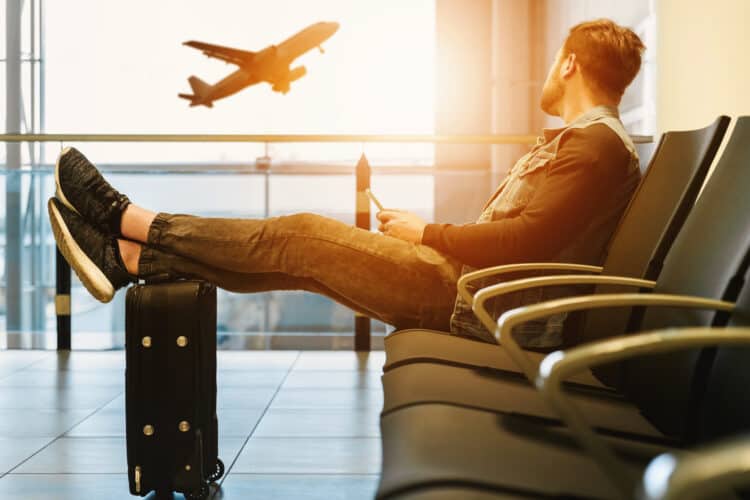
Photo: Pixabay
Getting to the airport at least an hour before departure for domestic flights at small airports or when you’re not checking luggage. Plan on arriving at least two hours for domestic flights at busy airports, if you’re checking a bag, or traveling with small children.
What about international flights? Plan on arriving at least three hours before departure to allow additional time for a potentially longer check-in time.
Learn More: How Early Should I Get to the Airport?
12. Qualify for Expedited Airport Security
If you fly several times a year, obtaining expedited airport security credentials can help you avoid long airport security lines.
The first step is applying for a federally-administered Trusted Traveler Program, such as:
- TSA PreCheck : Enjoy expedited security at domestic airports only.
- Global Entry : Get expedited processing at customs lines on international flights plus TSA PreCheck benefits.
- NEXUS : Ideal for travel between the U.S. and Canada. It also includes Global Entry and TSA PreCheck benefits.
Several rewards credit cards are offering free Global Entry and TSA PreCheck application fee credits to save a few dollars.
In addition to Trusted Traveler programs, you can also shave a few minutes off security wait times with CLEAR at select major airports and stadiums. Where available, this pre-security program can help you reach the expedited TSA security lines sooner.
Getting a Redress Number can help those who frequently have boarding pass issues, are subject to additional security screenings (including having SSSS on their boarding pass ), and those who experience delayed or denied boardings.
Learn More: How to Get Through TSA Airport Security Faster
13. Relax at an Airport Lounge
If you have a long layover or arrive at the airport several hours later, visiting an airport lounge (like a Centurion Lounge ) can help you grab a complimentary meal and drink, and recharge your devices. You can also have a comfortable place to sit and the luxury lounges offer spa treatment, sleeping rooms, and shower suites to clean up.
Single-day passes are pricey but there are several credit cards with lounge access . Most lounges allow entry for the primary cardholder and up to two guests complimentary up to three hours before your next flight’s departure.
Airport lounge access is just one way to reduce air travel stress . Check out our article for additional suggestions.
14. Check Your Passport Expiration Date
Some countries and airlines won’t let you travel if your passport expires within six months. If you’re planning a trip, see if your passport is expiring soon to prevent delaying your trip.
Consider renewing your passport early if you’re approaching the six-month expiration window as the passport processing times can take up to 13 weeks to receive your new document. You can pay extra for expedited processing but the process can still take several weeks.
After submitting your renewal request, you can check your passport application status online .
Finally, use our How to Take Your Own Passport Photo guide to simplify things when applying or renewing.
15. Don’t Go Into Debt for Vacation
As much as you’re earning to get away on a dream trip, it’s probably not worth going into debt for. Whether your bank is offering a vacation loan or you intend on carrying a credit card balance (even with a 0% APR), borrowing money to travel can backfire.
Instead, look for the best options within your spending power. Consider setting aside money each month and delaying your trip if necessary.
In addition to saving up for travel in a dedicated savings account, you can use travel rewards credit cards to redeem points to defray purchases. Some cards offer annual statement credits that reimburse eligible travel bookings.
Additionally, airline credit cards and hotel credit cards also offer complimentary benefits to spend less.
Making a travel budget can help you plan for travel expenses so you’re not nervous about running out of cash while you travel or having regrets once you return home.
16. Exercise and Stretch
Once you depart for your trip, be sure to stretch and perform basic exercises as time and space permit. It can be as basic as stationary stretches while sitting in your seat to walking the airport terminal. If driving, stay outside for a few extra minutes at the gas station or rest area.
Stretching and being active once you arrive is also beneficial and can help you sleep better.
Best Travel Tips for Packing
17. only bring a carry-on.
When possible, only bring a carry-on to avoid lost or missing checked luggage. You can also avoid checked baggage fees and excessive weight charges if you overpack. Using the best carry-on can help you find the perfect soft or hard-sided luggage to fit your travel gear.
If you need to check a bag, it most likely won’t get lost but could get delayed. Here’s our helpful guide on what to do during baggage delays .
18. Pack as Light as Possible
Packing is stressful; Many people overpack to ease their anxiety, which sometimes means bringing extra suitcases or paying to check a bag. Write down everything you think you need on your packing list. After it’s complete, cut it down to the bare minimum.
Pack underwear and socks for the number of showers you expect to take; Add an emergency pair for every five or so days of your trip. Shirts and pants can usually be worn multiple days in a row. If your accommodation has a washing machine, you can pack even less.
19. Carry-On Overnight Travel Essentials
You never know when a flight delay will turn into spending the night in the terminal or at a nearby hotel. While the airline may provide meal vouchers, you should pack these travel essentials to freshen up:
- A change of clothes, especially extra underwear and socks
- Powerbank (they cost about $20 and have several phone/tablet recharges)
- Travel charger
Even if you’re not stuck somewhere overnight, these small and compact items can also help you rest while on the road:
- Earplugs (great for plane rides and noisy hotels)
- Noise-canceling earbuds or headphones
- Travel blanket
- Travel pillow (see the best travel neck pillows )
Adding these carry-on essentials to your packing list can prepare you for nearly any change of plans and to weather a long layover or flight.
20. Don’t Forget a Power Adapter
A power adapter is essential in most foreign destinations to charge your devices. Traveling to Canada or Mexico is an exception as the standard voltage is 120v and these countries have the same outlet design as the United States. Check to see the adapter requirements for the country you are visiting before leaving.
The Vacationer’s Phil Dengler recently visited South Africa and needed a Type M adapter. He purchased this Ceptics International Power Plug Adapter Travel Set , which includes 13 adapters for just about every foreign country.
21. Use Packing Cubes
There are a couple of ways to organize your travel luggage to squeeze everything in. Your bag may include built-in storage compartments or you might roll up clothing and put them in packing cubes or vacuum storage bags. If you’re on a budget, rubber bands or plastic bags can also do the job. I recommend the following packing cubes: Veken 6 Set of Various Colored Packing Cubes .
Packing for a vacation can feel like a fine art at times, even as a seasoned traveler. Our travel packing list can cover everything you need to bring so you don’t forget and have to buy something along the way.
22. Bring an Empty Water Bottle
For over 20 years, it’s become ingrained for air travelers to pack liquids in containers containing no more than three ounces. This security rule means you can’t bring a filled water bottle through airport security, but you can bring an empty one.
Most airports have filtered water dispensers in the post-security terminal that you can fill up your bottle with and avoid paying big bucks for bottled water. You also won’t struggle to stay hydrated during your journey.
If you’re driving, consider bringing a travel water filter or a portable filter that you can use in your hotel room to pay pennies for filtered water.
23. Dress Comfortably for the Flight
You should dress comfortably for the plane ride. Dressing in layers with a light jacket or a travel blanket can help you stay warm if the cabin is cool. Bringing travel slippers or slip-on shoes on long-haul flights is another overlooked comfort hack. Wear sweatpants instead of jeans.
24. Bring Duplicate Travel Documents
Take a few minutes to photocopy your critical travel documents such as your government-issued IDs and passport. Be sure to keep these papers separate from your originals in case one set gets lost.
Once you arrive at your destination, you may decide to go out in public with your duplicates and keep your originals plus at least one payment card in the room safe. That way, a pickpocket doesn’t run off with the more valuable set and you still have a way to make purchases.
Taking it a step further, write down your credit card numbers and the emergency contact number if you need to call and cancel if your plastic goes missing. If you don’t have a phone number, you can also look for a pay phone that should have a toll-free number to contact Visa or Mastercard to cancel your card.
25. Keep Valuables at Home and Bring a Lock
Unless it’s necessary to bring them along for a business function or a personal event, leave your valuables at home. The hassle of keeping them secure and the risk of losing them may not be worth the replacement cost.
This includes your fine jewelry, watches, and high-end electronics that are nice to use but optional for this trip. Additionally, these items can make you a target for thieves.
The Vacationer’s Phil Dengler also recommends bringing a luggage lock or a standard combination lock.
26. Install a Luggage Tracking Device
Bluetooth tracking devices like the Apple AirTag are a small and easy way to see where your carry-on and checked luggage are at all times. A single piece is about the size of a coin and costs $30 or less.
27. Bring Comfy Walking Shoes
Most of the world walks more steps than we do daily. Therefore, it’s essential to pack at least one pair of comfortable shoes or sandals to stroll the streets of your destination. Comfortable footwear is also a must-have if you’re staying stateside.
28. Keep a Travel Journal
Consider packing a notebook or diary into your carry-on. Handwriting your favorite travel memories in a journal is an easy way to remember the intricacies that you may struggle to remember years later when you reflect.
For example, you can write down what you did each day along with exciting facts. Having everybody share their favorite activity for the day is another way to use this journal.
Best Travel Tips for Once You Arrive
29. learn the local customs.
Words and expressions can have different meanings where you’re traveling to. It’s also a good idea to know some of the common phrases and customs the locals practice so you can have a basic conversation.
You can research these details online or in a guidebook.
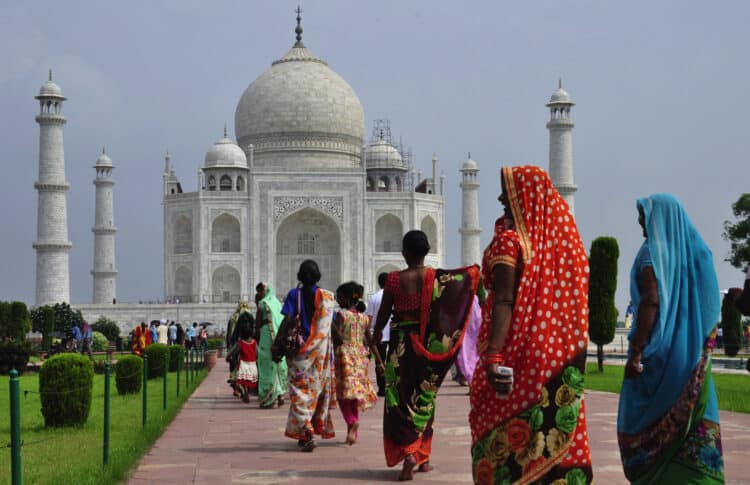
30. Dress As a Local
Blending in with the crowd can help prevent unwanted attention from panhandlers and pickpockets. For example, don’t wear revealing clothing when the culture favors pants or long dresses. Researching fashion advice for your destination is your best option.
31. Be Wary of Local Scams
Brushing up on the latest tourist scams can help you avoid bad situations. A recent travel guidebook is a reliable way to find the most common tactics for your destination. Two to look out for are unofficial taxis and fake wifi hotspots.
32. Consider Wearing a Money Belt
Long-time travelers have a love-hate relationship with money belts as they point you out as a tourist if you’re constantly reaching for it in public. Additionally, wearing the belt all day can be a nuisance as it’s an extra layer of fabric you’re not used to.
At the same time, it’s harder to steal a money belt than to grab something from your pockets or purse. They are also inexpensive to buy on Amazon and don’t take up a lot of suitcase space if you decide not to use it.
33. Download Travel Apps
Smartphones make international travel substantially easier as you can download various apps before leaving home so you can hit the ground running.
Some types of apps you may consider downloading for these purposes:
- Offline Maps: Many consider Maps.me to be the best offline maps app and more user-friendly than Apple Maps or Google Maps. You may still try getting paper maps from a local tourism office or bookstore once you arrive though.
- Translation: A translator app for traveling can be pre-loaded with basic phrases with offline access. It may also be able to interpret voice recordings and photographs.
- Jet Lag: Flying to the other side of the world takes a toll on your body and sleep cycle. Timeshifter can help you conquer jet lag quicker while traveling and upon returning home.
Downloading apps for your airline, hotel, and travel booking sites will help you access your digital reservation information and receive itinerary updates. Some travelers also enjoy downloading tourism apps like Tripadvisor or Yelp to quickly access ratings for attractions.
34. Get an International Sim Card or Phone Plan
Your stateside phone carrier may offer an international plan that you can upgrade to while you’re out of the country. Contract carriers and prepaid providers offer this overseas coverage.
Alternatively, an international sim card can be a budget-friendly and reliable option if you visit multiple countries. Just make sure your device is unlocked and GSM-compatible.
35. Avoid Eating in Touristy Areas
You’re likely to pay more and potentially get lower-quality food when eating in touristy areas. This isn’t always the case. For example, dining within sight of Rome’s Pantheon is an exception as there are well-rated restaurants for a memorable ambiance.
However, going a few streets over or to an adjacent community can be the ticket to finding authentic food. Asking your hotel or trustworthy locals can help you find a good spot in addition to researching places to eat online.
36. Lunch Can Be Cheaper than Supper
If you’re only planning on eating out one meal per day, your mid-day meal can be more affordable than in the evening.
Depending on the restaurant, there can be separate menus for the bar and dining room. Staying in the bar can be more affordable and your meal options can be similar.
37. Use American Chains for Public Restrooms and Wifi
Finding a public bathroom can be challenging in foreign destinations. American restaurants like McDonald’s, Starbucks, and Taco Bell are more likely to offer public access to restrooms and wifi, although you may need to make a small purchase.
38. Look for Free Walking Tours
Free walking tours are common in popular tourist destinations both stateside and internationally. These tours can last a couple of hours and hit the cultural and historical points of interest. They can provide an idea of what you want to spend more time exploring later.
While these tours don’t have an entry fee, nothing in life is genuinely 100% free ,and leaving a tip is expected in most situations. You may decide to tip more if the guide is knowledgeable and engaging.
39. A Paid Tour Can Be Better Than a Free Tour
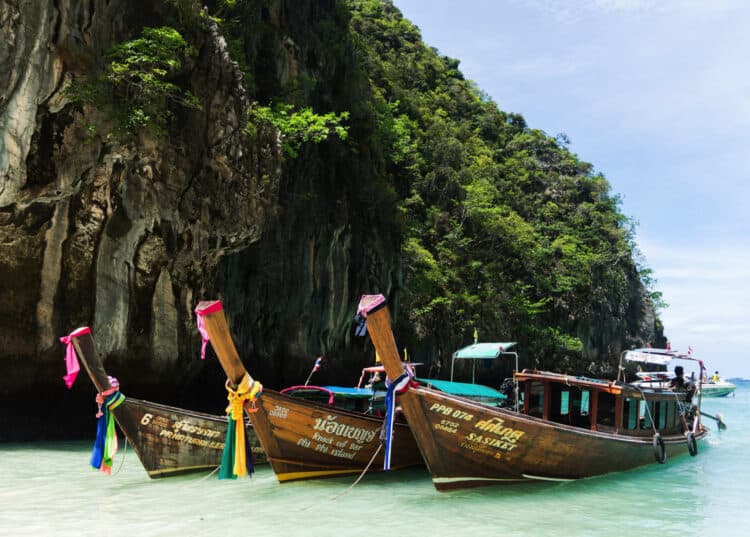
You should also compare the free tours to private, guided tours. A paid tour can provide more hands-on support and access to more landmarks.
In addition to researching the traditional tour providers, the experiences section in Airbnb can also provide curated opportunities to see the sights, enjoy culinary delights, or do physical activities like paddleboarding or folk dancing.
Further Reading: Best Websites for Booking Cheap Tickets, Tours, & Activities
40. Look for Discounted Sightseeing Passes
Museums and entertainment attractions offer discounted and priority admission with sightseeing pass companies. So, instead of buying tickets directly from the tourist attractions you wish to visit, purchasing a city attraction card in advance can save money and means you won’t need to wait for hours (potentially) to buy a ticket at the door.
For domestic trips, CityPASS® offers discounted packages in approximately 15 major U.S. cities. Entertainment.com can also help you save on experiences in the United States and Canada.
If you’re flying to the “Eternal City” of Rome, Italy, the Roma Tourist Card is worth the upfront cost as you can enjoy these benefits:
- Skip-the-line access at the Roman Colosseum
- Guided tour of St. Peter’s Basilica
- Access to the Vatican Museums and the Sistine Chapel
- Audio guides for the Pantheon and Rome
- Free return transfer to or from Rome’s international airports (Ciampino and Fiumicino)
- 10% discount on other attractions, museums, and tours
Depending on the program, you may need to book your pass weeks in advance.
41. Get an Interrail Pass for a Eurotrip
If you’re backpacking Europe or touring several countries, an Interrail Pass from Eurail can make it easier to finalize your transportation plan using an interactive map. This platform lets you visit up to 33 countries by rail with a single pass.
42. Have a Flexible Travel Schedule
Mapping out an initial plan for each day can help you seize the day and optimize your time of playing tourist. Meanwhile, remaining flexible is pivotal as several variables can alter your itinerary such as:
- A change in the weather
- Accomplishing more than you originally scheduled
- Making friends with other travelers and having dinner with them
- Realizing a planned activity isn’t as appealing once you arrive
Another related suggestion is to get out and explore the city and the immediate area on your arrival date (time permitting) so you have a better idea of what to do the next day.
43. Wear Sunscreen Early and Often For Beach & Outdoor Trips
There is nothing worse than getting a bad sunburn at the beginning of a trip. Find a good facial sunscreen and buy a travel-sized container. Apply it to your face and neck a few times per day. For beach trips, either cover up with a hat and clothing or apply strong sunscreen to your body multiple times per day. While it may be annoying, it is much better than dealing with painful and peeling sunburn.
Sunscreen is usually marked up at typical tourist spots. If you check a bag, consider buying what you need before leaving and packing it.
44. Use an ATM Instead of a Currency Exchange Booth
Instead of heading directly to the currency exchange booth at the airport or train terminal, look for an ATM instead. Several should be in the public terminals or you can look for a local bank branch to find a secure location.
Why? ATMs provide better currency exchange ratios than the money exchange booth. Even if you pay foreign transaction fees and non-network ATM fees, you will most likely come out ahead financially speaking.
45. Use a Credit Card With No Foreign Transaction Fees
Many travel-focused credit cards like the Chase Sapphire Preferred , the Capital One Venture X Rewards Credit Card , and The Platinum Card from American Express do not have foreign transaction fees. Use cards like those when traveling internationally to avoid potentially expensive fees.
46. Bring at Least One Backup Credit Card
Getting stuck on vacation with no access to money (besides cash) is not something you want to experience; Your main credit card could get lost or stolen. Carry at least one backup credit card (ideally with no foreign transaction fees if overseas) on all trips.
Phil Dengler’s Favorite Travel Tips
Here are a few of Phil’s favorite travel tips.
47. Be Very Flexible – Pick Your Travel Dates Based on the Cheapest Days to Fly
Flights are usually the most costly part of a vacation. I recommend using Google Flights calendar view to find the cheapest days to fly to and from your destination. After identifying those days, book your airfare. You must be flexible, but it can save you hundreds, if not thousands, of dollars planning a vacation this way.
Further Reading: How to Find Cheap Flights and How to Use Google Flights
48. Book the Aisle and Window Seats When Traveling in Pairs
I always book the aisle and window seats when flying with my girlfriend or a friend. No one wants to sit in the middle seat, so people rarely select it. Doing this usually gives us the entire row to ourselves.
It does not work on full flights, however. The good news is people are usually willing to trade their middle seat. Simply offer them your aisle or window seat and you still get to sit next to your significant other or friend.
Further Reading: Can You (and Should You) Change Airplane Seats With Someone Else on a Flight?
49. Follow Proper Airline Etiquette
Knowing how to properly act on a plane can better your flying experience. See our following guides for more information.
- Airplane Seat Reclining Etiquette
- Overhead Bin Space Etiquette – Who Does it Belong To and How to Avoid Fights
The Vacationer’s Final Thoughts
Taking the time to plan for a vacation, whether it’s the annual beach trip or you’re trying some new place, lets you practice these travel tips and not stress before or during your expedition.
The best part is that you don’t need to be a travel pro to successfully implement these suggestions. If you’re a beginner, try adopting several more each time you leave home.

By Josh Patoka
Josh Patoka writes about maximizing travel rewards for The Vacationer. As well, he contributes to several personal finance sites specializing in making money, paying off debt, and investing.
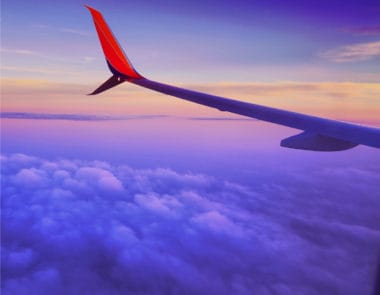
How to Find Cheap Flights to Anywhere in the World in 2024
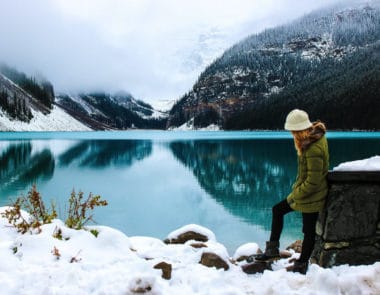
The Best Travel Insurance – Guide to the Top Companies, Cost, & Buying Tips in 2024
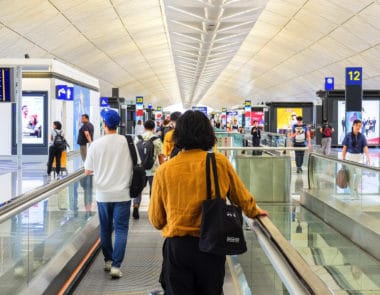
How to Avoid Airline Flight Delays & Cancellations – 2024
Travel Tips: The Best 99 Travel Tips You’ll Ever Need

August 30, 2023
Traveling is something that you can only learn with experience. The more you travel, the more you experience and learn.
If you are new to traveling, you are most likely to make a whole lot of mistakes at first and that’s okay.
With time, you’ll know all the things to do and all the things to avoid when planning a trip somewhere or visiting a foreign land.
There are a ton of mistakes you can make as a first-time traveler. These include being reckless, being culturally offensive, missing buses, etc.
You have to think about traveling as you did your first time in a new school. It will take some time but eventually you will get used to how things work.
Meanwhile, here are my 99 travel tips to get you started as a traveler.
The journey might be long and bumpy so hold on tight and brace yourself;
1. Find Photogenic Places & Spots Using Instagram
2. learn common phrases of the local language, 3. read a history book about the place you are visiting, 4. get to know local customs before you go, 5. don’t be afraid to take your kids with you, 6. get vaccinated, 7. let your family and friends at home know your plans, 8. if you plan to visit someone/staying with someone, during your trip, then get them a present, 9. don’t go into debt for travel, don’t spend beyond your means, 10. research your destination, 11. be flexible and don’t over-plan, 12. book early for cheap flights, 13. use points and miles for discounts and even free travel, 14. use a vpn to potentially get a discount on flights, 15. avoid expensive hotels and accommodations, spend your money on experiences not on sleeping, 16. write down your hotel address and phone number.
- 17. Get a VPN for Travel to Protect Your Internet Connection While Abroad (I Personally Recommend ProtonVPN and NordVPN)
18. Take Cash with You and Extra Credit/debit Card
19. let your bank know you’re traveling, 20. pack light, 21. but take extra underwear and socks, 22. pack a pair of sneakers, 23. carry a first-aid kit, 24. always get a compeed for your feet – thank me later, 25. bring your normal clothes you’re comfortable in with you, 26. wear comfortable shoes you already broke into, 27. don’t bring clothes that need ironing, 28. always pack a hat and a sarong/scarf, 29. mark your luggage and write your name and contact information on them, 30. take pictures of your luggage and clothes, 31. take a photo and make copies of your passport and important documents, 32. get your phone unlocked before you leave, 33. invest in a good travel camera, 34. bring an extra camera battery, 35. bring a powerful power bank, 36. put electronics, medications, and extra clothes in your carry-on, 37. go to the airport early, 38. go to the bathroom right before boarding on a plane or taking a bus, 39. get a window seat so you can lean against the wall when you sleep, 40. get the closest seat possible from the doors on the plane, this will save a huge time going through customs, 41. stay hydrated on the plane and on the road, 42. get a water filter bottle and drink tap water whenever you can., 43. don’t change your currency at the airport, 44. track your spending, 45. don’t be afraid to pay to get your laundry done, it’s totally worth it, 46. wake up early, 47. try to exercise during your trip, 48. eat local food frequently, 49. don’t be ashamed to buy souvenirs, 50. visit famous and touristy places, 51. but don’t hesitate to get off the beaten path, 52. also, don’t eat at restaurants in touristy places, 53. wear sunscreen, 54. always have snacks with you, 55. put down your cellphone and enjoy the moment, 56. visit historical places at lunchtime, they are usually less crowded between 12:30 and 13:30, 57. go to local markets, 58. try new food, even if you think you won’t like it, 59. go on free walking tours, 60. make friends with locals, 61. make friends with other travelers, 62. break out of your comfort zone, 63. get lost on purpose, 64. do something that scares you, 65. be spontaneous. say yes to interesting opportunities and don’t stick blindly to your plans, 66. experience traveling alone from time to time, 67. go somewhere new every year, 68. if it feels wrong, it’s probably wrong. don’t take unnecessary risks, 69. abc: always be charging charge your power-bank and your devices whenever you have the chance, 70. get a local sim card with internet data for your phone, 71. always take your camera with you, always, 72. don’t forget to take epic photos of what you’re seeing, 73. take plenty of photos at sunrise and sunsets., 74. cloudy days are actually excellent for portrait photos, 75. take more photos of yourself in those places, 76. take more photos of and with locals, 77. save memories, don’t fake memories. your photos are meant to remind you of good times, not for showing off to others., 78. don’t wear your purse on one shoulder. rather, wear it around your body, 79. never carry your wallet in your back pocket., 80. be aware of pickpockets and scams, 81. use public transportation in big cities, 82. if you need a car then rent it. it’s cheaper than hiring a driver or taking taxis every time, 83. if you hired a driver, take pictures of the car, the license plate, and relevant details about the car and the driver. just in case, 84. never leave any valuables in your car, ever, 85. check if you forgot something in your hotel room before leaving, 86. don’t throw trash on the street, 87. be eco-friendly and minimize your trash, 88. also don’t buy anything made of animal parts, 89. don’t take your trip too seriously., 90. expect everything to go wrong, 91. don’t lose your temper when it does, 92. be kind with your travel partner. try to understand each other and avoid getting into an argument or a fight., 93. also, a fight doesn’t mean the end of your relationship/friendship. don’t be too proud to apologize, 94. compromise, compromise, compromise, 95. slow down to enjoy your vacation and never let yourself be in a rush, 96. keep an open mind and don’t judge other cultures, 97. don’t assume that you know more about a country or a culture than the people who actually live there, 98. be polite, smile often, and be friendly, 99. always, always, be respectful., i- travel tips before you go.

Instagram is one of the most popular social media applications you can resort to if you want to stay updated with the best places in town to visit.
Before you plan a trip to any destination, make sure to check Instagram for all the most scenic places you must visit in that particular town and city.
Each city in every country has certain must-see tourist spots, including places of worship, museums, or even landscapes full of natural beauty that you must visit. Instagram can be pretty useful as a starting point for pinning down which places you should necessarily add to your itinerary.
Visiting a new place will always be easier if you have some knowledge of the local language.
This doesn’t mean that you have to spend weeks picking up the new language. It simply means that you can take out a few hours each week before your trip to learn some common phrases in the local language that will help you when in the foreign land.
Such phrases include “I’m sorry” , “hello” , “thank you” and anything else that you feel is necessary to get you through your trip.
As an example I wrote an article that compiles the must-known phrases when visiting Japan . Check it out.
More knowledge never hurt anyone. It’s only human to be curious about a place before you visit it. For the sake of both your curiosity and for efficiency purposes, try to grab a hold of a history book about wherever you plan on visiting.
Anywhere you decide to travel will most likely have a rich history and heritage and it only makes sense to read up on some of this so that you enjoy your trip even more.
Read our guide on the best travel books to read that give intense wanderlust.
The one mistake you want to avoid as much as you can when in a new place is to be culturally insensitive or offensive in some way to the locals.
If you are unaware of their culture entirely, you are quite likely to make this mistake. This is why it makes sense to read up a little on the traditions and customs of a place before you visit so that you understand them better and don’t risk acting in an insensitive manner.
Some people are afraid of traveling with their children, especially if their children are pretty young. Although traveling with toddlers or even infants can be exhausting and even terrifying at times, this is no reason to avoid it altogether.
In fact, traveling helps increase knowledge and if a child is made to travel from a younger age, they develop cultural awareness from that tender age and this shapes them up to be informed, educated, and sensitive adults.
Some countries have strict travel policies and will not allow you to enter their land until you are properly vaccinated. The reasoning behind this is simple – they wish to prevent the spread of diseases from one country to another.
Even if it is not required of you by the country according to its travel policies, it is always a good idea to get yourself vaccinated before boarding the plane to another country. Why risk passing on some sort of infection or disease to another land when you can easily avoid it altogether?
This is perhaps the simplest of all travel tips and is understood even without mentioning. Unless, of course, you have absolutely no friends or family that you are in contact with, it’s always a good idea to inform your close relatives and friends about your travel plans.
This is important because visiting a new place is always risky, and it’s good to know that someone knows exactly where you are in case you need any help or encounter some sort of an emergency.
This shouldn’t be too hard to understand. It’s only common decency that if you plan on living with someone during your travels, or even just visiting them, you should buy them a present in advance of your trip.
It’s best to not leave this till the last minute when you will be chaotic and in a rush. Buy these presents at least two weeks before your intended date of travel to avoid any last minute anxieties.
Traveling can be pretty expensive. The actual costs that you will incur depend on where you are traveling, for how long, and whether or not you opt for any travel packages.
It is never a good idea to spend so much that you are in debt after your trip. If you can’t afford to stay in luxury hotels then don’t include them in your itinerary.
As fun as traveling can be, it won’t be much fun if you can’t afford basic necessities for months after your trip.
II- Travel Planning Tips

Before you begin packing your bags and booking your flights, it’s important to do some research on your destination. This will help you better understand the culture, customs, and norms of the place you are visiting, and ensure that you are prepared for what to expect.
Some things you might want to research include the climate and weather, local laws and regulations, the cost of living and common expenses, and any potential health or safety concerns.
This will help you plan and pack appropriately, and also give you a sense of what activities or sights you might want to see while you are there.
Traveling anywhere requires at least a certain degree of flexibility. It is a basic rule of life that everything is more fun when you don’t plan it down to every little detail.
While it is important to be organized and responsible when visiting a new place, you should always be open to spontaneity.
If things don’t go exactly as you planned, don’t be too disappointed because this will most likely ruin the rest of your trip.
Once you have made up your mind about where you are traveling, it only makes sense to book your flights as soon as you can.
You can hire a travel agent, book a package, or even plan the entire trip by yourself, but whatever you choose to do, make sure to get a head start on the process.
No point paying extra when you can get much lower prices by just being responsible enough to book the flights well in advance.
Once you become a frequent flier, you are likely to receive flying points and miles. The more points and miles you gather, the more likely you are to get a discount on your flights. Sometimes, once you have accumulated enough points, it’s even possible for you to travel completely free of cost!
Generally speaking, travel websites tend to track your IP address and the prices that they offer you are based on where you are browsing from.
Using a VPN for travel , you can hide your IP address and consequently, you might be able to benefit from lower flight prices. For example, if you were to set your IP address to a lower income country, you may be able to book a flight at a lower price.
Similarly, you may be able to set your IP address to the country from which that particular airline operates, and thereby save on flight costs.
Yes, traveling is expensive; but it doesn’t always have to be! There are countless ways you can save money during your travels using hacks such as choosing budget-friendly hotels as opposed to luxury, five-star hotels if you can’t afford it.
Remember that the whole point of traveling is to gain new experiences. If you want to sleep comfortably, you can do that in your own home. Make sure that when you do travel, spend on exploring and discovering new places, rather than on comfort.
In fact, the whole point of traveling is to step outside your comfort zone!
Before you set out for your travels, it is pertinent to do some research well in advance. You need to know exactly which hotels you will be staying at, and the smart thing to do is to write down the contact number and address of wherever you will be staying.
This information is important to keep for yourself, as well as for giving it to a close family member or friend lest they have to contact you in case of an emergency.
17. Get a VPN for Travel to Protect Your Internet Connection While Abroad (I Personally Recommend ProtonVPN and NordVPN )
A VPN protects the privacy of your internet connection when you’re away from your home country. When in a new country, it makes sense to install a VPN well in advance of your travel for the sake of internet privacy.
There are certain websites that you are accustomed to using that may even be blocked in the country you are traveling to. A VPN can make sure that you can access your favorite sites regardless of where you are.
ProtonVPN and NordVPN are two reliable VPNs you can install before your travel dates.
Remember that when traveling, it’s always good to be prepared for the worst. Anything can happen during your travels, things can go wrong and you must be prepared.
As such, always make sure to travel with your debit and credit cards, along with cash. It’s important to have both options in hand because depending on where you are traveling, one option might work while another might not.
For example, if you are in a particular city, some areas such as large malls and restaurants might accept a card while marketplaces and bazaars etc. might only accept cash.
Never make the mistake of limiting your options to only one of the two.
It’s always a good idea to inform your bank that you will be traveling and give them your travel dates. This is important because it’s possible that your ATM card or debit card might not work in a foreign country unless your bank allows it.
You might get into a very sticky situation if you somehow run out of cash sooner than you expect and your debit card refuses to work. So make sure to get these technical processes sorted out well in advance of your trip to avoid any inconveniences during the trip.
III- Packing Tips for Travel

He who travels happily must travel light. Antoine de Saint-Exupery – One of the best travel quotes out there
When going on a trip, it makes sense to pack as light as you possibly can. The more things you carry with you, the more inconvenient things are likely to be for you.
Let’s say your trip comprises of visits to a number of different cities or even countries. The fewer things you carry with yourself, the easier it will be for you to maneuver and move around.
Additionally, the fewer things you carry, the less likely you are to lose things.
It doesn’t take a genius to understand why this is so important. Remember that no matter how much you pre-plan, it isn’t possible to think of almost every possible thing that can go wrong in the trip.
You also don’t know if your plan might somewhat change along the way. For example, let’s say you decide to extend your trip by a few days.
The smart thing to do is to avoid all these problems and simply pack a few extra pairs of socks and some extra underwear.
The most important thing to keep in mind while packing is that your comfort must be your first consideration.
If you aren’t comfortable with the clothes you have packed or the things you have kept with you, your entire trip might get ruined.
You also generally have to walk a lot during trips as you go about exploring and discovering new cities and towns.
This is why it’s always a good idea to pack at least one pair of sneakers with you, wherever you go. Sneakers are comfortable, durable, and perfect for walking long distances.
Whether you are traveling alone or with a group of people, you alone are responsible for your health along the way.
It is possible for you to encounter any number of accidents or incidents on your trip. You could get a small injury like a broken nail or stubbed toe, or a bigger injury, such as a fracture.
In any case, having a first aid box with you at all times of your travel is absolutely essential.
Compeed dressings are meant to relieve you of the pain of blisters on the feet. When traveling, there are usually such large distances to cover that you can get blisters very easily.
Blisters are naturally painful and uncomfortable and can potentially make the rest of your trip not as much fun for you.
So do remember to keep some compeed with you at all times during your travels.
No matter where you are traveling to, you aren’t likely to have too great a time if you aren’t comfortable.
While fashion is important, the first rule of fashion is that you must be comfortable in what you wear. So make sure to at least bring two to three outfits that you know you are 100% comfortable in.
It’s common knowledge that new shoes can be pretty uncomfortable the first few times you wear them. This is why it’s never a good idea to take new shoes that you haven’t worn too often along with you on a trip.
It’s possible that the new shoes start to dig into your toes, or hurt the back of your heel.
Old is gold, so stick to what’s comfortable!
While it is possible for you to take a steam iron along with you on your travels, it will just be an added inconvenience.
Ironing also takes up a whole lot of time you could have spent exploring the new land you are in.
The solution is simple – simply make sure to take clothes that you know for a fact won’t require ironing.
There are certain accessories that prove to be very useful during traveling. A hat or a cap is one such accessory. Hats can protect you from the sun, particularly if you are heading out towards a tropical climate. Hats also look stylish.
A scarf can also serve multiple purposes. If you are going to a country where you are required to dress ‘modestly’, a scarf can be pretty useful. Scarves can also sometimes look very fashionable.
Similarly, if you are going to a beach location, a sarong is a necessary item to pack.
If you have ever traveled on a plane before, you will realize just why this is so important. Flights nowadays are often booked. Among so many passengers, it’s very easily to lose some or your entire luggage along the way.
This can easily be avoided. All you have to do is make sure that all pieces of your luggage have your name and proper contact information on them.
This way, even if you do lose your luggage, you can be assured that it will always make your way back to you.
This is purely a precautionary measure. Just writing your name and contact information on all pieces of your luggage sometimes isn’t enough.
It’s also a good idea to take pictures of all pieces of your luggage and clothing just in case something goes wrong.
This is one of the most important pre-travel steps you need to take.
It’s always a good idea to have copies of each of your important travel documents including your passport, your tickets, hotel bookings, and any other crucial pieces of information or documents you need to travel.
IV- Travel Tips for Packing Tech

Make sure that your phone is unlocked before you leave for any trip. You don’t want to face any complications accessing your phone when in a completely foreign land.
There is little point of traveling if you aren’t going to make a whole lot of memories and make sure that at least some of those memories are caught on camera and preserved for you to keep for years and years.
This is why it is always worth investing in a decent travel camera well in advance of your trip. The Canon G5X M2 is one camera certainly worth investing in before your travels.
Cameras usually come with batteries.
It’s possible for those batteries to run out or for something else to go wrong with those batteries.
As such, always make sure that you carry extra camera batteries with you each time you travel.
A power bank is a device that can help you charge your phone when on the go. This device is particularly useful during traveling because even if you do take your phone charger with you, a number of things could go wrong.
It’s possible that the charger begins to malfunction or that you are on some cruise or on an exotic island where there is no way for you to charge your phone.
That’s why I actually have 3 or 4 myself 😀
A carry-on bag serves many purposes during traveling. This bag is where you store all of the extra things that are very useful to you such as necessary medications, electronic items such as your laptop and laptop charger, power bank etc.
You might even want to put a few pairs of extra clothing inside your carry on, just in case you need to freshen up during the journey.
Opening the main suitcase mid journey is impossible, so all of the important things that you might need should be stored in your carry on.
V- Travel Tips While on the Road

This is perhaps the number one rule of traveling – you must get to the airport well in advance of your flight.
It’s always better to be early rather than late. So quit being lazy. On the day that you have to travel, wake up extra early, have a good breakfast, make sure all your stuff is with you and is sorted out, then head on over to the airport!
One of the most uncomfortable aspects of traveling is not having access to one’s own bathroom. Since traveling is all about stepping outside your comfort zone, you must not mind this too much.
In order to avoid having to go to the bathroom while traveling, make sure you use the bathroom right before boarding a plane, a ship, a bus, or any other vehicle where it might be difficult to use the washroom.
Although this isn’t necessary, the window seat is always a good seat to select, when on a bus or plane.
Not only is this a more comfortable seat because you can lean against the window and fall asleep, the window seat also offers the best views, especially from an airplane.
If possible, make sure to get a seat as near to the doors of the plane as you possibly can.
The nearer you are to the exit of the plane, the earlier you can exit the plane, and the sooner you can get clearance from customs.
This is particularly important if you have to take a connecting flight because you cannot afford to get late for it.
When traveling, it’s sometimes impossible to remember to drink enough water.
Always make sure that whether you are flying or on the road, you have water with you.
Traveling to another country is scary enough, especially for first timers. You don’t need the added stress of encountering any health problems when in a foreign land.
So drink as much water as you can!
It may not be possible for you to find mineral or bottled water easily when on the go.
The easiest thing to do is to simply carry around a water bottle (with an included filter) with you and fill it up with tap water wherever you may find it.
VI- Travel Tips when Arriving at Your Destination

If you are a frequent traveler, you may have realized that it is never a good idea to get your currency exchanged for the foreign currency when at the airport.
This is because the airport often tends to overcharge and give you a rate higher than what you would get from anywhere outside.
Each time you travel, you will have a fixed amount of money with you. As such, you need to spend it wisely.
Make sure you keep a track of all the money you are spending on internal commute, food etc.
Carry a small notebook in your handbag, or use a dedicated budgeting app, and make a note of each time you spend money so that you don’t go overboard or run out of cash.
Whichever hotels you choose to stay at will most likely have a laundry service. You may be unwilling to use the service because of the money you will have to pay for it.
It’s best to however pay that money and get your clothes laundered because you will be saved from a whole lot of inconvenience later.
Fresh, clean clothes are definitely a blessing, especially when you’re in a foreign land.
VII- Travel Tips During Your Trip

The whole purpose of travel is to explore and discover new places. As such, you want to make the best of your time in the foreign land.
Make sure that you plan out activities for each day of the trip in advance and during the trip, wake up bright and early each day so as not to waste any precious trip time.
Remember, you can always sleep once you’re back home!
Because traveling can be so chaotic in itself, you may forget to care about your physical and mental health. A little bit of exercise goes a long way in this regard.
You can wake up early and do some morning stretches and yoga before starting your day. Alternatively, you can even use an application to keep a track of the number of steps you walk each day. Set a target number of steps and make it your goal to meet your target each day.
There is little point visiting strange new lands if you aren’t willing to step outside your comfort zone. When in a new place, make sure to try out all the local delicacies instead of sticking with food that is readily available.
It can be tempting to buy souvenirs such as bells, magnets, decorative items, or T-Shirts when in a new place.
It’s always a good gesture to buy such things for your family and friends back home or even just for yourself so that you remember this trip for a long time to come.
As obvious as this sounds, some people visit a place and miss out on some of the most famous places to visit because they aren’t aware of them.
Do your research in advance or talk to local tour guides and make sure you visit all the must-see places when in a new place.
While touristy spots are always a delight to visit, sometimes, there are places that no one talks about or visits about are pretty charming. In fact, if you want to get an authentic vibe of the place, its best to sometimes visit places that aren’t particularly famous among tourists.
The problem with only sticking to spots and restaurants that are ‘touristy’ is that these places often tend to get pretty crowded. You also won’t get a feel of the local culture and cuisine if you only stick to restaurants specifically designed to cater to tourists.
This is particularly relevant if you are visiting a tropical region or island. The rays of the sun tend to be pretty strong in these places so make sure to apply sunscreen on all parts of your body that will be exposed to the sun.
Traveling tends to make you pretty hungry, especially when your trip involves a whole lot of adventure an if you’re constantly on the move. Because you can’t always stop at restaurants it’s best to keep some snacks with you on hand in case you get hungry.
The one mistake you should never make when on a trip is to be constantly using your phone. In fact, you should try to avoid social media as much as you can when on vacation. Put your cell phone away, talk to those around you, and enjoy each little moment to the fullest!
If you are in a town or city that is home to a number of historical landmarks that are open for tourists to visit, make sure you plan your visit around lunchtime. This is the time when these landmarks are least crowded and you can even manage to get decent photographs.
Local markets everywhere have a charm of their own. No matter where you are, make sure to visit the night markets and day markets because these can both be pretty interesting in their own ways.
Some places even have floating markets – markets built over flowing water. If you come across any of these, make sure to explore well.
There is little to no point in traveling if you’re only going to stick to what’s considered ‘safe’. Each place you visit will have certain local culinary delicacies that you should at least try out, even if you think you might not like them. Traveling is about collecting new experiences after all!
If the city or town you are visiting has the option of availing free walking tours, make sure you go for these. These walking tours generally tend to be guided and can tell you a lot about the history and culture of the place you are visiting. It’s always good to learn!
Making friends with the locals has a whole lot of advantages of its own. For starters, you can learn some of the local language. More importantly, the locals can guide you on the best places to visit in town and perhaps tell you where you can get the best local food.
It’s always a good idea to befriend those you are traveling with. Not only does this give you a certain support system when in a new land, you can also explore and discover new parts of the city with the other travelers. It’s always more fun when there are more people.
You can even get to know more about the travelers’ home county and this in itself is a learning experience.
VIII- Travel Tips to Live Unforgettable Experiences

The number one rule of traveling is that you step outside your comfort zone and are willing to have all sorts of new experiences.
During your travels, you might sometimes face situations that are entirely unfamiliar and where you may feel where you are uncomfortable and that is perfectly okay.
Strange as it sounds, sometimes, the best way to discover yourself is to get lost deliberately. When in a new, strange land, try to be as adventurous as you can, and what’s more adventurous then getting lost?
So shut your phone and aimlessly walk the streets of a foreign city until you don’t know where you are.
At home, it’s okay to stay away from the things that tend to scare you, but not while you are traveling. During your travels, make sure to do things you were otherwise too scared to do. For example, if there’s something you always wanted to try but never got around to it, make sure you go for it when you’re on your trip.
The only thing you need to ask yourself is, what’s the worst that can happen?
Life is supposed to be an adventure, more so when you are traveling. During your travels, make sure to be as spontaneous as you can.
While it’s important to plan out your activities for each day, it’s equally important to take life as it comes to you and not be too stringent if things don’t work out exactly how you plan them.
While it’s always fun to travel in groups, it’s also sometimes fun to travel by yourself. Traveling by yourself can sometimes help you gain a whole new perspective on life. It can also be enriching for your soul to travel alone.
Being by yourself and discovering new places is fulfilling in itself.
While traveling anywhere is a learning experience, the more places you discover, the more you are likely to learn. As such, make it a point to visit a whole new place each year.
The more places you travel, the more you learn about different cultures, histories and traditions, the more foods you discover and the more lifestyles you experience.
Remember that are instincts are almost always right. If you are in a new place or situation that doesn’t feel right to you, get out of those situations as soon as you possibly can. Taking risks is important but taking unnecessary risks is stupid.
Remember that if you mess up, no one can come to your rescue so far away from home. So be smart and careful whenever required.
IX- Travel Tips for Photography & Tech

You want to make sure that you don’t run out of charge in your phone or any of the other essential devices you need to carry with yourself. The easiest thing you can do is charge your phone and power bank overnight each day of the trip. You don’t want your phone to be off when you are out and about taking pictures!
This will be useful in case you need to contact friends and family back home. Remember, anything can happen when you are on a trip, far away from all that is familiar. This is also particularly important if you are traveling alone.
Furthermore, data is important even just to access GPS settings on your phone. Imagine that you are in a new place and get lost only because you cannot access maps on your phone.
Make sure that wherever you go, you carry your camera with you and that your camera is fully charged. You might not realize the importance of a camera today, but someday, years from now, when you want to look back at the memories from the trip and you have only the photographs you took, you will realize just how important a camera is.
Photographs will be the only memories of your trip for years to come. Even when you are old and wrinkly, photographs remind you of the places you have visited and the people you have seen,
So make sure that whichever photographs you do end up taking are memorable and epic!
Sunrises and sunsets are two of nature’s most incredible phenomena. Some of the best pictures you can capture are those of the sun rising and setting because this is when the sky is in stunning shades of orange and pink. So make sure to get plenty of these if and where possible!
Many people believe that only sunny day pictures turn out decent and avoid taking pictures when the sky is overcast.
Contrary to popular belief however, cloudy days actually make for excellent backgrounds for photographs, particular portrait photographs .
So next time the sky is cloudy, there is no need to shy away from pictures!
Remember, it’s not all about landscape photography. It’s also somewhat about taking pictures of yourself in whichever place you are visiting.
Years from now, you will want to remember the time you were visiting that place. So make sure to get great shots of yourself with the most popular landmarks of that city.
These are important because years from now, these will make for excellent memories. Make sure that each town or city you are visiting, you get at least a few shots of and with the locals.
Locals everywhere are different from each other. They may for example have a unique style of dressing that you want to capture, for memory’s sake.
Remember that the purpose of taking pictures on a trip is to preserve the memories from the trip, for your own sake, and no one else.
If you spend most of your trip going around taking ‘aesthetic’ or ‘Insta-worthy’ pictures then you might as well not go.
X- Travel Tips for Security & Transportation

This is a safety precaution. While traveling, as you go about exploring and discovering a new town or city, it is common that your things may get stolen or misplaced.
As a result, it’s always best to make sure that your stuff is tightly strung across your body. That way, you can keep an eye on your valuables at all times.
If you are visiting a town or city where theft or pick pocketing is common, you don’t want to risk your things getting stolen. As a result, you must take all necessary safety precautions.
Keeping your wallet in your back pocket is never a good idea because a thief may easily steal it, so avoid this as much as possible.
In some countries and cities, street crime and theft is pretty common. If you are visiting any such city, you must be sure to be as careful as you possibly can. Always be on the lookout for pick pockets and don’t trust anyone blindly when in a foreign land.
If you are visiting any of the major cities of the world such as Tokyo, Paris, London, or new York, it’s always best to stick to public means of transportation such as buses.
Public transport generally tends to be much safer than private taxi services.
If for some reason, public transportation isn’t an option for you and you would much rather travel by car, make sure you rent out a car. Renting a car is much more practical and affordable option than taking taxis all the time. Taxis can sometimes be really expensive and even unsafe in certain situations.
When in a completely new land, there aren’t a lot of people you can trust. Anything can go wrong and you always need to be on your guard. When traveling by taxi, make sure you have pictures of the driver, the car and the license plate, just in case.
While you can afford to be reckless when you’re at home surrounded by friends and family who love you, you must always be extra careful during your travels.
Never forget any of your valuables in a public place.
You most likely won’t get them back.
XI- Common Sense

It doesn’t take a genius to understand why this is so important.
It’s possible that you may not gather all your things before leaving and forget some things in the hotel room, so always double check.
You wouldn’t like it if someone came to your country or city and littered the streets. Littering is extremely disrespectful and ill-mannered so make sure to avoid it.
Each place you visit is likely to have dustbins where you can throw your trash, so follow rules and be on your best behavior.
It’s never too late to start thinking about your planet. During the course of your trip, try to minimize your trash in as many ways as you possibly can. A good start would be to carry around a single water bottle with you instead of buying plastic water bottles all the time.
Caring about animals goes hand in hand with caring about the planet.
Avoid at all cost buying anything that is made up of animal parts. Such as handbags made from crocodile leather, lined with tiger fur, or anything made from giraffe parts, for example.
Purchasing souvenirs made from animal skin to bring home with you is ill-advised, just DON’T do it.
Remember that the primary purpose of your trip is to have a ball. Stop trying to take each aspect of the trip too seriously. Let loose, have fun, and treat everything as an adventure.
If you get lost on your way back to your hotel, stay calm, enjoy the moment while it lasts. You will find your way back eventually!
It’s always best to be prepared for the worst. Remember, any number of things can go wrong during your trip, from the time you board your flight till you come back. Mishaps are simply a part of life. Take them as you come and try to enjoy the journey regardless.
When things don’t seem to be going your way, remember to stay calm. Have faith that everything will work itself out eventually.
There is no need to get wound up about things that are beyond your control and the least productive thing you can do is get angry or lash out on others when things don’t go your way.
During traveling, it’s fairly common for people to get irritable with those they are traveling with. It’s possible that the people you travel with have personality differences to you.
Don’t let this ruin your trip however. Be understanding of everyone’s wishes.
Checkout this wonderful video of the Flying The Nest channel where 4 couples share their best advice about How to travel better as a couple:
Even if you do end up having a fight or two with your travel partners, this is perfectly okay. It doesn’t have to imply the end of your friendship or relationship. It is a fight and you will get over it.
A squabble or two are common when traveling with people. Just remember to not take it to heart or let it ruin your trip, or even worse, your relationship.
The key to a successful trip is to compromise as much as you can with those you are traveling with. Remember, they may have preferences you have to take into account.
This is particularly relevant when you are traveling with your partner our with a group of friends. Each person may have a different place they may want to visit, and you may sometimes have to give up some of the places on your ‘must visit’ list for them, even when you don’t want to.
While you do have to cover a lot of places and activities during you travels, make sure to take things slow at times and enjoy yourself thoroughly.
It does make sense to plan out your itinerary well in advance, but you don’t always have to be on the move. Allow enough time for yourself to soak in each moment so that you enjoy to the fullest.
Simply running from one tourist attraction to the next isn’t always important. What’s important is to make sure to enjoy yourself, wherever you are in that moment.
A lot of tourists make the mistake of being judgemental and insensitive when visiting a new place.
If you want people to welcome you to their country, you need to be sensitive towards their culture, heritage, religion, and traditions.
Avoid doing anything that might be offensive. For example, do not visit a mosque or temple with light clothes as this may be considered disrespectful.
No one can know more about a place than its inhabitants. Be very careful to not act arrogant when visiting a new place.
Locals will consider this to be tactless and disrespectful.
Remember, you are only a tourist, not a resident. You should be open to learning new things, but always remember, you know less than them. It is their country after all!
This is a good idea regardless of where you are traveling. Always appear a friendly as you possibly can.
You must be friendly to the locals as well as to your fellow travelers. People always love to be around friendly people and the more kind and outgoing you are, the more you are likely to enjoy your trip!
This is something you must always remember, regardless of where you are traveling. Make sure you are respectful at all times during your travels. Each place you visit has a unique culture, heritage and traditions. In order to learn about these, you must first and foremost be respectful of these differences.
If someone welcomes you with open arms into their country, you don’t want them to think that you are being offensive to their history, culture or traditions.
For more articles on Travelness check out:
About the author

Travel Reporter & Editorial Director
Ph.D. in Geography, Travel Photographer, and Software Engineer. Been on 4 continents and loved them all.
Latest Posts

Scotland , Travel Blog
American Tourist Speaks Gaelic in Scotland – Surprises Everyone!
Read more →

Travel Blog
Most Hotel Rooms are Terrible: They Don’t Prioritize a Good Night’s Sleep

200 Original Travel Slogans that are actually Great
Travel Guides You Can Trust
About Travelness
Brand Assets
Recent Posts
Tours & Activities
Tours in Europe
Digital Security
© 2024 Travelness. All Rights Reserved.
Terms of use - Privacy policy

My Best 61 Travel Tips to Make You the World’s Savviest Traveler
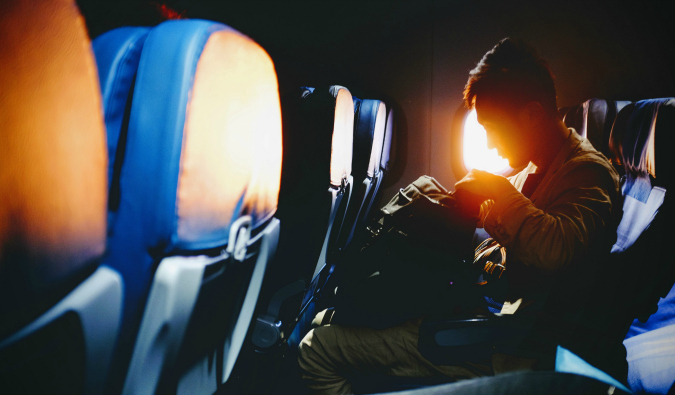
Most people aren’t born savvy travelers. It’s something that only comes with on-the-road experience. Travel savviness is a process born of missed buses, foolish behavior, cultural unawareness, and countless tiny errors. Then, one day, you begin to seamlessly move through airports and integrate yourself into new cultures like a fish to water.
In the beginning, you just make a lot of travel mistakes.
But I want to help speed up the process and help you avoid my mistakes ( and I often make a lot of them ), so I put together this giant list of my best travel tips that cover everything under the sun to help you reach your full travel ninja potential.
I’ve learned these tips over the last sixteen years being a nomad.
These tips for traveling will have you saving money, sleeping better, getting off the beaten path more, meeting locals, and just being a better traveler.
So, without further ado, here are the best 61 travel tips in the world:
1. Always pack a towel. It’s the key to successful galactic hitchhiking – and plain common sense. You never know when you will need it, whether it’s at the beach, on a picnic, or just to dry off after a shower. While many hostels offer towels, you never know if they will or not, and carrying a small towel won’t add that much weight to your bag.
Make sure it’s a lightweight, quick-drying towel since regular towels are too bulky and heavy (and they take a long time to dry). Dry Fox travel towels are my favorite (use the code “nomadicmatt” for 15% off your purchase)!
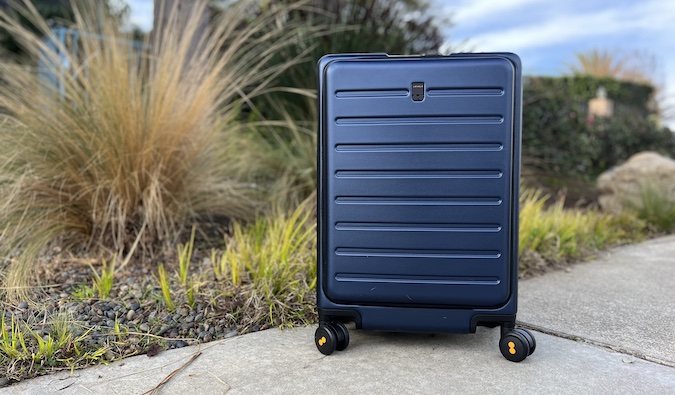
My favorite bag is the Flash Pack from REI . Other companies offering high-quality bags are Osprey, Nomatic, and MEC (for Canadians).
This article has more tips on finding the best travel backpack for your needs.
The same rule applies to suitcases. Don’t take a huge suitcase because they are a pain in the butt to lug around, especially if you’re traveling long term (short term, not so much). I like Level 8 suitcases. They are durable, quite spacious, nicely designed, and well-priced (luggage can be pretty damn expensive). Plus, they have a TSA lock built into the zipper. You can click here to learn more and buy one .
I also recommend packing cubes , which are essential if you’re going to be living out of a backpack for a few weeks (or months), or you just want to keep your suitcase better organized. They come in a variety of sizes, allowing you to store items big and small. They’re great for making it easy to find everything in your backpack or suitcase.
3. Pack light. Write down a list of essentials, cut it in half, and then only pack that! Plus, since you bought a small backpack like I said above, you won’t have much room for extra stuff anyways! Take half the clothes you think you will need…you won’t need as much as you think. It’s OK to wear the same t-shirt a few days in a row.
I love Unbound Merino , as their travel clothing can be worn daily for weeks without getting smelly. They are super light and they look sylish too. I really love the material, they’re comfortable, they hardly ever need a wash, and they last forever!
Click here for more packing tips .
4. But take extra socks. You’ll lose a bunch to laundry gremlins, wear and tear, and hiking so packing extra will come in handy. Take a few more than you need. Trust me on this. Nothing beats a fresh pair of socks!
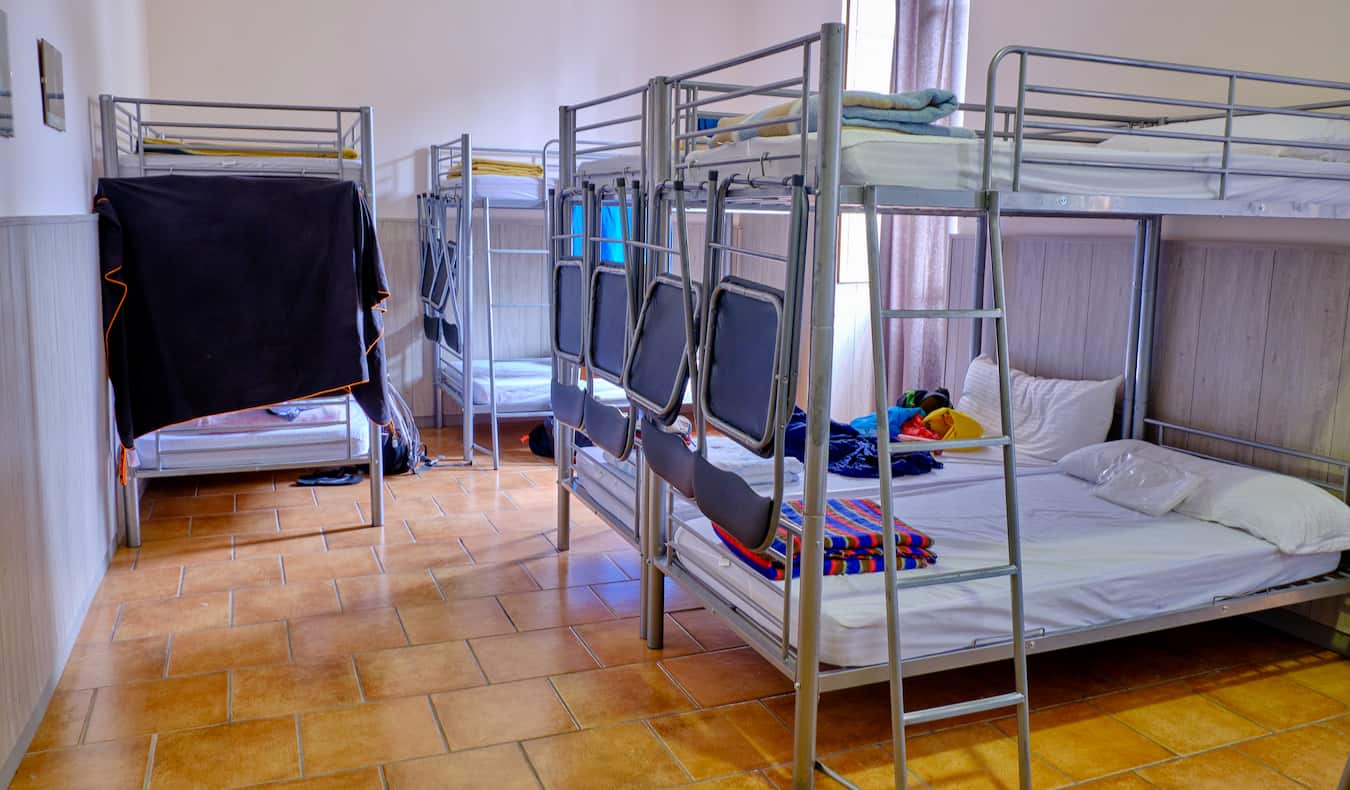
Here’s a list of all my best hostels around the world . If you’re planning on backpacking Europe , it’s worth getting HostelPass , a card that gives you up to 20% off hostels throughout Europe. It’s a great way to save money, and they’re constantly adding new hostels too. I’ve always wanted something like this and so I’m glad it finally exists. Use code NOMADICMATT for 25% off.
6. Take an extra bank card and credit card with you Disasters happen and things get stolen or compromised. I once had a card duplicated and a freeze put on it. I couldn’t use it for the rest of my trip. I was very happy I had a backup. You don’t want to be stuck somewhere new without access to your funds. This happened to a friend once and they had to borrow money for me for weeks while they waited for their new card to arrive.
Here are some helpful articles on banking:
- How to Avoid Banking Fees While Traveling
- 22 Ways to Cut Your Expenses and Have Money for Travel
- How to Pick the Best Travel Credit Card
7. Make sure to use no-fee bank cards. Don’t give banks your hard-earned money. Keep that for yourself and spend it on your travels. Get a credit card and debit card that doesn’t charge a foreign transaction fee or an ATM fee. Over the course of a long trip, the few dollars they take every time will really add up!
Here’s an article that will tell you how to do that.
8. Don’t fly direct. When booking flights, sometimes it is cheaper to fly in to airports close to your final destination, and then take a train, bus, or budget airline to where you need to go.
To use this method, find out how much it is to go directly to your destination. Then, look at prices to nearby airports. If the difference is more than $150 USD, I look to see how much it is to get from the second airport to my primary destination.
My favorite flight search engine is Skyscanner . This is my go-to website for finding cheap flights. It searches a lot of different airlines, including many of the budget carriers that larger sites miss.
Here are some more tips on finding cheap flights!

Here are some helpful articles on solo travel:
- Why I Travel Alone
- The Joy of Solo Travel
- Travel: The Ultimate Personal Development Tool
- How to Overcome Being Alone
- Reading People: One Skill Travel Has Taught Me
10. Always visit the local tourism information center. This is probably one of the most underused travel tips in the world. Tourism information centers know about everything going on in town. They can point you to free activities, special events happening during your stay, and everything in between. They even offer discounts on attractions and transportation. It is their job to help you experience the destination better. It’s amazing how many travelers skip this when they are visiting somewhere but, as a savvy traveler, you know to use this resource!
11. Take free walking tours. Besides being free, these tours will give you a good orientation and background of the city you are visiting. I love, love, love taking walking tours when I travel. You pass the time, you get to pepper the guide with questions, and you get to learn so much about where you are. Here are some of my favorite walking tour companies around the world:
- The Best Walking Tours in New York City
- The Best Walking Tours in London
- The Best Walking Tours in Paris
- The Best Walking Tours in Berlin
- The Best Walking Tours in Amsterdam
And while free walking tours are great, sometimes it’s worth it to take a paid walking tour if you’d like to dig deeper into a particular aspect of the destination. Walks is one of my favorite paid walking tour companies, offering in-depth history and cultural tours in cities around the world (especially Europe). Its small-group tours also tend to offer exclusive behind-the-scenes access you can’t get elsewhere.
For fellow foodies, Devour Food Tours has all kinds of amazing food tours around Europe.
12. Don’t be afraid to use a map. Looking like a tourist isn’t as bad as getting really lost and ending up in the wrong neighborhood. Don’t be afraid to use a map or ask for directions and look like a tourist. After all, you are one!
13. But don’t be afraid to get purposefully lost. Wandering aimlessly through a new city is a good way to get to know it, get off the beaten path, and away from the tourists. You might be surprised by the hidden gems you find. I like to wander around and try to find my way without using Google Maps. Travel is the art of discovery and you never know what cool little spot you’ll come across.
14. Ask hostel staff for information — even when you aren’t staying there. Hostel staff deal with budget travelers all day, every day. They know exactly where to go for cheap meals and attractions. They also tend to be locals so they know the city very well. Ask them for all sorts of information. Even if you aren’t staying in one, just pop in and ask for help. They’ll usually give it.
15. Sign up for flight deals. When it comes to travel, your flight(s) will likely be your biggest expense. Save money by signing up for flight deal websites. You’ll get epic flight deals straight to your inbox, saving you time and money. Also be sure to sign up for airline newsletters, since that is where they will announce their sales first. The best websites for finding travel deals are:
- Going (formerly Scott’s Cheap Flights) – The BEST for upcoming US flight deals.
- The Flight Deal – Great for global flight deals.
- Holiday Pirates – The best for European flight deals.
- Secret Flying – A great site for flight deals from around the world.
16. Don’t buy a money belt — they’re stupid. Thieves know they exist and being seen with one basically shouts, “Look at me, I’m a tourist with money! Rip me off!” The more you can blend in and act like a local, the easier it will be to get deals and avoid touts. If you’re worried about pickpockets, keep a better eye on your stuff!
17. When you go out, take only what you need. Limit the amount of cash and bank cards you carry with you when you go out, so if something does happen, you can easily recover. Never take more than one credit card or ATM card with you. My rule for cash is to limit what I carry to $50 USD.
18. Always carry a lock. Carry a small combination lock with you when you travel. They come in handy, especially when you stay in dorms. Most hostels use lockers, so budget travelers need to provide their own travel lock to keep stuff secured. While you can usually rent or buy them at hostels, it’s much cheaper just to buy one before you go. (Just don’t use one with keys because if you lose the keys, you’re screwed!)
19. Make extra copies of your passport and important documents. Don’t forget to e-mail a copy to yourself too. You never know when you might need to have some sort of documentation with you and might not want to carry your original. Additionally, if your passport gets stolen having a copy will come in handy for your police report.
20. Learn basic phrases in the native language of your destination. The locals will appreciate it and it will make your interactions easier. You don’t need to master the language but learning a few things like “Hello,” “Goodbye,” “Thank you!”, “Where’s the bathroom?” will go a long way to endearing yourself with the locals. They’ll like that you tried.
Here are some tips on how to learn a language .
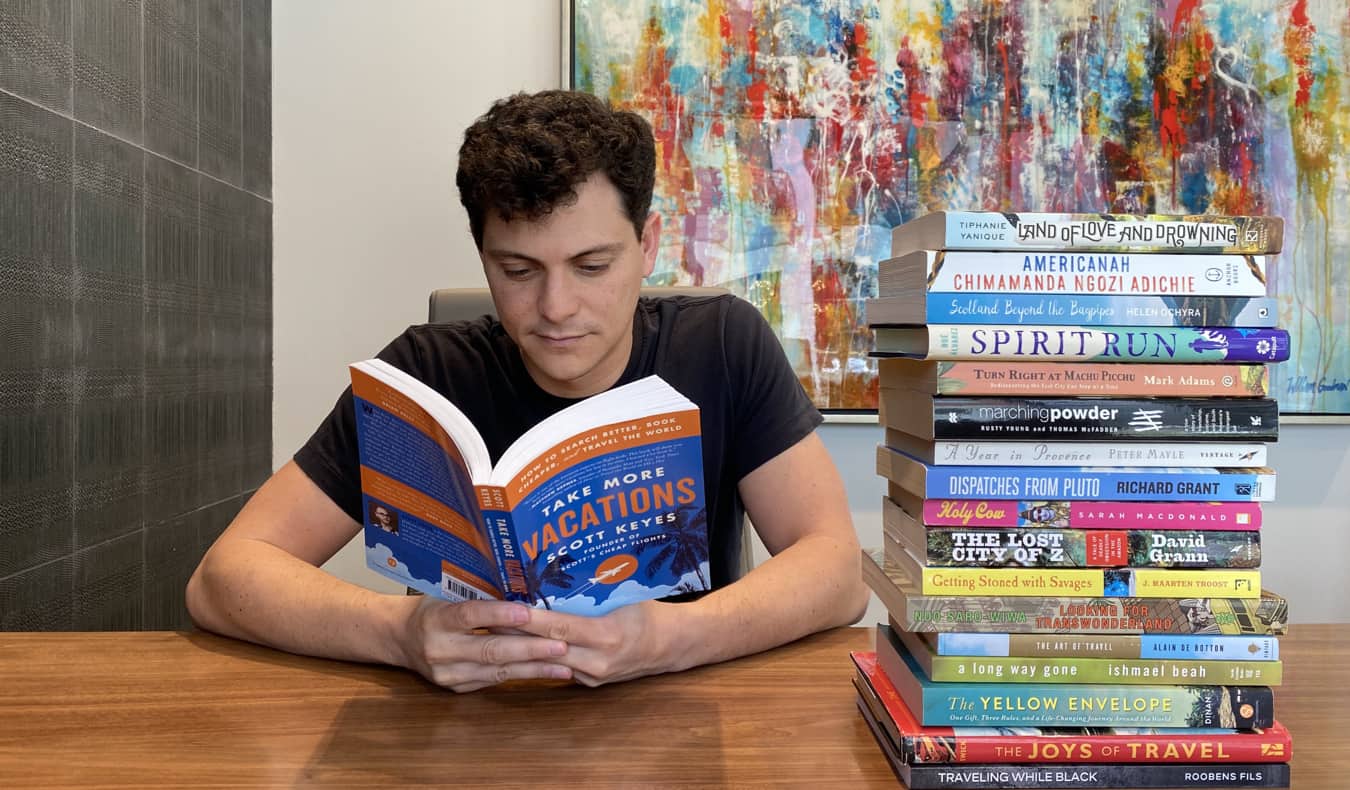
Here are some posts that highlight my favorite reads:
- 13 Travel Books That Will Give You Serious Wanderlust
- The Best Travel Books
- 12 Books to Take You Around the World
22. Don’t be ashamed to walk into a Starbucks or McDonald’s. Sometimes familiarity is comforting and both places have free wifi and public restrooms you can use. (Just don’t eat the food at McDonald’s! That shit is gross and unhealthy for you! You can get it back home!). Libraries and most modern coffee shops also have free Wi-Fi too.
23. Always get behind business travelers when in security lines. They move fast since they are usually in a rush and travel light. They know the drill. Line up behind them as much as possible. You’ll speed through the line!
24. Never get behind families in airport security. They take forever. It’s not their fault. They just have a lot of stuff because of the kids. Try to avoid getting in lines with lots of kids. It’s going to take a while.
25. When you check in to the hotel, don’t be afraid to ask for an upgrade. They have a lot of flexibility when it comes to assigning upgrades at check-in. It never hurts to ask. Often times they can accommodate you if the hotel isn’t full. Just be super nice!
Note: If you stay in hotels frequently (or want to), it might be worth it to get a hotel credit card . You can earn points on your everyday spending at home and convert those points into free stays. The best cards come with status, making upgrades more likely too!
26. Write down your experiences. Even in this hyper-technological age, I think everyone needs to write more during their travels so they have something to look back on. I never leave home without a journal. Not only do I use them for work (I’m constantly taking notes and writing down ideas) but I also use them to keep track of my travels.
Simple travel journals work great for journaling during your trip as well as for writing down logistical information like directions, contact information, and language tips.
If you want a travel journal that isn’t just blank pages but rather has space for itinerary planning, places to jot notes in the local language, inspirational quotes, and more, grab our new travel journal. It was designed specifically with travelers in mind, so you can take notes as well as write down stories and reflections during your travels.
27. Lunchtime is the best time to visit historical sites. Be a contrarian. You’ll have fewer crowds getting in your way as big tour buses, groups, and most travelers head to lunch. It’s always best to visit an attraction super early, late, or when people eat. You’ll have even the most popular places to yourself!
28. Never eat in a touristy area or near a tourist attraction. As a general rule, I walk five blocks in either direction before I find a place to eat. The closer you are to tourist attractions the more you are going to pay and the worse the food (and service). Use websites like Yelp , Google Maps , or Open Rice to find some delicious and popular restaurants around you.
Additionally, never eat anywhere the menu is in like 6 languages! That means the restaurant is just for tourists!
29. Locals don’t eat out every night and neither should you. Go grocery shopping. You can learn a lot about locals’ diets by seeing the type of food they buy. Plus, it will save you a lot of money. You won’t regret it. Cook your food, save money, and surprise yourself!
30. Eat at expensive restaurants during lunch. Most expensive restaurants offer lunch specials featuring the same food they would serve for dinner but for a fraction of the cost! That’s the best time to eat out when you travel.
I share more tips on how to eat cheaply around the world here.
31. Pack a headlamp. This is a handy tool for both backpackers and anyone looking to do any hiking or camping. If you’re going to be staying in a hostel, having a headlamp is helpful when you need to check in or out but don’t want to disturb your fellow travelers by turning on the lights. They’re also helpful in emergencies.
32. Carry a basic first-aid kit. Accidents happen, so be prepared. I always take band-aids, antibacterial cream, and ointments for minor cuts and scrapes. You never know when you’re going to need it and you can’t always get it when you travel.
You can either assemble a first aid kit yourself ( here are some tips for doing so ), or purchase a pre-made kit online .
33. Don’t believe the cheap flight myths. Don’t drive yourself too crazy trying to get the absolute cheapest fare. There are a lot of myths online about how to find cheap flights, but there is no magic bullet or one secret ninja trick. It’s not cheaper to book on a particular day of the week, or if you search in an incognito window.
Spending five hours to try to save $10 will cause you a lot of stress. Once you find a flight deal that you’re happy with, book right away, as airfares change by the minute. Remember, you usually have a 24-hour window to cancel in case you need to.
Here are some article on how to save money on flights:
- 5 Steps to Booking a Cheap Flight Online
- How to Always Find a Cheap Flight
- Where I Find the Best Travel Deals
34. Use Meetup, the sharing economy, and hospitality websites to meet locals. These websites will help you get an insider’s perspective on your destination by connecting you with locals in the places you visit. The sharing economy has changed the way people travel allowing you to meet locals, get off the tourist travel, and save mega money! It’s a triple win – and I use these resources all the time when I travel.
Here’s an article on how to use the sharing economy (and what websites to use) when you travel.
35. Be open to strangers. Not everyone bites. Say hi to people on the road. Turn strangers into friends. Remember they are just like you! They want to live a happy, full life and have hopes and dreams too! You never know. You just might make some lifelong friends.
36. But keep your guard up. Some people do bite, so keep a healthy level of suspicion. You don’t want to fall for any travel scams or get yourself into uncomfortable situations. Be open but cautious. Here is a list of travel scams to avoid.

- My Favorite Restaurants in Europe
- The Best Places to Eat in NYC
- How to Eat Cheap Around the World
- 30+ Places to Eat in Tokyo
- How to Eat Around the World on a Vegan Diet
38. Avoid taxis. They are always a budget buster. Never, ever take a taxi unless you absolutely have too!
39. Take a reusable water bottle through airport security and fill it up at your gate. Single-use plastics are common in a lot of countries around the world. They’re also polluting our oceans and destroying the environment. Drink from the tap when you can — you’ll save money and help the environment. If you’re going somewhere where you can’t drink the water, be sure to get a water bottle with a filter. I love Lifestraw .
40. Get city attraction cards. If you are going to visit a lot of museums and other attractions in a short period of time, a city pass is going to save you money on admission (plus most provide free public transportation too!).
41. Take pictures of your luggage and clothes. If your bag gets lost, this will help identify it more easily and speed up the process of having your travel insurance reimburse you.
42. Carry emergency cash. Because emergencies happen, like that time in Romania when I couldn’t find an ATM and needed money for the bus to the hostel. I usually try to keep around $200 USD in emergency cash in case something happens!
43. Get good shoes. You walk a lot when you travel. Don’t beat up your feet. Love them as much as they love you, and they’ll take you to amazing places.
My favorite shoes for traveling are Suavs shoes , which are versatile and durable. They’re comfortable and great for exploring a new city all day, but also look nice enough that you can dress them up if you want to at night.
44. Get vaccinated. Because falling prey to an illness in a foreign country is not fun — and many countries require you to get vaccinated in order to visit them. So regardless of your opinion on the subject, you just might have to.
Here is an article on how to stay healthy on the road.
45. Learn to haggle. Haggling is a fun, playful way of not getting charged the foreigner price. It’s the art of negotiating and one that will help you throughout all of life, not just at the market.

Here are some articles to help you get started with using points and miles:
- Points and Miles 101: A Beginner’s Guide
- How I Earn 1 Million Frequent Flier Miles Every Year
- The Best Travel Credit Cards
- The Ultimate Guide to Picking the Best Travel Credit Card
47. Take a jacket. Nights get chilly.
48. Eat street food! If you skip the street food, you miss out on culture . Don’t be scared. If you’re nervous, look for places where kids are eating. If it’s safe for them, it’s safe for you.
49. Get travel insurance. Travel insurance is the most important thing to get that you never want to use. If something goes wrong, you don’t want to be out thousands of dollars in bills. Travel insurance will be there if you get robbed, flights get canceled, you get sick or injured, or have to be sent home. It’s comprehensive and, for just a few dollars a day, one of the best investments you can get for a trip.
You may think you’re superman/woman but so did my friend who broke her arm, didn’t have insurance, and had to pay thousands out of pocket. Insurance was there when I had to replace my camera and when I popped an eardrum scuba diving! Get it! Here are some tips on how to find the best travel insurance.
My favorite companies are:
- SafetyWing – A budget-friendly choice for travelers who need basic coverage. They are affordable, have great customer service, and make it easy to make a claim. If you’re on a tight budget, go with SafetyWing!
- Insure My Trip – The best insurance for those over 70 years old.
- Medjet – This is a membership program that provides emergency evacuation coverage should you get into a dire situation while traveling and be hospitalized. Medjet is meant to supplement your regular travel insurance.
50. Be patient. Things will work out in the end. No need to rush. You’ll get to where you are going in due time. Travel is about the journey, not the destination.
51. Be respectful. Locals are willing to help you out, but there’s probably a language barrier, so keep your cool when something doesn’t go your way. If you don’t, you’ll end up just looking like an asshole tourist.
52. Don’t over plan your trip. Let your days unfold naturally. Schedule two or three things and let the day fill in the rest on its own. It’s less stressful, and letting the day just take you is one of the best ways to travel. Here’s my advice on how not to over plan your travels!
53. Relax. See Be patient .
54. Be frugal — but not cheap. Don’t be pennywise but pound-foolish. Look for deals and don’t waste money, but don’t miss out on great experiences or walk 10 miles to save a couple of dollars. Time is money. Spend them both wisely.
55. Take earplugs. Anyone who has ever stayed in a hostel knows that earplugs are a necessity. Snorers are everywhere and you need your sleep.
But even if you’re not going to be in a hostel, they’re still helpful for sleeping well if your accommodation is located on a busy street, or for sleeping in buses, overnight trains, and other types of transportation. A good night’s sleep is priceless — be prepared!
These earplugs are reusable and work much better than the cheap foam ones, blocking out any distracting noises.
56. Always carry a power bank. Batteries die. Your good mood shouldn’t.
We all travel with numerous electronic devices like phones and tablets, but it can be hard to keep them all charged. An external battery solves that problem.
57. Remember that you’re not alone even if you’re traveling solo. Traveling alone never means you’re really alone. Wherever you go, there is a network of travelers who will be your friends, give you advice or tips, and help you out. They will guide you, point you in the right direction, and be your mentors. You aren’t out there on your own. You’ll make lots of friends and tons of memories.
If you’re not sure about traveling on your own for the first time, you can always join a group tour, such as those we offer at The Nomadic Network . I’ve designed all the itineraries myself to ensure they cover the highlights, get you off the tourist trail, and connect you with friends and locals.
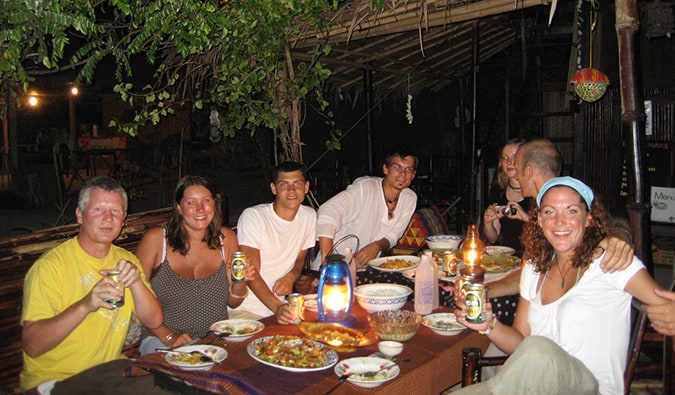
59. Pre-book your tickets to attractions, activities, and excursions online. If you’re planning to do any activities or excursions on your trip, book them online. Companies usually offer a discounted price when compared to buying in person. Not only that but you’ll be able to pay with a credit card, giving you some extra protection as well as more travel points!
Many major attractions also allow you to reserve your spot and skip the line. Always look online to see if this is an option. This will you to avoid wasting time in multi-hour lines and go right in. I’ve seen people wait hours for the Paris Catacombs, Louvre, London Churchill War Rooms, churches, temples, historic fortresses, and more. Pre-book the day before, skip the line, get to see more during your day!
Get Your Guide is my favorite place to book activities in advance. It’s a huge online marketplace for tours and excursions, with tons of options in cities all around the world, including skip-the-line attraction tickets, cooking classes, walking tours, and more!
60. Avoid TripAdvisor. TripAdvisor is fine when you need opening hours or an address, but when it comes to reviews I ignore it completely. People always leave a negative review when something bad happens but rarely leave a positive review when something good happens so the reviews tend to be skewed.
On top of that, it’s very easy to create fake reviews and make a place seem better than it is. Many hotels and restaurants hire firms to artificially inflate their reviews on the platform. Additionally, TripAdvisor has been known to take down reviews that are overly negative as well as reviews on sexual assault. Use TripAdvisor with caution. Or better yet, don’t use it at all.
61. Finally, wear sunscreen. For as the Baz Luhrmann song “Everybody’s Free (To Wear Sunscreen)” goes:
If I could offer you only one tip for the future, sunscreen would be it. The long-term benefits of sunscreen have been proved by scientists Whereas the rest of my advice has no basis more reliable Than my own meandering experience.
*** There you have it! My top travel tips! Follow them and you’ll be the best traveler you can be in no time flat!
Book Your Trip: Logistical Tips and Tricks
Book Your Flight Find a cheap flight by using Skyscanner . It’s my favorite search engine because it searches websites and airlines around the globe so you always know no stone is being left unturned.
Book Your Accommodation You can book your hostel with Hostelworld . If you want to stay somewhere other than a hostel, use Booking.com as it consistently returns the cheapest rates for guesthouses and hotels.
Don’t Forget Travel Insurance Travel insurance will protect you against illness, injury, theft, and cancellations. It’s comprehensive protection in case anything goes wrong. I never go on a trip without it as I’ve had to use it many times in the past. My favorite companies that offer the best service and value are:
- SafetyWing (best for everyone)
- Insure My Trip (for those 70 and over)
- Medjet (for additional evacuation coverage)
Want to Travel for Free? Travel credit cards allow you to earn points that can be redeemed for free flights and accommodation — all without any extra spending. Check out my guide to picking the right card and my current favorites to get started and see the latest best deals.
Need Help Finding Activities for Your Trip? Get Your Guide is a huge online marketplace where you can find cool walking tours, fun excursions, skip-the-line tickets, private guides, and more.
Got a comment on this article? Join the conversation on Facebook , Instagram , or Twitter and share your thoughts!
Disclosure: Please note that some of the links above may be affiliate links, and at no additional cost to you, I earn a commission if you make a purchase. I recommend only products and companies I use and the income goes to keeping the site community supported and ad free.
Related Posts
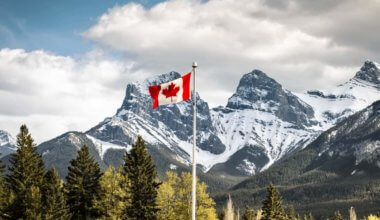
GET YOUR FREE TRAVEL STARTER KIT
Enter your email and get planning cheatsheets including a step by step checklist, packing list, tips cheat sheet, and more so you can plan like a pro!

How much should I tip when I travel?

Editor's Note
Even the most seasoned travelers may find tipping while traveling to be complicated and stressful.
After all, most of us want to thank the right people for great service and don't want to stiff underpaid employees who might be depending on gratuities. At the same time, we don't want to double-pay service charges already included in our bills or inadvertently insult someone in a foreign country.
So, who deserves a tip, and when and where should you give it? Also, how much should you tip?
Tipping customs vary based on your destination and what sort of travel you are doing. For hotels, tipping can depend on the room rate, the level of service and the details of your stay. (Did you refuse housekeeping for the duration of your trip? Or, did you trash the room with a massive all-night party?)
The COVID-19 pandemic also impacted the world of tipping. Housekeepers, for example, may have much more extensive cleaning regimens even though they might not touch your room during your stay. Also, short-staffed hotels may add more responsibilities for already overworked employees.
To help you decide how much you should tip during specific travel situations, from tours to hotels to all-inclusive vacations, here's what to know.
Tipping tour guides
Let's start with how much to tip tour guides. Not unlike when you dine at a restaurant, there's a general consensus to tip tour guides based on the level of service you receive.
For tour guides, we recommend tipping 10% to 20% of the overall tour's cost. Of course, you're always welcome (and encouraged) to tip more for exceptional service if you feel inclined.
Whom to tip at hotels
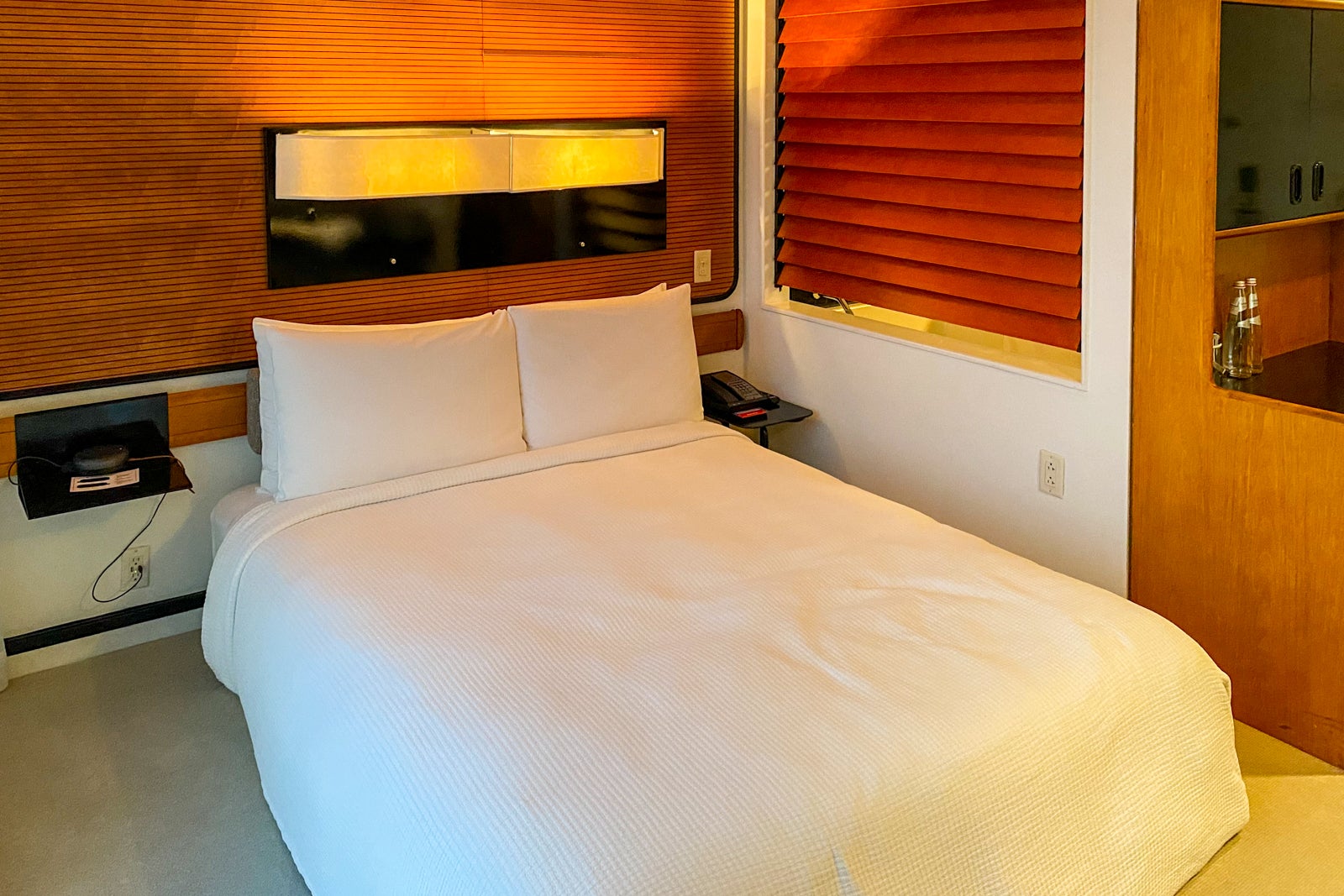
When many hotels eliminated housekeeping services during the COVID-19 pandemic, I got out of the habit of traveling with the cash I used to carry specifically for tipping housekeeping.
But if there's anyone within hotels you should tip, it's housekeeping. Many experts agree that you should tip housekeeping $3 to $5 per day, depending on the length of your stay, your room rate and the level of service.
"These are the hardest-working people in the hotel and the least recognized," Tom Waithe, general manager of the Alexis Hotel Seattle, previously told TPG.
You should, however, be on the lookout for hidden housekeeping fees that some hotels have been adding to room charges — sometimes up to $40 per day. In these cases, a gratuity is not expected, though it's still possible that those hotels are not sharing these fees with staff.
A rule of thumb states that luggage attendants who help you with your bags at hotels (and airports) should receive $1 to $5 per bag. Round up for large groups of bags or if the attendant must take multiple trips or handle fragile or special-request items.
For car valets, a couple of dollars is typically appropriate; you may want to tip more if the valet delivers on a rush request. If you're staying at a hotel for a while and expect to use your car often, start the valet out with a larger tip of about $10 dollars, and explain your situation. You'll likely get your car parked closer and delivered ahead of other people's cars daily.
Butlers and concierges, especially at luxury hotels, should also be tipped an amount determined by what services they've delivered for you. Tipping the head door person at a hotel can also be a way to get improved service during a longer visit.
Who doesn't need a tip at a hotel, then? The people delivering room service meals where a (usually hefty) service charge has already been added to the tab do not necessitate a tip. Of course, you can still feel free to tip them. In the rare cases when gratuity isn't included or if you've asked the staff for some out-of-the-ordinary services, those circumstances would warrant tipping.
Related: Innovations in hotel stays: How to give guests the next-level experience
Tipping around the world
If you've ever traveled outside the U.S., you may have received mixed messages about tipping or confused faces from non-Americans when discussing tipping culture in this country.
In some countries — such as Australia, Japan and China — tipping is not common. It's actually frowned upon in Japan.
"Tipping abroad is so much more than converting currencies. Many countries and cultures each adopt their own nuanced take on this, at times, delicate matter," Tom Marchant, co-founder of the luxury travel company Black Tomato, told TPG. In Australia, where tipping is "not a common transaction," it can even make recipients a bit uncomfortable.
Otherwise, you should distribute tips as you do in the U.S. when visiting most of Europe, touristy areas of Mexico, the Caribbean (excluding all-inclusive resorts ) and Canada. Tipping is also customary in India and the Middle East.
In Central and South America, leaving small amounts of change in the local currency is greatly appreciated. If you're traveling to Africa, expect more intricacies, depending on whether or not you're on safari or staying at an urban property in a major city.
If you're unsure what's customary in a specific destination, feel free to ask around or err on the side of being overly generous.
Related: The ultimate guide to tipping in Europe
When to tip on an all-inclusive vacation

Speaking of all-inclusive resorts, know that daily service charges are typically included in your bill if you're on a cruise or staying at an all-inclusive resort. However, be sure to double-check your folio carefully or inquire with the front desk upon check-in. Also, be sure to verify what's included in a property's resort fees, even for non-inclusive properties.
According to Lindsey Epperly Sulek — founder of Jetset World Travel and a Caribbean travel expert — most traditional all-inclusive resorts, like Sandals in the Caribbean, include gratuity.
If gratuities are not included, you can follow the previously mentioned hotel guidelines : $1 to $5 per bag for the bellhop, $5 per day for housekeeping (left every day), nothing extra for room service (if included on the bill) and a sliding scale for concierges, depending on the task's difficulty.
If you're taking a tour from an all-inclusive resort — such as for a safari — tip your guides and the driver.
Related: The 17 best all-inclusive resorts in the US for a spectacular vacation
Tipping staff during a cruise
Whether they're called service charges or gratuities, the automatic fees cruise lines charge daily to passengers' onboard accounts — sometimes as much as $25.50 per person, per day — are designed to replace cash tipping. It's a policy that was put in place so cruisers won't feel obligated to tip or worry about when and where to present gratuities.
In addition to passenger-facing crew members, such as waitstaff and cabin stewards, many other crew members see a portion of service fees. This includes people who wash dishes and work in cruise ship laundry rooms. You can pay these fees in advance or have them added to your onboard bill. You can adjust the gratuity amount up or down by visiting the guest services desk during your sailing.
If you want to provide an extra boost to a crew member who has gone above and beyond, mention them in your post-cruise survey so they can receive higher-level recognition. This is something that could come with more long-term benefits than a tip.
If you find yourself on a sailing that doesn't charge daily gratuities or you want to tip extra for stellar service, be sure to bring cash. There might also be a tip box by the reception desk.
Have a favorite bartender or waiter on your sailing? An extra gratuity paid early during your trip will go a long way to ensure that above-average service continues throughout your vacation. Keep in mind that most cruise bar purchases and spa treatments automatically include gratuities ranging from about 15% to 18%. There's no need to tip extra unless you want to.
Related: Can I remove prepaid gratuities on a cruise?
Tipping flight attendants and airport employees
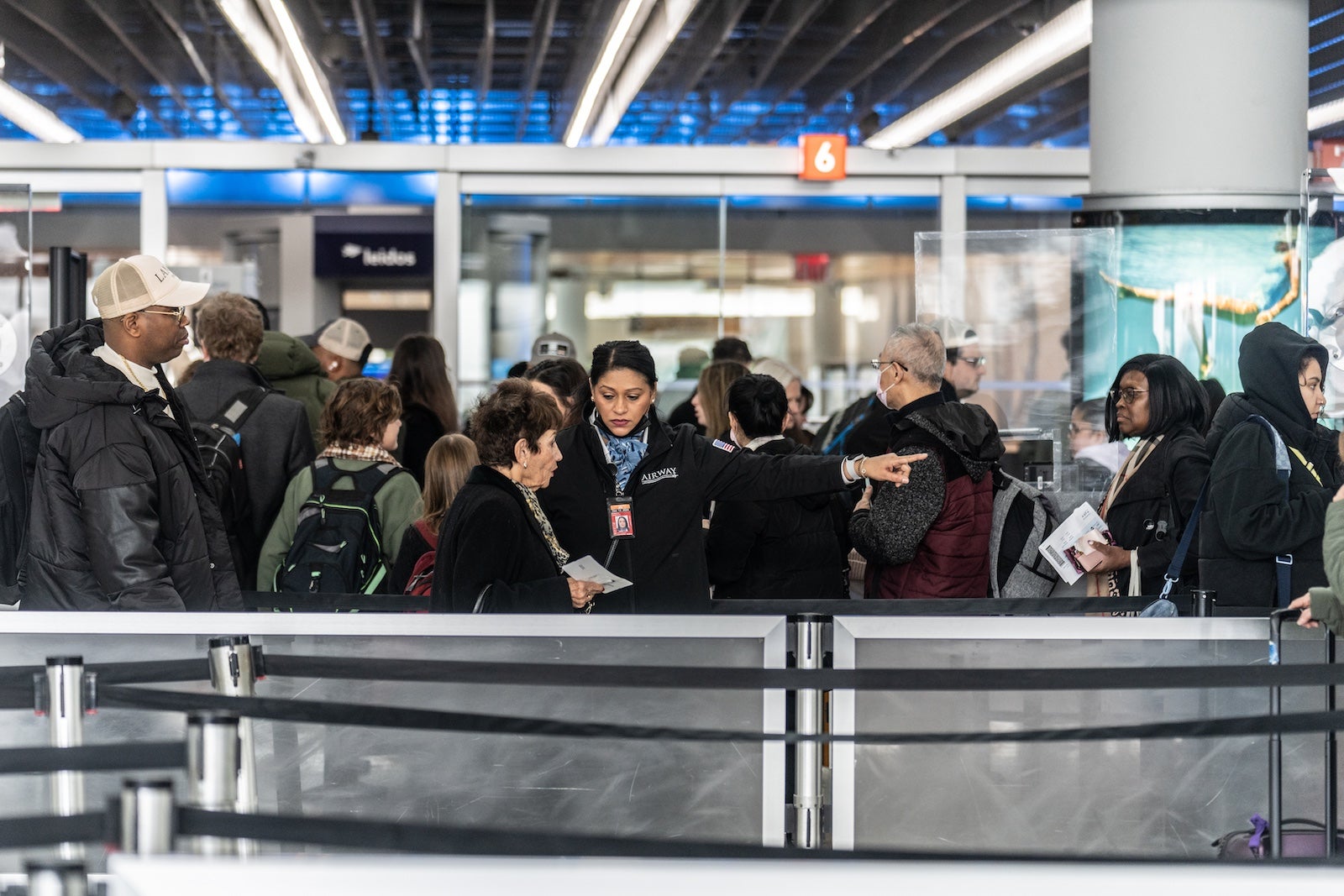
Generally, airline employees like flight attendants are not allowed to accept any tips on the job. However, airport staff members are permitted to do so.
One notable exception is Frontier Airlines, which has an inflight tipping program.
Airline employee unions have fought against allowing flight attendants to accept tips, which may seem counterintuitive. However, labor laws allow employers to pay sub-minimum wages if the employees are assumed to be receiving gratuities on a regular basis. Don't be insulted if flight attendants refuse your tip offers — they're doing so to protect their salaries.
Many airlines provide ways passengers can recognize services provided by flight attendants and other employees. For example, Southwest Airlines has its Commend an Employee program that lets you leave positive comments online. This may have a more positive impact than the dollar tip you offered for your gin and tonic.
Should you want to show your appreciation for a particularly friendly or helpful flight attendant, note that gifts such as snacks or coffee shop gift cards are OK.
Bottom line
Tipping is often customary when traveling, depending on where you go, what service you receive and the level of service provided.
Bookmark this guide for your next international trip.
Related reading:
- 8 lessons I learned from my 1st all-inclusive vacation
- 10 times you do not need to tip on a cruise
- Mobile tipping comes to hotels: Will housekeepers really benefit
- We asked a flight attendant for their top insider tips on flying like a pro
SUMMER GETAWAY IDEAS?
New! Find answers in a flash with Scout, our friendly AI chat otter.
BEST WEEK EVER
Try out unlimited access with 7 days of Outside+ for free.
Start Your Free Trial
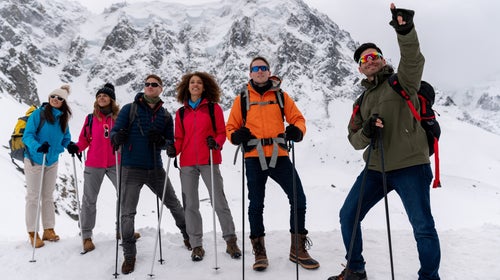
How Much Should I Tip My Guide? We Asked Guides How Much to Give.
Tipping is part of life, but it often feels confusing and stressful. Whether you’re on a river trip, a safari, or taking a ski lesson, we asked all the hard questions to provide these guidelines on how much to give—and how to do it right.
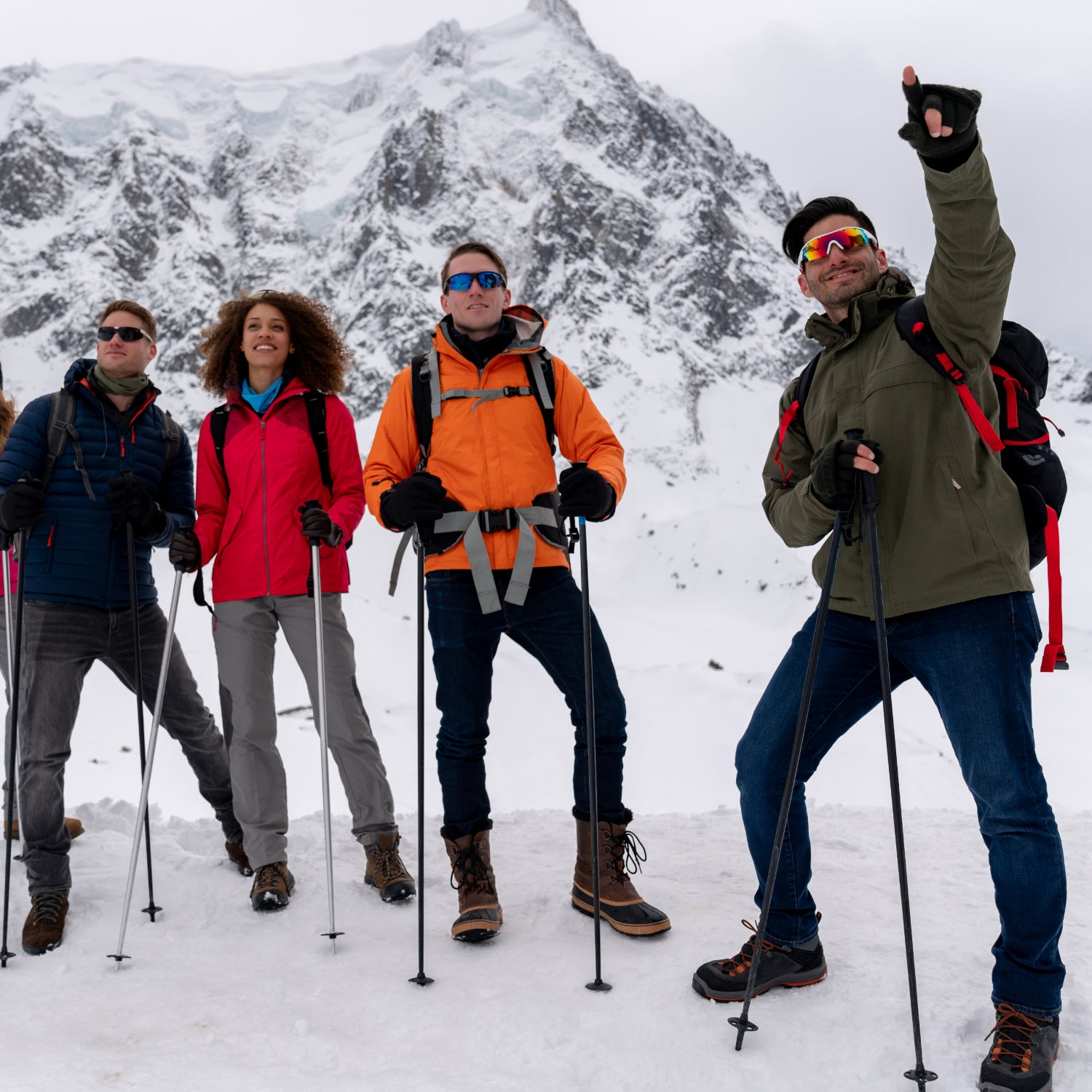
Heading out the door? Read this article on the Outside app available now on iOS devices for members! >","name":"in-content-cta","type":"link"}}'>Download the app .
I was on a backcountry hut trip in British Columbia last winter, and at the end of an incredible, powder-filled week, my group of friends and I realized what most of us had forgotten: cash. Specifically, enough money to tip our two hard-working ski guides, as well as the cook, who’d been making us delicious meals morning and night, and the hut caretaker, who’d been pre-heating the sauna and shoveling the path to the outhouse.
It was a major oversight on our part. In the end, we cobbled together what cash we had and the rest of us chipped in via PayPal, a clunky fix.
In America, we know that when we go into a restaurant, it’s expected that, assuming the service is decent, you will leave your waiter a 15 to 20 percent tip on the bill. But when you go on, say, a guided backcountry ski trip or a whitewater rafting trip with a commercial outfitter or an afternoon of guided fly-fishing, the assumptions of gratuity are less clear. Are you always supposed to tip in those cases, and if so, how much?
“Guiding is very similar to the restaurant industry. It’s a service industry,” says Shane Robinson, a Seattle-based mountain guide and the founder of Graybird Guiding . He also guides for the company Alpine Ascents International . “Unfortunately, guides are probably not paid as well as they should be. So, most guides rely on those tips to make ends meet.”
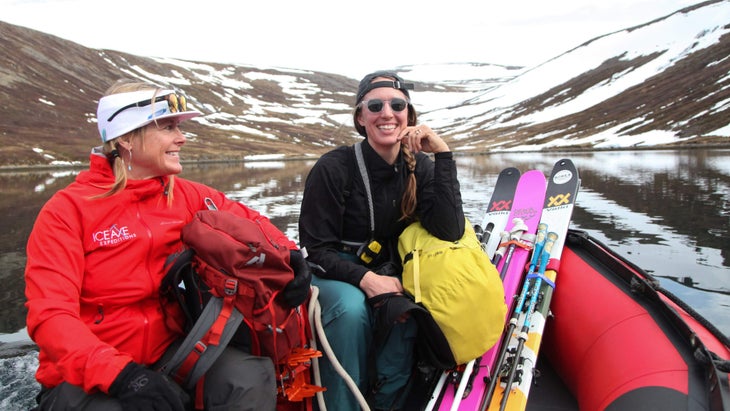
Tips for outdoor guides and instructors vary wildly—some people tip a lot, some less, others don’t tip at all—and every destination is different. If you’re traveling internationally, many countries don’t have a tipping culture like the U.S.
“Tipping these days is much more common, but it’s not across the board,” says Dave Hahn, a long-time guide for RMI Expeditions who has guided on peaks like Mount Rainier and Mount Everest. “I think of a tip as a reward for a meaningful time or for someone putting themselves out there for you, not as an expectation.”
Given that guides are often the one who makes your trip or instruction stand out above the rest, we recommend always being prepared to tip. But sorting out how much to give and when to give it after a shared adventure can be awkward, confusing, and feel so hush hush, like no one’s talking openly about it.
Well, we are. We asked all the hard and awkward questions to provide these dos-and-don’ts guidelines on how to tip like a pro.
1. Do the Math
Typically, the gratuity rate for guides should be around 10 to 20 percent of the total trip cost. That means if you’re paying $500 for a day or two of guided rock climbing, an appropriate tip for your guide would be between $50 and $100.
2. Do Tip Even On Pricey Trips
Maybe you’ve just thrown down $5,000 for a Grand Canyon river trip. That’s a huge chunk of cash for a guided trip. Do you really have to tip on top of that? The answer is yes. “I sometimes find that when the cost of the trip is higher, people tend to tip less,” says Canadian guide Holly Walker, an ACMG-certified hiking and ski guide and owner of Fall Line Guides .
What helps me is to go ahead and factor in a 10 to 20 percent tip based on the total price of the trip into my initial budget to reduce the shock factor. So for that $5,000 trip, I’d tip $500 to $1,000 to be split up amongst the guides.
3. Do Prepare Ahead
Being a good tipper means planning in advance. You don’t want to get caught at the end of your trip without any cash. (Like, um, me.) Sandy Cunningham, CEO and co-founder of the adventure travel company Uncharted , advises her clients to pack a dozen or so envelopes, each filled with predetermined amounts of money and labeled for their recipient: driver, guide, cook, cleaning staff, etc. “You have your travel pouch with all the important things: passports, vaccination cards, envelopes with tip money,” Cunningham says. “That way you’re ready.”
4. Do Tip at the End of Your Trip
Some guiding services will offer a tip for the guide to be added onto your credit card purchase when you book the trip. But tipping is a token of gratitude that should be delivered at the end of your trip, based on a job well done. Typically, there’s a parting moment, when you and your guide are saying your goodbyes. That’s the best time to pass over the envelope and say thank you for the experience.
“At the end of your time, you pull the envelope out and give it to the person directly,” says Cunningham. “I will often bring my own thank you cards and write a personal note, too.”
5. Do Bring Cash
“I joke that I’ll take whatever form you’re paying in. We’re grateful for however it comes,” Shane Robinson says. But cash is king. If you can’t get cash or don’t want to travel with a wad of bills, American guides are accustomed to receiving online tips via Venmo these days. Just make sure you get their Venmo handle so you pay the right person. “It’s sometimes easier to divide up an electronic tip amongst a guide staff,” adds Hahn.
Venmo is currently only supported in the U.S., so if your guide is Canadian or from any other country, cash is the best form of payment. If you book your guide through a site like 57Hours , the app has tipping built in, and that’s a fine way to tip your guide. If you’re tipping porters, drivers, and local guides directly, cash is always preferred.
6. Do Give U.S. Dollars
Ask Walker, the Canadian guide, about preferred currency and she will say: “U.S. dollars are always OK.” So, feel free to get cash from an ATM at home before leaving the country if you don’t want to deal with picking up local currency when you arrive. “Unless it’s stipulated otherwise, people love U.S. Dollars, especially if their currency is weak,” adds Sandy Cunningham.
7. Don’t Forget About Instructional Settings
Guiding can come in many forms—including lessons from a wide range of instructors. Say your kid takes a private lesson from an instructor at a ski resort in the U.S. or you sign up for a mountain bike clinic or a running retreat. A tip is always appreciated. Again, 10 to 20 percent of the lesson price would be about right. Many guides also teach avalanche safety classes or mountaineering courses, and though tips are far less common in those situations because they’re less service oriented, the guides say they’re very grateful when people think to tip afterward. “As guides, the work is essentially the same,” Robinson says.
8. Do Remember the Rest of the Staff
Whether you’re at a backcountry hut, a wilderness lodge, or a safari camp, you might have a guide or two, as well as a cook, caretaker, or cleaning staff. At the end of your trip, plan on tipping out everybody in a service position. First, tip your guide 10 to 20 percent of the total cost. If you have multiple guides, you can tip the lead guide and they can split that up amongst the other guides. Then leave a separate tip—look for a designated tip box, or ask your guide where to leave it—to be distributed amongst the rest of the staff.
“If you’re heli-skiing, you’ve got pilots, waiters, housekeeping, bartenders, tail guides. If you’re on Kilimanjaro, you’ve got porters, people building tents, local guides,” Hahn says. “Those are times when you probably want to touch base with your guide. You can say, ‘How do I take care of the support staff?’ I don’t want to be bashful about those conversations. I consider that part of my job as your guide to make sure that local staff gets tipped properly. They’re much more dependent on those tips than I am.”
9. Do Collect Your Tips if You’re in a Group
If you’re traveling with family or a group of friends, it’s best to collect your cash into one joint gratuity. You can agree on a set amount per person or each contribute what you’re able. That way, the guide isn’t receiving stealthy handshakes with cash from a dozen different people from the same group. “Having the group collect the tip is definitely preferred and nicer for everyone,” says Walker. “Everyone can still say their goodbyes, but it’s less transactions that way.”
10. Don’t Tip in Beer
Any sign of gratitude—be it a hand-written card or a gift certificate or a nice bottle of whiskey—will be appreciated. But again, cash rules. “Buying your guide a meal or beer at the end of the trip—everyone will appreciate that. That’s nice in addition to your tip,” Hahn says. “My point is anything is nice. If someone had a really good trip and credits you with it and expresses that, they don’t always have to say that in money.”
11. Do Tip Even If You Didn’t Summit
So, you paid for a guided trip and for one reason or another, things didn’t go as planned. Like all adventures in the outdoors, final outcomes can be unpredictable. “Nobody should have to pay for service that was subpar,” Cunningham says. If your guide really let you down, factor that into your tip.
But if you didn’t make it to the summit, that doesn’t mean your guide didn’t work hard. “Sometimes good guiding means saying no,” Hahn says. “There’s this perception that you didn’t get us to the top of the mountain, so perhaps you didn’t work as hard as you might have. But obviously, on those days where it’s avalanche conditions or storms or something happened where you had the good sense to not get anyone hurt, that’s still hard work.”
12. Don’t Be Afraid to Ask Questions
Gratuity in general has so many nuances, especially so in the outdoor world. Don’t be afraid to ask for help. “Before you go, check with the operation that you’re booking through if you have any questions about tipping,” Hahn says. Outfitters these days will often provide an exact number or a range of what to consider tipping.
But maybe don’t ask your guide out right what you should pay them as a tip: That exact number is still up to you. “I guided a family for a week and as we were saying our goodbyes, they said, ‘If you were us, how much would you tip you?’” Walker recalls. “It felt very awkward to ask me that directly. I told them, ‘I would tip a percentage that I thought was appropriate.’”
The bottom line is, be prepared to tip. Guiding is hard and often low-pay work, and gratuities are always appreciated.
Outside Correspondent Megan Michelson is an avid traveler who has used many guides on her adventures around the world.
- Adventure Travel
Popular on Outside Online

Enjoy coverage of racing, history, food, culture, travel, and tech with access to unlimited digital content from Outside Network's iconic brands.
© 2024 Outside Interactive, Inc

87 Unique Travel Tips & Hacks You Can’t Afford to Miss Out On
By: Author Aly Smalls
Posted on Published: October 23, 2023 - Last updated: October 31, 2023
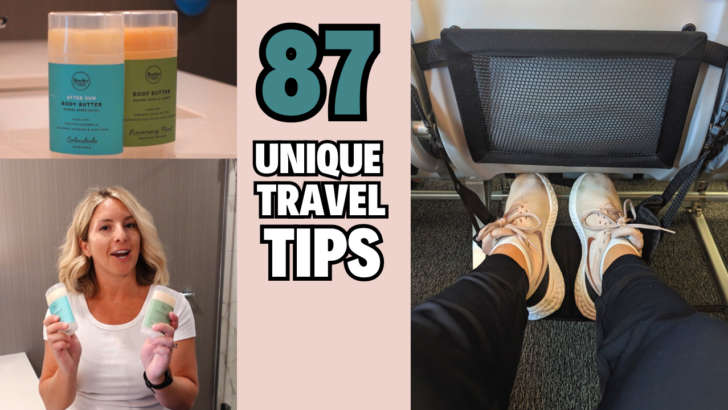
Share with your friends!
After years of travel (and now full-time travel curator), I’ve put together my ultimate collection of unique travel tips, hacks and advice to help you plan your next trip with ease.
You’ll find everything from packing advice, the best travel apps, building the best travel itinerary, in-flight comfort tips, how to get through airport security in a breeze, budgeting & saving money, in-destination advice and more.
I think these genius travel tips are pretty unique, so here’s the full list!
In this post, you’ll find:
Packing tips, travel planning and trip research, finding things to do, itinerary building, hotel booking tips, accommodation tips, booking flights, airport & security screening tips, in-flight comfort, best travel apps, budget tips, before trip departure, in destination tips, cultural tips.
This post contains affiliate links, meaning if you click through and make a purchase I may make a small commission. I only share information about things I know, love and trust!
DIY Clothing Hack for Packing Light
Mix Febreze and wrinkle release in a travel-sized spray bottle. This method allows you travel with fewer clothes and maximize a compact wardrobe.
It also prolongs the freshness and usability of your garments, which is especially helpful in humid climates.
Packing Cubes Help Keep Things Organized & Easier to Find
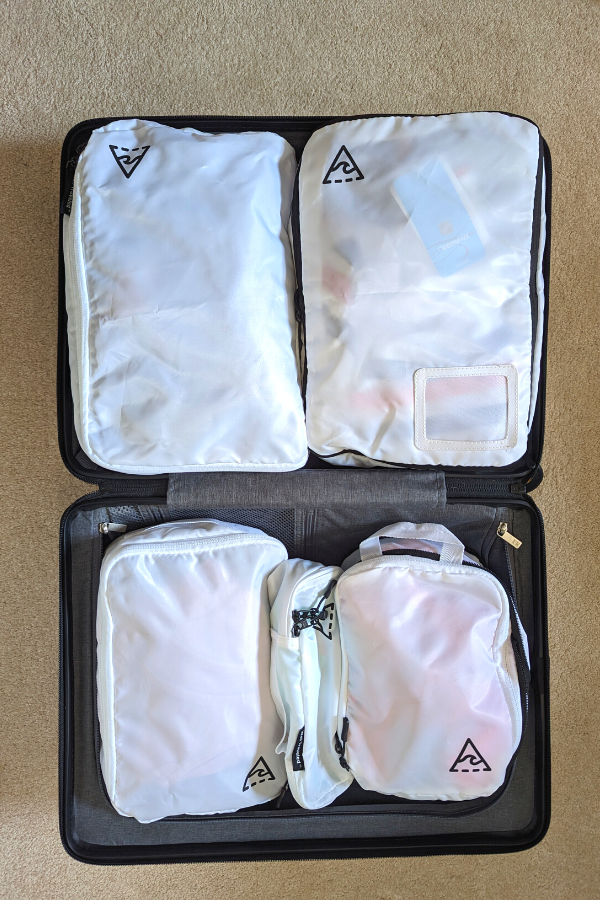
Packing cubes are especially useful if you’re moving hotels every couple of days.
Make sure you get cubes with compression , and you can almost double the amount of clothing you bring.
Also, if your bag gets searched at the airport, everything stays together and it’s so much quicker to repack.
Split Your Clothing Up
If you’re traveling with a partner, split your clothes between both of your checked bags.
That way, if one of the bags goes missing, you both have clothes in the other bag.
Pack a Full Outfit in Your Carry-on
If you don’t want to split up your clothing, pack a full outfit in your carry-on.
This is one of my favorite travel tips that has saved me more than once.
In the event your bag does get lost, you’ll still have a full set of fresh clothes.
If I’m traveling to a warm destination, I always pack a swimsuit and a beach/pool outfit in my carry-on.
Even if my bag isn’t lost, sometimes you can’t check into your room for a few hours but can still use the pool/beach area while you wait.
Instead of digging through your tightly packed suitcase, you can quickly pull out your swimsuit from your carry-on and get down to the pool faster.
Pack Slippers
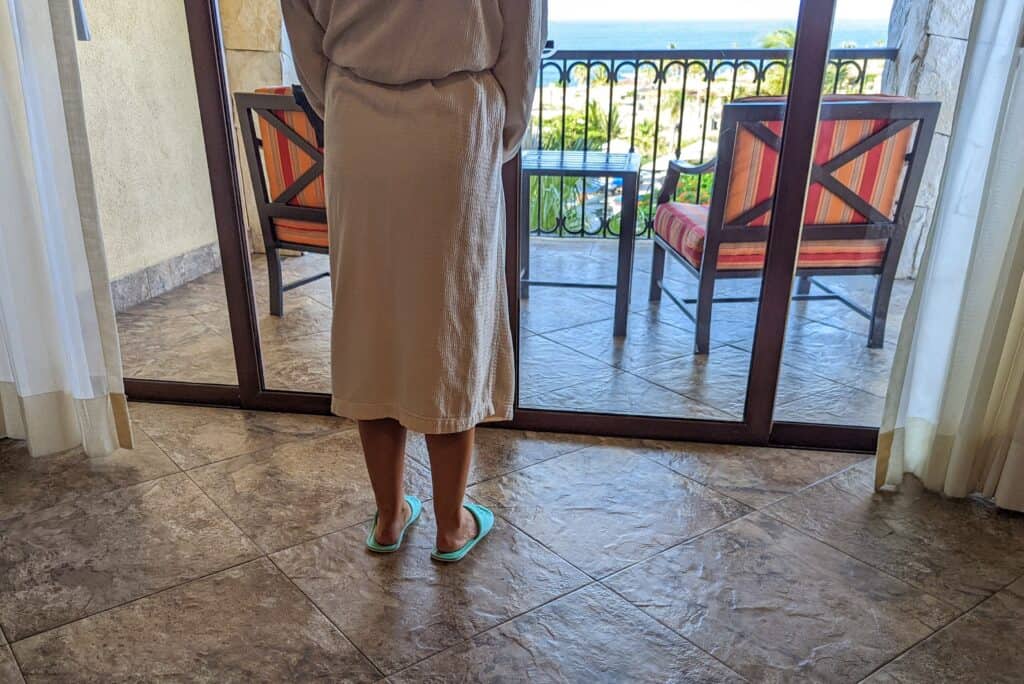
Hotel room floors are never as clean as they look, even the nice hotels.
I always pack a pair of thin memory foam slippers to wear in the room.
Especially helpful if the floors are cold or tile (like in Mexico, Caribbean, etc.).
Use the Rubberized Luggage Tags
Don’t use the belt buckle-style luggage tags which fail more often.
I like these rubber luggage tags that are one piece so you don’t have to worry about it breaking, and they come in bright colors for easy spotting.
Use a Quart-sized Ziploc bag for Packing Liquids in Your Carry-on
Don’t waste money on “TSA approved” liquid bags (they’re often too big).
All you need is the quart-sized Ziploc bags, which also seal water tight.

Pack Necklaces Inside Metal Straws
They’ll never get tangled.
Compeed Blister Patches
If you’re prone to blisters, didn’t get the chance to break in a new pair of shoes you’re brining, or you know you’re going to be walking a lot – get Compeed .
These blister patches will save your vacation and you’ll never travel without them again.
Use Lotion Sticks Instead of Liquid Lotions or Creams
This helps reduce your amount of liquids.
I even do this when checking a bag because there’s no risk of it spilling or exploding in your bag.

If You’re Going on a Long Trip, Get Yourself a Scrubba wash bag
You put your clothes, soap and water in the bag, and swish it around for a bit.
Then wring out your clothes and hang and dry.
Sinks aren’t always practical for washing clothes or if you’re camping or backpacking, these work great.
Use Toiletry Skins
For leak-proofing your bottles and containers, just stretch these toiletry skins overtop of the bottle. Works great for shampoo, sunscreen, micellar water, makeup, etc.

Refill Travel Toiletries Bag Before You Pack it Away
Your bag will be ready to go for your next trip. One less thing to do when you’re stressed about packing!
Read the rest of my packing guides here:
- 13 Things You Should Never Travel Without if You’re Staying in a hotel
- My best travel tips for packing toiletries if you’re flying carry-on only
People always ask how I plan my itineraries – here’s what I do to get started.
Use Tour Company Websites as a Starting Point
To get me started with a rough idea of what I should include in my itinerary, I always start out by browsing websites like Exoticca, Intrepid Travel, Gate 1 Travel, G Adventures, or whatever your preferred tour operator is.
I scan the itineraries for the destination I’ll be traveling to, and this gives me a really quick rundown of the top places to visit and top things to do. As well as what’s realistic for traveling between different areas.
Read the YouTube video comments
I always watch a few YouTube videos when I’m starting to plan a trip.
But make sure you read the video’s comments – they’re usually full of additional helpful tips from locals or seasoned travelers.
Join Facebook Groups

You can find a Facebook group for almost every travel destination out there. In the search bar, type in your destination and then filter by ‘Groups.’
These groups are full of people who have taken trips similar to the one you’re planning, and I always find them so helpful.
If you’re traveling to another country, use an e-sim card
I use Airalo , and all you do is purchase the sim card for what country you’re traveling to and you can purchase as much data as you want.
If you need more while you’re on your trip, you can reload more data with one click.

Use Viator to Look for & Book Tours
Not only is this the biggest source of finding all available tours in whatever region you’re traveling to, you can use the “book now and pay later” feature.
This really helps with budgeting.
I’ve booked some of my favorite travel experiences through Viator, such as natural hot springs in Mexico and a sunrise horseback ride through the desert.
The majority of tours also offer free cancellation 24 hours before.
Use Airbnb Experiences
Often you’ll find much more local & immersive experiences.
If you’ve traveled to a destination before and are looking for more unique things to do, you’ll find them here.
One of my favorite Airbnb experiences was sandboarding in Cabo San Lucas, Mexico !
Use ChatGPT
You can use ChatGPT to help you build an itinerary for free. Here’s a prompt to get you started:
- “Create a [duration] day itinerary for my trip to [destination]. My interests include [list of interests], and my budget is [budget]. I will be staying at [type of accommodation] in [preferred neighborhood or area]. Please consider the [season/weather] and any [additional information] that might be relevant to this trip.”
Use Thatch Guides

Thatch is where you can browse unique travel guides and services curated by travel experts around the world.
Many of the guides, maps and itineraries are free, or you can purchase custom itineraries.
Check out my Thatch profile for inspiration!
Maximize your time as it relates to geography
Group your must-visit stops and restaurants together by geographic area.
By planning ahead and mapping out your route ahead of time, you can fit more in your schedule.
The Thatch map feature is great for this!
Build in Flex Time
There is always something that is going to go wrong when you travel.
Whether its delayed flights, lost luggage, bad weather, someone gets sick, etc., it’s important to be flexible.
Leave some wiggle room each day in your itinerary in case something happens.
The best way to experience a place is through its food!
Look up 1-3 local dishes before you go so you feel prepared to order something new & delicious.
Choosing a hotel to book is often the most stressful part of travel planning.
Here’s some advice to help you choose the best place to stay.
Zoom in on Google Maps
Often you’ll want to stay somewhere that’s close to all the places you’ll be visiting and the attractions you want to hit.
Once I have an area narrowed down, I usually do a quick browse on Booking or Expedia to give me an idea of prices.
Then, I open up Google maps and zoom in on the neighborhood I want to stay in. This way I can see all the reviews to help me narrow things down.
Price Things Out With Uber

If I won’t be renting a car, I usually open up Uber and plug in a few of the places I’ll be traveling to, which gives me an idea of how much the rides will cost.
This helps me choose whether to spend more money and stay closer to the action, or save a ton by staying somewhere a little further out and taking Ubers.

Here are my best tips & things to do when you check into your hotel.
Check Your Hot Water
I like to make sure I have hot water and that the shower works properly as soon as I get to my room.
This way if I happen to take a late night or early morning shower and something doesn’t work, I’m not going down to the front desk at odd hours (especially if I’m on a schedule).
Luggage Storage
If you have a late flight and need to check out of your hotel by a certain time, hotels will hold your bags for you.
This also works the opposite way – if you arrive early but can’t check in. Saves you from hauling your luggage around all day.
Sink Stopper
Pack a universal sink stopper so you can wash your clothes in the sink or fill it full of ice to keep your drinks cold.
I do this in places like Las Vegas that never have mini-fridges in hotel rooms.
Read more of my essential items to pack for a hotel stay to help me feel comfortable and get a good night’s sleep.
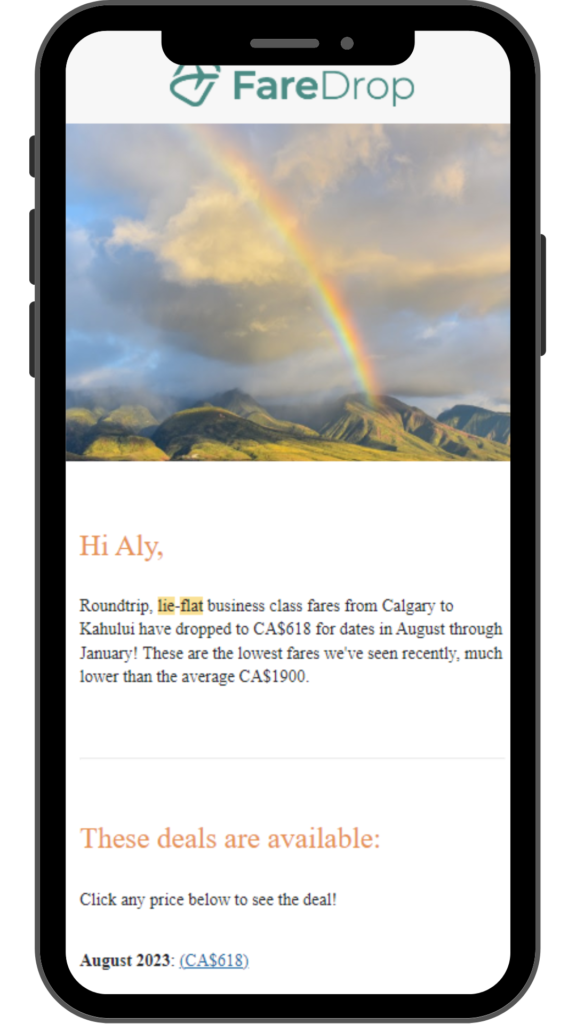
You can save hundreds of dollars on flights just by setting cheap flight alerts with Faredrop .
It sends me notifications when flights drop in price from my home airport so it creates a lot more opportunity for budget travel!
My favorite part is the flight deals on business class flights, like this recent deal for lie-flat business class fares from Calgary to Hawaii for $618, $1200 lower than the average price of $1900.
Google Flights

If you have some flexibility with travel dates, the Google Flights ‘Explore’ feature shows you the cheapest airfare around the world.
If you’re eyeing up a destination, you can also set free price alerts to be notified when the price changes.
It’s also a great tool to show you the cheapest dates to travel as well as whether or not prices are currently, high, normal or low based on the flights you’re looking to book.
Flight Connections
This website shows all non-stop flights from every airport to help you plan a long-haul trip.
Flight Aware
FlightAware provides accurate, real-time flight tracking information.
It will typically show if your flight is canceled/delayed BEFORE your airline sends you a notification.
You can also track where your plane departs from to anticipate delays ahead of time.
Roame.Travel

Roame simplifies credit card rewards – helps you find the best redemptions for your credit card points and airline miles.
Just input your origin and destination airports and your date of travel, and the search engine will show you how many points it will cost to fly via different loyalty programs.
In the example above, it shows that you can fly first class from Las Vegas to New York City for $5.60 and 41,500 points.
Finding Cheap Business Class Flights Without Credit Card Points
While it’s very possible to fly business class solely on credit card points, not everyone wants to accumulate credit card debt or has the necessary credit score to apply for a premium credit card.
And depending on your home country, you might have limited options.
As a Canadian, I don’t get access to nearly as many travel rewards programs and credit cards as my American friends.
So, I wrote a guide on how to score cheap business class airfares like a pro, without having to churn credit card points by comparing the best flight deal tools, apps, websites and services.
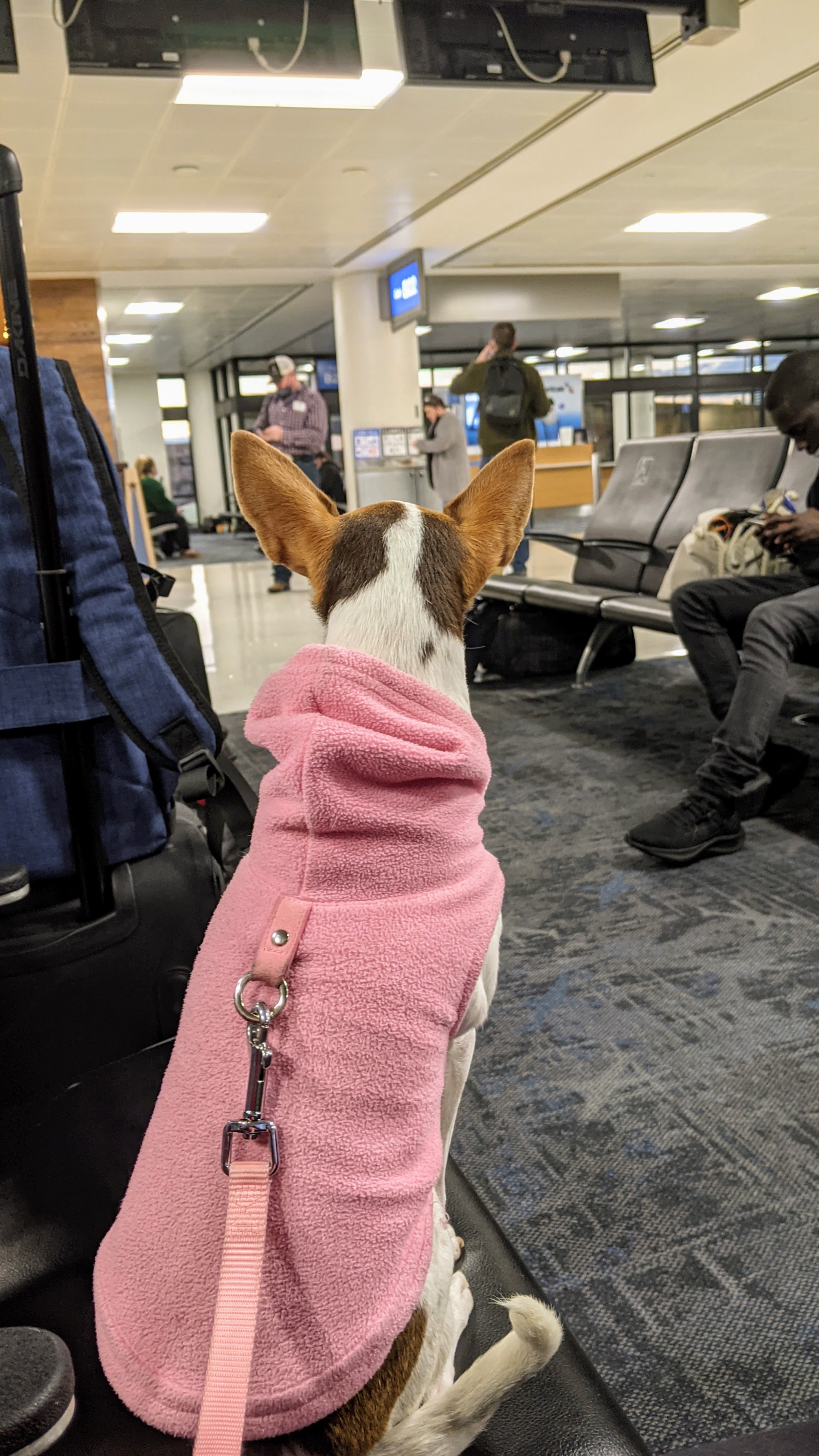
If you’re parking at the airport…
Take a photo of which section you parked your car in to easily remember where your car is after your vacation. After a long flight, you’ll be tired and just want to get home.
Security Screening Tetris Tip #1
Put your possessions through the scanner in the order you need them to come out so they can easily be re-packed.
For example, send your backpack through first, so that as your items come out you can just place them right into your bag.
Security Screening Tetris Tip #1.5
If you have a laptop or a valuable electronic, place it in the middle or second bin.
For example, I sandwich my valuables in between my personal item (first tray), and my carry-on luggage (third tray).
This keeps your valuable stuff safe from getting mixed up with other items, but it also makes it simpler when you need to pack everything back u
Luggage Cupholders are a lifesaver
If you aren’t an octopus and only have two arms, get yourself one of these luggage cupholders .
You just slip it over the handle of your suitcase and you can travel through the airport with ease when you’ve got a cup of coffee, water bottle, snacks, baby supplies, your phone, and anything else you need quick access to – now you’re hands free and not fumbling around.
Beware of Juice Hacking
DO NOT use one of the USB charging outlets at the airport.
Use a power bank to charge your phone instead.
Hackers are now using the public charging-USB ports at airports to infect your phone with malware and then steal your personal information.
The solution?
Use a power bank instead (handy to have when traveling anyway) or a charging-only data blocker cord .
Foot Hammock

Nothing worse than a long flight where you can’t elevate your feet.
I always pack my trusty foot hammock which attaches to the seat in front of you for an instant foot rest.
Just make sure you’re mindful of the person in the seat in front of you and avoid swinging your feet or moving them around too much.
Or Bring a Deflated Beach Ball
It packs flat and once you’re in the air, blow it up and now you have a foot rest.
Choose a larger size and only partially inflate it so that it’s a bit flat for more stability.
OR Use a small, folding step stool
As another way to prop your feet up on long plane rides – it feels like you’re in first class (and no risk of bothering the person in front of you).
Try this stool which folds up flat & is lightweight. Easily fits in your carry-on or backpack.
For long-haul flights, bring a spare pair of dry socks to wear once you’re settled in on your flight. Makes a world of a difference for feeling fresh.
Brushing your teeth…
is the quickest way to feel human again after a long flight.
Bring your own tea bags for the plane
Cabin air is dry and dehydrating, so bringing your own herbal tea helps so much.
You can usually get a cup of hot water for free (although I won’t be surprised if and when they start charging for that), but then you can have a nice soothing cup of mint or eucalyptus tea.
Emergency Row Exit Tip #1

Are you someone who likes to board the plane first ?
Purchase an emergency exit row seat – not only do you get more leg room, but guests in these seats get priority boarding so you can be first on the plane.
Emergency Row Exit Tip #2
If you’re on a plane with two rows of exit seats, the first row of emergency exit row seats don’t recline because they could obstruct the row behind them.
So if you plan on reclining your seat a bit, go for the second row.
Middle Seat Hack
Try the middle seat hack. If you’re traveling with a partner, try booking an aisle seat and a window seat.
There’s a big chance no one will book the middle seat and you’ll get the whole row to yourselves.
Overhead Bin Tip
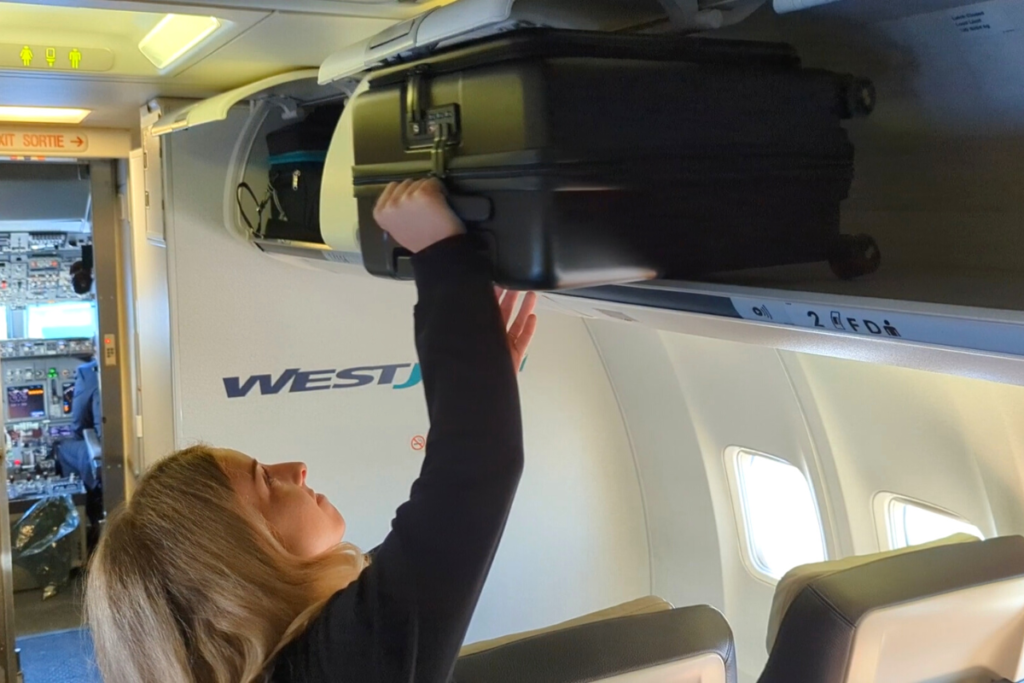
Put your carry on in the bin or rack across from your seat.
It’s much easier to grab at the end of the trip or to keep an eye on if you are nervous.
Here’s a list of my favorite travel apps that are a complete game changer.
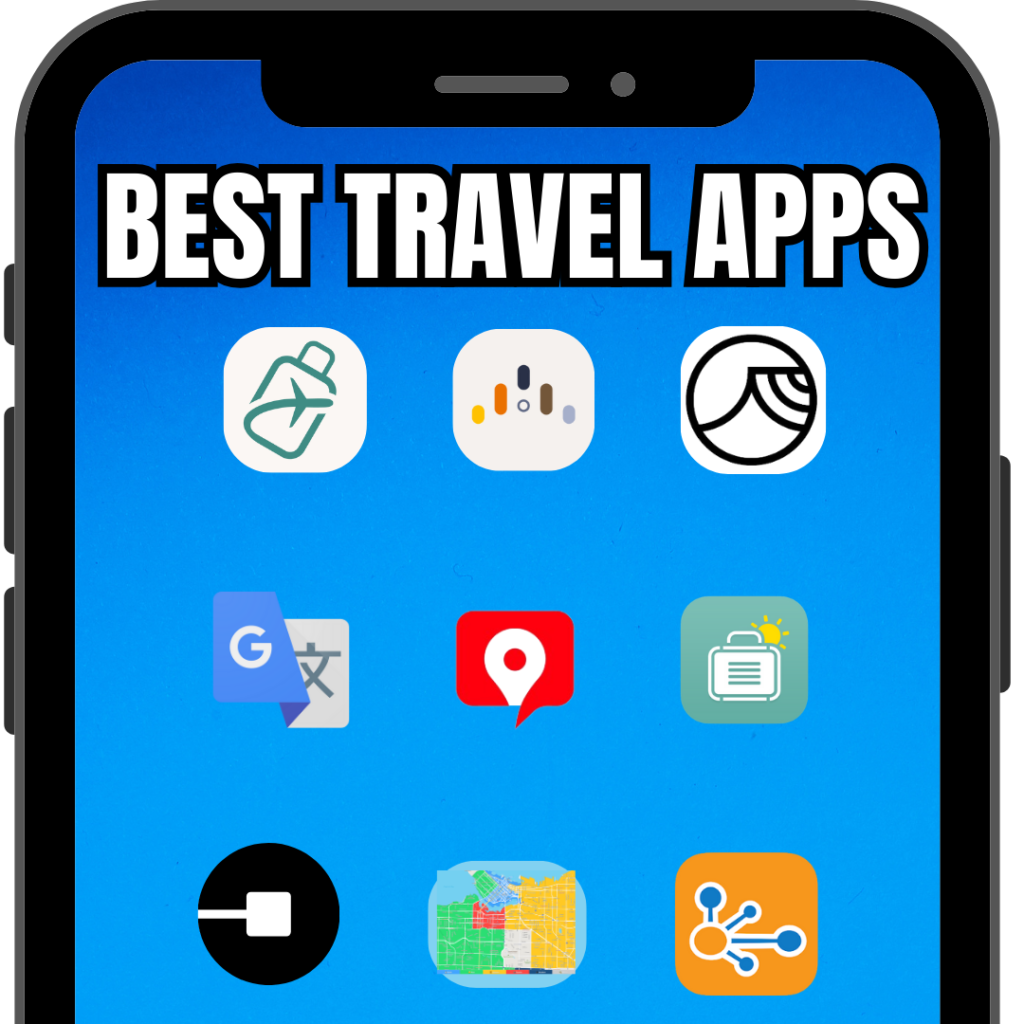
Google Maps Offline
Make sure to download your map area to use offline, then you’ll never need WiFi or cell service to access where you are.
Make sure you’ve saved things like your hotel or Airbnb, restaurants and attractions so you can get directions any time.
Another great use for Google Maps is when you’re on a bus in a foreign country where you’re not familiar with the language or if it’s loud and you can’t always understand the next stop announcement.
You can use maps to put in your destination and follow the route on your phone, so you know when to get off.
I also follow along when I’m in a taxi , so you can make sure you’re going in the right direction.
Google Translate
Download the language of the country you’re visiting for offline use on Google translate. Just in case you need it and don’t have a connection.
My favorite features are the conversation mode for real-time interpretation and translating text – just point your camera at a sign or a menu and your translated text is displayed overtop.
An audio tour guide app with perfectly timed stories, tips & directions that matches your location.
A must-have if you’re on a scenic road trip, or traveling through national parks.
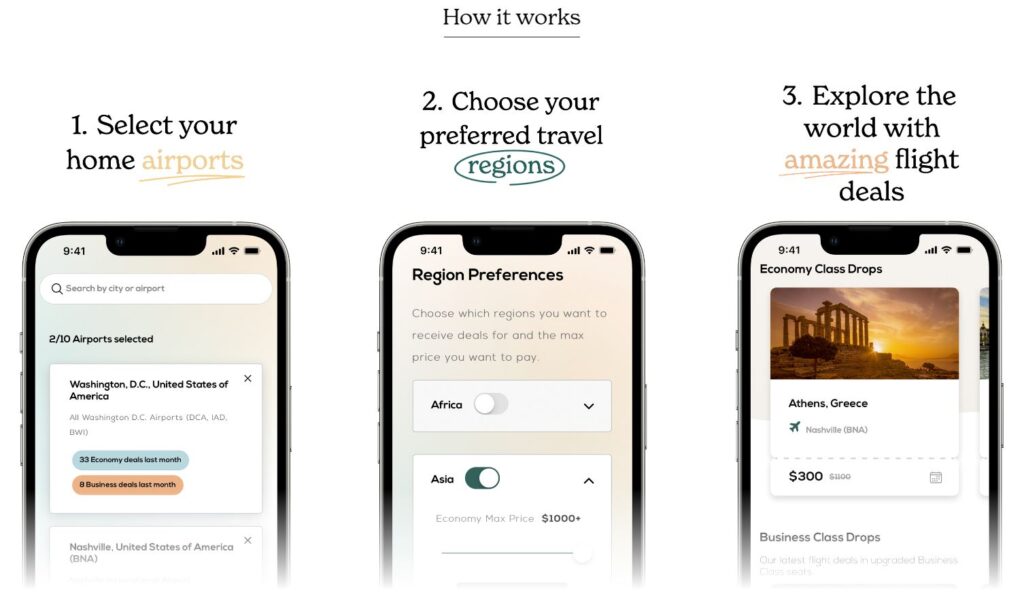
Faredrop is one of the best flight deals apps on the market. Get notified when flights drop in price from your home airport.
Thatch
Browse unique travel guides, itineraries and maps curated by travel experts around the world.
TripIt keeps all your reservations and bookings in one spot.
Keep track of your flights, hotels, car rentals, confirmation numbers, and other details – all in one place – so you don’t have to search through multiple emails or apps to find what you need.
PackPoint you organize what you need to pack in your luggage and suitcase based on length of travel, weather at your destination, and any activities planned during your trip.
Timeshifter
The jet lag app that creates a personalized plan to minimize jet lag using the latest sleep and circadian neuroscience.
These are user generated maps to help you navigate cities like a local – indicating things you should know about certain neighborhoods.
I find it’s useful when I’m traveling somewhere that I have very little knowledge about, and want to know about safety, where the super touristy spots are, or low key spots where locals hang out.
Even if you don’t plan to use Uber, it will give you an idea about how much a typical fare costs for your route.
For example, when I’m traveling in a country where I feel more comfortable using a taxi, I check a few Uber prices before negotiating with the taxi driver about how much the fare will be.

Numbeo is the world’s largest cost of living database.
Use it to help determine how much things cost in any city such as housing, restaurants, transportation, etc.
Use Cashback Programs
Cashback programs work like a digital rebate where once you make a purchase, you get a percentage of your money back.
Popular cashback sites for travel bookings include WayAway, Rakuten and CapitalOne Shopping.
Read more details about How to Get Cashback on Flights (+ other travel saving tips)
Sign Up for Flight Alerts

Want to find flight deals with minimum effort?. Instead of searching the internet for flight deals, have someone else find deals for you.
One of the most popular flight alert programs is FareDrop , which regularly sends out deals like this one:
- $516 round trip flights from San Francisco to Tahiti, French Polynesia.
Utilize Positioning Flights
A positioning flight is a separate, cheaper flight taken to reach your main destination, typically from a nearby airport.
Taking one of these flights allows you to access more affordable airfares from larger airports (and maybe snag those flight deals on business class fares from FareDrop ).
Rick Steves’ Books
Are a wealth of information, especially for European travel.
He’s got tons of advice on saving money when it comes to booking hotels, free self-guided tours & avoiding overpriced tourist traps.
View his travel guide book collection here
Stay in One Place Longer
Traveling in between locations eats up your budget (the more you move the more you spend).
Often it’s much cheaper to stay in a central point and focus more on day trips.
Swiss Half Fare Card
If you’re planning a trip to Switzerland, you can use the half fare card for all public transportation (trains, trams, buses, etc.) in Switzerland and can also be used for some attractions.
The card does exactly what the name implies, so if you’re doing a lot of train travel you can save a decent amount of money.
Saving on Car Rentals
If you’re renting a car – check to see if there’s a rental agency that’s a short cab or Uber ride from the airport. These places are usually significantly cheaper and have shorter wait times.
Open a Wise Account
If you haven’t yet, open up a Wise account .
The Wise card is a prepaid debit card attached to your Wise multi-currency account – you can load up multiple currencies and pay local like a local when you’re abroad.
Save money on international travel by changing your money into a different currency without paying a lot of extra fees and getting better exchange rates.
Learn more about Wise here .
Embrace Shoulder Season
To save money and travel at an affordable price, find out the off season of your planned destination and travel then. You also get the added bonus of fewer crowds.
Become a House Sitter
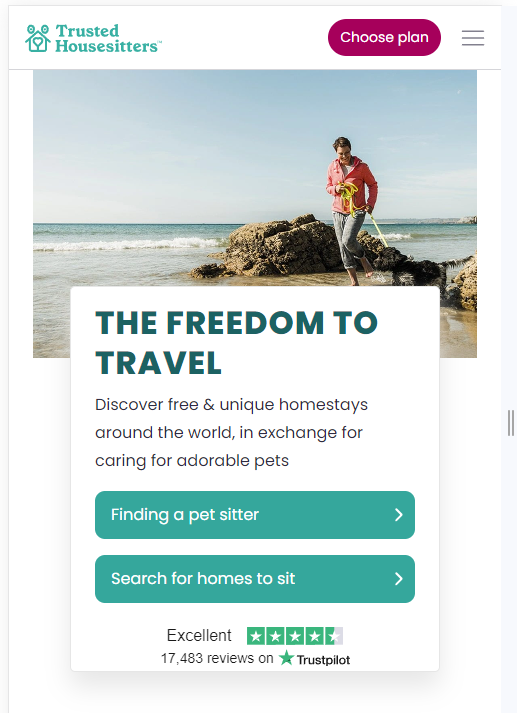
Save money on accommodation by house-sitting and pet-sitting for locals while they’re away on vacation.
Trusted Housesitters is one of the best platforms to start house sitting.
Stay Somewhere With Kitchen Amenities
Even if you book a hotel room or an Airbnb with a small kitchen that’s a little more expensive, you can save a ton of money by cooking your own meals.
Often when we travel, we make our own breakfast and lunch, and only go out for dinner.
Go Where the Locals Eat
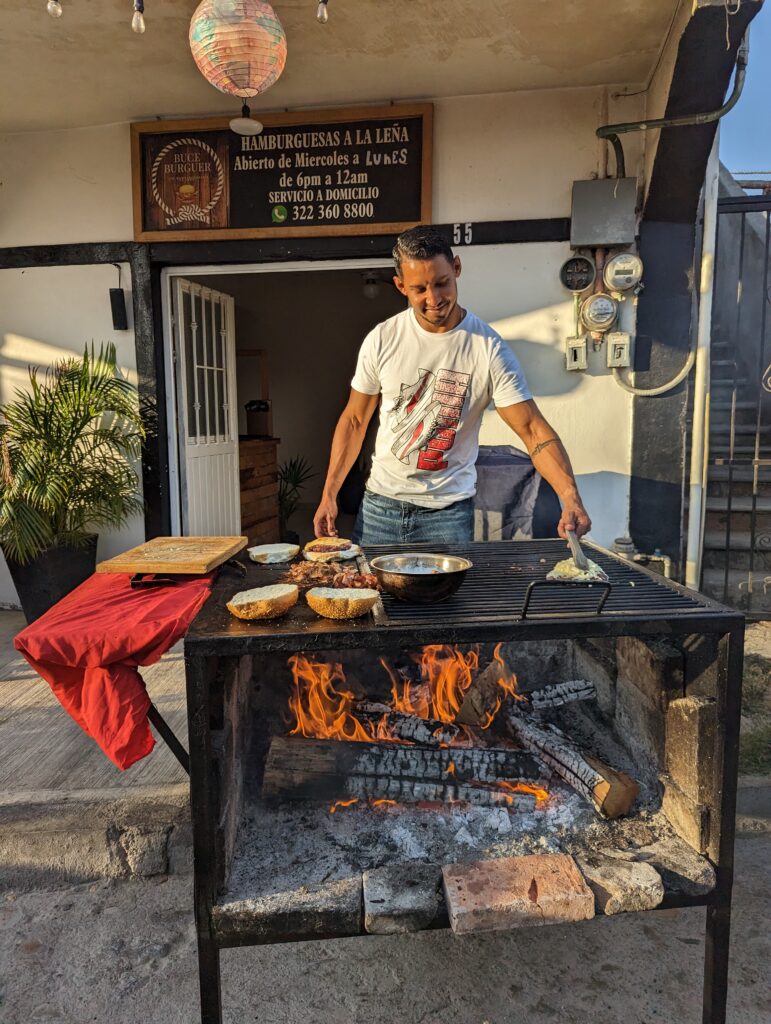
If you’re visiting a popular tourist city, do a little research beforehand to find out where the locals eat.
These restaurants will be a little outside of the main tourist spots, but 9 times out of 10, the food quality is much better and prices are a lot lower.
Multi-attraction passes can save you tons
If you know you’re going to be hitting several main tourist attractions in the city you’re visiting, it can be worthwhile to purchase discounted access passes to multiple attractions.
GoCity is one of the best and is currently available in over 30 cities around the world. You often save up to 50% vs buying individual attraction tickets.
Do you get anxious or a little nervous leaving for a trip? Here are a few tips that help me feel better about being away from home:
Get a Wyze Camera
Get an inexpensive camera that you can install either inside or on the exterior of your home.
You can check up on your place from wherever you are in the world for peace of mind.
Do a weird dance…
when you lock the door so you’ll never forget that you locked it!
For real, do a shake, throw your hands up, whatever you have to do.
(works for other things too, like turning off the stove, etc.)
Confirm With Your Hotel

Email the hotel in advance of travel just indicating you’re double-checking your reservations.
If there are any issues when you arrive, you now have someone you’ve corresponded with at the hotel.
Once you’ve arrived at your destination and you’re officially starting your trip, here are my top pieces of advice to help you enjoy and navigate things smoothly.
Foreign Currency
The best way to get foreign currency (cash) is by withdrawing from an ATM on arrival (just avoid the ones at the airport). There will still be a fee, but it’s usually much better than the banks back home or currency exchange offices.
You can also use your Wise debit card for this, or if you’re from the United States, you can sign up for a Charles Schwab account, which gives you a rebate on foreign ATM fees at the end of each month.
Walking Tours & Food Walking Tours are Your Friend

As one of my favorite travel tips, I always recommend joining a free walking tour or food walking tour.
Make sure to do it early on in your trip.
These are the best ways to get acquainted with the city.
Having a local guide take you to some local food joints is a great way to not only become familiar with the local cuisine, but can help you step out of your comfort zone.
Food vs. Views
When choosing a restaurant, remember that if the view is great, the food doesn’t have to be.
Finding a Bathroom
If you need a bathroom, find a hotel, and walk in confidently like you’re a guest.
Bathrooms are usually located on the main floor somewhere near the elevators, at the beginning of a hallway or beside meeting rooms.
Early Arrivals
If you have an early flight where you’re arriving in a city in the morning, take one of the hop on hop off city tours.
They start early and are a great way to spend a couple hours getting a lay of the land and familiar with the main parts of the city.
Always try the local food!

It’s often the best and the cheapest. Not sure where to go?
Look for places that have lineups – that also means food will be fresh.
Take Photos of Landmarks
When traveling in unfamiliar places or a busy city that you’ve never been to, use your phone to take pictures of landmarks that stand out.
That way if you want to get back to a certain place you have a picture on your phone to match with your map pin.
This is helpful when you’re getting an Uber or a taxi to drop you off in a certain pickup area – or if you parked your car somewhere.
Works great if you’re traveling around a downtown area and you want to meet back at a certain spot.
Ask for a Sunroof
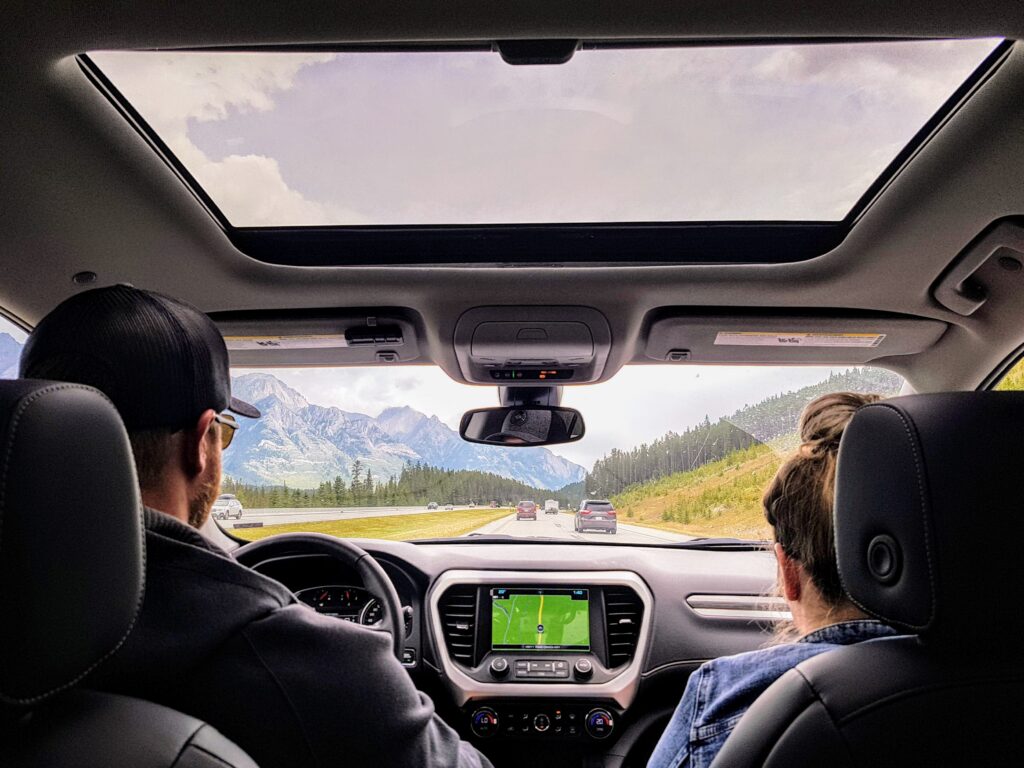
If you’re renting a car and taking a scenic road trip, try to get a car with a sunroof – you’ll be able to see so much more of the scenery.
Learn Basic Phrases in the Local Language
Before your trip, try to learn a few key words and phrases in the local language and practice them at home.
Look up basic greetings, please and thank you, and how to ask where the bathroom is located.
Learn the local tipping customs to show appreciation without inadvertently causing offense.
More Helpful Travel Tips:
My biggest list of Mexico travel tips (that saved me so many times)
How to book a perfect Airbnb/vacation rental every time
How to plan a trip from start to finish (the easy & organized method)
How to Find Cheap Business Class Flights Without Credit Card Points

159 Best Traveling Tips Ranked for Every Adventurer!
Ah, the allure of travel! Whether you’re dreaming of a serene escape to a secluded beach or an adrenaline-packed adventure in a bustling city, traveling can be one of life’s most rewarding experiences.
From the nitty-gritty details of pre-trip planning to savoring and documenting your experiences, and even diving deep into post-trip reflections, this traveling tips guide promises to be your trusty companion.
Let’s break free from monotony and dive into the world of exploration and wonder!

Pre-Trip Planning & Preparation
The adage “By failing to prepare, you are preparing to fail” rings especially true when it comes to travel. A well-planned journey can make the difference between a trip of a lifetime and a travel disaster.
Let’s ensure you set off on the right foot with our top traveling tips on pre-trip planning and preparation.
1. Researching Your Destination:
- Dive deep into the culture, customs, and attractions of the place you’re visiting. Understanding the dos and don’ts can save you from potential faux pas and enhance your travel experience.
2. Budgeting:
- Let’s be real: Money matters. Some of the best budget traveling tips including to draft a rough estimate of daily expenses, considering accommodation, food, transport, and activities. Don’t forget to set aside a contingency fund for unexpected expenses.
3. Trip Insurance:
- Hope for the best but prepare for the unexpected. Travel insurance can cover anything from lost baggage to medical emergencies. Compare policies to find the right fit for your trip.
4. Passport and Visa Considerations:
- Check the expiration date on your passport; many countries require it to be valid for six months beyond your return date. Research visa requirements for your destination and apply well in advance.
5. Vaccinations and Health Prep:
- Some destinations might require specific vaccinations. Check with local travel clinics or the World Health Organization’s website to stay informed.

6. Language Basics:
- Even if you’re traveling to a place where your native tongue is commonly spoken, it’s courteous (and often fun!) to learn a few basic phrases in the local language. Simple words like “hello,” “thank you,” and “please” can go a long way in breaking the ice and showing respect for the local culture.
7. Gear Up with Essential Tools:
- Depending on your destination, there might be some must-have items . For example, heading to a tropical location? Don’t forget insect repellent. Trekking in the mountains? Ensure you have suitable hiking gear. Make a list of destination-specific items early on, so you don’t end up making last-minute, overpriced purchases.
8. Local Festivals and Events:
- Check the local calendar for any festivals , holidays, or events that might be taking place during your visit. This can provide unique experiences you won’t find in typical travel guides. However, be mindful; certain festivals might mean crowded places or unavailable services.
9. Emergency Contacts and Addresses:
- Always have a list of emergency contacts for your destination. This includes the local embassy or consulate (if traveling internationally), nearest hospital, and local police station. Additionally, keep a written note of your accommodation’s address and phone number, especially if you’re in a place where your phone might not always have service.
10. Dietary Restrictions and Preferences:
- If you have dietary restrictions, research how they’re catered to in your destination. Learn to communicate them in the local language. Apps and cards are available that can help you convey these restrictions to waitstaff in various languages. Also, it’s worth checking out the local cuisine beforehand – you might discover a new favorite dish or snack!

11. Check Travel Alerts and Warnings:
- Staying informed is key to a safe trip. Before heading out, make sure to check for any travel advisories or warnings related to your destination. Websites of foreign affairs departments or state departments often have up-to-date information on safety concerns, political unrest, or natural disasters.
12. Loyalty Programs and Points:
- If you’re a frequent traveler, don’t let those miles and points go to waste! Review your loyalty program balances and see if you can redeem them for flights, accommodation, or other travel perks. Not part of a program yet? Now might be a good time to sign up. They can offer significant savings and benefits in the long run.
13. Weather Forecast and Seasonal Considerations:
- Mother Nature can be unpredictable, but getting a general idea of what to expect weather-wise will help you pack more effectively. Look at the average temperatures and conditions for the time of year you’re traveling. Don’t forget to also check for any unusual weather patterns or events like monsoons or dry seasons.
14. Cultural Norms and Local Customs:
- Beyond just language, it’s vital to understand the cultural norms of your destination. This can range from tipping etiquette, to how to greet locals, to dressing appropriately. Being aware of these nuances shows respect to the communities you’re visiting and can lead to more meaningful interactions.
15. Backup Documentation:
- Always have backups of your essential documents. This includes copies of your passport, visa, travel insurance, and any bookings or reservations. Store them separately from the originals, and consider having digital copies saved in a secure cloud storage or on a USB stick.

16. Research Local Scams:
- Every destination has its scammers preying on unsuspecting tourists. Do a quick search to familiarize yourself with common scams in your travel destination. Whether it’s a taxi overcharging or someone posing as an official, being forewarned is forearmed.
17. Download Offline Maps:
- Connectivity isn’t always guaranteed, especially if you’re venturing off the beaten path. Make sure you download offline maps of the areas you’ll be exploring. Apps like Google Maps and Maps.me allow you to navigate without an internet connection.
18. Book the First Night’s Accommodation:
- Spontaneity is a thrill, but there’s also something comforting about knowing you have a place to rest after a long journey. Even if you’re winging most of your trip, consider booking at least your first night’s stay in advance.
19. Check Electrical Outlet and Voltage Differences:
- Different countries can have varied electrical outlet designs and voltage levels. Check what’s used at your destination and, if necessary, invest in a universal adapter and voltage converter to keep your gadgets charged and safe.
20. Create a Rough Day-to-Day Itinerary:
- While over-planning can stifle spontaneity, having a rough idea of the must-visit spots can be helpful. List down top attractions, any pre-booked activities, and tentative transport schedules. But remember, it’s okay if you don’t stick to it – let the rhythm of the place guide you at times!

21. Organize Travel Essentials:
- Gather all travel necessities like passports, tickets, insurance, credit/debit cards, and essential contacts into a dedicated travel wallet or pouch. This ensures you have everything at your fingertips during transit and reduces the chances of misplacing vital documents.
22. Consider Packing Cubes:
- Packing cubes can be a game-changer. They help segment your belongings, making it easier to locate items and repack. Whether you’re segregating by outfit or type of clothing, these nifty organizers can make living out of a suitcase almost feel like home.
23. Dress in Layers for Flights:
- Airplane temperatures can be unpredictable. Dress in layers so you can easily adjust to your comfort level. Plus, this strategy lets you carry some bulkier clothing items on you, freeing up luggage space.
24. Always Pack a Basic First-Aid Kit:
- Accidents can happen. A small first-aid kit with basics like band-aids, antiseptic wipes, pain relievers, and any personal medications can be a lifesaver. Also, if you have specific medical needs, carry a note from your doctor to avoid any potential issues at security or customs checks.
25. Limit Your Liquids, Aerosols, and Gels (LAGs):
- If you’re only traveling with carry-on luggage, remember the restrictions on LAGs. Typically, each item must be in a container of 100 milliliters (3.4 ounces) or less, and all items should fit in a single quart-size plastic bag. Always check current regulations with your airline before flying.

26. Pack a Multi-Tool (But Not in Your Carry-on!):
- A travel-friendly multi-tool can be incredibly handy, offering everything from a bottle opener to a pair of scissors. Just remember, if you’re only traveling with carry-on luggage, multi-tools might be confiscated at security checks. Always pack them in your checked luggage.
27. Curate a Portable Entertainment Kit:
- Long layovers, flight delays, or quiet evenings at the hotel – there will be moments of downtime. Having a compact entertainment kit with items like a book, e-reader, earphones, or a deck of cards can be a lifesaver.
28. Opt for Versatile Clothing:
- Think about pieces that can be mixed and matched to create different outfits. Neutral colors are your friends. Also, items like sarongs or scarves can serve multiple purposes, from a beach towel to an impromptu bag or a head cover in religious sites.
29. Snacks! Always Pack Snacks:
- While exploring, you might not always find food when hunger strikes. Carry a few travel-friendly snacks like nuts, protein bars, or dried fruit. It’s a simple way to keep your energy levels up and avoid becoming “hangry.”
30. Leave a Little Room:
- Chances are, you’ll return with more than you left with. Whether it’s souvenirs, gifts, or that irresistible item you found at a local market, it’s always a good idea to leave a little spare room in your luggage for the journey back.

Packing & Luggage
Travel is as much about the journey as the destination. And a significant part of that journey involves packing . You might love it (yes, there are people who find joy in folding clothes!), or you might dread it.
But mastering the art of packing can transform your travel experiences. Let’s uncover the secrets to packing efficiently and effectively.
31. Invest in Durable Luggage:
- A reliable piece of luggage is worth its weight in gold. Whether you prefer a backpack or a suitcase, opt for something sturdy, water-resistant, and with good zippers and locks. Wheels are a bonus if you’re navigating through airports frequently.
32. Understand Airline Baggage Policies:
- Each airline has its rules for both checked and carry-on baggage. Research the size and weight restrictions of your airline to avoid last-minute repacking or unexpected fees. It’s especially crucial for budget airlines, which might have stricter limits.
33. Personalize Your Bag:
- In a sea of black suitcases at baggage claim, how will you spot yours? Personalizing your bag with a colorful tag, ribbon, or even a unique paint splatter will help it stand out and prevent mix-ups.
34. Go Digital with Entertainment:
- With the array of digital entertainment platforms available, consider downloading movies, books, or podcasts on your device to save space on physical items. But always carry a pair of earphones; not all airlines provide them for free.
35. Roll, Don’t Fold:
- It’s the age-old debate among travelers. While both methods have their advocates, rolling clothes can save space and reduce wrinkles. For bulkier items or those prone to creasing, consider a hybrid method where you fold and then roll.

36. Vacuum-Sealed Bags for the Win:
- Especially useful for bulkier items like jackets or if you’re traveling to a colder destination. Vacuum-sealed bags compress your clothes, giving you more space. Just remember – they reduce volume, not weight. Your luggage can still be heavy!
37. Prioritize Mini Toiletries:
- Those cute little shampoo and conditioner bottles aren’t just adorable; they’re practical. Stock up on travel-sized toiletries or invest in reusable mini bottles you can refill from your regular-sized products.
38. Limit Shoes:
- Shoes tend to be the heaviest items in your bag. Limit yourself to two or three pairs: typically a comfortable walking pair, something suitable for evenings or special occasions, and activity-specific footwear if needed.
39. Pack Innerwear at the Top:
- To avoid rummaging through your entire bag at inconvenient times, keep your innerwear and essentials easily accessible at the top or in a designated compartment.
40. Laundry on the Go:
- If you’re traveling for an extended period, consider doing laundry along the way. Pack a small detergent sachet and a portable laundry line, and you can wash essentials in your room, allowing you to pack fewer clothes.

41. Use Shower Caps for Shoes:
- Protect your clothes from dirty shoe soles by slipping your shoes into disposable shower caps. It’s a lightweight, space-saving way to keep things clean.
42. Stuff Your Shoes:
- Your shoes can double as storage spaces! Socks, underwear, or other small items can be stuffed into your shoes to utilize all available space and help your shoes maintain their shape.
43. Embrace the Digital Nomad Tools:
- Instead of packing multiple gadgets, invest in multi-functional tools like a smartphone with a good camera or an e-reader with note-taking capabilities. There are also numerous travel apps that can replace physical maps, language phrasebooks, and travel guides.
44. Be Mindful of Fragile Items:
- If you’re packing items that can break, ensure they’re protected. Consider wrapping them in clothing or placing them in the center of your luggage surrounded by softer items.
45. Layer Up:
- Instead of packing a variety of heavy clothing, opt for layers. Not only does it save space, but layered outfits can be easily adjusted to cater to varying temperatures and weather conditions.

46. Choose Fabrics Wisely:
- Some fabrics are more travel-friendly than others. Materials like merino wool are breathable, odor-resistant, and quick-drying. Conversely, avoid fabrics that wrinkle easily or can’t handle the rigors of travel.
47. Wear Your Bulkiest Items:
- If you’re traveling to a cold destination and need to pack heavy boots or a bulky jacket, consider wearing them during your journey. It might be a bit more cumbersome, but it can save a significant amount of luggage space.
48. Portable Luggage Scale:
- Overweight luggage fees can be a nasty surprise at the airport. A portable luggage scale lets you check the weight of your bags before you leave, ensuring you stay within airline limits.
49. Prioritize Essentials in Carry-on:
- In the rare event that your checked luggage gets lost or delayed, having essentials in your carry-on (like a change of clothes, medications, and vital documents) ensures you’re prepared.
50. A Separate Tech Pouch:
- With the plethora of electronic devices and their corresponding chargers and accessories, having a dedicated tech pouch can be a lifesaver. It streamlines the process of accessing and organizing your devices, chargers, memory cards, and more.
Achieving the perfect balance in packing—where everything you need fits seamlessly into your luggage, each item easily accessible—might seem like an art. But with these traveling tips and a bit of practice, you’ll find it becomes second nature.

Transportation
Transportation is the backbone of any travel itinerary. Whether you’re catching a long-haul flight, hopping onto a local bus, or renting a car to explore the countryside, understanding the nuances of each mode can profoundly impact your travel experience.
51. Research Airport Transfers in Advance:
- Before you land in a new city, know your options for getting from the airport to your accommodation. Whether it’s a shuttle, taxi, or public transit, having a plan can save you time and stress.
52. Embrace Overnight Transports:
- Taking a night train or bus can save you the cost of one night’s accommodation while maximizing your sightseeing time during the day. Just ensure you’re comfortable enough to catch some sleep on the go.
53. Understand Local Public Transit:
- Dive into the local way of life by using public transportation. Buses, trams, and subways can be cost-effective and provide a unique view of everyday life in a new city.
54. Always Carry Local Currency:
- While many transportation hubs accept credit cards, having some local currency can be crucial for smaller transit options like buses, rickshaws, or local taxis.
55. Renting a Vehicle? Check International Driving Requirements:
- If you plan to rent a car or motorbike, research the international driving permit requirements of your destination. Some countries might not accept your domestic license without an accompanying international permit.

56. Take Advantage of Ride-Sharing Apps:
- In many cities globally, ride-sharing apps like Uber or Lyft can be cheaper and more convenient than traditional taxis. Remember to have a local SIM card or Wi-Fi connectivity to use them efficiently.
57. Bike Rentals for Short Distances:
- Many cities now offer bike rental programs, which can be an eco-friendly, healthy, and often more enjoyable way to explore. Plus, it gives you the flexibility to stop and explore on a whim.
58. Check-in Online for Flights:
- Most airlines offer online check-in 24-48 hours before departure. It can save you time at the airport, and you can often choose your seats in advance.
59. Be Mindful of Peak Travel Times:
- Try to avoid traveling during peak times, like rush hours in major cities. Not only will it be more crowded, but it can also be more expensive and time-consuming.
60. Always Have a Backup Plan:
- Especially true for longer journeys with multiple connections. Know your alternatives in case you miss a connection or face unexpected delays. Being prepared can reduce stress during unforeseen travel hiccups.

61. Flexibility Equals Savings:
- If your schedule allows, be flexible with your travel dates. Flying or traveling by train mid-week, or outside of holidays and peak seasons, can often lead to significant savings.
62. Research Local Travel Passes:
- Many cities offer tourist passes for public transport, which can be cost-effective if you’re planning to hop on and off buses or trains frequently.
63. Travel Light on Short Trips:
- For short weekend trips or day excursions, consider packing just a small backpack. Lighter loads can make navigating through stations, airports, or streets more comfortable.
64. Know the Safety Protocols:
- If you’re renting a vehicle or using local transport in a new place, acquaint yourself with the region’s driving norms and safety measures. For instance, in some countries, helmets are mandatory for bike rides.
65. Embrace Walking Tours:
- Walking is one of the best ways to get the feel of a city. Joining a guided walking tour can provide you with historical context, local stories, and hidden gems you might miss otherwise.

66. Keep an Eye on Your Belongings:
- Especially in crowded buses, trains, or stations, always be aware of your belongings. Using anti-theft backpacks or bags with lockable zippers can add an extra layer of security.
67. Stay Hydrated and Nourished:
- Long journeys can be taxing. Carry a reusable water bottle and some healthy snacks to stay refreshed and energized.
68. Embrace Slow Travel:
- Instead of rushing from one place to another, consider taking slower modes of transport. Whether it’s a scenic train ride, a leisurely river cruise, or a horse-drawn carriage, slowing down can offer a richer travel experience.
69. Use Multi-Mode Transport Apps:
- Apps like Google Maps or CityMapper provide options across various transportation modes, helping you decide the quickest or most economical way to reach your destination.
70. Interact with Locals During Transits:
- Sharing a bus ride or train journey with locals can be an opportunity to learn more about the place and its culture. A simple conversation can lead to recommendations, insights, or even friendships.
Every mode of transport offers a unique perspective on the world around us. The gentle hum of a train, the rhythmic sway of a boat, the bustling energy of a local bus – they’re all part of the tapestry of travel experiences.
As we weave our way through these traveling tips, remember that the journey often holds as many treasures as the destination itself.

Accommodation
Accommodation, though often seen as just a necessity, can enhance or dampen your travel experience. Whether it’s the luxury of a five-star hotel, the coziness of a quaint B&B, or the authenticity of a local homestay, where you lay your head at night matters.
71. Prioritize Location Over Luxury:
- A centrally located accommodation can save you time and transportation costs, even if it’s a bit pricier. Being close to major attractions or transit hubs can be a significant advantage.
72. Dive into Reviews and Photos:
- Platforms like TripAdvisor or Airbnb offer genuine reviews and photos. These can provide insights about cleanliness, safety, and the overall experience from travelers who’ve been there.
73. Understand the Cancellation Policies:
- Life is unpredictable. Ensure you’re familiar with the cancellation terms of your accommodation. Some places offer free cancellation up to a certain date, while others might charge a fee.
74. Opt for Local Homestays or Guesthouses:
- Staying with locals can provide a richer cultural experience. It can also be an opportunity to try authentic cuisine and get insider traveling tips about the area.
75. Inquire About Airport or Station Pick-ups:
- Some accommodations offer complimentary pick-up services. It can be a lifesaver when arriving in a new city, especially late at night.

76. Use Price Comparison Websites:
- Platforms like Booking.com , Agoda, or Kayak can help you compare prices across various websites, ensuring you get the best deal for your chosen stay.
77. Don’t Shy Away from Hostels:
- Modern hostels aren’t just for backpackers. Many now offer private rooms and en-suite facilities, blending affordability with comfort. Plus, they’re excellent places to meet fellow travelers.
78. Ask About Breakfast:
- Some accommodations include breakfast in their rates. Not only can this save you money, but it also provides convenience to start your day right.
79. Check Connectivity:
- Especially if you’re working while traveling or need regular internet access. Check reviews to see if the Wi-Fi is reliable and inquire about any additional costs.
80. Safety First:
- Consider the safety of the area, especially if you’re returning late. A cheap place in a questionable neighborhood might not be worth the savings. Also, check if there are in-room safers or lockers available.

81. Verify Check-in and Check-out Times:
- Knowing when you can enter and must vacate your room is essential, especially if your travel timings are unconventional. Some places might allow early check-ins or late check-outs upon request.
82. Be Eco-Conscious:
- Consider eco-friendly accommodations or places that practice sustainability. Supporting such establishments not only reduces your travel footprint but also contributes positively to the environment.
83. Stay Loyal and Reap Benefits:
- Frequent traveler? Loyalty programs from hotel chains can offer perks like free nights, room upgrades, or other incentives. Over time, loyalty can indeed pay off.
84. Consider Kitchen Facilities:
- Accommodations with kitchenettes or communal kitchens can save you money, especially on longer stays. Preparing your meals can also be a fun way to try local ingredients.
85. Ask About Hidden Fees:
- Some places might charge for amenities you assumed were free, like Wi-Fi, parking, or resort fees. It’s better to inquire in advance to avoid surprises.

86. Familiarize Yourself with the Locale:
- Upon checking in, spend a few moments to understand the vicinity. Know where the closest pharmacy, grocery store, and transit stops are. It’s practical knowledge that might come in handy.
87. Try a Unique Stay:
- Move over traditional hotels. Why not a treehouse, an igloo, a lighthouse, or even a castle? Platforms like Airbnb have made it possible to experience unique types of accommodations that can become the highlight of your trip.
88. Keep Emergency Contacts Handy:
- Ensure you have the contact details of your accommodation readily available. Additionally, inform a loved one about where you’re staying, just as an extra safety measure.
89. Engage with the Staff:
- From the concierge to the housekeepers, interacting with the staff can provide you with local traveling tips, special services, and a more personalized experience during your stay.
90. Always Lock Up:
- Regardless of how safe the accommodation or area feels, always lock your doors and windows when leaving or retiring for the night. Safety should never be compromised.
While destinations beckon with their attractions, the accommodation you choose plays an undeniable role in the overall travel narrative. It’s where tales of the day are recollected, where new friendships might bloom, and where moments of quiet introspection occur.

Health & Safety
As exciting and rejuvenating as traveling can be, it’s equally essential to ensure that you remain in good health and safe throughout your journey. Health issues or safety concerns can quickly turn a dream trip into a challenging ordeal.
91. Purchase Travel Insurance:
- An absolute must. Travel insurance can cover unexpected medical expenses, trip cancellations, lost luggage, and other unforeseen events. Ensure it’s comprehensive and fits the nature of your travels.
92. Familiarize Yourself with Local Emergency Numbers:
- Whether it’s the police, fire department, or ambulance, having these numbers saved in your phone or written down can be invaluable in emergencies.
93. Always Carry a Basic First-Aid Kit:
- Include essentials like pain relievers, band-aids, antiseptics, rehydration sachets, and any personal medications. You never know when it might come in handy.
94. Stay Hydrated and Eat Balanced:
- Traveling can be taxing on the body. Ensure you drink plenty of water, and aim for balanced meals to maintain energy and health.
95. Be Aware of Local Health Advisories:
- Research any health warnings or vaccination requirements for your destination. Protecting against local diseases or conditions is crucial.

96. Stay Sun-smart:
- Always pack and use sunscreen, especially in tropical or high-altitude areas. Pair it with a hat and sunglasses to protect from UV rays.
97. Don’t Flaunt Valuables:
- Avoid drawing unnecessary attention. Wearing expensive jewelry or constantly displaying gadgets can make you a target for theft.
98. Trust Your Gut Instincts:
- If something doesn’t feel right, it probably isn’t. Whether it’s an alleyway, a local offering a deal, or an unfamiliar food, listen to your intuition.
99. Secure Your Documents:
- Always have copies (both digital and physical) of essential documents, like passports, IDs, insurance papers, and travel itineraries. Store them separately from the originals.
100. Keep in Touch with Loved Ones:
- Regularly update someone from home about your whereabouts and plans. It’s not just reassuring for them, but it also means someone is aware if something doesn’t go as planned.
Prioritizing health and safety doesn’t mean being paranoid; it means being prepared. It allows you to embrace the unpredictability of travel while having a safety net.
As we weave through the labyrinth of traveling tips, our next section will delve into immersing oneself in diverse cultures, ensuring that as we tread on foreign soils, we do so with respect and curiosity.

Money & Finance
Traveling involves a myriad of financial decisions, from the budgeting phase to daily expenditures on the road. While the allure of new experiences might tempt you to throw caution to the wind, it’s crucial to have a grip on your finances. With these traveling tips, navigate the financial maze of travel smoothly and smartly.
101. Draft a Clear Budget:
- Before embarking on your trip, outline a realistic budget. Factor in accommodation, transportation, food, activities, and a little extra for unplanned expenses.
102. Inform Your Bank:
- Before traveling, notify your bank of your destinations to prevent any blocks on your card due to suspicious overseas activity.
103. Diversify Your Money Sources:
- Don’t rely on a single financial resource. Carry a mix of cash, credit/debit cards, and travel money cards to ensure you’re covered if one is lost or compromised.
104. Research Currency Exchange Rates:
- Familiarize yourself with the local currency and current exchange rates. It’s easier to know if you’re getting a fair deal when converting money.
105. Avoid Airport Currency Exchanges:
- They often offer unfavorable rates. Use ATMs or local banks, but always be cautious of fees.

106. Utilize Local ATMs Wisely:
- While local ATMs give good exchange rates, they might have fees. Withdraw larger amounts less frequently to minimize these charges. And always use ATMs in well-lit, secure areas.
107. Secure Your Money:
- Use money belts or hidden pouches. In case you’re carrying a purse or bag, make sure it’s zipped and close to you in crowded places.
108. Stay Alert for Scams:
- Tourists can be easy targets. Research common scams in your destination, and always be wary of “too good to be true” deals.
109. Keep Track of Your Spendings:
- Documenting daily expenses helps ensure you remain within your budget. There are plenty of mobile apps designed to assist travelers in tracking and managing their finances.
110. Understand Local Tipping Customs:
- In some cultures, tipping is customary, while in others, it can be seen as insulting. Research beforehand to ensure you’re practicing appropriate etiquette.
Managing money while traveling is a balancing act between ensuring safety and making the most of every experience. Being financially savvy doesn’t mean missing out; it means making well-informed choices.
As we voyage through our compilation of travel wisdom, the upcoming section promises to guide you in cherishing local cultures and environments.

Cultural Etiquette & Respect
Diving into the heart of different cultures is what gives depth to travel. From the colorful tapestry of traditions to the harmonious melodies of languages, every destination sings its song.
However, this immersion demands a delicate dance of respect and awareness. Let’s journey through the pathways of cultural sensitivity, ensuring we honor the lands and people we visit.
111. Research Before You Go:
- Understand the basics of the local culture, traditions, and any sensitive topics. Foreknowledge can prevent unintentional disrespect or misunderstandings.
112. Learn Basic Local Phrases:
- A simple “hello,” “thank you,” or “please” in the local language goes a long way in building bridges and showing respect.
113. Dress Appropriately:
- Especially in religious or traditional settings, adhering to local dress codes is crucial. For many cultures, clothing is not just fabric but a representation of values and beliefs.
114. Be Mindful of Photography:
- Always ask for permission before taking photos of people, especially in places where it may be considered intrusive or disrespectful. Some religious sites may also prohibit photography.
115. Respect Sacred Sites:
- Whether it’s a temple, mosque, church, or any other place of worship, approach with reverence. Follow the local customs, which might include removing shoes or staying silent.

116. Avoid Controversial Topics:
- When conversing with locals, it’s wise to steer clear of potentially sensitive subjects like politics, religion, or territorial disputes unless they bring it up and you feel comfortable discussing.
117. Support Local Businesses:
- From buying crafts to dining, opting for local establishments not only provides an authentic experience but also aids the community.
118. Be Patient and Open-Minded:
- You’ll encounter practices and viewpoints different from your own. Instead of judging or comparing, embrace the differences. It’s a part of the learning journey.
119. Educate Yourself on Local Gestures:
- What’s considered a friendly gesture in one country might be offensive in another. A thumbs-up or an OK sign, for instance, might not be well-received everywhere.
120. Always Ask Before Participating:
- Whether it’s a local dance, ceremony, or ritual, always ensure your participation is welcomed and not intrusive. Some events might be sacred and exclusive to the community.
Understanding and respecting cultural nuances ensures that our journeys enrich both us and the places we visit. It paves the way for deeper connections, mutual respect, and genuine exchanges.

Technology & Connectivity
In today’s digitally-driven age, staying connected while traveling isn’t just a luxury—it’s often a necessity. Technology can make our journeys smoother, more informed, and certainly more shareable.
But how do you balance the urge to stay online with the desire to immerse in the moment? Let’s navigate this digital domain, ensuring you’re connected yet present.
121. Portable Power:
- A good quality power bank is a traveler’s best friend. It ensures your devices remain charged, especially during long transit times or in remote areas.
122. Use Local SIM Cards:
- For longer stays, consider getting a local SIM card. It’s usually more cost-effective than international roaming and offers better connectivity.
123. Backup Regularly:
- Whether it’s photos, important documents, or any other digital data, ensure regular backups. Cloud services or external hard drives can save the day in case of device loss or malfunction.
124. Invest in Good Travel Apps:
- From language translation and navigation to local events and currency conversion, a well-curated selection of travel apps can greatly enhance your experience.
125. Stay Cyber Secure:
- Using public Wi-Fi? Consider using a VPN (Virtual Private Network) to keep your data encrypted and secure from potential hackers.

126. Pack Essential Gadgets:
- Universal adapters, noise-canceling headphones, or even a Kindle can make your journey more comfortable. But remember, pack only what you truly need.
127. Offline is the New Online:
- Download maps, translation apps, and entertainment for offline use. You never know when you might be in a no-signal zone.
128. Limit Social Media:
- While it’s tempting to share every moment, try to limit your social media time. Experience the place first-hand rather than through a screen.
129. Digital Detox Days:
- Dedicate days where you disconnect entirely. These can be refreshing, allowing you to immerse deeply in your surroundings without digital distractions.
130. Respect Privacy:
- Just as you protect your digital data, respect the digital privacy of others. Don’t share pictures of people without their consent or check into locations that value privacy.
Technology and travel have become intrinsically linked, offering countless conveniences and amplifying our experiences. However, it’s essential to remember that the core of travel lies in the real, tangible moments—the sunsets watched, the friendships forged, and the cultures embraced.

Sustainable & Responsible
As explorers of the world, we have a responsibility to tread lightly, ensuring that the beautiful destinations we visit remain vibrant for generations to come.
Sustainable travel is all about making choices that respect and benefit the environment, local communities, and culture. Dive into these thoughtful traveling tips to make your travels more ecologically and socially conscious.
131. Embrace Slow Travel:
- Instead of hopping rapidly from one spot to another, spend more time in fewer places. This not only reduces your carbon footprint but allows for deeper cultural immersion.
132. Use Public Transport:
- Buses, trains, and shared rides are more environmentally friendly than private cars or short flights. Plus, they provide a unique perspective of the locale.
133. Support Eco-friendly Accommodations:
- Opt for lodgings that prioritize green practices, from water conservation to renewable energy sources.
134. Be Mindful of Water Usage:
- Especially in regions where water is scarce. Short showers, turning off taps, and reusing towels can make a significant difference.
135. Pack Reusables:
- Carry a reusable water bottle, shopping bag, and utensils. It dramatically reduces the plastic waste generated by single-use items.

136. Respect Wildlife:
- Avoid attractions that exploit animals. Instead, choose wildlife experiences that are ethical, and don’t disturb natural habitats.
137. Buy Local:
- Purchasing local products supports the community and reduces the carbon footprint associated with shipping goods.
138. Leave No Trace:
- Whether it’s a beach or a mountain trail, leave places as you found them. Carry out all trash and avoid disturbing natural elements.
139. Educate Yourself:
- Familiarize yourself with the environmental and social issues of your destination. Being informed is the first step toward responsible action.
140. Volunteer Responsibly:
- If you wish to give back, ensure that your actions are genuinely beneficial. Some volunteer opportunities, while well-intentioned, might not be the most effective or ethical.
Responsible travel is a testament to the age-old saying, “Take only memories, leave only footprints.” By embracing sustainable practices, our journeys can become not just tales of discovery, but stories of positive impact.

Making the Most of Your Trip
Every journey is an amalgamation of sights, sounds, experiences, and memories. However, truly making the most of a trip goes beyond just checking off items from a bucket list.
It’s about savoring every experience, delving deeper into the culture, and creating stories that last a lifetime. With these insights, let’s ensure every journey is as enriching as it is exciting.
141. Be Present:
- Slow down, absorb the moment, and truly immerse yourself in the surroundings. Sometimes, the magic lies in the simple, unnoticed details.
142. Keep a Journal:
- Documenting your journey, feelings, and observations can be therapeutic and offers a beautiful way to reminisce in the future.
143. Take Guided Tours:
- Local guides provide deeper insights, historical contexts, and often share lesser-known tales about a place.
144. Engage with Locals:
- Strike up conversations at cafes, markets, or public transports. Locals offer a genuine perspective, often unveiling hidden gems.
145. Stay Flexible:
- While planning is crucial, staying open to impromptu adventures can lead to some of the most memorable experiences.

146. Indulge in Local Cuisine:
- Food is a reflection of culture. Be adventurous with your palate, and you might discover your new favorite dish.
147. Attend Local Events or Festivals:
- These gatherings are windows into the soul of a place, showcasing traditions, music, and communal spirit.
148. Dedicate Time for Self-Reflection:
- Travel provides an opportunity to learn not just about the world, but also about oneself. Take moments to introspect and grow.
149. Capture Memories, But Not Excessively:
- While photos are great, don’t view the entire trip through a lens. It’s essential to experience some moments purely, without the urge to capture.
150. Be Respectful and Grateful:
- Remember, you’re a guest in someone else’s homeland. Express gratitude, be polite, and cherish the hospitality offered.
Travel is as much about inner exploration as it is about discovering new places. By embracing each moment, interacting genuinely, and respecting the essence of every destination, we ensure that our journeys are filled with soulful tales and lasting connections.

Post-Trip Reflections
Returning home after a trip can elicit a mix of emotions – the comfort of familiar surroundings paired with nostalgia for the adventures left behind. Let’s explore how to cherish, reflect upon, and channel the essence of your travels long after they’ve concluded.
151. Organize & Backup Photos:
- Sorting through your pictures soon after your trip ensures you don’t lose any memories. Consider creating a digital album or even a printed photobook.
152. Share Your Stories:
- Whether it’s with family, friends, or an online community, recounting your experiences helps relive the moments and offers others a glimpse into your journey.
153. Reflect on Your Experiences:
- Take some time to ponder the most impactful moments of your trip. What did you learn? How have you grown or changed?
154. Keep the Learning Going:
- Was there a particular culture, dish, art form, or history that intrigued you? Dive deeper, read more, and continue educating yourself even after the trip.
155. Connect with Fellow Travelers:
- Stay in touch with people you met on the road. They become a part of your travel story and offer connections across the globe.

156. Journal Your Feelings:
- Post-trip blues are real. Writing down your feelings can be therapeutic and help you transition back to daily life.
157. Replicate Flavors at Home:
- Loved a particular dish during your travels? Try recreating it at home. It’s a delicious way to reminisce!
158. Respect Your Body’s Clock:
- Jet lag can be daunting. Gradually readjust your sleep schedule and give your body the rest it needs.
159. Plan Your Next Adventure:
- Having another trip to look forward to can ease the longing. Start dreaming, researching, and sketching out your next escapade.
The end of one journey often marks the beginning of another – not just in terms of new destinations but in how we evolve, perceive, and engage with the world around us.
As this traveling tips guide winds down, cherish the memories, embrace the learnings, and let the wanderlust forever propel you towards new horizons.

Lesser-Known Travel Hacks
Beyond the well-tread path of conventional travel wisdom, there lies a trove of lesser-known hacks that can elevate your travel experiences. These are the unsung heroes of savvy globetrotting, often whispered among seasoned travelers. Ready to delve into the secret handbook? Here are some under-the-radar travel hacks:
1. Use Incognito Mode or Private Browsing:
- When searching for flights and accommodations online, prices can sometimes increase based on your search history. Searching incognito can help you find the best deals.
2. Morning Explorations:
- Tourist spots are generally less crowded early in the morning, giving you a more peaceful and intimate experience.
3. Carry a Multi-USB Charger:
- Instead of packing multiple chargers or adapters, a single multi-USB charger can efficiently charge multiple devices at once.
4. Use ATMs for Currency Exchange:
- Often, local ATMs give better exchange rates than currency exchange counters, especially those at the airports.
5. Hotel Shower Caps for Shoe Packing:
- Use complimentary shower caps from hotels to wrap your shoes, ensuring the rest of your luggage stays clean.

6. Google Maps Offline:
- Download your destination area on Google Maps for offline use. This ensures navigation even without internet connectivity.
7. Empty Bottle Hack:
- Carry an empty water bottle through airport security. Fill it up post-security to save money and reduce plastic waste.
8. Rolling Instead of Folding:
- Rolling clothes often saves space and reduces wrinkles compared to folding.
9. Soap Bar as Fragrance:
- Place a bar of soap with your laundry or in your suitcase to keep your clothes smelling fresh.

10. Wake-Up Calls Even If You Have an Alarm:
- If you have an essential early morning activity or flight, use the hotel’s wake-up call service as a backup to your alarm.
11. Portable Power Bank:
- Always carry a portable charger. It’s a lifesaver when you’re out exploring all day and your devices run out of juice.
12. Dental Floss as a Multi-tool:
- Strong and versatile, dental floss can be used for emergency repairs, as a clothesline, or even for slicing soft foods in a pinch.
13. Local SIM Over Roaming:
- It’s often cheaper to buy a local SIM card than to pay hefty roaming charges, especially for longer trips.
14. Use TV USB for Charging:
- If you run out of plug points in a hotel room, check if the TV has a USB port. It can often be used to charge devices.
15. Opt for Corner Rooms:
- Corner rooms in hotels are generally more spacious (though not always). It doesn’t hurt to ask!

The Traveling Tips Only the Pros Know
True aficionados of travel always have a trick or two up their sleeves that make even seasoned travelers raise an eyebrow in pleasant surprise. Let’s continue our dive deeper into the abyss of travel wisdom with these intriguing, lesser-known traveling tips:
1. The Straw Hack:
- Store small jewelry items, like necklaces or earrings, in a straw to keep them from tangling.
2. Use Lip Balm for Minor Cuts or Blisters:
- The waxy texture can act as a barrier, protecting minor skin abrasions from friction and further irritation.
3. Screenshot Reservation Details:
- Wi-Fi might not always be available. Screenshotting booking confirmations, addresses, or schedules ensures you have them on hand offline.
4. Empty Tic Tac Containers for Spices:
- If you’re camping or cooking on the go, these containers are perfect for holding just enough spices for your trip.
5. Pillowcase Storage:
- Carry an extra pillowcase. It can be filled with clothes to make a makeshift pillow, or used to store dirty laundry.

6. Check Museum ‘Free Days’:
- Many museums worldwide have specific days or hours when entrance is free. Do your research, and you might hit the jackpot!
7. Use a Binder Clip to Protect Razor Heads:
- Clip it over the razor’s head to prevent any accidental nicks while rummaging through your toiletries.
8. Offline Translation Apps:
- Apps like Google Translate allow you to download languages for offline use. An absolute boon in non-English speaking regions without steady internet.
9. Localize Your Queries:
- Instead of searching for “best coffee shops,” try “where do locals get coffee.” This often leads to more authentic experiences.
10. Candle Wax for Stuck Zippers:
- Rubbing a candle on a stuck zipper can lubricate it enough to get it moving smoothly again.

11. Opt for Lunch Specials:
- In many cities, especially in Europe, restaurants offer discounted lunch menus with the same quality as dinner courses.
12. Use a TV as a Phone Charger:
- If you forget your charger plug, the USB slot in modern hotel room TVs can often be used to juice up your phone.
13. BYO Snack Packs:
- Prepare your snack packs from a local grocery store instead of buying pre-packaged ones. It’s cost-effective and allows for more variety.
14. Saran Wrap Under Bottle Caps:
- Place a piece of saran wrap under the cap of your toiletries. This extra layer can prevent leaks and spills in your luggage.
15. Visit Universities for Local Buzz:
- Universities often have events, cafes, and a vibrant scene that’s open to the public. Plus, bulletin boards can be treasure troves of local happenings and free events.
The world of travel is vast and endlessly intriguing, as are the tricks that come with mastering the art of journeying. These are traveling tips you won’t find in every guidebook but can make all the difference between a trip and a phenomenal trip.
Happy exploring, and may each journey bring new hacks and stories to your travel repertoire!

The Never-Ending Odyssey of Exploration
Travel, in its myriad forms, is more than just the act of moving from one place to another. It’s an ever-evolving narrative of personal growth, a testament to human curiosity, and a celebration of the world’s vast tapestry of cultures, landscapes, and experiences.
In the words of the legendary traveler Ibn Battuta, “Traveling – it leaves you speechless, then turns you into a storyteller.” As this guide concludes, we hope you’re inspired to pen countless tales of your own, tales that resonate with adventure, introspection, and the timeless allure of exploration.
Until the next adventure, safe travels and happy storytelling! 🌍✈️🌟
FAQs on Traveling Tips
Navigating the realm of travel can be a daunting task, with numerous aspects to consider, plan, and execute. We understand that queries may arise, even after delving deep into our extensive guide. To assist further, here are answers to some frequently asked questions about traveling tips.
1. How do I decide on the best travel destination for me?
- Consider factors like budget, duration, interests (e.g., nature, history, cuisine), and travel advisories. Research, seek recommendations, and listen to your gut!
2. Is travel insurance really necessary?
- Yes. While it’s an added cost, travel insurance provides a safety net against unforeseen situations like medical emergencies, trip cancellations, or lost luggage.
3. How can I travel sustainably on a tight budget?
- Choose local transportation, support small businesses, minimize waste by using reusable items, and respect local customs and environments. Sustainability isn’t always about spending more; it’s about making conscious choices.
4. How do I deal with language barriers?
- Learn basic phrases, use translation apps, and rely on non-verbal communication. Often, a smile and patience can bridge many gaps.
5. What’s the best way to combat jet lag?
- Gradually adjust your sleep schedule before your trip, stay hydrated, avoid alcohol and caffeine inflight, and get plenty of sunlight upon arrival.
6. How can I ensure my safety while traveling solo?
- Research your destination, inform someone about your plans, stay aware of your surroundings, avoid risky areas especially at night, and trust your instincts.
7. Are guided tours worth it?
- It depends on your preferences. Guided tours offer structured experiences, expert insights, and convenience. However, if you cherish independence and spontaneity, self-exploration might be more your style.
8. How can I connect with locals authentically?
- Engage in community-based tourism, attend local events, visit neighborhood cafes, or simply strike up conversations. Genuine interest and respect are key.
9. What should I prioritize: destinations or experiences?
- Both have their merits. While iconic destinations are memorable, experiences provide deeper connections and stories. Aim for a blend, tailored to your interests.
10. How can I continue the spirit of travel even when I’m not traveling?
- Explore local attractions, attend cultural events, cook international dishes, read travel literature, and stay curious. Every day can be a journey if we choose to see it that way.
11. How do I pack light without missing out on essentials?
- Focus on versatile clothing items, prioritize travel-size toiletries, and embrace the idea of layering. Also, consider the possibility of laundry options during your trip.
12. How can I eat healthily while traveling?
- Opt for local, fresh produce, stay hydrated, moderate street food indulgence, and carry healthy snacks for emergency hunger pangs.
13. How do I manage my finances effectively during a trip?
- Create a daily budget, use apps to track spending, have a mix of cash and cards, and always keep some emergency funds.
14. Is it better to book activities in advance or on the spot?
- Popular activities with limited spots should be booked in advance. However, for more flexibility and potential local deals, some activities can be booked once you arrive.
15. How do I navigate places with stringent cultural norms?
- Research beforehand, observe locals, dress modestly, and always ask questions respectfully if unsure. When in doubt, err on the side of caution.
16. How can technology aid my travels?
- Utilize map apps for navigation, translation apps for communication, digital payment methods for cashless transactions, and travel planner apps for organizing your itinerary.
17. How can I cope with homesickness?
- Stay connected with loved ones through calls or messages, carry familiar comfort items, engage in activities you love, and remember why you embarked on the journey.
18. Are hostels safe for accommodation?
- Generally, yes. However, it’s essential to read reviews, consider location, check for lockers and security measures, and trust your instincts.
19. What should I do in case of a travel emergency?
- Stay calm, inform someone trustworthy about the situation, seek local assistance (police, embassy, medical facilities), and always have a copy of your important documents.
20. How can I ensure I respect local customs and not offend inadvertently?
- Educate yourself about local norms, be observant, ask questions when unsure, and approach situations with empathy and openness.

What are you looking for?
90 travel tips & tricks to save you time, money & stress.
After more than 5 years spent travelling the world, visiting many of the best backpacking destinations you can think of, we figured it time to put together our top travel tips!
These are all tips we’ve used over the years and are planning to use on our future travels.
Many have been hard learned after making plenty of mistakes over the years!
So if you're just starting out on your world travel adventures, take note to help you avoid making the same mistakes.
They should help you with everything, right through from planning your adventures, to saving money and even how to stay safe on the road!
Plus, we’ve split this guide into different sections to help you out, you're welcome!
Want our overall top 10 best tips? Here they are ...

Travellerspoint
Travel planning tips
1. take out annual travel insurance .
It’s important to ALWAYS travel with travel insurance.
It’s a silly risk to take if you’re not covered and you’ll soon find that paying for healthcare out of your own pocket is very very expensive.
If you’re taking more than one trip a year, it’s often more feasible to take out an annual policy. Or one that auto-renews each month; but allows you to pause when not needed (which is what SafetyWing offer)
You also need to make sure it includes covid cover which limited travel policies still do.
Luckily, SafetyWing offers both of these things. We have used them and can recommend them as an awesome policy for most travellers. So be sure to check them out and get a quote . They have very straightforward pricing and policy details.
2. The earlier you book, the cheaper the flights
Most flight companies release their flight schedule a year ahead of time, but that doesn’t mean it’s the best deal.
There seems to be a sweet spot when it comes to booking flights, and that tends to be around 4-6 month mark.
That's not to say that you can’t bag some great last minute deals!
However if like us you like to be a little prepared when booking long haul flights, then this is a good guideline to aim for.
Sure, you may be able to save a little more closer to the time, but you could also end up being forced to pay a lot more!

3. Book refundable hotel rooms
You’ll soon find that when travelling (especially when backpacking), your plans don’t always play out.
This means you’ll need to cancel hotel bookings last minute.
Rather than losing out on that money, it's great to use a website like Booking.com or Airbnb, who (most of the time) offer free cancellations (sometimes even on the day you’re due to arrive!)
This has proven really useful for us in last minute situations where circumstances have changed.
To save even more time with this process, I recommend using a price comparison site like CozyCozy which compares properties around a given location.
They rank all properties across both Airbnb & Booking.com, making this search process 10 times easier. And even have the option to only show properties with flexible cancellation terms.
We've got plenty of other travel tips on how to get cheap hotel rooms if you're interested...

4. Start preparing your trip at least 6 weeks before you go
We love a last minute trip, and whilst they are great, if you’re going somewhere that requires a specific visa, then some visa applications can take up to 6 weeks, so bear this in mind when you’re planning your travels.
There are lots of great services online, like Natvisa which take much of the stress out of visa applications and show you exactly what you need to do and how far in advance.
Plus, it’s the same with vaccinations and planning certain tourist sights.
For example, getting tickets for hot spots like the Anne Frank Museum in Amsterdam , or the Statue of Liberty in New York require booking at least a few weeks in advance.
5. Book vacation time well before you go
Most people aren’t digital nomads who work whilst travelling, so remember to book your vacation time well before you go.
If you can, build up your vacation time so that you can really make the most of your trip!
If you’re heading on a city break try and book a Thursday and/or Monday off, so that you can turn it into a long weekend.
A city like Barcelona only needs 2 nights to discover the highlights!
6. Bookmark posts on Instagram to remember great places to visit
This is such a great travel tip and something I’ve started doing in more recent years.
Instagram is a haven for travel inspiration, and you can discover some pretty awesome places, both popular and remote.
If you save those travel photos , you can go in search of them when you visit a location, and lots of time people tag the location in their photos which is super helpful.
I found myself with a lot of places to discover from Instagram when we visited The Philippines .
It was awesome!

7. Bring more than one credit/debit card with you
Don’t make the mistake of just travelling with one bank card.
It’s too easy for it to go missing, to break, be stolen, and there is even the chance that the ATM will not accept it (or eat the card!).
Prepare for this by bringing at least 2 or 3 cards with you.
This could be one debit card, one credit card, and a travel card.
If you’re from the UK (like us) then you should check out Monzo and Revolut .
Here are some guides that you might find helpful if you're looking to get a travel card:
- Monzo Vs Revolut Which Is Best For Travel? [Full Comparison]
- Wise Vs Revolut: Which Is Better? [Detailed And Unbiased]
8. Purchase a quality backpack or suitcase
Before you head off on an adventure, it’s a good idea to research different backpacks and suitcases that will perform well in the environment you’re visiting.
Of course if you’re just visiting one destination that’s quite tourist friendly, then you’ll probably not need something robust and sturdy, but if you’re backpacking for long periods of time in different terrains and places, then you’re going to need a backpack that can handle that environment.
Typically, higher quality backpacks are a little more expensive, BUT, they last a lot longer! My top recommendation at the moment would be the Tropicfeel Shell backpack .
As an added tip, ask for your bag as a Christmas/birthday backpacking gift . Our parents paid for our first backpacks as a Christmas gift before we first set off to South America.

9. Allow at least 1.5 hours between connection flights
Bradley and I have taken a lot of connection flights over the years, and I’ve learnt that there is a perfect balance when it comes to a connection time.
Clearly you don’t want it to be too long, because the wait is just annoying, but you also don’t want it to be too short, because that means there is no room for error.
We’ve often had flight connection times that were 45 minutes, and when our first flight landed 15 minutes late, and we still have to go through security, run to a different boarding gate, or get on the next flight, there suddenly is NOT a lot of time!
We’ve found that a 1.5 hour connection time seems to work well. You’ll have time to go to the toilet and catch a coffee before your next flight.
10. Use Skyscanner before booking any flight
We have never booked a flight without using Skyscanner .
Skyscanner is a flight comparison website and it shows you the best possible flight combinations, in terms of time and price.
You’ll never definitely get it cheaper searching direct (unless you have points of course), so Skycanner is the best way to find the best deals on flights all over the world.
Plus you can set up price alerts if you’re looking to buy flights at the cheapest price!
11. Book tickets online when possible
Booking tickets online for all aspects of travel has become very popular. We are in a digital age where paper isn’t really necessary.
With regards to travelling, this is really useful.
There’s less complication and confusion when everything is online.
Plus, you’ll often see that when you’re booking tourist attractions online, you can get discounts, coupon codes and flash deals that will allow you to save money.
We typically use GetYourGuide & Klook for all our tour needs.
12. Compare tour sites before booking (Klook/GYG/Viator)
On the same note … there are a lot of tour companies online offering different deals and experiences, but you’d be surprised at just how much the difference in price can be between some of these companies.
We always cross-check different websites for the same tour or experience, to see who is giving the best deal.
Sometimes this might only be a couple of dollars, but if you’re on a budget, this will add up!
Here’s all the tour sites we have used and recommend:
- GetYourGuide
- Forever Vacation
- 12Go ← Not for tours, but excellent on transfers

13. Use Rome2Rio to make planning transfers a LOT easier
Rome2Rio is a fantastic website which lets you type in any two locations in the world and it will give you all the options of getting there, alongside the estimated cost.
This is really good, not only for planning a travel route , but also for quickly working out a rough budget.
The one thing I will say is to never take their prices as a firm answer.
When it comes to actually booking, prices on your chosen days can be a lot different, so instead use them as a rough estimate.
14. Check into your flight as soon as it opens to get seats together
It’s really annoying when you book flights with your friends or partners and the airline wants to charge you $30 a seat each so that you can sit together.
I don’t think it’s justifiable.
But there is a way around it.
All airlines will tell you the exact time their check-in will open for a flight.
I suggest you set an alarm and check it right at that moment, and you’ll likely get to sit next together.
This has always worked for us, especially on long haul flights.
Some airlines, like Ryanair, purposely seat you away from each other because you didn’t pay for extra seats, but they’re a short haul airline, so it’s fine!
15. Use Facebook groups for local experiences
A great way to discover local experiences that are low-cost, or free is via Facebook groups.
Most popular destinations will have a Facebook group that’s dedicated to sharing information about travelling around that destination.
We found this group super useful when planning our visit to Sri Lanka.
At the time, drone laws were incredibly vague in Sri Lanka and this group was vital in helping us to find out if we could take our drone and also to providing unique spots to film.
Here’s 2 other groups we’ve used regularly over the years:
- Travel Around the World - Backpackers
- Backpacking Europe
Packing tips
16. plan your clothing for all the seasons you’ll be experiencing .
If you’re doing an adventure trip but you're only going to warm destinations, then you certainly won’t need a thick jacket, jumpers or a hat.
So don’t pack those unnecessary items.
BUT if you’re planning on visiting somewhere like South America , where you will pass through a variety of climates from very hot to very cold, then you’ll want to plan for that.
Especially in that continent where buying warm clothes isn’t cheap.
I remember being stood outside of Ushuaia airport in southern Argentina, shivering under a blanket because we hadn’t brought any cold weather clothes with us!

17. Don’t bring more than 2 pairs of shoes
When we first started backpacking, I’m pretty sure I took 4 pairs of shoes with me!
I had hiking boots, I had trainers, I had a pair flip flops and I had a pair of Skechers.
This is WAY too much. I now carry two.
I always have my water shoes, and a pair of Skechers or Tropicfeel shoes which work well for walking and day-to-day outfits.
If I need other shoes, such as flip flops, I’ll buy a cheap pair in the country I’m visiting.
If you’re heading on a shorter trip, then sure, you can throw in your favourite pair of sandals or boots, but not when you’re backpacking for a longer period of time.

18. Bring enough underwear for at least a week
I guess this also applies to all clothing.
Basically pack enough clothes for a week.
I’m not talking about full outfits either, it’s easy to bring 2 pairs of shorts and a couple of tops and suddenly you’ve got like 5 different outfits.
But always pack a week's worth of underwear. I actually bring about 10 days worth, simply because I always seem to lose something.
19. Bring ear plugs
Ear plugs are really useful for a lot of occasions when travelling.
They’re perfect for plane travel, when you want to get some sleep, they’re really good for hostels, perfect for busy cities when the walls can’t drown out that city noise, and super long bus and train journeys throughout the country.
Or, if your partner simply snores a lot!
If you struggle sleeping in different light conditions, then an eye mask might be a good idea too. But these are typically provided on long-haul flights so you can just take it off the plane with you.
20. Pack a small towel with you
When we first started travelling we used to bring a big towel each.
Turns out, it just took up too much room and it was unnecessary as every hotel we have ever stayed in has provided us with towels.
But bringing a small towel is a great idea for the days you are chasing waterfalls or by the beach and need to dry yourself off.
Here’s a great lightweight, fast-drying towel .
21. Don’t bring lots of hair products/body wash products with you
Lots of people make the mistake of bringing shampoo and conditioner, body wash, and maybe some lotion.
This really isn’t necessary.
Firstly, it takes up valuable space, and valuable weight from your luggage.
Rather, most hotels and hostels will provide you with these, and if you wish, you can pick up a smaller version of them at the airport, or even in the country you're visiting.
There is no real need to bring your own with you (unless you have a specific skin condition).

22. Use packing cubes
Packing cubes are an excellent way to maximise the space in your suitcase or backpack.
They are also very useful for bringing some sort of organisation when travelling.
You’ll also find you can fit more in when you use packing cubes, because you become strategic with how you pack.
Again these are easily purchased online .
23. Always pack a sarong
This is more relevant for women, but it also is necessary for men in quite a few countries.
A sarong is required at a lot of religious sites across Asia.
When you’re travelling in a hot continent like Asia, naturally you want to have lightweight clothing on, which usually means your shoulders are exposed.
This is a big no-no if you want to enter certain religious sights, so having a lightweight sarong with you is an easy way to cover up .
Plus they’re great as cover ups by the beach, or or lie on instead of a towel.

24. Bring a small travel first aid kit
We always travel with a small first aid kit that’s packed with the essentials.
This includes paracetamol, flu tablets, tablets to help your tummy when issues arise due to food, plasters, antiseptic cream and a couple of bandages.
You may wish to put more or less in, but that tends to be a good start and will help you with any minor issues.
25. Pack your backpack, then remove a third
Overpacking a backpack is so easy to do. I mentioned above that a week’s worth of clothes is enough, but naturally when you start packing, you’ll do more than that- trust me.
So I suggest you pack your backpack with everything you think you need, then you get rid of a third of it.
You will thank me later when your back isn’t killing you and you realize having an extra 3 dress, or shorts is unnecessary.
For more of an idea what to bring, check out our travel packing list !
26. Bring extra memory cards
Travel is all about creating memories and most people don’t travel with a laptop like Bradley and I do.
So you’ll not have a way to back up your photos and delete them to create space on your memory card.
So rather than having to delete precious photos, I suggest you bring extra memory cards with you .
This means you never have to miss out on an epic photo.
Here’s the memory cards we use (oh, and be sure to grab a hard case as well so as to keep them all safe and organised!)
27. Bring a light jacket
Always bring a light jacket when travelling.
Not only do they class up an outfit (when needed), but even if you’re visiting the hottest of countries, it tends to get chilly in the evenings.
You’ll also notice that when your body starts adapting to the heat, you’ll feel colder at temperatures you never thought you could!
They’ll also keep you warm on the plane and bus journeys that are typically cold from air conditioning.
28. Test the weight of your backpack and make sure you can actually carry it
This goes hand-in-hand with your overpacking.
But whilst avoiding overpacking is important, it’s also important to consider the weight of what you are packing.
Remember, you’re going to be carrying your backpack around with you.
And if you’re on a real low budget, then you’ll probably be walking from train stations to your accommodation.
It’s therefore important to test the weight against what you can actually carry.
Pop your backpack on and go for a 10 minute walk, you’ll soon find out whether it’s too heavy or not.

29. Carry a small bag within your backpack for dirty laundry
Keeping your clean and dirty clothes separate is not only great for your sanity but for obvious cleanliness reasons too.
Just bring a small extra bag that you can pop your dirty clothes in, then this is the bag you can send to the laundry room when washing clothes!
Bradley and I share the same bag to save space.
30. Bring toilet roll tissues with you
In a lot of countries, toilet roll is a luxury, and if you’re doing some serious travelling you will find yourself going to the bathroom in a hole in the ground where there is no form of toilet paper.
Just the classic bucket of water situation.
I always suggest you carry a roll of toilet paper, or if on day-trips then a packet of tissues that you can use when necessary.
31. Use a packing list to help you pack
Packing lists are a really useful way to visually see and check off everything you need to bring with you on a trip.
You can either create your own, or use an online list and combine it with yours to make sure you’ve covered all angles.
We’ve actually created some pretty cool packing lists for certain destinations that you can check out below.
- Sri Lanka Packing List
- Thailand Packing List
- Bali Packing List
- India Packing List
32. Bring an universal adapter
You can’t travel without a universal adapter.
It’s an absolutely travel necessity!
Adapters can change from country to country, so a universal adapter will allow you to stay charged whilst travelling the world.
We recommend this one here.
Sightseeing travel tips
33. don’t overplan every detail (learn to go with the flow) .
I LOVE to plan, but sometimes that’s actually a downfall.
Sometimes when you overplan everything, you become rigid and restricted in what you can and want to do.
This means if something doesn’t go to plan, you’ll be disappointed or frustrated.
Well, things will not go to plan all the time, so it’s important to learn to go with the flow.
Some of our best travel adventures and memories were completely unexpected.
34. Wake up early to beat the crowds
If you wonder how people take great travel photos with no one else in the background, it’s the art of getting up early.
Most people often think “oh it’s just Photoshopped”, not always true.
If you’re one of the first people to arrive at a destination, then you’ll easily beat the crowds!
It’s really nice having a spot to yourself before others arrive, it gives you a sense of peacefulness and excitement.
You’ll really have the chance to appreciate your surroundings.

35. Only carry what you need when sightseeing
Only take the bare essentials when you're sightseeing.
If you’ve got a lot of important documents and items with you, you’ll spend most of your time worried that something will be stolen, or has gone missing.
Take only what you need and it’ll be a lot less stressful. Don’t flash your cash or fancy jewels either.
It just puts you at increased risk from thieves.

36. Eat local
Now, I can’t say that I’ve never been to a Mcdonalds in a foreign country.
It’s a great place to pee and get a coffee or a snack at night, but don’t let that replace the amazing local cuisine that will surround you!
Try new foods, ask locals for food recommendations and support the local businesses.
I have to say our favourite country for amazing local food is India .
India has the best food in the world, and after 3 weeks of eating there we never got the dreaded Delhi Belly .

37. Bring a decent camera to take amazing photos
Whilst you don’t need a super expensive camera to take great photos , it’s still worth having a phone or camera that can take good quality pictures.
You will constantly be surrounded with the opportunity to take pictures and you should!
Photos are the best way to capture a memory and look back on it in the future.
When we travel, we take:
- Our blogging cameras
- Our travel drone
- GoPro/Alternative action cam

38. Bring a GoPro if you’re going somewhere water-based
If you’re travelling somewhere that’s famous for it’s waters, then you’re going to want to bring a GoPro - trust me.
We didn’t bring a GoPro to The Philippines and honestly it’s one of the biggest travel regrets we have!
If you want awesome underwater footage, great snorkeling pictures etc, then bring your GoPro! Or a great quality GoPro alternative that can capture epic places in just as much detail.
We now have the GoPro Hero 9 and the quality is just fantastic.
39. Don’t be afraid to get lost
Getting lost often leads you to new places and new adventures, so don’t be worried when you do.
When you get lost for real in a destination, locals are more than happy to help you find your way back.
So enjoy the experience of where you are and take the unknown road. You never know where it could lead!

40. Try new things (but don’t be afraid to say no)
Travelling is all about pushing yourself to try new things and new experiences in a new country. This is fantastic, but don’t be afraid to say no.
If you’re terrified of something, don’t just do it because you feel like you have to because you’re travelling, or it’s “for the Gram”.
Only do things you are genuinely interested and comfortable doing.
Just because someone else is doing it, doesn’t mean you need to either.
Especially if said thing is unsafe.

41. Get friendly with locals
Some of our favourite travel moments are from making friends with locals.
We’ve met some amazing people over the years and chatting with people who live and breathe the country you're visiting is such an amazing way to get real insight into what the country is like, rather than just what’s in the guidebooks.
Some of my favourite moments are enjoying a fire with the locals outside in Nagarkot (Nepal) , chatting about life and learning about Nepaliese pop music, and meeting awesome locals in El Salvador who invited us for surfing and a really great night out.
They’ll also find you locations to discover that you didn’t know existed!

42. Be respectful & mindful
Different countries have different religions and rules that need to be abided.
Just because it’s something you’re not used to, or you don’t necessarily agree with, doesn’t mean you just blatantly ignore it.
For example, in Muslim countries it’s important not to go around showing off loads of skin.
Local people are tolerable to a certain extent of course, but it’s nice to be respectful of a culture and to reflect that in your actions when visiting their country.
Failing to do so could land you in a lot of trouble.
43. Ask permission when taking pictures of locals
It’s important to remember that when you’re a new destination, the people of that country aren’t zoo animals that you’re looking at.
So what I mean is, that you can’t just take close up pictures of them without asking.
You’ll often find most people say yes to pictures being taken, but just ask first.
This is especially true if you’re taking pictures of local children. Just be wary of what you’re doing.
I have to say, I wish this worked the other way.
When in India I felt like I had the paparazzi with me anywhere I went.
People were constantly taking my picture, to the point crowds would form and I would be overwhelmed. I’m not joking .
But, I realise I look unique to them, so I accept it to a certain extent, but say no when I feel uncomfortable.

44. Bring a power bank with you when on long day trips
When you’re using your phone to navigate yourself, taking pictures and using Instagram or other apps, you’ll find that your battery is going to drain pretty quickly.
This can often be really frustrating, so I suggest bringing a power bank with you so that you can keep your phone charged when out on your adventures.
Better yet, grab a solar powered one that recharges itself throughout the day!
45. Google translate can be useful when you’re struggling to communicate
Google translate has saved us quite a few times!
It’s all well and good knowing little bits of the local language, but if you need to ask something specific, you’ll run into problems.
A great way to overcome this is simply by using Google translate.
It’s also a good way to learn new phrases too!
46. Don’t be afraid to see the generic tourist attractions
There seems to be some sort of stigma when it comes to sightseeing certain attractions.
So you’ll often see bloggers and travellers stating things about getting off the beaten track, and “alternative things to do in, such and such”.
Well, that’s great, but it’s also completely fine to see the generic popular sights of a city or country.
They are popular for a reason.
I wasn’t disappointed by a single sight when we visited Rome , but they were all very touristy. Who cares! It’s your trip, see and do whatever makes you happy.

47. Rent a car at your destination when possible
There is no better way to explore a country than with a set of wheels.
Whether it’s a car, moped, or a tuk-tuk ( like we had in Sri Lanka! ), having your own vehicle allows you to explore far more than you ever could on a tour.
Even just driving the local roads will give you a whole new perspective on a country.
We always suggest that if it’s possible, then rent a car for at least a day and head out and find new things to discover.
Rentalcars.com is a great website to compare rental car prices around the world.

48. Or better yet, a campervan!
If the opportunity is there, then 100% get a campervan.
Our favourite trips around the world have been in campervans and it’s our go-to form of transport when planning most new trips .
We’ve had the opportunity to wild camp in some of the most epic locations around the world.
The most memorable being around Norway when we saw the Northern Lights almost every night!
A campervan is a great way to just emerge yourself in the nature and surroundings of a country and it can be a useful way to save money as you’ll be combining accommodation, cooking and travel costs into one. Living and travelling from a campervan is also becoming more and more common .
Useful guides:
- Best campervan rentals in Norway
- Best campervan rentals in Portugal
- Best campervan rentals in France
- Best campervan rentals in Scotland
- Best campervan rentals in Ireland

49. Use Atlas Obscura to find cool sights off-the-beaten-path
Atlas Obscuras has proved extremely useful is finding the most random attractions, but also great fun.
For example, when road tripping Sweden , two of our favourite spots were found through Atlas Obscura:
- Esrange Space Centre ← Yes, we got to visit a space centre!
- Lovikkavanten ← The world’s largest hand-knitted mitten .. I know, jealous much!?
They weren’t mentioned on any other travel blogs so we’d have missed them otherwise!
If you’re revisiting a destination you’ve been to before, or you’ve managed to see all the sights you want to see and still have some time left, then this is a fantastic way to discover even more. Seriously a lot of the time you wonder how these places were even found!

Budget travel tips
50. don’t be afraid to haggle .
In many countries, when you’re at a market or even trying to buy a tour from a local street vendor, haggling is expected.
Of course there is a fine line between getting a great deal and offending someone.
Naturally, when locals expect you to haggle, they start you off at a price that’s crazy high (something you would never pay back home), that’s because they expect you to cut it by half and start your negotiations from there.
Sometimes, if you’re haggling for the sake of a couple of dollars it’s not worth it, so you may just want to pay the little extra.
But haggling can be a lot of fun once you get the hang of it, and a great way to share a joke with a local!

51. Lunchtime always has the best meal deals in restaurants
We’ve found this to be the case in many countries all around the world, such as Bolivia, France, Ireland , Peru, and Spain.
Lunch time is the time of day you can get great meal deals in restaurants.
Typically it could be a set menu for a low price (in Bolivia it’s $2 for a 3 course meal!), or all lunch dishes are $5, and things like that.
So if you want cheaper food, then have your bigger meal at lunch time and something smaller for dinner.

52. Book a hotel/hostel that includes breakfast
Tonnes of hotels and hostels include breakfast in their rate, but if they don’t, you’ll often have the option to add it on.
In Asia, this typically costs an extra $1-2 so it’s worth doing.
When possible, we try and choose an accommodation option that includes our breakfast.
That’s one less meal we have to worry about paying for!
If you’re really tight on money, you could also book accommodation that has cooking facilities so you can cook your own lunch and dinner.

53. If you’re still a student - don’t forget your student card for discounts
We aren’t students any more, but when I went to South America , I still had a valid in-date student card and was able to get some great discounts, especially on famous sights in Rio de Janeiro. You’ll also get lots of discounts throughout Europe, so it’s definitely worth bringing your student card with you on your travels.
54. Take advantage of free walking tours/travel experiences
Most cities nowadays seem to offer some form of free walking tour and over the years Bradley and I have partaken in quite a few.
They are a great way to get some extra insight into a destination and work out sights you want to return too.
We did one in Rome which was excellent, and in Buenos Aires which was fantastic! Of course when they mean free, it doesn’t mean totally free.
You should give your guide a tip, as that’s what their earnings are based on! It’ll always cost less than actually forking out for a tour.
55. Shoulder season is the BEST time to travel
Shoulder season is brilliant for a variety of reasons.
Firstly there are less people and the weather is usually still great, but the most appealing reason is that it’s always cheaper.
You’ll get cheaper flights, cheaper accommodation and even cheaper entrance fees.
So shoulder season is the sweet spot for anyone wanting to save money whilst travelling.

56. Travelling with a friend or partner is always cheaper
Whether it’s a romantic partner or a great friend, travelling with someone else always seems to work out cheaper.
You’ll be able to get a twin room/double room often for less than it costs for two dorm beds, you’ll be able to haggle for better prices on tours, and you can split food bills and taxis.
It’s one of the reasons Bradley and I love travelling as a couple !

57. Carry one laundry soap bar and wash the basics yourself
Laundry soap bars are very cheap and a great way to keep on top of your washing.
When travelling, doing the laundry is actually time consuming, so we often try to do it once a week, or every 10 days, but this means we might run out of basics, like underwear.
When you’ve got your own laundry soap bar, you can clean these yourself to stay on top of things.
58. Use Revolut/Monzo for the best exchange rates (avoid airport exchanging)
Monzo and Revolut are two digital banking systems that offer the best exchange rates on the market.
There is no hidden detail or charges, it’s very basic and you get the best exchange rate available.
You also get no charges for withdrawals up to a certain amount, which in the UK is £200 per month on each card.
So we often travel with two cards each, which means we get £800 worth of free withdrawals between us monthly.
You’ll find that most places take cards nowadays anyway, so you never really go over the limit. But even if you do, it’s only a small percentage (2%).
Exchanging at the airport is a waste of time and money.
Just withdraw your money from the ATM at the destination you’ve arrived at with your travel card.
REMEMBER, when the ATM asks you to choose either the ATMs exchange rate or your bank’s, you choose your bank’s.
This option is sometimes called: “continue without conversion”.
59. Couchsurfing is a great low-budget accommodation option
We’ve only done couch surfing once, when in Chile, but it was amazing.
We ended up staying with a wonderful couple who we are still in touch with today.
Staying with locals allows you to really see more of a country from a local perspective and it’s a great way to make new connections.
Plus, couchsurfing works on a free basis.
You stay at the hosts home for free, and in return, you are typically just expected to spend some time with and get to know them.
You really never know just who you might meet!
60. Use local transport to save money
Local transport is always cheaper because locals use it.
It’s true, in some countries local transport is over-crowded, not very safe, and just very manic.
But if you like a challenge, then it’s always fun to use and the cheapest way to get around.
It’s always best to just ask a local for advice with local transport.
Tell them where you want to go and they’ll point you to the right train or bus.

61. Pick up a Handpresso and still have great coffee every day
This is an awesome device I recently discovered as Bradley got me one for my birthday!
This nifty device allows you to make real espresso on the go!
All you need is your coffee and hot water and you’re ready to make great coffee.
I’m a coffee lover, and sometimes I miss espresso coffee when travelling, especially when on a road trip , so this is a brilliant alternative and a great way for me to get my caffeine fix!
It also means you can pick up local coffee from around the world and try it when travelling. Central America is a great place for this since it has so many amazing coffee regions including, Nicaragua , Honduras, Guatemala , Costa Rica & El Salvador .
62. Make full use of sign up codes
Sign up codes are a great travel tip when you want to save money for travel !
Lots of accommodation websites use sign up codes to entice you into your first booking, and if a sign up code requires an email address, remember you can use different email addresses to reuse the code on different occasions.
Here are a few of our sign up codes you can use to get started:
Be sure to pass your own referral code onto friends and relatives so you can benefit again and again!
Travel safety tips
63. always bring a lock for your bags/items .
A lock is a good way to help keep your items more secure.
I do think that they aren’t full proof, because if someone wants to steal your stuff, then a lock won’t stand in their way.
But it can act as a deterrent. Locks are cheap, just make sure you don’t lose the keys!
64. When carrying medical supplies: split between two bags
Since I have type 1 diabetes, this is an important factor for me, but lots of people travel with some sort of condition or illness and if that applies to you, then make sure you split your important supplies between two different bags.
It could be your bag and your travel partners bag, or a day bag or a main bag.
This means if something gets stolen (or ruined), you have a backup plan.
65. Ask locals for advice on the local safety
No one knows the safety of a city or country better than the locals themselves.
Ask your hotel staff or guy at the coffee shop if the area is safe.
Ask if there are anything extra precautions you should take, can you walk alone at night, should you trust the taxi drivers, etc.
You’ll often find that locals want to keep you safe, so that you can encourage others to visit, so they’ll be open and honest. We’ve always found this.

66. Be careful with who you trust
Unfortunately not everyone you meet will have your best interests at heart.
So, you need to find the balance between trusting people and having your guard up.
This is actually a pretty difficult balance to find, especially when you’re approached by locals in the street.
You just need to keep common sense.
If you ask for directions and you know it’s somewhere left, and the person you ask is directing you another way, then the chances are, they’re not trying to help.
This happens in Marrakech a lot. Some people are genuine, but you just need to be wary.
67. Let someone else know your travel plans
This is pretty easy to do if you’re sharing your travels on social media.
Often I’ll say on Instagram stories what the plans are for the day, where we are going, and this is really useful if suddenly we were inactive, someone would know the last place we said we were.
This also works for if you’re travelling solo, tell someone at the hostel desk where you’re planning on heading out to, or let your friends and family know back home, so that if they don’t hear from you, then they have a starting place on where to look.

68. Don’t put all your money/bank cards in one bag
I’ve mentioned before the importance of taking more than one bank card with you when travelling, but it’s also smart not to place them altogether.
You should separate your cards into different bags so that if one bag goes missing, you’ve still got another.
69. Plan your routes (at least roughly) before you go on an adventure
This is more applicable to daily days when travelling.
If you’re heading out for the day it’s a good idea to plan your route before you leave.
This means you’ve got an idea of when places close, and ensure you’re closer to your hotel/hostel before dark.
It also allows you to feel secure in where you’re going, so if someone tries to offer you advice that throws you off track, you can stick to the route you had planned.
Of course things change, but it’s good to be prepared.

70. Save the address of your accommodation on your phone
Always save your hotel or hostel on Google Maps .
This means if you get lost, or you need to show someone where you’re staying, you can show on Google maps rather than trying to explain verbally in a language you probably don’t speak. Locals can often work out where your hotel is once you show them a map, or if not, you can direct the taxi driver yourself to ensure you get back okay.
This is another reason why we love Booking.com ; their mobile app syncs up to Google Maps; so once you’ve made a booking, you can quickly click through from the app to the exact location of the property on maps.
Other general travel tips
71. learn common phrases in the language of the country your visiting .
Not only is this a very useful travel tip, it’s actually pretty fun!
I really enjoy trying to learn basic phrases in the language I visit.
And honestly, this is one of the reasons I love visiting Central/South America, basically anywhere that speaks Spanish, because I love learning the language!
You don’t need to know a lot, just basic, “hello”, “thank you”, “do you speak English”, tend to be useful and the locals really appreciate it.

72. Make photocopies of important documents & digital copies
This is really important.
Your passport is pretty much your most important document when travelling, you’ll need it to get into and out of a country.
Sometimes it’s required in certain countries that you carry your passport with you daily for random spot checks.
I can tell you that in all my years of travelling, this has never ever happened.
So, instead I would carry a photocopy of my passport, and if they need further information, then I’ll just have to bring my actual passport to a station at a later date.
With regards to health insurance documents and visa documents, make sure you have digital copies of those with you that are easily accessible.
73. Always carry extra passport photos
This is a really useful travel tip, that I only learnt from experience.
You’ll need passport photos for random things, it could be a visa application at a border, or it could be to get a local sim card (this happened in India ).
It’s really useful to carry just one or two passport photos with you and I usually keep mine in the back of my phone for safekeeping and easy access!
74. Make sure your phone is unlocked to use local sims
Local sims are the easiest and cheapest way to stay connected when travelling abroad.
We’ve used local sims all around the world, from Nepal the USA, and they’ve always proven to be better value for money.
You just need to ensure that your phone is unlocked, which basically means your phone will allow you to use another sim.
Speak with your phone provider to find out if your phone is locked or unlocked.
75. Plan for the unexpected
We always plan for the “what could go wrong” before we head off on a big trip.
You can’t predict absolutely everything, but it definitely brings you more confidence if you’re ready to accept some of the potential mishaps that could happen.
For me, I like to have a rough idea of how I can get a hold of type 1 diabetes supplies, just in case something bad happens and my supplies get lost or broken.
If you like to be particularly cautious, you could always go ahead and download important local numbers, such as health services or the police.

76. Bring your own water bottle with you
In the eco-friendly world we live in, or aspire to live in, this is definitely a great tip.
Bringing your own water bottle with you will ensure you use less plastic, and it also means you’ll save money on buying countless bottles of water.
Lots of cities have water fountains, and typically if you ask your hostel/hotel or a cafe to fill up your water bottle, they will!
You can get water purifiers too (if you’re worried about the quality of water you’re drinking).
77. Bring your own coffee cup with you
I’m a coffee fanatic, and this is something I’ve started doing on my recent travels.
I now bring my own little pop up travel coffee cup that I use daily.
This is perfect if you want to bring your coffee with you on the go, and if you’re grabbing a coffee from a cafe, you can use your own cup.
It’s also handy for it to be collapsible as it saves space in my bags.
78. Slow travel is better than fast
Slow travel is not only cheaper, but it’s just an all round better experience.
You’ll get the chance to really immerse yourself in a new culture and way of life, and you’ll feel much more relaxed when sightseeing and visiting a country.
There’s nothing worse than being super stressed that you’ve only got a day to see all the best sights in one location, then rushing through them and not really admiring or connecting with what you’re actually visiting.
We’ve learnt this over the years, and I much prefer to give myself extra time than rush through a destination.
After all, our mission is to see every country in the world, but we have a lifetime to do it!

79. Listen to your body & know when to rest
Travel burnout is a real thing and when you’re constantly on the move, constantly taking in new situations, experiences, your brain is on overdrive a lot of the time.
Eventually you’ll just feel overwhelmed or super tired and you lose interest in what you're seeing. These are all signs that you just need to take a day or two to do nothing.
Just relax, reconnect your thoughts, and then you’ll be ready to take on the world again!
80. When flying, only sleep when your destination is sleeping (jet lag tip)
I never get jet lagged (well, hardly ever) and it’s because I stick to this one rule:
I only sleep when my destination country is sleeping.
So if I’m on an overnight flight, but my destination is awake, then I’m awake too and if I arrive in a country and I haven’t slept in hours but it’s not bedtime yet there, I force myself to stay awake.
It’s a challenge, but it means you reset your body right away, so when you wake up, you’re already connecting to the new time zone.
I sleep really easily, so this marks it easier for me. But, it’s a good travel tip that genuinely works!
For more flying tips, check out my guide on the best things to do on long flights .
81. Wear sunscreen!
It’s really important you protect your skin when travelling.
The sun is a powerful thing and damage to your skin, and skin cancer is a real possibility if you do not wear suncream.
If you’re going to be swimming and snorkelling, then opt for reef safe sunscreen when possible. But don’t let yourself burn!
Suncream will be more expensive in hotter countries, so if you can get a great deal for suncream online, or in your hometown, stock up there.

82. Move your feet and legs regularly on long haul flights
People actually underestimate how easy it is to get blood clots in the legs when flying long haul. It’s really important to keep your feet moving.
My legs have swollen a few times, and it’s not great! Wear flight socks when flying long haul, and get up and walk around the cabin.
If you don’t want to get up a lot, then just do little feet exercises at your seat.
83. Carry hand sanitizer with you
This is a pretty basic, but important travel tip … always carry hand sanitizer!
A lot of the toilets you’ll be visiting if you’re backpacking will not have any sort of cleaning facilities in place, and it’s super easy to pick up infection.
Clean your hands before you eat too, as again, you don’t know what you’ve been touching all day.
84. Download offline maps for your chosen country
This is really useful when you don’t want to drain your battery with your internet data on whilst sightseeing.
Mark all your sightseeing locations on Google Maps and download offline maps so that you access directions without the internet.
This has been super useful for us when travelling and I can’t imagine how we survived without it before!

85. Carry small change
Whilst a lot of places accept card payments nowadays, when you visit very local places, the chances are, no cards will be accepted.
So it’s good to have a small change with you.
Small change is also useful for local transportation.
For example tuk-tuk drivers can’t break large notes, and it’s also good for restaurants and cafes when you’re leaving a tip!
Try to use larger supermarkets and stores to break change, rather than a local market which will be less willing or able.
86. Always check under the bed when leaving a hotel room
As you travel more frequently, you’ll begin to develop your own little routine for hotel check-outs. But one tip I can give you is to always check under the bed!
Stuff constantly falls underneath or even between the bed and you could misplace it easily. Bradley will confirm this, but we always find one sock under the bed before we leave hotel rooms...and that leads me to my next tip ...

87. Accept the fact you will loose socks
I don’t know why I keep losing socks, I don’t do it intentionally, I try to keep track of them, but I always end up losing my socks when travelling!
They’re either stuck in between the beds, or they go missing when laundry is done, but you’ll just have to accept that those darn socks will disappear.
88. Use a VPN to maintain access to your favourite sites
VPNs are not only a great way to protect yourself online, especially when using the internet in foreign countries where connections might not be as secure.
But, it’s also perfect for being able to access websites that may not be accessible in your destination.
For example, in China where a lot of social media networks sites are blocked. Or if you just want to access Netflix movies from another region!
There are lots of great VPNs on the market, but we can recommend this one for your travels.
89. Keep in touch with family and friends (but not too much!)
It’s important to strike a balance when it comes to staying in connection with your friends and family.
If you’re in touch too much then there is a good chance you will start to get homesick, whereas if you ring them weekly it’s fun to catch up on all the awesome activities and things you’ve seen that week.
Don’t feel guilty either, you’re family and friends want to have fun on your trip of a lifetime!
I find that Instagram story updates are a great compromise.
That way, your friends and family can see what you’re up to every day and you don’t have to repeat the same stories for everyone!

90. Make sure you vaccinated
Lots of people decide to take the risk when it comes to travelling and vaccinations, but I think this is a silly attitude.
The conditions you’re getting vaccinated for can kill you, so why would you take the risk .
Most vaccinations last a couple of years, and some a lifetime, so it’s an investment into your future travels.
To find which vaccines you need for different countries, it’s always best to visit a travel nurse before you leave!
Oh, and make sure you visit at least a month in advance (ideally 2) so that you have enough time to receive the different vaccines needed.
Digital nomad?
Do not leave home without ensuring you have access to good quality internet, regardless of where you travel with a wifi hot spot .
GlocalMe are a great option for this, they have a range of devices to help you stay connected throughout the world.
We've been using their Numen Air, which is truly the best global 5G portable WIFI hotspot we've used!
If you're interested in being a digital nomad there are plenty of fantastic travel-related jobs out there...
What is your top travel tip?
So there you have it, our ultimate travel tips that will hopefully help you plan the perfect trip and ensure you have a fantastic time on your adventures!
Now over to you ...
Drop a comment below letting me know either:
- What travel tip you found the most useful
- What is your top travel tip that you think I missed out from this post!
I'm always keen to pick up new travel tricks so would love to hear your thoughts and ideas!

Leave a comment
Let us know what you think.

5 million people can't be wrong
Vacation Vibes: 13 Travel Tips for a Relaxing and Stress-Free Trip
Traveling is an exciting and enriching experience but can also be stressful and overwhelming. Many factors can contribute to a less-than-ideal vacation, from packing and planning to navigating unfamiliar destinations.
However, with the right strategies and travel tips, you can ensure your next trip is smooth and enjoyable. This article will explore some of the best ways to minimize stress and maximize enjoyment so you can make the most of your time away.
1. Prepare Your Home Before Going on Vacation

Preparing your home before an extended vacation or work trip is important for several reasons: it wards off burglars, prevents damage to your home, and saves money.
- Security: Turn on security cameras, set alarms, and put lights on timers
- Access: Put away your hidden spare key or give it to someone you trust
- Refrigerator: Leave it running, but clean it out
- Thermostat: 5 degrees higher in the summer and 5 degrees lower in the winter
- Appliances: Unplug all other appliances to save on your electric bill
- Valuables: Hide your valuables or lock them up in a safe
- Mail: Use the USPS Hold Mail service (up to 30 days)
Knowing that your home is safe and secure will give you peace of mind while you’re away.
2. Handling Credit Cards, Debit Cards, and Cash
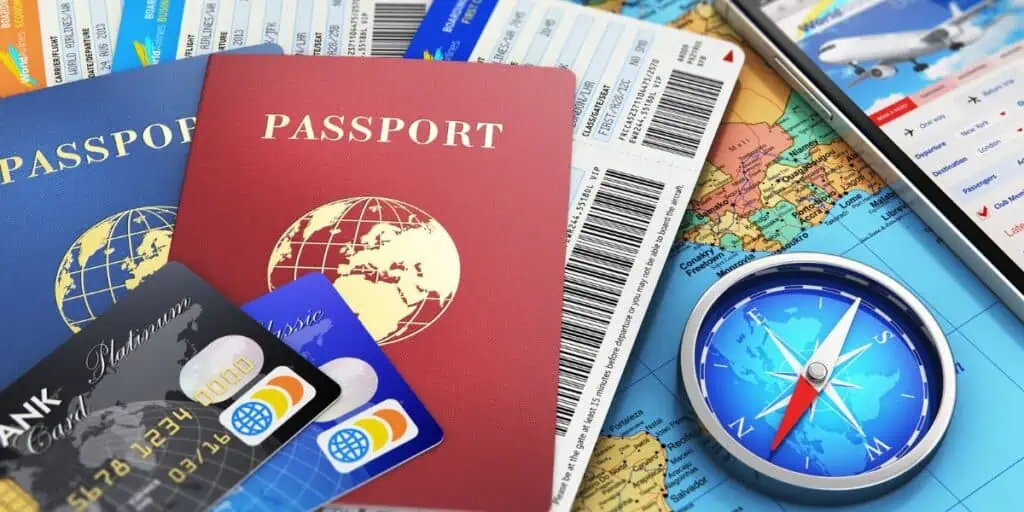
No matter which form of payment you choose, always notify your bank and credit card companies of your travel plans so they can monitor your account for unusual activity and help prevent fraud. You’ll also what to inquire about foreign transaction fees if you travel abroad.
Using a credit card on vacation can have advantages over using a debit card. First, many credit cards offer rewards or cashback for purchases, which can help offset your vacation costs.
As well, credit cards offer more protection against fraud and unauthorized charges. If your credit card is lost or stolen, you can usually dispute the charges and not be held responsible. With a debit card, if someone gets hold of your card and PIN, they can empty your checking account.
How Much Cash Should You Travel With? The amount of cash you should bring on vacation depends on several factors, including your destination, trip length, budget, and personal preferences. A general rule of thumb is to get enough cash to cover your expenses for the first few days of your trip in case your credit cards are not accepted, or there’s a problem with your account.
Keeping Your Money Safe While Traveling . Keep cash, credit cards, and essential documents in a hidden pouch or money belt worn under your clothing to keep them safe from pickpockets. Also, be discreet when using cash or credit cards, and do not flash large amounts of cash publicly to avoid catching a thief’s eye.
3. Preparing and Using Your Mobile Device Abroad

Contact your mobile carrier to inquire about international roaming plans, data usage rates, and other related charges that may apply when using your device abroad. Here are a few tips for preparing and using your cellphone while abroad:
- Some mobile carriers offer international roaming plans that allow you to use your existing SIM card or an eSIM card while traveling abroad. These plans may include additional charges and limits on data usage.
- In some countries, purchasing a local SIM card may be more cost-effective. This can be a good option if you plan to use your phone frequently and want to avoid high international roaming charges.
- Download offline maps and translation apps before your trip so you don’t have to waste your data.
- Make sure you have a travel adapter compatible with the outlets in the country you’re visiting, so you can charge your device.
Generally, checking with your mobile carrier and researching your options before traveling is the best course of action.
4. Get Travel Insurance: It’s Worth The Peace of Mind
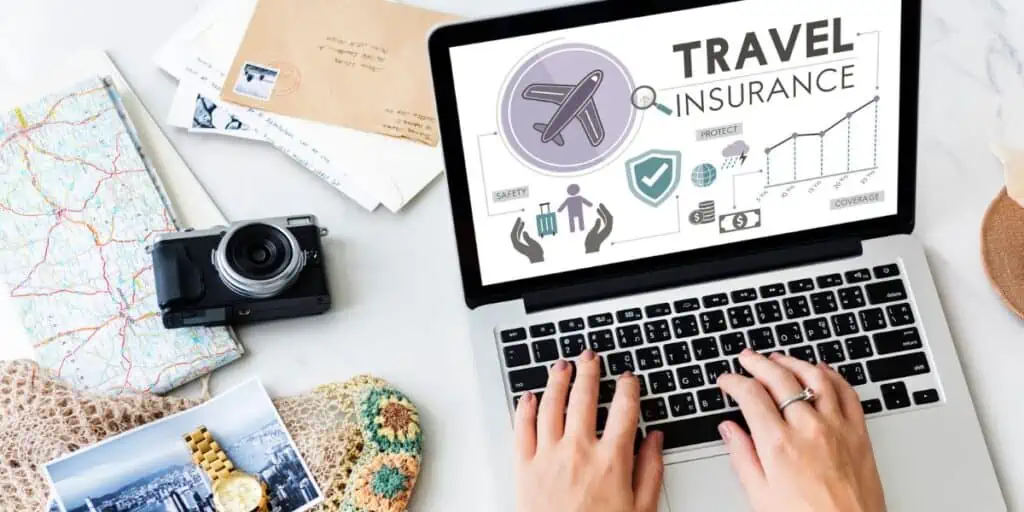
Travel insurance provides financial protection in the event of unexpected situations or emergencies while traveling.
- Trip Cancellation or Interruption: Travel insurance can cover costs incurred if you cancel or interrupt your trip for a covered reason, such as illness, severe weather, or a death in the family.
- Medical Emergencies: Travel insurance can cover medical expenses if you become ill or injured while traveling. This can include emergency medical treatment, evacuation, and repatriation.
- Lost or Stolen Luggage: Travel insurance can cover lost, stolen, or damaged luggage and personal items.
- Emergency Assistance: Travel insurance can provide access to emergency assistance services, such as help with finding a doctor, arranging transportation, and providing translation services.
Be sure to read the policy’s fine print to understand what is covered and what is excluded before purchasing a travel insurance policy.
5. Research the Destination: Safety, Culture, and Laws
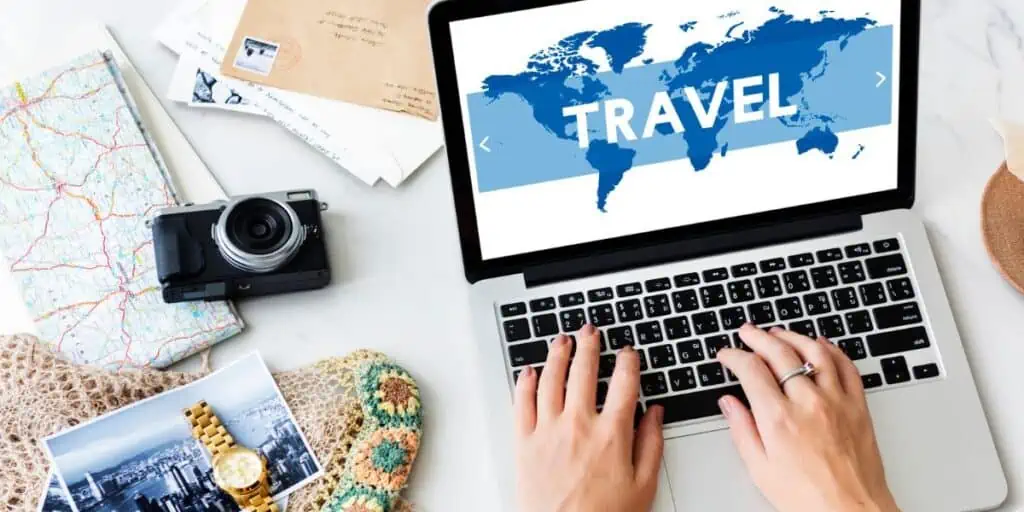
Researching your destination before vacation can help you better prepare for your trip and get the most out of your experience. Here are a few travel tips to consider during your research:
- Safety: Researching a destination can help you understand the safety risks and precautions you should take while traveling. This can include information on crime rates, dangerous locations, natural hazards, and political instability. Check out the U.S. Travel Advisory website.
- Culture and Customs: Understanding the culture and customs of a destination can help you better appreciate the local way of life and avoid any unintentional cultural mistakes.
- Laws and Regulations: Researching the destination’s laws and regulations can help you understand any restrictions or requirements you need to be aware of while traveling, such as visa requirements or local laws.
6. Create a Loose Travel Itinerary
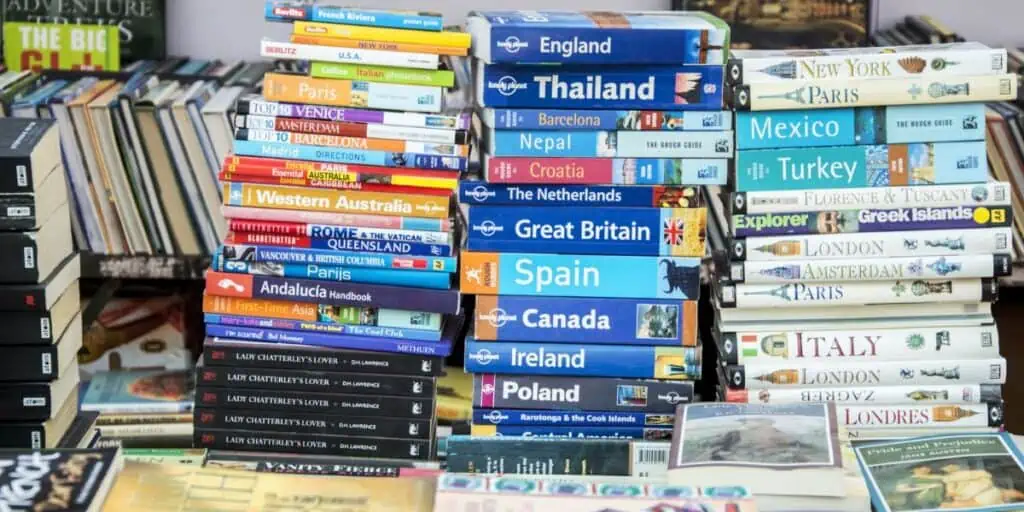
Creating a travel itinerary can help you make the most of your vacation time and ensure that you get all the important sights and activities. It can help you budget your time and money by allowing you to plan out your activities and expenses in advance. It can also help you avoid rushing from place to place or feeling overwhelmed by too many options.
7. Make Copies of Your Important Travel Documents
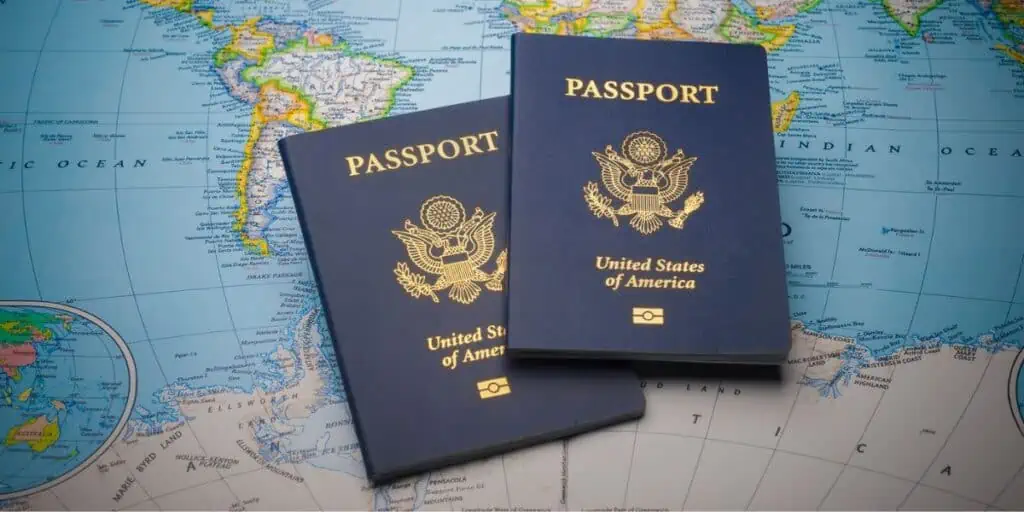
One of the most important travel tips is making copies of important travel documents, such as a passport, ID, and credit cards, before going on vacation. If the original documents are lost or stolen, having copies can help with replacement or verification processes. It’s also important to keep these copies in different places. Consider keeping a digital copy, a paper copy, and leaving a copy with a trusted friend or family member.
8. Stay Organized With A Travel Packing Checklist

A travel packing checklist is a great way to ensure you remember all necessary items before and after your vacation. It allows you to make a comprehensive list of everything you need to bring and to check off items as you pack them. This can save time and reduce stress by eliminating the need to constantly second-guess yourself about what you need to bring.
Additionally, a travel packing checklist can help you stay organized and ensure you have all the essentials, such as your passport, tickets, and medications, that you’ll need for your trip. Using a travel packing checklist can also help you avoid overpacking and reduce the chance of leaving something behind, saving you money and hassle in the long run.
9. Airport Travel Tips
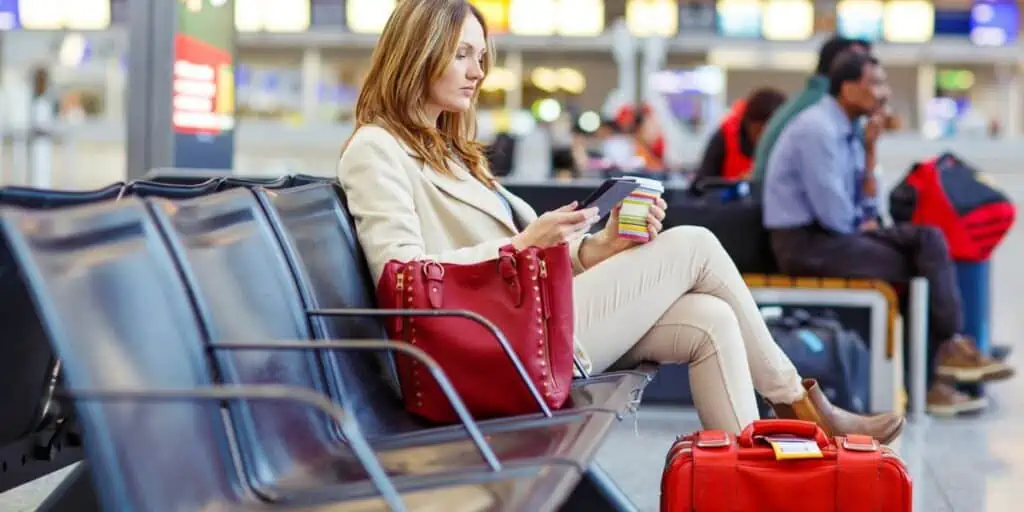
Airports can be stressful, but there are steps you can take to make your experience as smooth as possible. By planning ahead, packing wisely, arriving early, staying organized, and being mindful, you can reduce stress and ensure a more pleasant airport experience. Additionally, staying calm and patient can help keep things in perspective when unexpected issues arise.
Here are several airport travel tips you can use to travel a little easier:
- Arrive Early: Give yourself plenty of time to check in, clear security, and find your gate.
- Check-In Online: Many airlines allow you to check in and print your boarding pass at home, saving you time at the airport.
- Pack Smart: Pack only what you need and be mindful of the size and weight of your luggage. Check with your airline for their carry-on and checked baggage allowances.
- Wear Comfortable Clothes: Dress comfortably for your flight and wear shoes that are easy to slip on and off for security.
- Knowing What You Can Bring: Be familiar with the TSA’s guidelines for carry-on and checked baggage and what items are prohibited.
- Stay Organized: Keep your travel documents, ID, and other important items easily accessible and organized.
- Stay Connected: Keep your phone and other devices charged, and consider a portable charger or battery pack.
- Be Patient: Air travel can be stressful, but stay patient and calm. Remember that things may not always go as planned, but you’ll reach your destination eventually.
- Research the Airport: Learn about the layout, amenities, lounges, and services available at your airport so you know where to go and what to expect.
10. Take A Guided Tour With A Local Expert
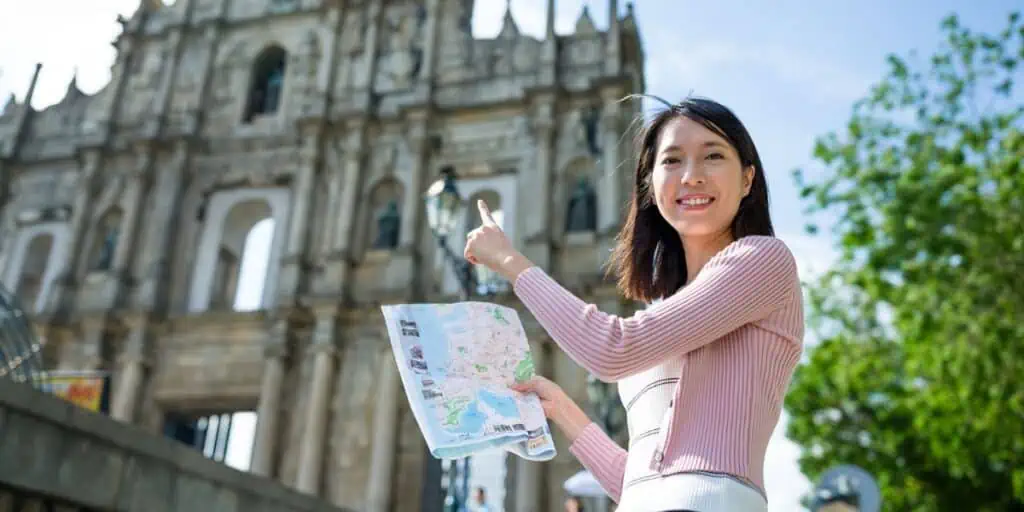
Going on a tour during your vacation can be a great way to experience a destination in a more authentic and meaningful way. A tour can provide a deeper understanding of a place’s history, culture, and customs and offer unique and off-the-beaten-path experiences that may be difficult to find on your own.
Tours are often led by local experts who can provide valuable insights and information about the places you visit. They can also introduce you to local people, customs, and traditions, giving you a more authentic and memorable travel experience.
Going on a tour can also save you time and hassle, as they often include transportation, guides, and admission fees, making your trip more efficient and hassle-free.
Additionally, tours can be a great way to meet other travelers and make new friends, especially if you’re traveling solo. They can also be a great way to discover new places and try new activities you might not have considered.
It’s important to note that there are many types of tours, from big bus tours to small group and private tours. It’s worth researching and choosing the right tour that aligns with your travel style, interests, and budget.
My go-to online tour booking platform is Viator.com . I’ve been on walking tours, mural tours, canal, and river tours, and day trips booked through Viator, and I’ve never had an issue within the US or abroad!
11. Use Public Transportation When Available

Using public transportation on vacation can be a great way to save money , avoid the stress of driving, and experience a destination like a local. Public transportation options, such as buses, subways, and trains, can be much cheaper than renting a car, taking taxis, or using a ride-share app. They can also provide a more immersive travel experience.
Additionally, many cities around the world have excellent public transportation systems that are reliable, efficient, and easy to navigate. They often offer a convenient way to get around and see the sights without needing a car, which can save you money on parking and gas.
Moreover, public transportation can also be a more environmentally friendly option, reducing your carbon footprint and supporting sustainable travel practices.
12. Relax and Practice Self-Care

Setting realistic expectations for your vacation and avoiding over-scheduling or feeling like you need to be doing something constantly. Self-care is crucial to maintaining overall well-being, and it is vital to include self-care activities during a vacation.
Self-Care Travel Tips Include:
- Packing snacks in case you have to miss a meal
- Always carry a water bottle to keep you hydrated
- Make sure that you are getting adequate sleep
- Stay active or schedule time to exercise.
- Add a few healthy meals to your diet
Taking time to rest and rejuvenate can help you return to your daily life feeling refreshed and rejuvenated.
13. Use Your Out-of-Office Reply
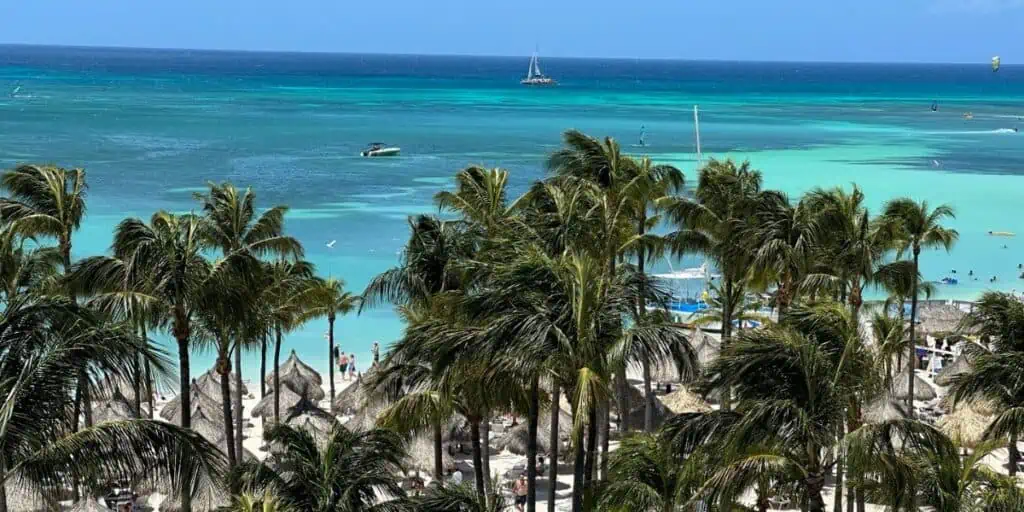
Yes, setting an out-of-office reply is one of the essential travel tips and will ensure you can fully disconnect and enjoy your vacation. This will let anyone who contacts you via email know that you are away and when they can expect a response from you. It also can avoid the unnecessary stress and pressure of checking and responding to emails while you are away. This will help you relax and enjoy your vacation without worrying about work-related matters.
Use These Travel Tips For a Stress-Free Trip

With these travel tips, you can make your trip or vacation a hassle-free and enjoyable experience. From using a packing list and credit card rewards to using public transportation and going on a tour, these strategies can help you make the most of your time away. Remember to plan ahead, stay organized, and be open to new experiences, and you’ll be sure to have a memorable and stress-free vacation. Bon voyage!
This article Travel Tips: 10 Strategies for a Stress-Free, Enjoyable Trip originally appeared on Wander With Alex . Photo Credit: [@Rawpixel/DepositPhotos]
ABOUT THE AUTHOR
Alexandrea Sumuel Groves is a nationally syndicated travel writer and founder of the Wander With Alex travel blog. Her work has appeared on MSN, YAHOO!, Euronews, and FOX, ABC, and NBC affiliates across the United States.
Alex travels to experience, eat, explore, and occasionally escape! She collaborates with destinations, vacation property management companies, and hospitality technology firms to provide her readers with exclusive insights and information.

How To Grill a Tri Tip Roast
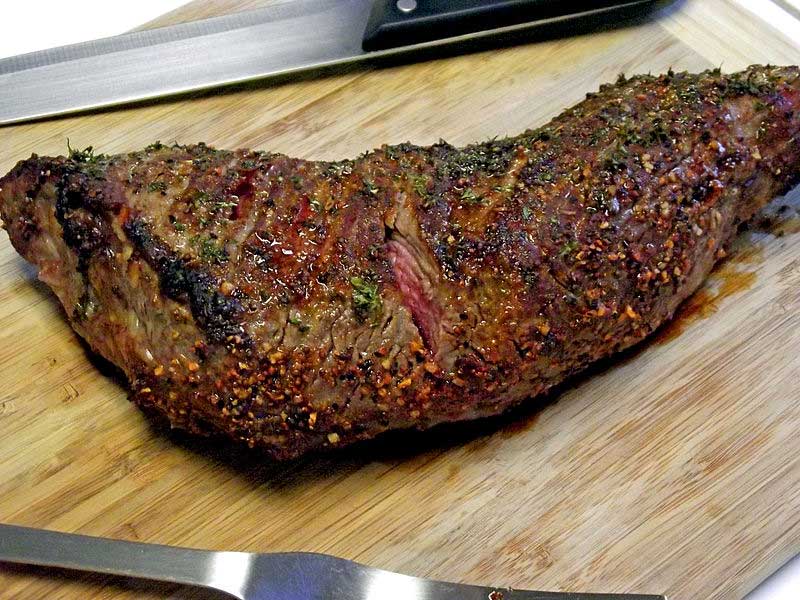
Here is a recap of the video ( extra notes in blue ):
1) Before you light up the grill, take the tri tip roast out of the fridge and bring it to room temperature (or about 70 degrees). This evens out the temperature throughout the roast which will help the roast cook evenly (in other words, you don’t have to burn the outside to cook the deep middle of the roast). Trim the roast as needed.

2) Whil e it’s resting, put your favorite rub on the roas t ; be as liberal with the seasoning as you want. As you pour it on, rub the entire surface and press it into the meat. A note on marinades: I prefer to taste the tri tip instead of the marinade, so do not marinade longer than 12 hours. The bottom line: experiment with how much more flavor you want on your tri tip, but it is such a great tasting piece of meat to begin with so don’t overdo it!
3) Light the grill and bring to medium heat (between 350 – 375 degrees). Preheat for 7-8 minutes. This is the ideal heat to cook the tri tip fully in 35-40 minutes, depending on the size of the roast.
4) Place the meat fat side up in between the burners. Why? This will prevent flare ups from any dripping fat that lands on the burner covers.

5) Put the cover down and keep an eye on it ; you don’t want to lose your roast to an accidental flare up and you want to make sure that the temperature stays around 350 degrees for the entire grill.
6) Cook for 15 minutes before flipping. You should occasionally lift the grill cover slightly to make sure you are not getting flareups and to check for “hot spots” (lift up the roast slightly to see if one part of the roast is getting cooked unevenly; move or spin – but don’t flip – the roast if necessary). Also, use tongs when flipping. Do not pierce the meat or you will lose a lot of the tasty juices as it cooks; you will wind up with a dried out, pathetic roast that could leave your guests depressed and violently angry.
7) Cook for 15-20 minutes, then check to see if the roast “bounces” off the grill ; as beef cooks, it gets denser (or firmer). If it bounces, check the temperature with a meat thermometer. Make sure you check right in the middle of the roast. When it hits 135 degrees, it is ready to come off the grill if you want medium rare. Take it off at 140-145 degrees for medium.

8) Let the meat rest for 10 minutes – this is perhap s the MOST IMPORTANT STEP. Do not (I repeat: DO NOT) cut it right away ; this resting period gives time for the juices to be distributed throughout the meat instead of all over the cutting board. Also, the meat will rise about 8-10 degrees while it rests. You want a juicy roast, so let that bad boy rest!
9) Remember to cut against the grain when it is time to trim, and cut the slices as thin as possible (no thicker than 1/2 an inch). We will have a video coming soon that just addresses trimming, but the short version is this: cut it in half then slice long ways.
Click to download and/or print up this tri tip rub recipe!
Terms and Conditions - Privacy Policy
[juicer name=”stanbroke-49e50ac7-3770-4eae-a4bf-8d1699cbfe53″ per=”12″ gutter=”20″ pages=”1″]

What cut of beef is tri tip and how do you cook it?
Want to smoke a brisket but don’t have the time? Tri tip might just be your new best friend.
Tri tip is a triangular cut of beef cut from the bottom of the sirloin. Named after its triangular shape with a tapered “tip”, tri tip might just be one of the most flavourful cuts of meat that you’ve never heard of.
Often confused with brisket or picanha, tri tip is most popular in southern California, so you can be forgiven if you’ve never come across it before. It is also called a California cut, a bottom sirloin butt, a Newport steak, a Santa Maria steak or even referred to as a “poor man’s brisket”. But unlike brisket – which comes from the front of the cow, below the chuck – tri tip is actually considered a steak.
Tri tip dates back to early 19th century America, where it was a write-off and ground up to be used in hamburger meat. It wasn’t until the 1950s when Bob Schutz, the then-owner of Santa Maria Market, upon receiving an excess of hamburger meat, decided to prepare and eat it like a steak. The result was well received and the rest, as they say, is history.
How to prepare tri tip
Tri tip can be bought from the butcher trimmed or untrimmed. While it’s generally cheaper to buy the latter, make sure you have a knife sharp enough at home to trim it yourself – otherwise it’s probably worthwhile spending a few extra dollars per pound/kilogram to have the butcher do it for you. You can also buy tri tip steaks individually, which are ideal for smaller households.
Just like a brisket, you want to cut off any ragged ends and silver skin, trimming down the fat as much as possible. It’s fine to leave a little fat on, but get rid of any thick chunks of fat so that you are left with a lean, boneless, boomerang-shaped piece of meat.
When it comes to seasoning, tri tip is incredibly versatile and takes well to both dry and wet rubs. As it’s a fairly thick cut, you want to season it aggressively with salt, pepper and your favourite spices. To help the seasoning stick, first rub it with a neutral oil and coat it in your preferred spice mix.
How to cook tri tip
Rich and meaty in flavour and low in fat, tri tip cooks like a tender steak but slices like a brisket – perfect for people who want to do a brisket-like cook up but dont have the time. It can be smoked, barbecued, grilled or roasted, but it’s always best when cooked to a nice medium rare, before letting it rest and slicing.
Cook the tri tip in a low oven at 275ºF / 135ºC or smoke it with indirect high heat for about 45 minutes, letting the meat cook evenly the whole way through. For best results when cooking, always use a meat thermometer. Insert the thermometer horizontally into the thickest part of the tri tip and aim for an internal temperature of 125ºF–130ºF/51ºC–54ºC. Remember that it’s triangular shape will mean that the tail or “tip” will be more done, while the centre will be slightly pinker.
Once you have achieved your desired doneness, transfer the tri tip directly onto charcoal or onto a hot pan to give it a final sear on the outside.
Allow the meat to rest for 5–10 minutes before slicing.
A final tip for your tri tip
Take care when slicing your tri tip – an incorrect cut can take the meat from tender and juicy to tough and chewy. Tri tip has two distinct grain patterns: one vertical and one horizontal. For best results, cut the steak in half where the two grains intersect. Then slice each piece against the grain, to ensure you get the most tender slices of meat.
Perhaps the biggest benefit of cooking tri tip is its simplicity. As David Somerville from BBQ Dry Rubs says, “It is much simpler to cook a tri tip than a brisket. As long as you have a digital thermometer and are remotely familiar with how to grill a steak then you will do great with a tri tip. Briskets, on the other hand, have been known to make grown men cry.”
How to smoke a brisket: Tips from a barbecue grand champion
How to cook individual beef wellingtons
Related posts
Recipe: vinny clist’s classic beef tartare, what is the best cut for roast beef, what are the best cuts of steak in the supermarket, where every cut of beef comes from [infographic], which cuts of steak have the least fat, porterhouse steak: australia vs europe, want steak school to sizzle up your inbox sign up for exclusive content, events, competitions and much more., need help cooking download these handy apps from meat and livestock australia.
- Search Please fill out this field.
- Manage Your Subscription
- Give a Gift Subscription
- BHG Archives
- Newsletters
- Sweepstakes
- Recipes & Cooking
- How to Cook
- Meat & Poultry
3 Ways to Cook a Tri-Tip Roast for Tender, Flavorful Meat
Master how to cook tri-tip in ovens, on grills, and in smokers for supremely tender and juicy (yet lean) results.
Karla Walsh began her career at FITNESS magazine in 2010. Since, she's worked at a wide variety of publications full-time, including BHG.com, Recipe.com and as a cross-brand social media specialist. From search engine optimization to features for print to video strategy, she has a diverse background in all things magazines. At the start of 2019, Karla chose to pursue full-time freelance writing and has contributed to more than 3 dozen brands.
:max_bytes(150000):strip_icc():format(webp)/Karla_Walsh_Headshot-6cbfa8e7b23144a39174382603e25367.jpg)
Beef is one of our favorite dinner showstoppers. We're not just talking about your common ground beef (although that totally hits the spot and beats the clock on time-crunched nights for us!)—we're talking tri-tip roast. Compared to ground beef or a beef pot roast , cooking tri-tip roast can seem intimidating because most home cooks don't do so quite as often. But fear not: Our Test Kitchen experts are here to guide you along and teach you how to cook tri-tip in ovens, how to grill tri-tip, and even the secrets to the best smoked tri-tip roast.
What Is Beef Tri-Tip Roast?
Before we dive into the basics of cooking a tri-tip roast, here's what to know about the cut. Tri-tip roast is a tender, lean beef cut that gets its name from its triangular shape. (It's also called bottom sirloin roast and triangle roast, so keep an eye out for these synonyms for tri-tip roast.) It's sold as a small roast from the bottom sirloin, or it's cut into a steak with three tips. What makes tri-tip roast stand out from other cuts is the full flavor it promises for an affordable price.
A boneless tri-tip roast weighs around 1½ to 2 pounds and is about 2 inches thick, typically making 6 to 8 servings. It can also be cut into steaks or cubed for kabobs. Tri-tip meat should be nicely marbled even though it is considered a lean, tender cut. It is especially prized for its rich flavor. Whether you make smoked , grilled, or oven-roasted tri-tip, you can score tender meat with a just-pink-enough center and a caramelized crust, all in less time than most more significant roast beef cuts .
How to Cook a Tri-Tip Roast
No matter your cooking method, you'll start the prep process for cooking your tri-tip roast the same way.
Step 1: Season Tri-Tip Roast
For added flavor, consider seasoning your tri-tip roast with a barbecue rub . If you have the time, cover the seasoned roast with foil and chill 6 to 24 hours. This will allow the flavors to penetrate the meat more deeply. Or marinate the roast in your favorite meat marinade for up to 24 hours in the refrigerator.
You can also sprinkle the meat with salt and ground black pepper before cooking, then serve with a sauce or a topping, such as barbecue sauce , herb pesto , or your favorite salsa recipe .
Step 2: Choose Your Cooking Method
If you own a charcoal grill or gas grill , going that route for cooking a tri-tip roast can be grate (ahem, great). Otherwise, smoked tri-tip roast or oven-roasted tri-tip can also result in pitmaster-quality meat.
Here's how to cook tri-tip using any of these methods.
How to Cook Tri-Tip in the Oven
Oven-roasted tri-tip is the best way to cook tri-tip in colder months when you can stay cozy and enjoy the mouthwatering aromas indoors. To roast tri-tip, start by choosing a roasting pan that's the right size for the job. It should be a large shallow pan with a rack inside. The pan sides should be 2 to 3 inches tall. If you don't have a roasting pan, you can use a 13x9-inch baking pan with an oven-safe wire rack set inside.
These instructions are for how long to cook tri-tip roast in the oven at 425°F, which allows for a nice medium-cooked middle and browned exterior. As this cut is fairly lean, we don't recommend cooking it beyond medium doneness.
- Preheat the oven to 425°F.
- Place the roast on a rack in a shallow roasting pan. Insert an oven-going meat thermometer into the thickest part of the roast. Do not add water or liquid and do not cover.
- Roast in the preheated oven. For a 1½- to 2-pound roast, roast 30 to 55 minutes for medium rare (135°F) or 40 to 45 minutes for medium (150°F). Use a meat thermometer to test for doneness.
- Remove the roast from the oven, tent with foil, and let stand 15 minutes before slicing. This standing time not only brings up the temperature, but it also allows the juices to be absorbed back into the meat so they don't spill out onto the cutting board.
How to Grill Tri-Tip Roasts
Cooking tri-tip roasts on the grill is a nice way to infuse more flavor while keeping your kitchen cool.
- Prepare gas or charcoal grill for indirect heat using a drip pan. Place the tri-tip roast on the grill over the drip pan.
- Cover and grill to desired doneness. For a 1½- to 2-pound tri-tip roast: Grill 35 to 40 minutes for medium rare (135°F) and 40 to 45 minutes for medium (150°F). Use a meat thermometer to test for doneness.
- Remove meat from the grill. Cover meat with foil; let stand for 15 minutes.
How to Smoke Tri-Tip Roasts
Smoked tri-tip roast is doable on any smoker, including a grill transformed into a DIY smoker . The only requirement is that the smoker can maintain a steady 225°F temperature.
- Preheat the smoker to 225°F. Opt for hickory or oak wood chips for a more robust smoked flavor.
- Place the tri-tip roast in the smoker, close the lid, and smoke until the internal temperature reaches 125°F or so (medium rare is 135°F and medium 150°F. The internal temperature will rise during searing and standing time). Remove the meat from the smoker.
- Heat a cast-iron skillet over high heat to create a caramelized crust and lock in the juices.
- Melt 2 tablespoons butter in the skillet and sear the tri-tip roast for 2 minutes per side, basting the meat by spooning the butter over the meat as it cooks.
- Remove meat from the skillet. Cover meat with foil; let stand for 15 minutes.
Step 3: How to Cut a Tri-Tip Roast
When your meat is done cooking, transfer the tri-tip roast to a cutting board to rest for 15 minutes under foil. With a carving knife , thinly slice the meat across the grain. Slicing fibrous cuts of beef such as brisket, flank steaks, and tri-tip across the grain helps make them fork tender.
Now that you're well-versed in three options for cooking a tri-tip roast, you can slice and share this crave-able cut of meat any night of the week. Add a fresh salad to start, and some red wine to sip alongside, and a restaurant-quality dinner can be yours—for a fraction of the price.
Related Articles
Only a carry-on for extended trips: 4 tips to pack like a pro | Cruising Altitude
- If you’re traveling for a long time, don’t be afraid to do laundry while you’re away.
- Shoes are probably the bulkiest items you’ll pack, and if you can manage to bring one or two versatile pairs, you can save a lot of space in your suitcase.
- When you’re packing you should ask yourself: how many times in your regular life do you do multiple outfit changes per day?
One of the best marks of a frequent traveler is being able to pack quickly and efficiently. It’s likely part of the reason that people who fly a lot are so eager to get on the plane as soon as possible because the faster you board, the more likely you are to secure convenient overhead bin space and not be forced to check your carry-on bag. Most frequent flyers, myself included, avoid checking a bag whenever possible.
It may seem daunting to take a 10-day trip with just a small rollaboard, but I promise it’s possible. I talked to Wilson Santiago Burgos , founder of Mochileando.com and regular contributor here at USA TODAY, who is currently on a three-month trip with only a backpack.
We compared notes on how we economize our packing, and while we don’t use all the same strategies, between the two of us we hope these four tips can help you in your own travels.
1. Lose the shoes
This is my biggest advice to almost everyone who’s trying to reduce their luggage. Shoes are probably the bulkiest items you’ll pack, and if you can manage to bring one or two versatile pairs, you can save a lot of space in your suitcase.
On his current trip to Central Asia, Santiago told me he only brought sneakers and a nicer pair of shoes for dinner and city activities. For warmer weather, you might only need flip-flops and dinner shoes.
“One technique I use always to save space in my luggage is I always wear the biggest shoes I bring when I fly,” Santiago told me.
And that’s something I do as well. Of course, I’m not wearing my snowboarding boots on the plane for a trip to the mountains, but I’ll wear regular snow boots while I travel and pack a pair of sneakers if need be for that kind of trip.
2. Don’t be afraid to do laundry
I’ll confess I don’t usually travel long enough for this to be an issue, But Santiago told me he often travels for months at a time with only a backpack, and the key to that technique is not being afraid to do laundry while you’re away.
“When I’m traveling too long I have clothes for 7-10 days so I wash my clothes at the hotels,” he said.
“Last week I washed my clothes in Uzbekistan and it was $14, it was so cheap,” Santiago added. “If you do the math, it’s probably cheaper to wash clothes than to pay for a checked bag every time you have to take a flight in a trip of three months.”
Last week's Cruising Altitude: Why airport bathrooms are gaining attention
3. Make a list
This was a big point of difference for us. I pretty much never make a paper list for packing. I have my own routine and usually know what I need to bring. I often just pack a few hours before I leave, especially if I have an evening flight, and count out the items I’ll bring by day.
Santiago, on the other hand, told me he makes a list every time.
“The list for me is very important: you save space, but you won’t forget anything important like medicines, technology, passport,” he said.
In his defense, he may be right. On a recent trip, I forgot to pack toothpaste for the first time in my life. Maybe it’s time for me to start getting more organized, too.
From 10Best: Best pet carriers for dogs, cats, and furry friends of all shapes and sizes
4. Do a post-mortem
You don’t have to feel like a failure if you don’t manage to pack light on your next trip, but if that happens and you want to travel lighter on the one after that, you can do some reflection when you get home.
“Ask yourself one question: In the last trip that you did, did you use all the things that you have in your bags? If the answer is no, you know you have space to improve your packing,” Santiago said. “My experience is 70%-80% of the people, they will tell you they didn’t use all of the things they packed on the last trip.”
Now listen, I’m not a purist here. I think it’s a good idea to bring a few extras: maybe you’ll need a change of underwear or you’ll spill something on your shirt and want to swap it out. But honestly, when you’re packing you should ask yourself: how many times in your regular life do you do multiple outfit changes per day? You can avoid overpacking by bringing only what you’d use on a normal day, so long as you don’t need any specialized gear.
Zach Wichter is a travel reporter for USA TODAY based in New York. You can reach him at [email protected].
The Key Points at the top of this article were created with the assistance of Artificial Intelligence (AI) and reviewed by a journalist before publication. No other parts of the article were generated using AI. Learn more .
Want to start a healthy lifestyle? Get my FREE Top 15 Health Tips!
Search this site
How to cook tri tip (recipe for oven or grilled).
- paleo Paleo
In this post I walk you through exactly how to cook tri-tip. I have instructions for BOTH oven roasted and grilled ! I love it grilled/smoked, so that’s the method I usually use. But it’s also delicious when roasted in the oven! Oven-roasting is the perfect way to use this cut of meat for an easy weeknight meal.
- Share on Pinterest
- Share via Email
- Share on Facebook
- Share on Twitter
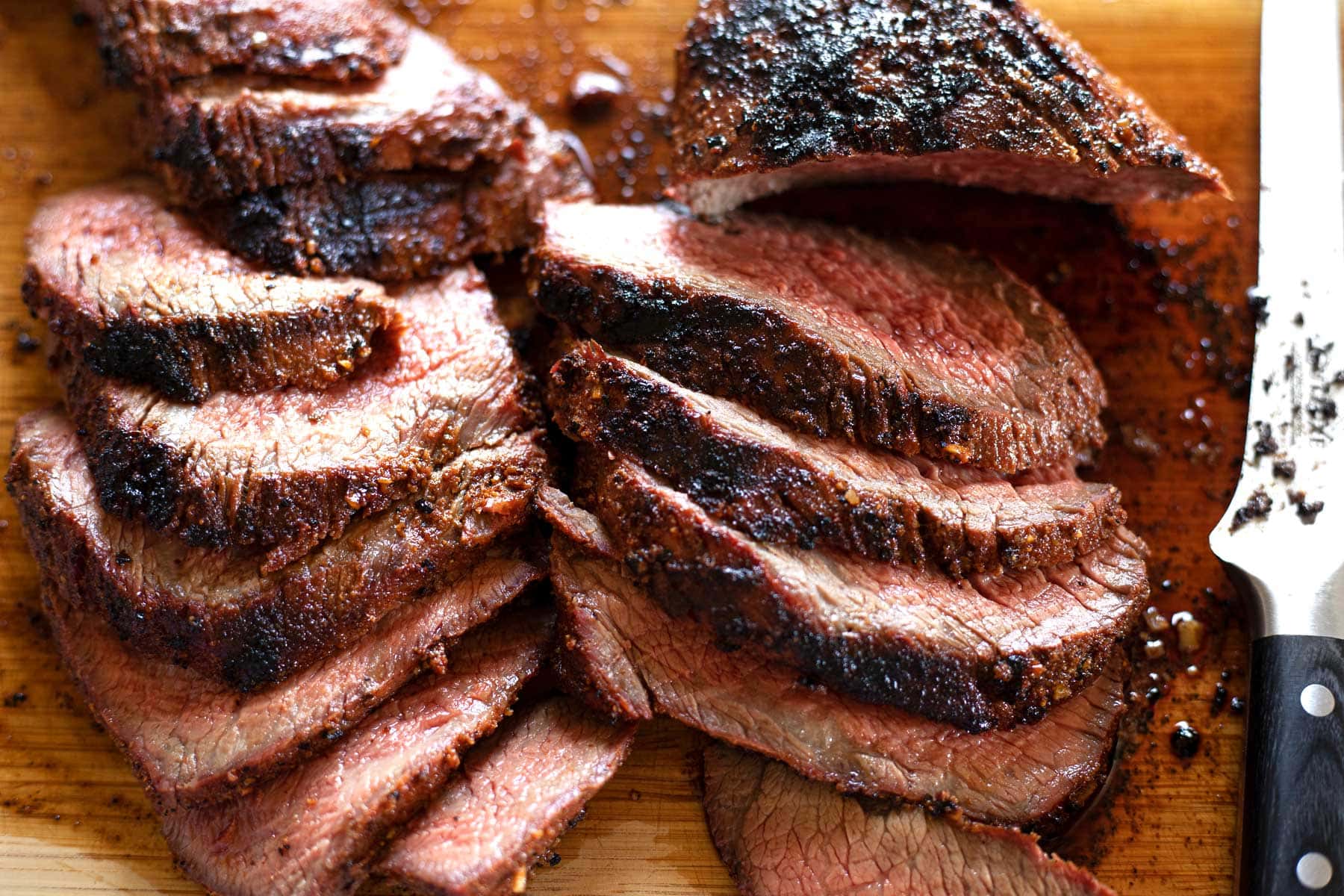
What is tri-tip?
Tri-tip is a boomerang-shaped, triangular cut of beef from very bottom of the bottom sirloin, near the flank steak. It is highly marbled and perfect for grilling, smoking, and roasting. It produces juicy, flavorful slices of beef that are perfect for serving like slices of steak or chopping up and stuffing in tacos!
This triangular shape roast is most commonly found in California, but you can ask most butchers in the US and they’ll know what it is and be able to cut it for you. This classic California cut is actually making waves recently and becoming much more popular in the rest of the US!
This delicious cut of meat is so underrated. It’s super flavorful, juicy, and an affordable alternative to steaks or beef tenderloin if you’re feeding a crowd. Another advantage of the tri-tip is that you have slices of varying doneness to serve, so everyone can choose if they like medium-rare, medium, or even well done on the ends!
Some other names for the tri-tip are tri tip steak, triangle steak, triangle tip, and Santa Maria steak. You may also come across something called a “Newport steak” or “apartment steak” in places like NYC. This steak is cut from the tri-tip but the perfect size for 1 or 2 people, whereas a whole tri-tip can feed a crowd.
How to cook tri-tip
This delicious cut of meat can be cooked on the grill/smoker or in the oven! Both methods are super delicious! Grilling is probably the best way (and my favorite way) to cook it, but if you aren’t feeling up to grilling then oven-roasting is a great alternative!
Grilled/Smoked – This is definitely my preferred method, as the flavor is just unmatched. I don’t do much grilling or smoking on weekdays though, so I save this for the weekends. Just season the meat, grill over high heat to get a nice sear, then move to indirect heat to finish the cooking/smoking process. It takes about 1.5 hour total.
Oven-roasted – This cooking method is perfect for weeknight meals! It’s super simple, practically fool-proof, and definitely the easiest way to cook a tri tip. Just the meat season, sear, then roast to perfection in the oven. This is very similar to how you would roast a prime rib or beef tenderloin. And it kind of comes out like part steak, part roast! Also similar to a prime rib or tenderloin. The total time for oven roasting is going to be about 1 hour.
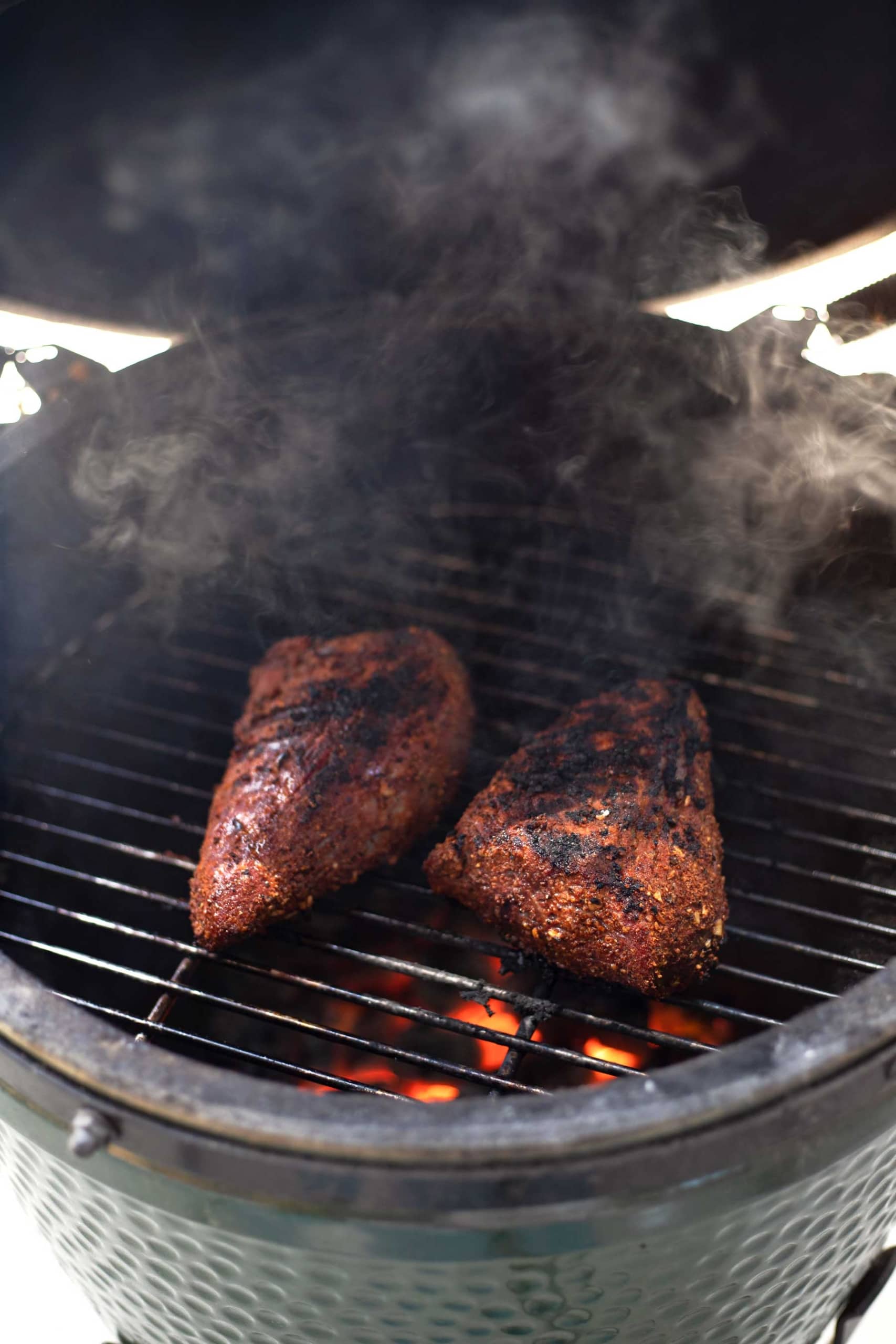
How to get the juiciest, most perfectly cooked tri-tip
I know you don’t want to hear this, but to get the tri-tip roast cooked just right, you really need to use a meat thermometer . Using a meat thermometer will ensure that your tri-tip is cooked to perfection every single time. No undercooking or overcooking. No guesswork!! Just the best results. The first time and every single time. I love that!!
This is such a great thing when you are serving to guests! You can always make sure you are serving them perfectly cooked meat (i.e. less stress for you!!).
I love this meat thermometer and have had it for years! It’s simple and affordable. An instant-read thermometer is also good to have on hand, but I prefer one that can be left in the meat to avoid having to open the grill or oven to check the temperature. This is essential when grilling during colder months, as you don’t want let too much heat escape by having to open up the grill to check on the temp.
What kind of grill can I use to cook tri-tip?
You can really use any kind of grill to cook tri tip roast. I use a ceramic grill (Big Green Egg) as it is a great for grilling and smoking. I’ve been using mine for a long time and cannot recommend it enough! But regular charcoal grills like Webers and even gas grills can be used to make a delicious tri-tip!
If using a ceramic grill , like the Big Green Egg, you’ll set the grill up for indirect heat using a heat deflector after the initial direct heat cooking. I love this cast iron heat deflector!
If using a regular charcoal grill , like a Weber, you will want to create two zones in your grill by placing coals only on one side of the grill, leaving the other side empty so that you can move the meat from direct heat over to indirect heat.
If using a gas grill , just use the burners on one side of the grill to first grill over direct heat, then move the meat over off the direct heat to a zone without burners on to finish the cooking process.
Ingredients needed for this tri-tip recipe
- 2 lb tri-tip roast (preferably organic and grass-fed/pasture-raised)
- 1 Tbsp fine sea salt
- 2 tsp freshly ground black pepper
- 2 tsp garlic powder
- 2 tsp dried minced onion
- 1 tsp dried lemon peel
- 1 tsp paprika
- 1/2 tsp smoked paprika
- 1/8 tsp cayenne pepper
- Avocado oil
Please keep in mind that the ingredient amounts are for a 2-pound roast. So, if your tri tip is larger or smaller you will need to adjust the seasonings a bit.

How to cook tri-tip in the oven
( printable recipe card below! )
- Make steak rub by combining spices in a small bowl. Mix well. Trim any silver skin off. Coat the tri-tip with dry rub on all sides. If the tri-tip still has the fat cap on it, score the fat cap in a criss-cross pattern and work some of the rub into the grooves. If the fat cap is very thick, trim some of it off before this to give you a thin layer of fat, then score and season. Allow to sit at room temperature for about 1 hour to take the chill off.
- Preheat oven to 250ºF.
- Pan sear tri-tip. Heat 1 Tbsp avocado oil in a large skillet over medium-high heat. This can be a cast iron skillet or metal skillet. I love to use my 12-inch cast-iron skillet for this. Once hot, sear the meat on all sides until well-browned (about 10 minutes total). Move the tri-tip to a roasting pan with a rack. I like this roasting pan . You can also use a rimmed baking sheet with a metal rack.
- Roast in oven. Insert a meat thermometer into the center at the thickest part and place on the center oven rack of preheated oven. Roast until until the internal temperature of the meat reaches 130ºF for medium rare and 140ºF for medium doneness. If the tri-tip still has the fat cap on it, roast it with the fat side up. Cooking time will vary, but it should be around 30-40 minutes for a 2 lb tri tip. As always, I recommend medium-rare steak.
- Remove and rest. Remove tri-tip from the oven and let the meat rest for 10 minutes on the roasting rack.
- Slice. Move to a cutting board and slice against the grain in thin slices with a very sharp knife. Leave in whole slices if serving as a main dish or for sandwiches. For tacos, cut slices into strips against the grain.
- Serve with your favorite sauce. I love it in slices with my creamy peppercorn herb sauce . You can also pile it high on a sandwich with bbq sauce, or stuff into tacos with plenty of fresh salsa, avocado slices, or other toppings.
- Store any leftovers in an airtight container in the refrigerator for up to 4 days or in the freezer for up to 6 months. But let’s be honest, will there really be enough leftovers to freeze?!? This flavorful piece of meat is just too good! Ours disappears pretty quickly!!
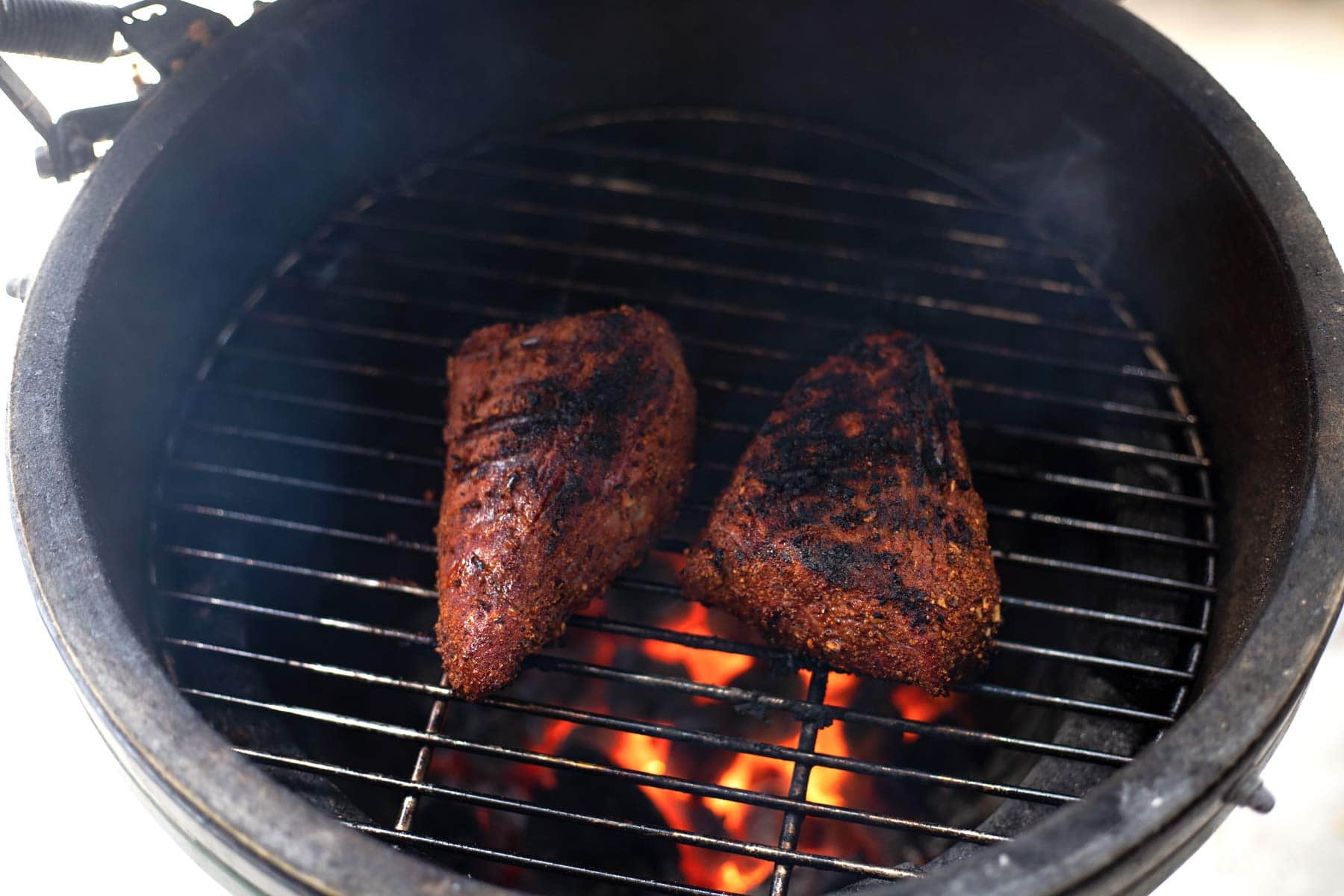
How to cook tri-tip on the grill
( printable recipe card here ! )
- Make steak rub by combining spices in a small bowl. Mix well. Trim any silver skin off. Coat all sides of the tri-tip with dry rub. Allow to sit at room temperature for about 1 hour to take the chill off. If the tri-tip still has the fat cap, I actually like to remove most of it for the grilling method
- Preheat grill to medium-high heat (450ºF). For cooking tri-tip, the first step is to cook over direct heat (to get that nice sear at a higher temperature), then move to indirect heat to finish the cooking process. If using a ceramic grill, you’ll set the grill up for indirect heat using a heat deflector after the initial direct heat cooking. If using a regular charcoal grill, you will want to create two zones in your grill by placing coals only on one side of the grill, leaving the other side empty so that you can move the meat from direct heat over to indirect heat. If using a gas grill, just use the burners on one side of the grill to first grill over direct heat, then move the meat over off the direct heat to a zone without burners on.
- Grill tri-tip over direct heat. Once grill is hot, carefully oil the grates. Take care because oil can cause flames to jump up over the grates. Place roast on the grill, close the top, and cook for 6 minutes. Flip, close the lid, and cook for 7 more minutes or until well browned on the outside. Some variation in grill temperature is okay, just try to keep it between 450-500ºF during this part of the cooking process.
- Grill/smoke over indirect heat . Insert a meat thermometer and move the tri-tip to indirect heat. Close the lid and bring the grill temperature down to around 250ºF and cook until the internal temperature of the meat reaches 130ºF for medium rare and 140ºF for medium. Cooking times will vary, but it should be about 10-15 minutes here over indirect heat. I recommend a medium rare roast, which will be 130 degrees F right off the grill and 130-135 degrees F after resting.
- Remove and rest. Remove tri-tip from grill and allow to rest for 10 minutes on a cutting board.
- Slice against the grain in thin slices with a very sharp knife. Leave in whole slices if serving as a main dish or for sandwiches. For tacos, cut the slices of tri-tip meat into strips against the grain.
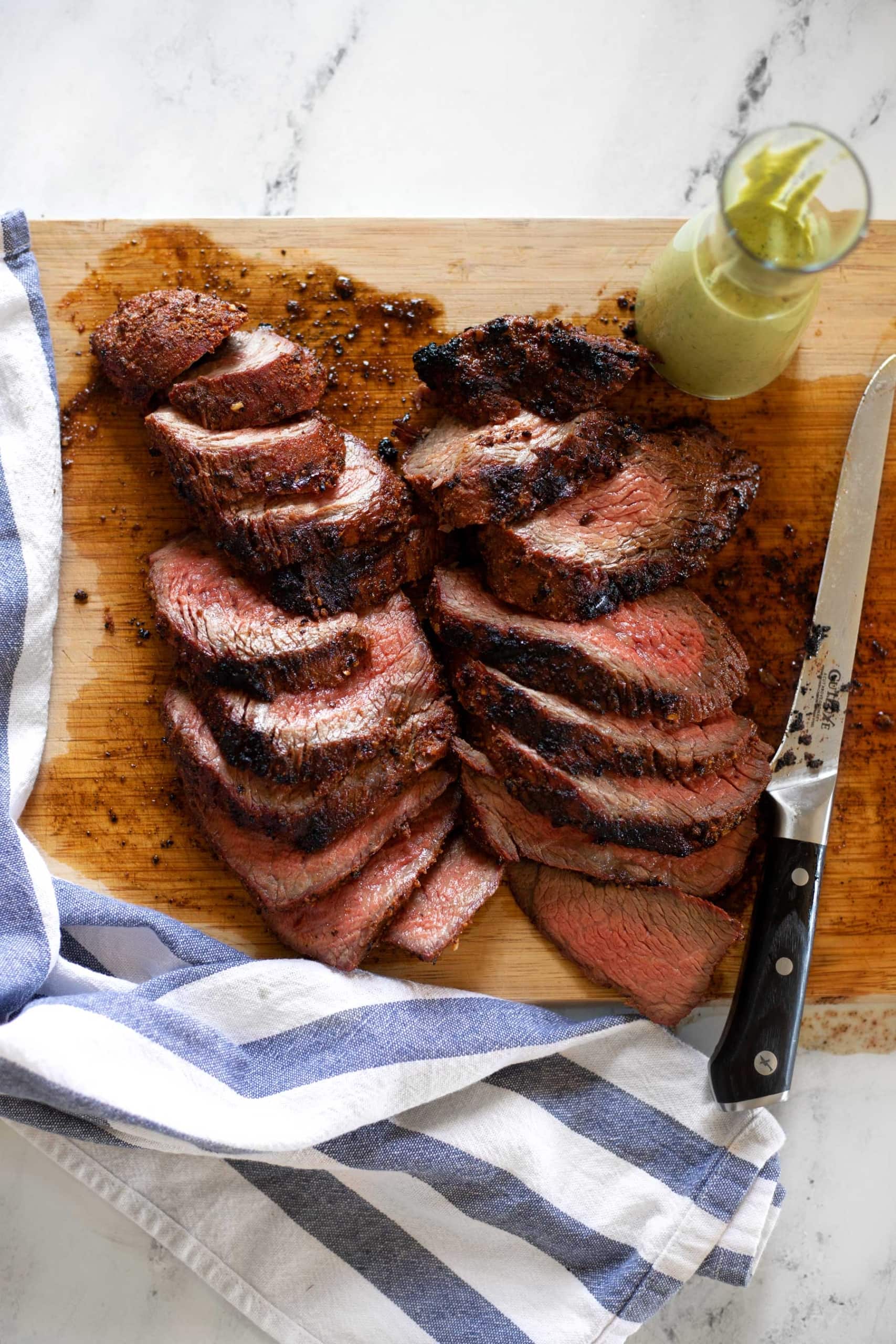
How to slice tri-tip steak (this is important!!)
One thing to take note of: there are TWO different directions of the grain within the tri-tip roast. You want to make sure to cut each portion of the triangle roast against the grain. The grain is basically the way the muscle fibers run.
You can cut the tri-tip joint down the center where the direction of the grain changes before cooking or after cooking. And some tri-tips are even sold already cut, as shown in the photos.
If you cut before cooking, you’ll have more surface area to season and brown, so probably more flavorful slices overall. But cutting in half after cooking is also fine! Just make sure to check to see what direction the grain is going before you slice to get the most tender slices.
Other ingredients/techniques that you could use:
- Your favorite BBQ sauce – Heat gently over medium heat in a saucepan while the meat is resting so it’s nice and warm for serving with the meat. This should only take about 2-3 minutes.
- Santa Maria rub – You can find this online or in a specialty grocery store. It can be used in all sorts of great recipes, not just for tri tip. I love it on ribeyes!
- Chili powder
- Garlic salt
- Onion powder
- Kosher salt
- Aluminum foil to tent at the end (I usually don’t bother)
- Slow cooker (just sear then insert a meat thermometer and cook on high to desired level of doneness)
- Olive oil – If you don’t have avocado oil on hand, a few tablespoons of olive oil will do in a pinch (it just has a lower smoking point)
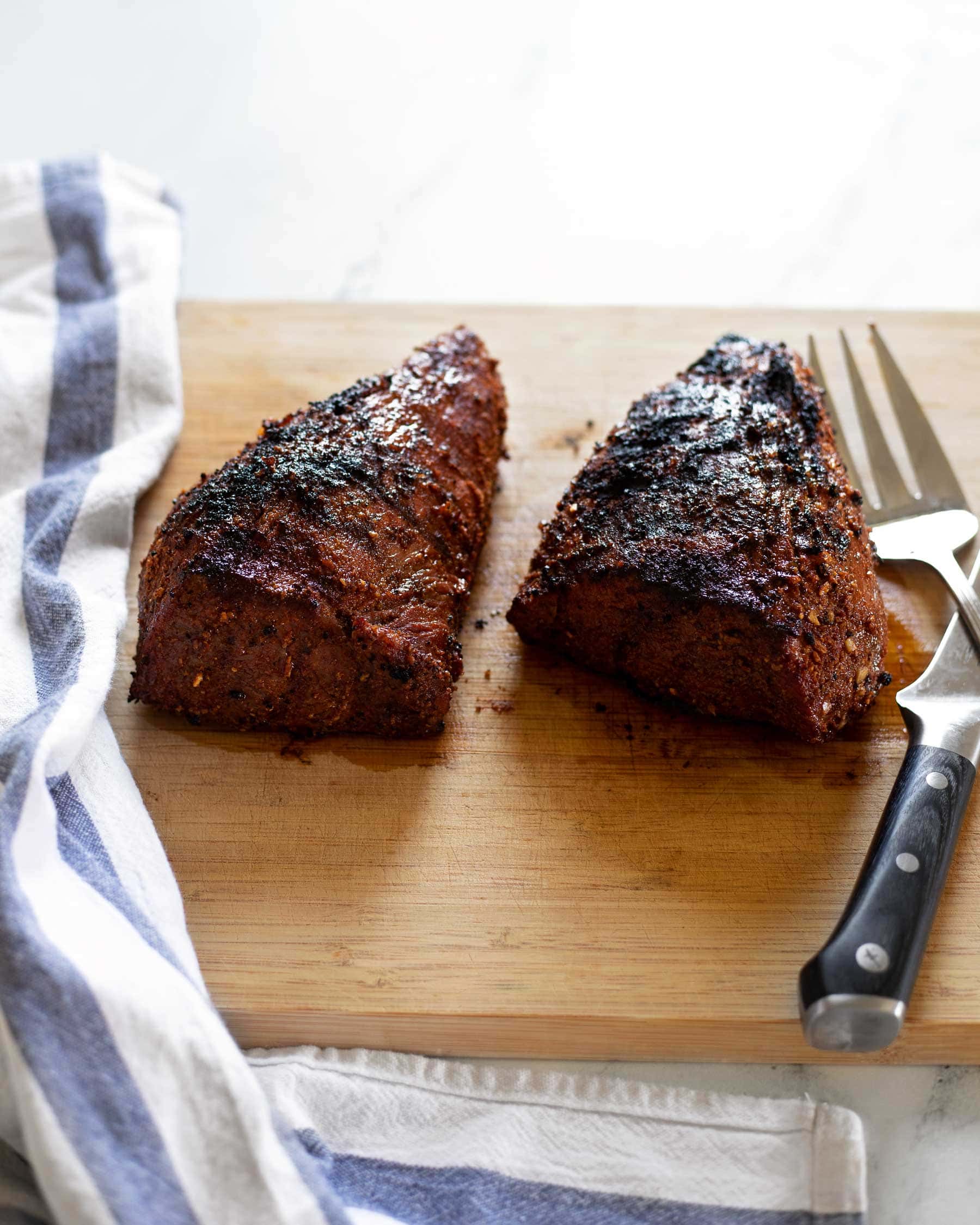
What other cuts of meat can be used with this recipe?
- Top sirloin steak
- Bottom sirloin steak
- London broil
- Thick Beef steaks like ribeyes
- Bottom round (probably the least tender option, but very flavorful)
- Chuck roast (less lean, so it’s better slow cooked)
Love meat recipes? Check out these!
- Melt in Your Mouth Roast Beef
- Simple Crock Pot Pork Loin Recipe with Honey Garlic Glaze
- Perfect Air Fryer Steak with Blue Cheese Garlic Butter
- Instant Pot Carnitas
- Easy Instant Pot Beef Stew (by my friend Jean at What Great Grandma Ate)

Join My Community!
Want to get my new recipes delivered straight to your inbox? Sign up for my weekly newsletter and never miss a new recipe!

How to Cook Tri Tip in Oven
Ingredients .
- 2 lb tri-tip roast preferably organic and grass-fed/pasture-raised
- 1 Tbsp fine sea salt
- 2 tsp freshly ground black pepper
- 2 tsp garlic powder
- 2 tsp dried minced onion
- 1 tsp dried lemon peel
- 1 tsp paprika
- 1/2 tsp smoked paprika
- 1/8 tsp cayenne pepper
Instructions
- Make steak rub by combining spices in a small bowl. Mix well. Trim any silver skin off. Coat the tri-tip with dry rub on all sides. If the tri-tip still has the fat cap on it, score the fat cap in a criss-cross pattern and work some of the rub into the grooves. If the fat cap is very thick, trim some of it off before this to give you a thin layer of fat, then score and season. Allow to sit at room temperature for about 1 hour to take the chill off.
- Pan sear tri-tip. Heat 1 Tbsp avocado oil in a large skillet over medium-high heat. This can be a cast iron skillet or metal skillet. I love to use my 12-inch cast-iron skillet for this. Once hot, sear the meat on all sides until well-browned (about 10 minutes total). Move the tri-tip to a roasting pan with a rack. You can also use a rimmed baking sheet with a metal rack.
- Roast in oven. Insert a meat thermometer into the center at the thickest part and place on the center oven rack of preheated oven. Roast until until the internal temperature of the meat reaches 130ºF for medium rare and 140ºF for medium doneness. If the tri-tip still has the fat cap on it, roast it with the fat side up. Cooking time will vary depending on the weight and thickness of your roast, but it should be around 30-40 minutes for a 2 lb tri tip. As always, I recommend medium-rare steak.
- Remove and rest. Remove tri-tip from the oven and let the meat rest for 10 minutes on the roasting rack.
- Slice. Move to a cutting board and slice against the grain in thin slices with a very sharp knife. Leave in whole slices if serving as a main dish or for sandwiches. For tacos, cut slices into strips against the grain.
- Serve with your favorite sauce. I love it in slices with my creamy peppercorn herb sauce . You can also pile it high on a sandwich with bbq sauce, or stuff into tacos with plenty of fresh salsa, avocado slices, or other toppings.
- Store any leftovers in an airtight container in the refrigerator for up to 4 days or in the freezer for up to 6 months. But let's be honest, will there really be enough leftovers to freeze?!? This flavorful piece of meat is just too good! Ours disappears pretty quickly!!
- Family Friendly
- Gluten-Free
- Grilling / Smoking
- Memorial Day / 4th of July / Labor Day
Did you make this recipe?
Tag @itskitskitchen on Instagram and hashtag it #kitskitchen
Disclaimer: This post contains affiliate links.
Disclosure: This post contains affiliate links (Amazon Associate). These links do not cost you anything, but I do receive a commission when you use them. They are a great way to support blogs you love and pick up some good things while doing it!
Other Recipes You'll Love
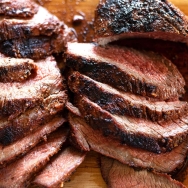
Add a comment Cancel reply
This site uses Akismet to reduce spam. Learn how your comment data is processed .
23 comments
- Holly Mackerall
- June 16, 2024
This recipe made me look like a gourmet chef to my mother in law🤣🤣🤣 thank you!!!!
- June 17, 2024
Aww yay! I’m so happy to hear that! Thanks for taking the time to leave a review!
- May 24, 2024
You sure it’s supposed to be 250?
Hi, Alex! Yes, 250 is what will give it that nice slow cook for the most tender meat and even cooking throughout. You can bump it up to 275 or even 300 if you are in a hurry and need to cut down on the cook time. But I wouldn’t go above 300. I’ve tried this recipe at 325 and resulted in less tender meat and far less even cooking (i.e. more gray-ish meat along the edges instead of pink all the way to the edges). Hope this helps!
- May 20, 2024
Love this recipe, it came out perfect! I will definitely make a million more times! Thank you!
Hi, Kelly! I’m so happy to hear that! We make this almost weekly at our house for tacos 😀
- April 17, 2024
This recipe looks amazing and easy. From what I could read, too many ads on the page made it very difficult to read. Made the page very laggy.
Thanks so much! And thank you for your feedback. I will look into the ad issue with my advertising manager.
- April 3, 2024
I have literally NEVER left a review before on a recipe website. This deserves a 5 star review! I have tricked all my husband’s friends into thinking I’m the best chef in the world! When I walked it from the oven into the room they all were gathered, they all looked at it, eyes widened and then they looked at each other like, “Did Carrie really make THAT!?” LOL. My husband is the king of grilling steaks, and when they saw I was cooking, they’re were slightly let down. I know I make them sound terrible, but in actuality, his steaks are THAT good. However–You’re amazing! This steak is FANTASTIC! Followed the direction to a T TWICE and it came out perfect both times. I’d give it 10 stars if I could! THANK YOU for improving my meat cooking confidence like this recipe did!
Hi, Carrie! Awww I am so happy to hear that! You just made my day! What an amazing review. Thanks so much for taking the time to leave a comment!
- Colleen Brown
- March 19, 2024
I can not pin this to Pinterest and would like to – the recipe is great and worked wonderfully we all enjoyed it and I would like to save it for the future.
- April 1, 2024
I’m sorry you weren’t able to pin it! I’ll check up on that!
- June 30, 2023
Wow! I really liked this recipe. The rub is perfect and the lemon peel was a really nice touch. I made it in the oven and it was still really good. I’m going to try it on the grill next.
- Nikki Cooper
- December 19, 2022
I love tri-type. The most important thing is to not let the fire touch the meat. It means the fire must be on one side of the grill and the meat must be on the other side. It is also very important to use the marinade.
- Kirsten Smith
- November 29, 2022
This looks delicious!
- Fransic verso
- November 25, 2022
It took me a lot of time to learn how to do it properly. I agree it is very important. Thank you for shring
- November 23, 2022
Yummy thanks for sharing! I havent heard of this before and love trying new food options.
- November 19, 2022
This made me hungry! Looks delicious.
- November 18, 2022
This is the perfect recipe going into winter. I love cooking meat on the grill, but as the weather turns cold – it’s great to have some oven alternatives! Thank you for sharing!
- Giangi Townsend
- November 17, 2022
Excellent recipe and so much flavor. We all love it. Thank you.
- November 16, 2022
Tri-tip is one of my favorites! I can’t wait to try this recipe.
You had me at beef, this looks sooo good. Thanks for the recipe!
- Catherine Tyler
Yum! This sounds amazing. Mu husband loves to grill so I’ll be sharing this with him to try.
Rate This Recipe
Advertisement
Traveling During a Heat Wave: Tips and Precautions
It’s summer and the temperature is rising. Here’s what you need to know to protect yourself and your vacation dollars.
- Share full article

By Ceylan Yeğinsu
Follow our updates for the latest on the heat wave across the U.S.
It’s set to be another scorching summer, with extreme and prolonged heat waves forecast across many parts of the United States and Europe.
The stifling conditions could impact millions of travelers and wreak havoc on vacations at some of the world’s most popular tourist destinations. Multiple heat-related deaths among tourists have been reported in Greece and Saudi Arabia in June following extreme temperatures in the Middle East and Aegean regions. Even those who have booked trips in traditionally cooler places may not be spared from the summer heat because of the growing unpredictability of weather patterns.
Here are some tips on how to manage high temperatures when traveling in a heat zone.
Check government guidance
If a heat wave has been forecast at your destination, check government websites before embarking on your trip to give yourself plenty of time to plan and adapt. In extreme temperatures, governments often issue heat advisories warning people to stay indoors during peak heat hours and provide resources to help residents and visitors stay cool. In the United States, the National Integrated Heat Health Information System has a website with information and tools to help prevent illness and death during excessive heat.
Tourist attractions also provide important updates about the conditions at the sights, including any scheduled closures, as a precaution against high temperatures. Some cities grappling with intensive heat, like Los Angeles, Miami, Athens and Melbourne, have assigned chief heat officers to prepare for the heat waves and lead emergency responses.
Avoid peak sun hours
It may seem obvious, but staying outdoors for prolonged periods of time when the sun is at its peak can put many at risk of heat exhaustion. Even if the temperature does not read exceptionally high, excessive dry heat or humidity can make an environment feel hotter than it is.
Travel advisers are adapting itineraries, putting sightseeing in the cooler early morning and evening hours and prebooking tickets for their clients so they do not have to wait in long lines.
“We tend to do activities and tours in the morning, then stop for lunch, and in the mid- to late afternoon you either go back to the hotel to sit by the pool or go to the beach,” said Gary Portuesi, a co-managing partner at Authentic Explorations, a New York-based travel company that specializes in Europe.
Hiking in the middle of the day is also not advised. On June 5, Dr. Michael Mosley, a British medical journalist, died during an afternoon hike in a 104-degree heat wave on the Greek Island of Symi. Four more tourists, including an American man , have recently died in Greece as temperatures have continued to soar.
“I would always recommend going hiking with a certified local guide and under no circumstances alone,” said Franziska Basso, a Milan-based travel adviser for Dreamsteam Exclusive Travel . “Of course, avoid the hottest hours of the day. Go hiking very early in the morning. And always stick to official hiking trails.”
In some European cities, including Paris and London, air conditioning is not a given, so check if it is available before booking a hotel, restaurant or transportation to ensure you have a cool place to find respite from the scorching heat. Visiting a museum or other indoor sightseeing is another good option, but expect crowds at peak hours.
Stay hydrated and take a siesta
Dehydration and heatstroke are among the most common causes of hospitalization during heat waves and can be prevented by staying hydrated and limiting alcohol consumption. During meals, consider eating foods like melons, cucumbers and celery as it can help to sustain hydration throughout the day. Always carry a water bottle with you and consider a parasol and portable fan to help keep you cool and shaded when outdoors.
While your itinerary may be packed with activities and tours, the heat can take a toll on stamina, so consider following the European siesta ritual by breaking up your day with a short nap.
“I’m telling my clients to adapt their itineraries and take advantage of the after-lunch siesta and then push their tours to later in the day when it’s cooler,” said Sarah Johnson, who owns Paper Ink & Passports Travel, a luxury travel company based in Pennsylvania. “There’s a reason they’ve been doing it in Spain and Italy for generations. Walking around in the midday heat and waiting in line could really hurt some people.”
Wear cool clothing
The National Weather Service recommends lightweight, loosefitting, light-colored clothing for outdoor use as it reflects heat and sunlight . Hats and sunscreen are also recommended to protect the face and scalp from harmful UV rays.
Just because it’s hot, doesn’t mean it will be dry. Heat waves can bring torrential rainfall, so be prepared.
“My biggest advice to travelers is to be prepared — for hot or cold, dry or wet weather since one never knows,” said Laurel Brunvoll, the owner of Unforgettable Trips , a Maryland-based travel agency. “Pack layers.”
Book a flexible trip
Even after taking all the right precautions, traveling in a heat wave can be miserable, making it worthwhile to make flexible bookings and purchase “cancel for any reason” travel insurance to have the option to postpone your trip to a cooler time.
Sensible Weather, a Los Angeles-based start-up that provides a weather guarantee for vacations and outdoor experiences, has recently added high heat protection to its coverage. Travelers booking through a Sensible partner in the United States will be able to add daily protection that will allow them to claim reimbursement for a booking if the temperature exceeds a threshold that is usually set between 90 and 100 degrees.
“Our customers can still go on their vacations, but if it’s too hot for some hours of the day and unpleasant to go outside, you can hang out in the air-conditioning and we will reimburse you,” said Nick Cavanaugh, the company’s founder, who was developing the product while caught in a heat wave in Barcelona last year. Those on package tours are reimbursed for the average daily rate of their entire trip for each day that surpassed the heat threshold.
For more travel advice, visit our collection of Travel 101 tips and hacks.
Ceylan Yeginsu is a travel reporter for The Times who frequently writes about the cruise industry and Europe, where she is based. More about Ceylan Yeğinsu
What to Know During Extreme Heat
Staying Safe: We asked emergency room doctors for their advice on protecting yourself from dehydration, heat stroke and other serious health problems.
Heat’s Physical Toll: High temperatures can put the body under immense stress. Here’s what it looks like .
Effect on the Brain: While heat can have an alarming impact on our bodies, it can also impair cognition and make us irritable, impulsive and aggressive .
Keeping Cool Indoors: Too hot to go outside? Here’s how to be comfortable in your home — with or without air-conditioning.
Sleeping Tips: Heat can affect both how much you sleep and how good that sleep is. These simple steps can help you get a better night’s rest when it’s hot.
Medications: Certain antidepressants, blood pressure pills and other drugs make you more susceptible to heat-related illness .
Travel: Stifling conditions could impact your travel plans this summer. Use these tips and precautions to protect yourself and your vacation dollars.
- Bear's Books
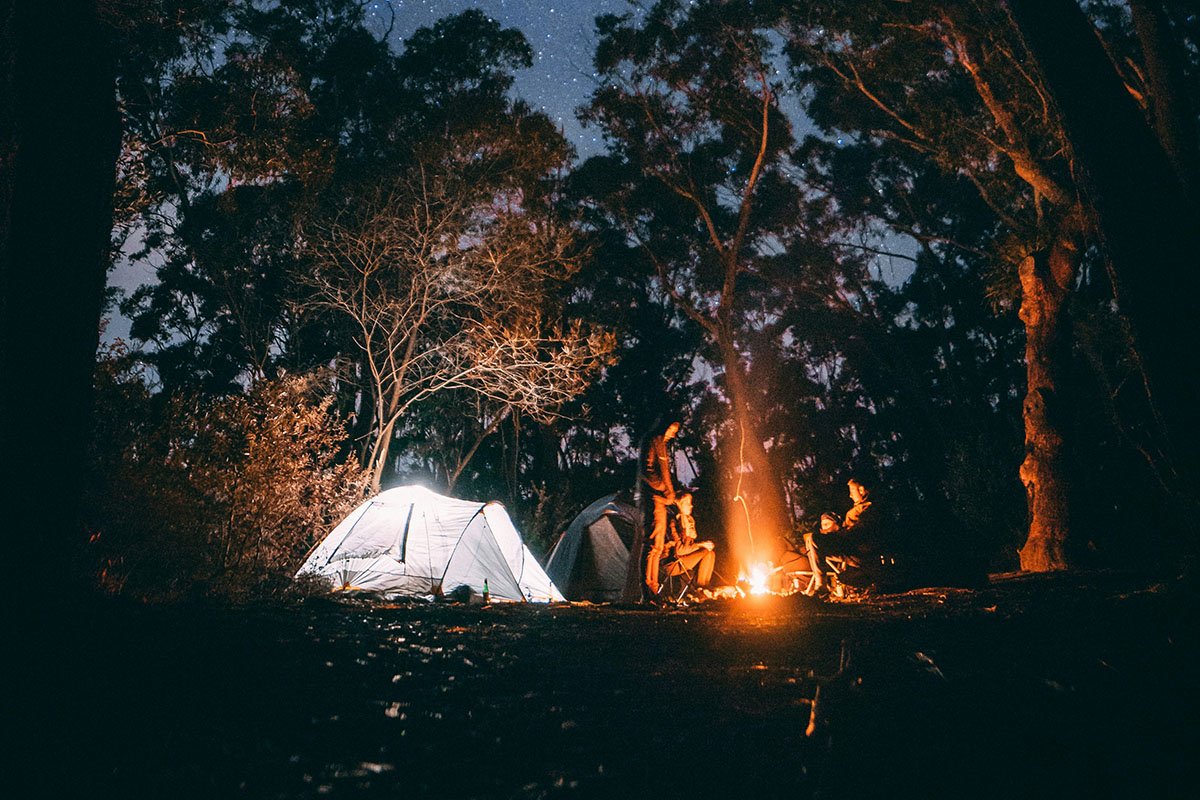
Camping Essentials Checklist: How to Pack for an Unforgettable Outdoor Adventure
By Bethanie Hestermann
More than 80 million Americans go camping each year, making it one of the most popular ways people in the United States choose to spend time outdoors. Camping can be a lot of fun—you’re often surrounded by nature and people you love, plus you get a break from day-to-day life.
Camping takes you out of your “normal” and puts you in a new place, where you can explore, relax, exercise, and socialize outdoors. The connections you form while camping—connections with others, with nature, and with your inner self—make it even more valuable as a form of outdoor recreation.
As any happy camper will tell you, though, camping is also a lot of work. It’s not the easiest hobby to get started with, because there’s a lot of gear involved. If you’re new to this game and need some help planning for your first (or your next) camping trip, you’ve come to the right place.
The key to a successful camping trip is preparation. While there’s always a little bit of “winging it” involved in camping, if you don’t have the camping essentials, you probably won’t have much fun.
Whether you have questions about how to plan a camping trip, need a rundown on some camping basics, are curious about camping safety and etiquette, or just need to know what to pack for a camping trip, you’ll find it all in this ultimate camping essentials guide.
Table of Contents
Different types of camping, how to reserve a campsite, tips for selecting a campground and campsite, sleeping while camping, what to wear camping, cooking while camping, how to wash while camping, going to the bathroom while camping, how to prep for making a campfire, shelter and sleeping, cooking and food, lighting and navigation, first aid, hygiene, and personal items, tools and miscellaneous, camping packing and organization tips, camping safety and etiquette, feeling ready to go camping, how to plan for a camping trip.
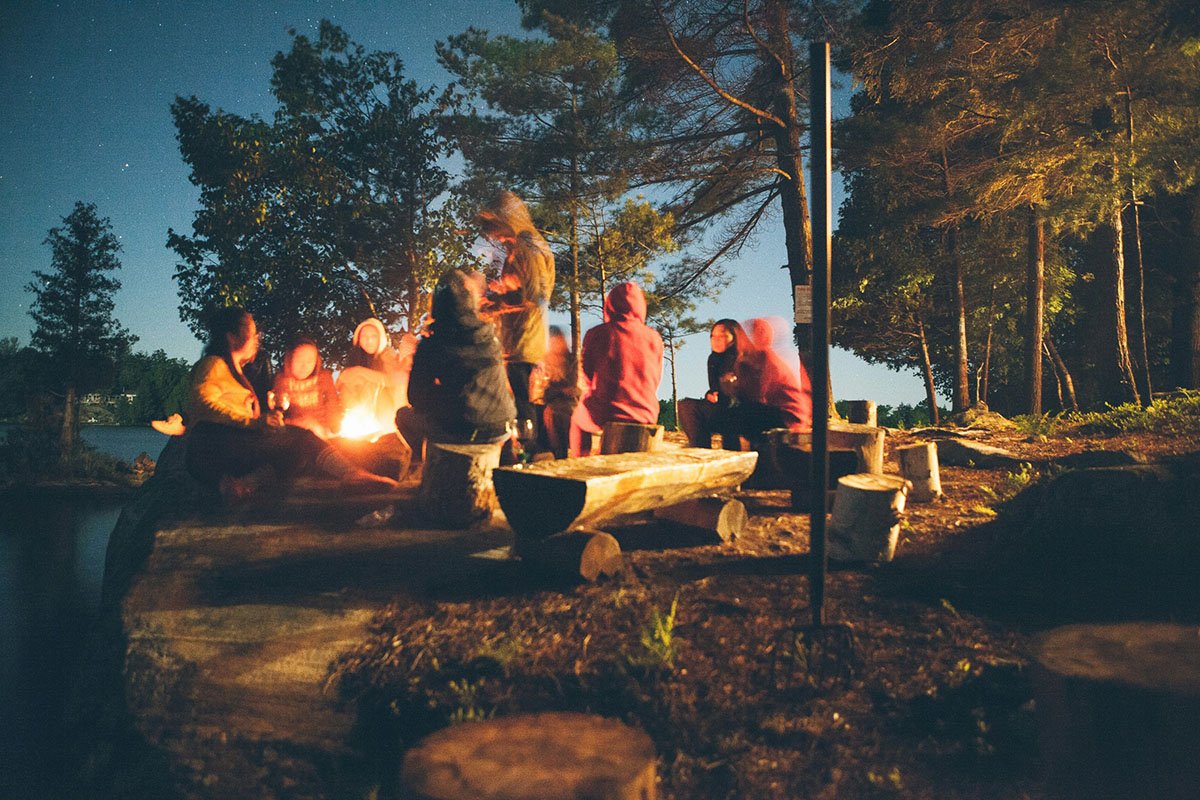
So you’re ready to plan a camping trip in the great outdoors? First, you need to decide where you want to go. You can camp in an established campsite for a fee in places like national parks, state parks, and regional or county-run parks.
In the U.S., you can also camp on BLM (Bureau of Land Management) land in established campsites or on public lands (this is called dispersed camping).
You can also camp on private land in privately owned campgrounds and RV parks, like KOA establishments, or by renting space from a landowner via platforms like Airbnb and Hipcamp .
The type of camping you choose will depend heavily on your preferences, your location, and how far in advance you’re planning your trip.
When planning a camping trip, be very aware of the weather during the time of year and at the location you’d like to visit. If you’re tent camping, you’re more or less at the mercy of the elements (although gear like tent heaters can make a big difference when it’s cold).
Unless you’re an experienced camper or have gear to help you enjoy being outdoors in very hot or very cold temperatures, avoid putting yourself in these situations by camping in milder weather.
When deciding on a duration for your camping trip, consider your gear and your group’s limits. For many, a two-night camping trip over a weekend is long enough to enjoy the activity. For others who may have more gear and/or more tolerance for living primitively, a week is more ideal.
As you research for your camping trip, you may come across different terms for different types of camping. For instance, there’s tent camping, car camping, RV camping, backcountry camping, backpacking, overlanding, and glamping (plus many more).
Try not to get hung up on the terms; we explain the basics below.
Car Camping
The camping trips you remember from childhood were likely traditional tent camping—where you pitch a tent and sleep in it. Car camping can also be a form of tent camping because one meaning of car camping is any type of camping where you drive up to your campsite and can store gear in your car.
This is in contrast to backpacking, where you carry all your gear on your back and hike to the place where you’ll be setting up camp. Some people define car camping more literally as sleeping in your car.
RV camping involves driving an RV or a van or pulling a camper trailer to a designated place and sleeping in it.
RV campers may choose to camp in established sites with hook-ups for electricity, sewage, and/or water, or they may choose to “boondock” or “dry camp”, which is basically just RV camping without those amenities.
Tent and RV campers typically set up in the front country, where campsites are established and there are basic amenities like roads, bathrooms, and potable water.
Backcountry or Dispersed Camping
Backcountry camping is any form of camping that takes place in more remote and less-established parts of parks or wilderness. Backpacking and thru-hiking are the best ways to backcountry camp because you can often only get to these places on foot.
Overlanding
Overlanding can also take you to remote places . . . with the help of your 4×4 vehicle. Overlanders may pitch a tent when they’re ready to make camp, or they may use a truck tent for sleeping that connects to their vehicle.
Glamping was a $3.2 billion market in 2023 , so maybe you’ve heard of it. “Glamping” means different things to different people, but it always involves amenities you don’t typically associate with other types of camping.
Amenities may include Wi-Fi, bathrooms with plumbing, and real beds. The difference between glamping and staying at a hotel is usually the setting that surrounds the establishment.
If you’ve selected front-country tent camping or front-country RV camping, before you can get out there on your outdoor adventure, you must reserve a campsite.
Keep in mind that reservations are not required for all established campgrounds; some are first come first served. However, you won’t know that until you look, and many do require a reservation and, therefore, planning on your part.
For federally owned and managed lands, including U.S. National Parks and U.S. National Monuments, you should visit www.recreation.gov to explore what’s available and ultimately book a campsite. Be aware that if you’d like to camp in popular places, you may need to book up to six months in advance.
To camp on state-owned land, search for the state’s parks and recreation website or do a web search for “California state park camping” (replace “California” with the relevant state for your search).
Each state does it differently, but this should get you to the right place. Many state campgrounds also provide a mix of first-come-first-served sites and reservation-only sites.
When selecting a campground, consider where you want to be while you camp. In the U.S., you can camp in alpine/mountain environments, you can beach camp, and you can camp in the desert—and there are many variations of these basic categories as well.
Your preferred scenery, ideal weather, and favorite activities to do while camping will all help narrow down the choices when it comes to choosing a campground.
Pinpointing the Best Site
Once you’ve selected a campground, it’s time to pick the best campsite. First, consider your equipment.
Some sites are reserved for tents only, while others are designated for RVs. Often, sites can accommodate tents, trailers, or RVs up to a certain length, but not always, so be sure to check the site requirements.
Consider your group size. Double sites are often available within campgrounds to accommodate large groups who would like to camp together. Individual and group sites often have limits on the number of people and vehicles allowed.
To select a prime campsite, look at a map of the campground online. Often, you can pinpoint sites that have more space, are closer to (or farther from) amenities like bathrooms and water spigots, or that have a particular view you’d like to have.
You can often use the map to pick a site that backs up to a creek, that’s next to a trailhead, or that is farther from the road, depending on your preferences.
Camping Basics: Explained
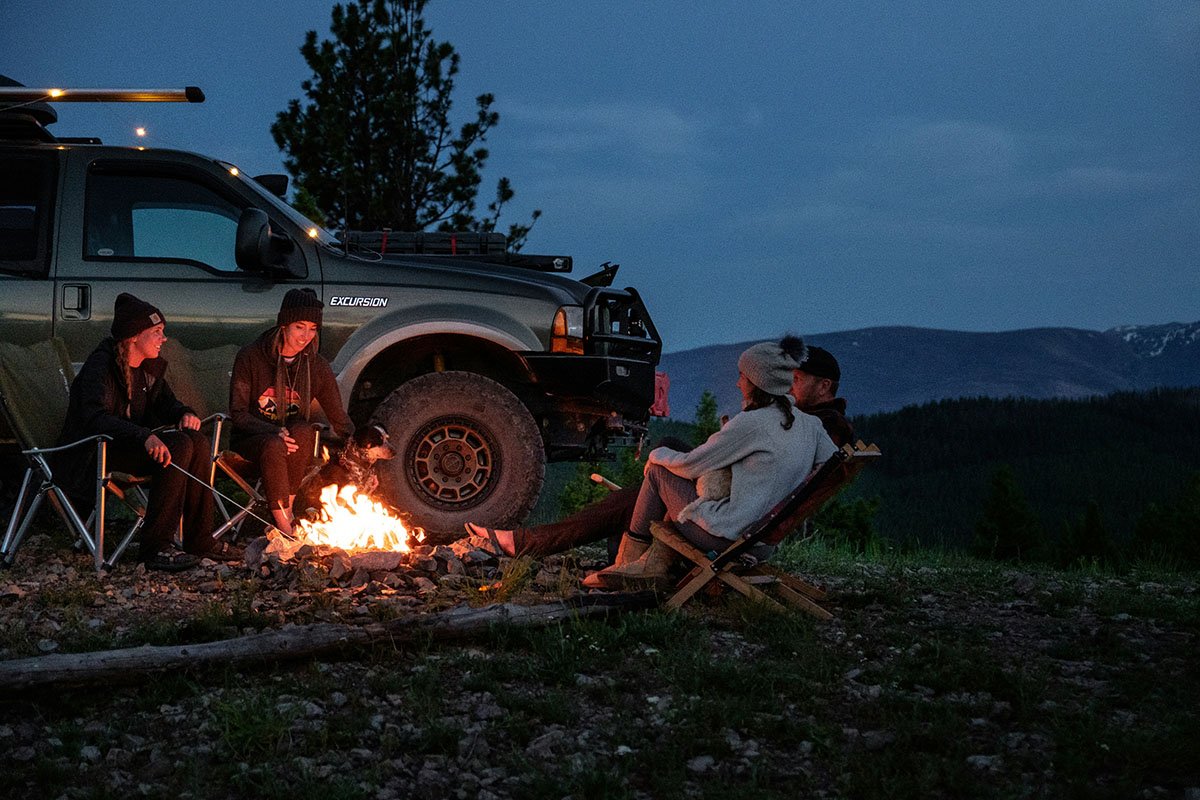
If you’ve never been camping before, the idea of temporarily living outside may seem a bit foreign—and maybe even overwhelming.
Before we get to our camping essentials checklist, which will help you get all your camping gear packed and ready, let’s prepare for your next camping trip by going over some camping basics.
Ah, sleeping under the stars. It sounds so dreamy, right? It’s not always, though. Sometimes, it’s just sleeping outside in the freezing cold. The thing is, we all do this to ourselves because camping is fun.
So how do you sleep while camping? What are your options for staying comfortable ?
Most people don’t sleep out in the open when they camp; they’re in some sort of structure. This structure could be a camper trailer, a van, or an RV, or it could be a tent.
When it comes to selecting a camping tent , you must consider things like how much room you need, how easy you want the setup to be, and what bells and whistles you want or need.
Within your sleeping structure, you’re going to add some more sleeping items to your camping checklist, like a sleeping bag, an air mattress, a sleeping pad, and/or a camping cot .
Decide whether you’re comfortable sleeping on the ground in a sleeping bag or if you need to get up off the ground by using a camping mattress or cot.
If you’re out in cold weather without the proper warmth or stuck in the rain with no rain jacket, you’re going to have a rough time no matter what you’re doing.
Therefore, to have a good time camping, you must bring the right camping clothes. What you wear while camping will depend on where you are, what season it is, and what the weather is like during your trip.
Generally, in warm weather, camping clothes should be lightweight, moisture-wicking, and offer sun protection. Check out our guides on hiking shirts and hiking shorts for ideas.
In cold weather, you should layer clothes to stay warm and dry. Check out our ideas for winter hiking pants , and learn how to layer below.
Before you go, don’t forget to check this list of winter camping items you shouldn’t travel without .
How to Layer
Layering is important when camping because the weather can vary significantly depending on the time of day. In general, layers of camping clothes should include:
- A moisture-wicking base layer
- An insulating layer
- A waterproof and windproof outer layer (like a rain jacket)
Always check the weather forecast before you pack for camping. This will help you know which layers you need and how many items from each category to bring so you can stay comfortable.
Camping Footwear
The footwear you need will depend on the activities you plan to enjoy while camping. If you’ll be hiking, bring hiking boots or other hiking shoes. If there’s a lake, river, or stream nearby, bring hiking sandals or water shoes.
For around the campsite, it’s best to have at least one sturdy, closed-toe shoe option and an easy-to-slip-on pair of shoes, like sandals or boots you can step into. Don’t forget moisture-wicking socks for daytime and thick socks for chilly nights.
Camping food can be as simple or as elaborate as you want it to be, but most people keep it simple. Camp kitchen essentials include a portable camping stove or BBQ and fuel for it, some cooking implements and cooking utensils, and some serve ware and eating utensils, to cover just the basics.
Most campsites will have a picnic table, but if there’s no picnic table at your campsite, you’ll also need some sort of camping table for preparing and/or eating food.
Transporting food on camping trips is a bit of an art. You need a way to store food and keep it cool for the duration of your time camping.
This typically involves some specialized cooler and ice or ice packs. The best camping coolers are bear-resistant, which means they’ll also keep out other wildlife, not just bears.
If you’re camping in bear country, it’s extremely important to keep all of your food in bear canisters or locked in your vehicle away from your tent or sleeping space.
Treat your trash the same way. If you’re using plastic bags for trash, hang them up from a tree branch overnight or put them in a wildlife-proof container.
Many campgrounds are close enough to towns with grocery stores and restaurants, so you can leave your campsite to go pick up more ice and food, or even just have someone else cook you dinner if you need a break.
If you really don’t want to cook while camping, you can always survive on canned foods, trail mix, and energy bars for a few days.
Though cooking every night can be tiring, it’s fun to break out the Dutch oven and see what you can create over an open flame. Try out a few of your favorite recipes from home, and taste the difference between cooking over an open flame.
There are a few different camps of people when it comes to hygiene on camping trips:
- Camp one says you’re camping, you’re dirty, you’re fine
- Camp two does the minimum by filling plastic bins or buckets with soap and water, then cleaning themselves using a washcloth
- Camp three buys camping showers (or camps in an RV)
Depending on how clean you want to be while camping, your camping checklist will look a bit different. At the very least, add biodegradable soap and a towel to your camping gear to wash up when you need to. If you’re going all in with the camping shower, add some more camping toiletries to your packing list.
How much you wash may also depend on how available water is to you at your campsite. If you have easy access to water via a spigot or sink, you may feel more inclined to wash up than if you only have what you’ve hauled in.
Note that some campgrounds do have coin-operated showers available.
Washing Dishes
Washing dishes is similar to washing bodies; you need biodegradable soap, a dishcloth or sponge, and a towel for drying. You can wash dishes in a bin or bucket or add a collapsible sink to your camping gear (a collapsible sink is totally worth it).
A camp kitchen is one of the campsite essentials for people who like to cook. It’ll include surfaces and methods for prepping and cooking food and cleaning up your dishes when you’re done.
When nature calls and you’re camping in the remote wilderness, you head into nature with a wag bag or a small trowel—unless, of course, you have a camping toilet on your packing list. Some areas have rules that require you to pack out your waste using a wag bag or similar solution.
If your area does not have a pack-out rule, then the best practice is to dig a cat hole at least 200 feet away from a trail, campsite, or source of water, cover your waste, and pack out your used toilet paper.
If you’re front-country camping, though, there are likely facilities available to you, ranging from flushing toilets to outhouse-style toilets in a dedicated building. If you prefer to BYOT (bring your own toilet), there are plenty of options . Choose biodegradable toilet paper to complement your portable throne.
Most campsites have fire pits available for campers’ use. It’s best practice to either collect firewood from the area (be sure to add an ax to your camping gear for chopping wood) or buy a bundle of locally sourced firewood at the campground or nearby.
Your camping packing list should include a lighter or matches, some fire starters, and some firewood.
If you’re going dispersed camping and there is no fire pit available, you’ll need to bring or make your own. It’s a good idea to add a portable fire pit to your camping must-haves if you plan to camp anywhere other than an established campground.
Alternatively, you can always find a clear, level space, encircle it with rocks, and build your fire there.
Always check for fire restrictions in an area before lighting a campfire and properly extinguish your fire when you’re done.
The Ultimate Camping Packing List
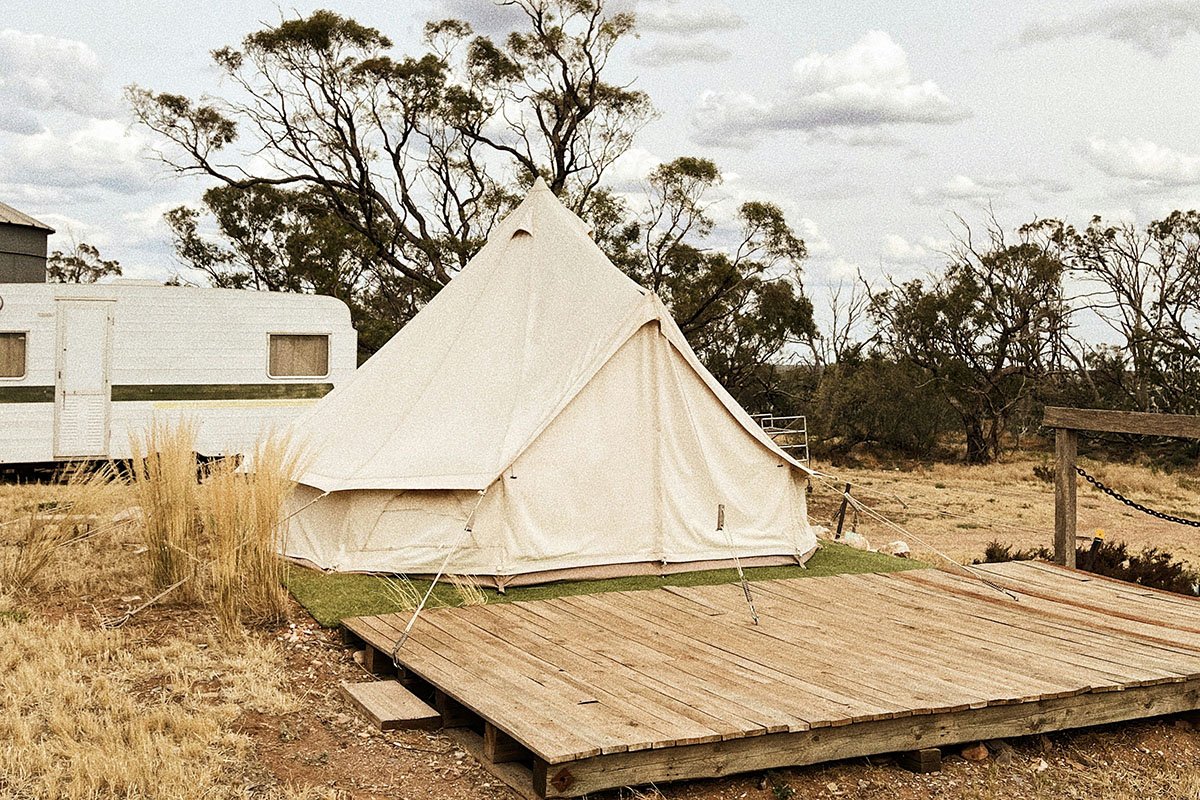
Ready for a list of camping must haves? When it’s time for your next camping trip, pack the following items to ensure you have all the camping gear you need. Please note that your camping packing list will vary slightly depending on the type of camping you’re doing, as well as the season and the location.
- Camping tent with tent stakes (consider bringing extra stakes)
- Tent footprint and rain fly
- Sleeping bags
- Sleeping pads, air mattresses, or camping cots
- Camping blanket(s)
- Shade structure
- Camp stove or portable grill
- Fuel, charcoal, or propane
- Lighter or matches
- Cookware (including pots, pans, and cooking utensils)
- Cooler and food storage bins
- Biodegradable soap and sponge
- Food and snacks
- Water containers, gallon water jugs, and/or water bottles
- Camping table (if no picnic table at your site) and/or portable camp kitchen
- Bottle opener
- Portable coffee maker
- Base, insulation, and outer layers (see How to Layer above)
- Weather-appropriate footwear (see Camping Footwear above)
- Extra socks and underwear
- Hat and sunglasses
- Headlamp and/or flashlight (with extra batteries)
- Power bank and/or solar panels
- Map and compass
- GPS device ( GPS watch , personal locator beacon, smartphone, etc.)
- First-aid kit, including bandages, gauze, antiseptic wipes, tweezers, scissors, safety pins, etc.
- Personal medications
- Pain relievers
- Biodegradable soap
- Toothbrush and toothpaste
- Biodegradable toilet paper and trowel
- Hand sanitizer
- Cell phone (note, you might not have cell service)
- Bug protection/insect repellant
- Other personal items like lotion, deodorant, feminine hygiene products, and others as needed
- Multi-tool or knife
- Fire starters
- Camp chairs
- Backpack or daypack
- Camping fan
- Extra batteries
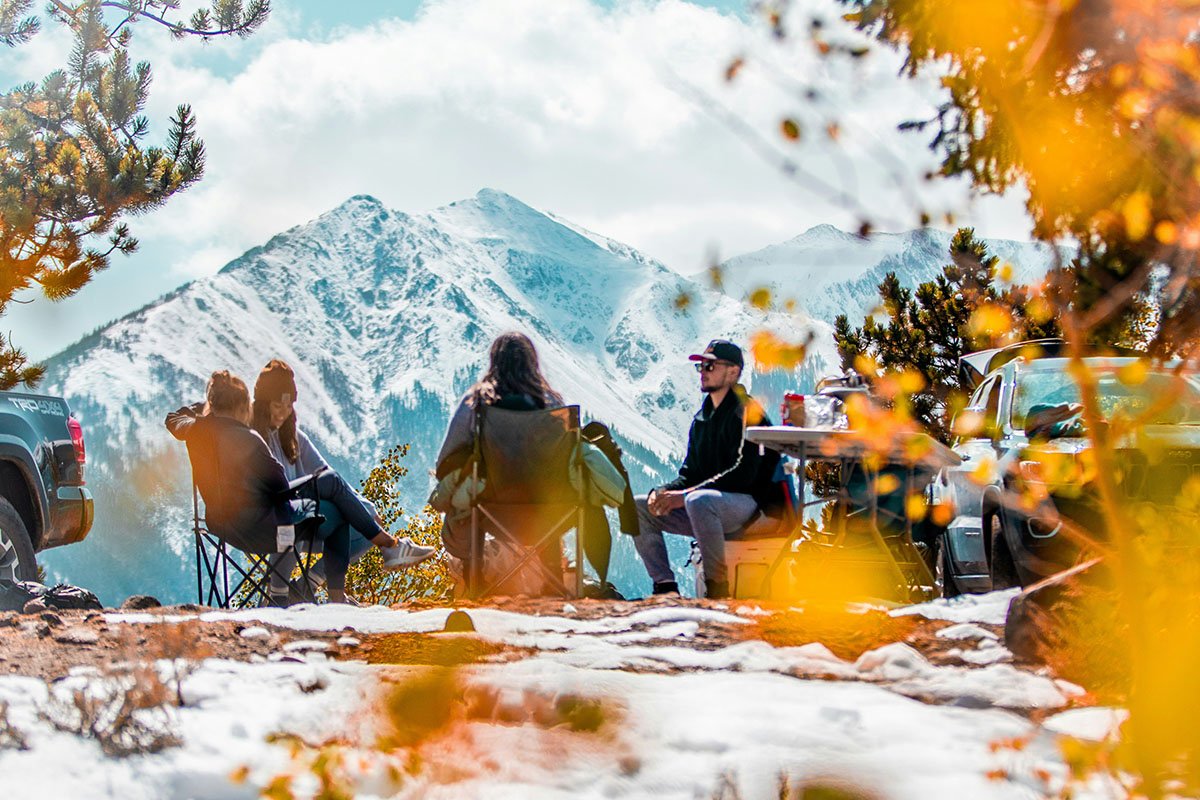
How, you may ask, can you pack everything from graham crackers, a bottle opener, and a sleeping bag to solar panels and a tent in a way that makes sense?
Many people have dedicated storage bins for their camping gear, so these items can often be transported in the same bins that they’re stored in. Clear plastic bins are helpful because you can see what’s inside.
Use coolers and any sort of reusable bags you have on hand to transport your camping food and drinks. Collapsible totes are a great choice for staying organized, and you can collapse them when you’re not using them. A duffel bag does the trick for transporting your camping clothes.
Bring some extra trash bags (or, even better, a large cloth bag) to store dirty clothes in after you wear them, and don’t forget to have a bear-proof container on hand to store your camping food so wildlife can’t get to it.
Small clear plastic bins are also helpful for storing things like cooking utensils, serve ware, and first-aid items.
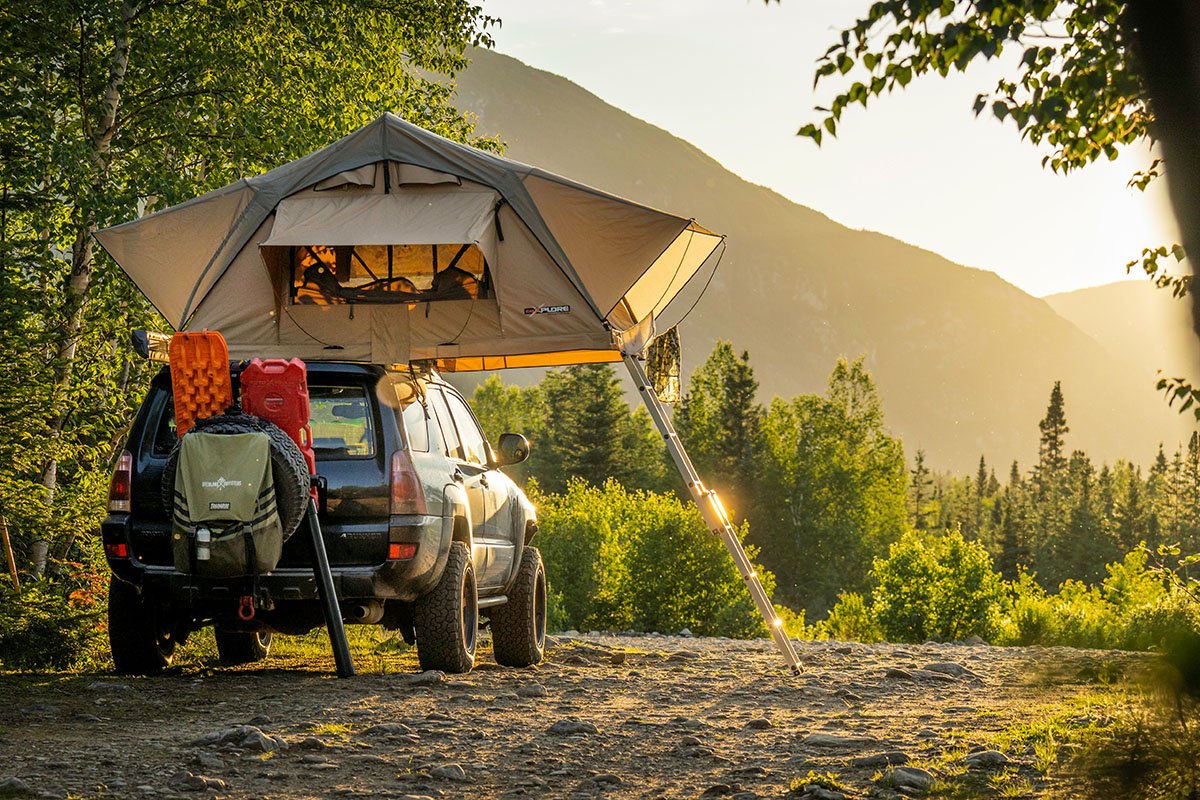
Potential hazards while camping are similar to potential hazards while hiking ( see our guide to day hiking here ) and include slips and falls, getting lost, wildlife encounters, and extreme weather.
Be diligent about where you walk, add offline navigation tools to your list of camping must-haves (since you might not have service at your campsite), carry bear spray, always watch for wildlife, and don’t forget to check the weather forecast before you start a camping trip.
Campsites have rules to not only keep people safe but also to make sure camp neighbors are being courteous to each other. Rules may include campsite-wide quiet hours, fire restrictions, and rules about where to park and not to park vehicles.
Leave No Trace Principles
In general, when outdoors, you should also follow the seven Leave No Trace principles , which include:
- Plan ahead and prepare
- Travel and camp on durable surfaces
- Dispose of waste properly
- Leave what you find
- Minimize campfire impacts
- Respect wildlife
- Be considerate of other visitors
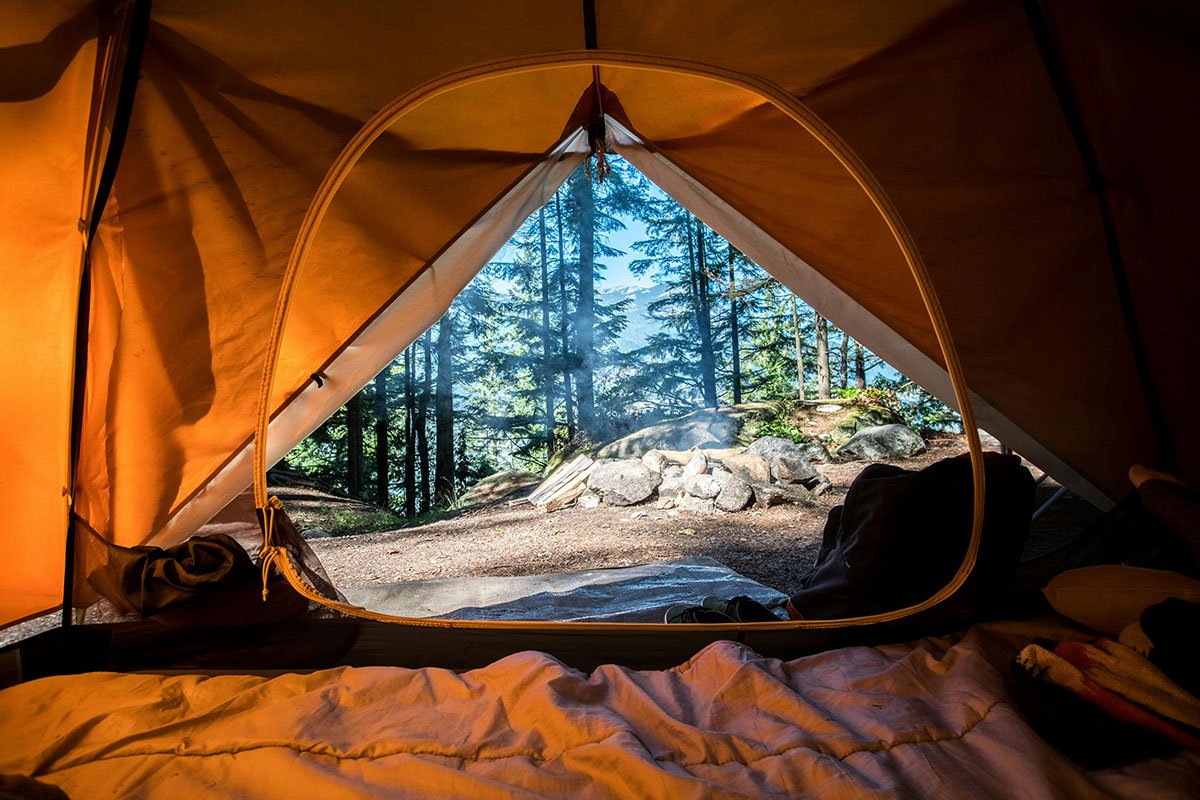
The ultimate camping checklist may not exist, simply because there are so many different types of camping and so many different types of campers, and everyone’s needs are going to vary sightly.
However, now that you’re armed with information about how to plan a camping trip, know all about the camping basics, and have a camping checklist of gear and other essentials, you’re ready to start prepping for your first (or next) trip.
No matter how much you prepare, stuff will come up. If you have the knowledge and the essential items, you can be creative when challenges arise while camping. And sometimes, the unexpected makes for a particularly memorable camping experience.
As you enjoy one of the most popular outdoor recreation activities around, please remember to recreate responsibly, leave no trace, and preserve nature for future generations of campers.
Also check out our top tips to make camping more comfortable .
Related Tags:
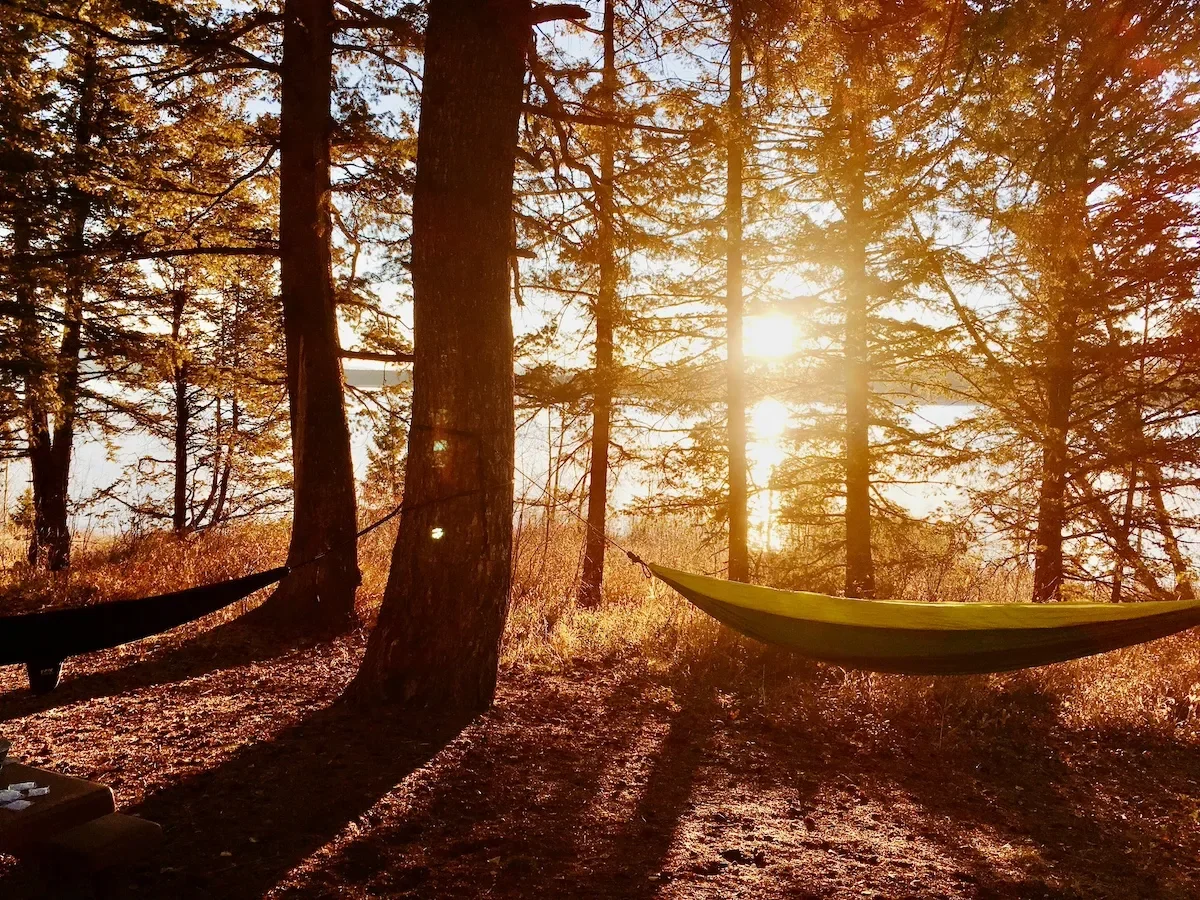
Sleeping Outdoors in a Hammock Saved This Man’s Health

Good Samaritan Saves Choking Raccoon in Viral Video
When it comes to bins, use wood instead of plastic. You never know when you might need the fuel.
Camping security…
Leave a Comment Cancel Reply
Your email address will not be published. Required fields are marked *
Save my name, email, and website in this browser for the next time I comment.
Register for newsletter (optional)
More Like This

Hot Trend: Popularity of Winter Camping is Surging

Watch: This Elephant Has Figured Out How to Peel Bananas
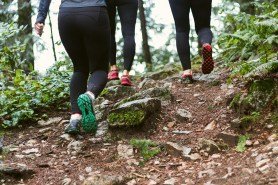
Want To Work Out More in the New Year? Get in Shape by Enjoying the Outdoors

‘Survivor’ 45 Premiere Recap: ‘Lulu Losers’

Why Are So Many People Enrolling in Survival Schools?
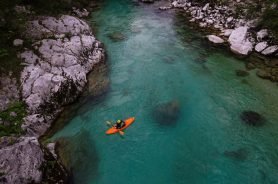
Top 6 Kayaking Destinations around the World
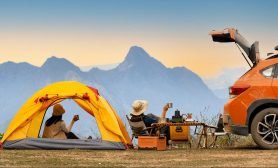
How the Subaru Became an Adventure Car for the Queer Community

Packing a Bug-Out Bag is the Responsible Thing to Do
More stories.
Amtrak with kids is easier (and cheaper) than you think
Half-priced tickets and the Red Cap service made a trip from D.C. to NYC manageable.

Driving back to D.C. after a long weekend in New York in March, my husband and I were dreaming of a different kind of trip: no bathroom stops, no need to gas up, no shrieks from kids tired of their car seats, no traffic jams.
It’s a shame, we agreed, that it would be so expensive to take the train from D.C. to NYC as a family of four. But wait. Would it?
We started to consider the cost of fuel and tolls — and the toll of meltdowns, frequent bathroom breaks for a preschooler and stop-and-go traffic. Then we discovered Amtrak’s half-price tickets for passengers between the ages of 2 and 12, and a free ride (on an adult’s lap) for a child under 2. We ended up booking three round-trip tickets for a total of $255 — only slightly more than I’ve paid for a trip just for myself.
Take a forgiving baggage allowance, invaluable assistance at the train station, bathrooms in close proximity and the ability to have mini-adventures in transit (cafe car, anyone?), and my husband and I agreed: It felt like we were on vacation the moment we got on the train. Arriving in less time than it takes to drive — under three-and-a-half hours to New York and a little bit longer on the way home — was another perk.
Some Amtrak regulars might wince at the idea of sharing train space with a 3-year-old and 9-month-old, so I’ll just say this now: We avoided the quiet car.
Here’s what we learned about riding the rails with tiny passengers.
Take advantage of the Red Cap service
I read that families with kids are allowed to pre-board, but I wasn’t sure how that would work. All my previous experiences taking Amtrak involved watching for the gate to pop up on a screen and then making a beeline to jockey for position with hundreds of fellow passengers.
But using the Red Cap service was hands down the best advice we got.
The employees are described as “dedicated Amtrak staff you can count on for free baggage handling assistance.” They also assist passengers with disabilities, older travelers, large groups — and, yes, families with small kids. Amtrak says customers can tip if they like; I’m here to tell you that this service is priceless for a family and you should definitely tip.
We arrived at Union Station in Washington about 30 minutes before departure with our eyes peeled for red. Near the gates, we spotted a sign and someone in the namesake red hat (plus polo shirt) and asked for help boarding. He rolled our Pack ’n Play on his cart and brought us and another group with a small child right down to the track, then helped both parties find seats designated for groups of three or more people. We were on board by 9:19 a.m., more than 15 minutes ahead of departure.
In a first for me, the train was entirely empty when we boarded.
On our way back to D.C., we asked police in Penn Station for directions to the Red Cap station. Once there, someone checked our ticket and once again, got us on the train a few minutes before anyone else. Both times, we were able to get situated without getting in anyone else’s way.
People who want to use the Red Cap service should arrive 45 minutes early, an Amtrak representative told me later. The service is only available at major stations including Washington, Baltimore, Philadelphia, Newark, New York, Wilmington, Del., New Haven, Conn., and Boston’s South Station on the East Coast. Elsewhere, find it in Chicago, Los Angeles, Portland, Ore., and Seattle.
According to Amtrak, priority boarding is also available for families with small kids at some stations; travelers should ask a customer service representative at the station to find out.
Book early for deals, but read the fine print
I often take Amtrak to New York, so I knew from experience that great prices can be found by searching far in advance, staying flexible with dates and seeking out less-convenient times. By booking six weeks in advance for a Thursday through Saturday, we found times and prices that were doable with kids. (I’ve since been tempted by round-trip tickets for the family for $175.)
Our fare was in the “value” category , which doesn’t come with a lot of flexibility: changes are not allowed, and there’s a 25 percent cancellation fee. The restrictions are clear when booking, but I must have shrugged them off because I was surprised when I tried and failed to change our return time.
Amtrak spokeswoman Kimberly Woods said the half-price discount for kids aged 2 to 12 is “an everyday discount we offer to encourage families to get onboard and experience a better way to travel.”
Kids need to be accompanied by at least one adult, and the discount isn’t good for business class on non-Acela trains, first class or private rooms. One child under 2 is allowed on board for free with an accompanying adult, as long as they sit on a lap.
You’re allowed more free bags than on a plane
My packing strategy for family road trips is usually “better safe than sorry” — which leaves us with a bunch of bags. That likely would have been fine under Amtrak’s luggage rules for this route. Every passenger can bring two carry-ons and a personal item at no additional charge. For people traveling with a child under 2, an additional infant item, like a stroller or diaper bag, is allowed for no fee.
I knew we’d have to manage every item on crowded NYC streets and public transportation as well as “the big train,” as we started calling Amtrak. With a stroller, portable crib, diaper bag, purse, small duffel, tiny cooler bag and two backpacks that held clothes for the four of us, we felt unwieldy — but were still within the baggage limits.
I thought that I might check a bag at the station, but found out in the moment that the train only allowed carry-ons. That turned out to be fine, but it was difficult to suss out in advance if we would be able to check a bag.
The cafe car is your friend
Our seats on both legs of the trip were conveniently close to the bathroom and suitably far from the cafe car — a good arrangement for urgent restroom needs and time-killing sojourns to check out the food offerings.
Amtrak’s website noted that changing stations were available in the bathrooms on “most” train cars, but we never found one. A spokesperson later clarified that changing areas were available on the Acela and some long-distance trains.
Being able to walk around was key; my daughter loved to tap the button to open doors between cars. Seats were spacious, and the view was sufficiently interesting to entertain both kids in spurts.
“Mama look, we’re going fast!” my daughter said as we accelerated. We passed over a sparkling body of water and she excitedly pointed out “the ocean!” We’ll work on geography.
The cafe car’s menu had plenty to satisfy a preschooler’s palate, even if some items like a chewy, barely warm grilled cheese were not a success. An iced lemon pound cake was a hit, as were pretzels and a tropical fruit salad that was as delicious as it was messy.
But it’s still a confined space, so pack entertainment
If you’re a parent too, you know kids get bored and antsy over the course of three-plus hours doing anything. This definitely applies in a confined space.
To pass the time, we packed toys for both kids and a tablet with headphones for our preschooler. She drew using an art app and watched some of her favorite movies and shows on Disney Plus in between walks, trips to the bathroom and food car visits.
The baby nursed, squealed as he tapped on the window and, at naptime, cried a little until we soothed him to sleep. Thankfully, the tears were short-lived — and unfortunately, so were the naps.
My husband and I couldn’t help but overhear someone else’s temper tantrum: a loud, angry businessman cursing during a video meeting, which prompted an Amtrak employee to suggest he relocate to the bathroom if he wanted to use that language.
Unlike my solo train trips, I did not pass my time napping, reading and browsing social media. But I loved taking the ride with them and introducing them to a new travel experience.
The takeaway
We found Amtrak a refreshing alternative to driving, and one that we’ll choose in the future. But we were also lucky on several fronts: The trains were not delayed, which is not always a given . Red Cap service was available at our station. We had our choice of seats when we boarded. There were no diaper emergencies.
If we had boarded somewhere without the extra assistance, or when the train was already packed, it could have been trickier. And the lack of a diaper changing station could have required yogic maneuvering in the bathroom (next time I’ll bring some oversized changing pads). Packing our own snacks and entertainment was crucial.
For us, the best part of the trip was eliminating the drudgery of a drive and turning that time into an adventure where both parents could be present and engaged with our kids. We watched the skylines pass until New York’s came into view and marveled over how much less stressful the train felt than four or more hours on I-95.
“I love the train,” my husband said at one point.
“Me too,” echoed the 3-year-old.
More travel tips
Vacation planning: Start with a strategy to maximize days off by taking PTO around holidays. Experts recommend taking multiple short trips for peak happiness . Want to take an ambitious trip? Here are 12 destinations to try this year — without crowds.
Cheap flights: Follow our best advice for scoring low airfare , including setting flight price alerts and subscribing to deal newsletters. If you’re set on an expensive getaway, here’s a plan to save up without straining your credit limit.
Airport chaos: We’ve got advice for every scenario , from canceled flights to lost luggage . Stuck at the rental car counter? These tips can speed up the process. And following these 52 rules of flying should make the experience better for everyone.
Expert advice: Our By The Way Concierge solves readers’ dilemmas , including whether it’s okay to ditch a partner at security, or what happens if you get caught flying with weed . Submit your question here . Or you could look to the gurus: Lonely Planet and Rick Steves .

- Best overall
- Best for cruises
- Best for reputation
- Best for preexisting conditions
- Best for digital nomads
- Best low-cost
- Best for road trips
- How we reviewed travel insurance companies
Ultimate Guide to Choosing the Best Travel Insurance in June 2024
Affiliate links for the products on this page are from partners that compensate us (see our advertiser disclosure with our list of partners for more details). However, our opinions are our own. See how we rate insurance products to write unbiased product reviews.
Traveling is an adventure, a leap into the unknown, a story waiting to unfold. But every story needs a safety net, and that's where travel insurance comes in. In this guide to the best travel insurance, we'll embark on a journey to help you better understand travel insurance and uncover the benefits that make it an indispensable companion for any traveler.
Our Picks for the Best Travel Insurance Companies
- Best Overall: Nationwide Travel Insurance
- Runner-Up: AXA Assistance USA
- Best for Cruises: Travel Guard
- Best Reputation: C&F Travel Insured
- Best for Pre-existing Conditions: Tin Leg Travel Insurance
- Best for Digital Nomads: WorldTrips Travel Insurance
- Best Low-Cost Option: Trawick International Travel Insurance
- Best for Road Trips: Travelex Travel Insurance
Compare the Best Travel Insurance Companies
The best travel insurance companies offer comprehensive coverage options for a wide range of people and needs. For this guide, we looked at coverage options, customizability, and the best companies for specific situations, such as pre-existing conditions.
Here are Business Insider's picks for the best travel insurance companies in 2024.
Best Overall Travel Insurance
Nationwide travel insurance.
Nationwide Travel Insurance is of the largest players in the travel insurance space, offering nearly endless options for any customer on the travel spectrum, including annual travel insurance plans which can offer frequent travelers the flexibility to "set it and forget it" on their travel insurance coverage.
Nationwide Essential also offers some of the most affordable policies in the market compared to similar plans from competitors, which makes it a great pick for just about anyone. Buyers can discuss bundling options as Nationwide also sells homeowners, auto, pet, and other insurance products. Its travel insurance quoting is just as easy as it has been with other Nationwide insurance products.
Read our Nationwide Travel Insurance review .
- Trip cancellation coverage of up to 100% of trip costs (for cruises) or up to $30,000 (for single-trip plans)
- Check mark icon A check mark. It indicates a confirmation of your intended interaction. Three cruise-specific plans to choose from
- Check mark icon A check mark. It indicates a confirmation of your intended interaction. Annual travel insurance plans available
- Check mark icon A check mark. It indicates a confirmation of your intended interaction. Strong trip cancellation coverage
- Check mark icon A check mark. It indicates a confirmation of your intended interaction. Cancel for any reason coverage available
- con icon Two crossed lines that form an 'X'. CFAR insurance not available with every single plan
- con icon Two crossed lines that form an 'X'. Medical coverage is lower than what some competitors offer
Nationwide Travel Insurance offers many of the standard benefits you might see with a travel insurance policy. This can include things like trip cancellation coverage, so you can recover pre-paid costs or trip interruption in the event your vacation is interrupted by an unexpected event. There's also baggage delay coverage and medical coverage.
- Cancel for any reason coverage available
Best Travel Insurance Runner-Up
Axa assistance usa travel insurance.
AXA Assistance USA offers consumers a great option for no-stress travel insurance: low-priced plans, generous coverage limits on key categories including primary insurance on lost luggage, and up to 150% reimbursement for qualifying trip cancellations.
While add-ons are limited and rental car coverage is not included by default on cheaper plans, AXA is a perfect fit for travelers who don't plan to drive (or who already hold a travel credit card with rental car coverage), and don't need any additional bells and whistles.
Read our AXA Assistance USA Travel Insurance review .
- Trip cancellation coverage of up to 100% of the trip cost
- Check mark icon A check mark. It indicates a confirmation of your intended interaction. Generous medical evacuation coverage
- Check mark icon A check mark. It indicates a confirmation of your intended interaction. Up to $1,500 per person coverage for missed connections on cruises and tours
- Check mark icon A check mark. It indicates a confirmation of your intended interaction. Covers loss of ski, sports and golf equipment
- Check mark icon A check mark. It indicates a confirmation of your intended interaction. Generous baggage delay, loss and trip delay coverage ceilings per person
- con icon Two crossed lines that form an 'X'. Cancel for any reason (CFAR) coverage only available for most expensive Platinum plan
- con icon Two crossed lines that form an 'X'. CFAR coverage ceiling only reaches $50,000 maximum despite going up to 75%
AXA Assistance USA keeps travel insurance simple with gold, silver, and platinum plans. Emergency medical and CFAR are a couple of the options you can expect. Read on to learn more about AXA.
- Silver, Gold, and Platinum plans available
- Trip interruption coverage of up to 150% of the trip cost
- Emergency medical coverage of up to $250,000
Best Travel Insurance for Cruises
Aig travel guard.
Travel Guard is well-known insurance provider, and a great fit for travelers who want to ensure that they can get their money back in the event of canceled or interrupted travel plans.
While the company's policies can be pricey compared to its competitors, the high medical and evacuation limits make AIG a solid choice for older travelers who value peace of mind and simplicity over highly customizable plans that may be bolstered with medical upgrades.
Read our AIG Travel Guard review .
Trip cancellation coverage for up to 100% of the trip cost and trip interruption coverage for up to 150% of the trip cost
- Check mark icon A check mark. It indicates a confirmation of your intended interaction. Trip cancellation coverage of up to 100% of the cost, for all three plan levels
- Check mark icon A check mark. It indicates a confirmation of your intended interaction. CFAR covers up to 75% of total trip costs (maximum of $112,500 on some plans)
- Check mark icon A check mark. It indicates a confirmation of your intended interaction. Medical coverage of up to $500,000 and evacuation of up to $1,000,000 per person
- Check mark icon A check mark. It indicates a confirmation of your intended interaction. Includes COVID coverage
- Check mark icon A check mark. It indicates a confirmation of your intended interaction. Above average baggage loss and delay benefits
- Check mark icon A check mark. It indicates a confirmation of your intended interaction. High medical evacuation coverage
- con icon Two crossed lines that form an 'X'. Premiums may run slightly higher than competitors
Travel Guard is a well-established and highly rated name in the travel insurance industry. It offers three main coverage options to choose from, and in general its policies have above-average coverage for baggage loss and baggage delays, plus high medical evaluation coverage limits.
- Trip cancellation coverage for up to 100% of the trip cost
- Trip interruption coverage for up to 150% of the trip cost
- Preexisting medical conditions exclusions waiver must be purchased within 15 days of initial trip payment
- Annual travel insurance plan and Pack N' Go plan (for last-minute trips) available
Best Travel Insurance for Reputation
C&f travel insured.
While every travel insurance company has negative reviews about its claims process, C&F Travel Insured 's claims process has a consistent stream of positive reviews. One customer wrote that C&F processed a claim within 48 hours. Additionally, C&F regularly responds to customer reviews within one business week, making reviews a consistent way to reach the company.
Additionally, in C&F's fine print, it mentions that any claims that take more than 30 days to pay out will begin to accrue interest at 9% APY.
C&F's reputation isn't the only thing to speak highly of. It offers an array of add-ons uncommon in the travel insurance industry, such as Interruption for Any Reason insurance and CFAR coverage for annual plans. C&F also offers discounts for children on its Protector Edge plan and free coverage on its Protector plan.
Read our C&F Travel Insured review .
- Check mark icon A check mark. It indicates a confirmation of your intended interaction. Offers 2 major plans including CFAR coverage on the more expensive option
- Check mark icon A check mark. It indicates a confirmation of your intended interaction. Cancellation for job loss included as a covered reason for trip cancellation/interruption (does not require CFAR coverage to qualify)
- Check mark icon A check mark. It indicates a confirmation of your intended interaction. Frequent traveler reward included in both policies
- Check mark icon A check mark. It indicates a confirmation of your intended interaction. Up to $1 million in medical evacuation coverage available
- con icon Two crossed lines that form an 'X'. Medical coverage is only $100,000
- con icon Two crossed lines that form an 'X'. Reviews on claims processing indicate ongoing issues
- C&F's Travel Insured policies allow travelers customize travel insurance to fit their specific needs. Frequent travelers may benefit from purchasing an annual travel insurance plan, then adding on CFAR coverage for any portions of travel that may incur greater risk.
Best Travel Insurance for Pre-Existing Conditions
Tin leg travel insurance.
Tin Leg Travel Insurance is a great fit for travelers with medical issues in particular. Seven of Tin Leg's eight travel plans include coverage for pre-existing conditions as long as you purchase your policy within 15 days of your initial trip payment.
Thanks to coverage for pre-existing medical conditions as well as for potential COVID-19 infection while traveling, this company offers some of the best financial investment options for travelers who are or will be exposed to higher health risks and issues.
Read our Tin Leg Travel Insurance review .
- Check mark icon A check mark. It indicates a confirmation of your intended interaction. Policy coverage includes most pre-existing health conditions
- Check mark icon A check mark. It indicates a confirmation of your intended interaction. Generous medical and evacuation amounts for peace of mind
- Check mark icon A check mark. It indicates a confirmation of your intended interaction. COVID coverage included by default on all insurance plans
- Check mark icon A check mark. It indicates a confirmation of your intended interaction. Offers a wide range of plans for various budgets and travel needs
- Check mark icon A check mark. It indicates a confirmation of your intended interaction. Some plans offer CFAR, “cancel for work reasons,” financial default, and unemployment coverage
- con icon Two crossed lines that form an 'X'. Limited add-on coverage options
- con icon Two crossed lines that form an 'X'. Baggage loss and delay coverage is low compared to competitors
Tin Leg travel insurance offers eight travel insurance plans to meet the unique needs of travelers.
- Tin Leg was founded in 2014 by the travel insurance industry experts at Squaremouth. Designed to meet the most common needs of travelers, these policies offer comprehensive Trip Cancellation and Trip Interruption benefits, and a range of Emergency Medical and Medical Evacuation limits.
Best Travel Insurance for Digital Nomads
Worldtrips travel insurance.
WorldTrips Travel Insurance has affordable premiums, highly customizable add-ons, and generous coverage for core categories of travel insurance. All this makes it a great option for digital nomads, students studying abroad and backpackers.
However, travelers should keep in mind that plans are not particularly flexible, and coverage amounts are limited unless you plan ahead to pay for the areas and amounts that you need.
Read our WorldTrips Travel Insurance review .
- Check mark icon A check mark. It indicates a confirmation of your intended interaction. Affordable base plans that can be customized with add-ons including rental car, pet care, hunting and fishing, and vacation rental coverage
- Check mark icon A check mark. It indicates a confirmation of your intended interaction. Insurance plans available for international student travelers
- Check mark icon A check mark. It indicates a confirmation of your intended interaction. Trip delay coverage benefit that kicks in after just five hours
- Check mark icon A check mark. It indicates a confirmation of your intended interaction. Pre-existing conditions waiver can be purchased within 21 days of initial trip payment
- con icon Two crossed lines that form an 'X'. Lower medical, evacuation and accidental death limits
- con icon Two crossed lines that form an 'X'. Limited, secondary baggage loss coverage although baggage protection can be upgraded at a low cost
- con icon Two crossed lines that form an 'X'. No special coverages for pets, sports equipment, etc.
WorldTrips has been a reputable travel insurance provider for more than 20 years. Unsurprisingly, it boasts an A+ rating from the Better Business Bureau and positive reviews from thousands of customers.
- Travel medical insurance (Premium, Group, Annual, and International Student options)
- Trip cancellation insurance
- Trip protection insurance
Best Travel Insurance for Affordability
Trawick international travel insurance.
Trawick International Travel Insurance is another insurance provider with robust medical travel insurance that can help higher-risk and anxious travelers find peace of mind while on the road. This company offers one of the most generous medical evacuation policies in the market, although travelers will need to remember to add on rental car coverage if they need it.
Read our Trawick Travel Insurance review .
- Check mark icon A check mark. It indicates a confirmation of your intended interaction. Useful for adventurous travelers headed to higher-risk destinations
- Check mark icon A check mark. It indicates a confirmation of your intended interaction. Affordable plans with varying levels of coverage
- Check mark icon A check mark. It indicates a confirmation of your intended interaction. 10-day free look option
- Check mark icon A check mark. It indicates a confirmation of your intended interaction. Generous baggage loss replacement policy
- Check mark icon A check mark. It indicates a confirmation of your intended interaction. Trip delay coverage kicks in after just six hours
- Check mark icon A check mark. It indicates a confirmation of your intended interaction. Some policies allow a CFAR add-on
- Check mark icon A check mark. It indicates a confirmation of your intended interaction. Up to $1 million medical evacuation coverage limit
- con icon Two crossed lines that form an 'X'. Baggage and trip delay coverages don’t kick in until after the 12-hour mark
- con icon Two crossed lines that form an 'X'. International student policies available for temporary stints abroad
- con icon Two crossed lines that form an 'X'. Complaints about claims not being paid or involving an intermediary to resolve claims
Trawick International travel insurance offers plans customized to diverse travelers' needs. We look at coverage options, claims processing, pricing, and other important factors for savvy travelers.
- Travel medical insurance
- Trip protection and cancellation
- International student insurance
- Visitor medical insurance (for traveling to the US)
Best Travel Insurance for Road Trips
Travelex travel insurance.
Travelex Travel Insurance offers three plans:
- Travel Basic
- Travel Select
- Travel America
The Travelex America plan is meant for trips limited to the U.S., but it has the highest coverage limits in many areas compared to its other programs. If you're flying somewhere, the lost baggage limits are higher. Its natural strengths shine for road trippers, though. Travelex America adds coverage for roadside service and rental car coverage for unexpected accidents. It also covers pets should you be involved in an accident while on the road.
While your standard auto insurance does extend to car rentals within the U.S. for a limited time, any accident would affect future rates. Travelex would eliminate the risk of reporting to your auto insurance provider for minor incidents within its purview.
Read our Travelex Travel Insurance review .
- Check mark icon A check mark. It indicates a confirmation of your intended interaction. Options to cover sports equipment
- Check mark icon A check mark. It indicates a confirmation of your intended interaction. Option to increase medical coverage
- Check mark icon A check mark. It indicates a confirmation of your intended interaction. Can cancel up to 48 hours before travel when CFAR option is purchased
- Check mark icon A check mark. It indicates a confirmation of your intended interaction. Affordable coverage for budget-conscious travelers
- Check mark icon A check mark. It indicates a confirmation of your intended interaction. Includes generous baggage delay, loss and trip delay coverage
- Check mark icon A check mark. It indicates a confirmation of your intended interaction. Optional "adventure sports" bundle available for riskier activities
- con icon Two crossed lines that form an 'X'. Only two insurance plans to choose from
- con icon Two crossed lines that form an 'X'. Medical coverage maximum is low at up to $50,000 per person
- con icon Two crossed lines that form an 'X'. Pricier than some competitors with lower coverage ceilings
- con icon Two crossed lines that form an 'X'. Some competitors offer higher medical emergency coverage
Travelex travel insurance is one of the largest travel insurance providers in the US providing domestic and international coverage options. It offers a basic, select, and America option. Read on to learn more.
- Optional CFAR insurance available with the Travel Select plan
- Trip delay insurance starting at $500 with the Travel Basic plan
- Emergency medical and dental coverage starting at $15,000
Introduction to Travel Insurance
Why travel insurance is a must-have.
The unpredictable nature of traveling – from flight cancellations to medical emergencies – can turn your dream vacation into a nightmare. Travel insurance acts as a personal safeguard, ensuring that unexpected events don't drain your wallet or ruin your trip.
Understanding Different Types of Travel Insurance
Not all travel insurance policies are created equal. From single-trip travel insurance policies to annual travel insurance plans , from minimal coverage to comprehensive protection, understanding the spectrum of options is your first step in finding the right fit for your journey.
Key Features to Look for in Travel Insurance Coverage
Travel insurance for medical emergencies.
Imagine falling ill in a foreign country; daunting, right? A robust travel insurance plan ensures you don't have to worry about how much emergency medical care while traveling will cost, even in the most remote corners of the globe. This coverage will often come in tandem with emergency medical evacuation coverage.
Trip Cancellation and Interruption Benefits
Life is full of surprises, some less pleasant than others. Trip cancellation and interruption coverage ensures that you're not left out of pocket if unforeseen circumstances force you to cancel or cut your trip short. You may also look for cancel for any reason and interruption for any reason options, which will reimburse you for a percentage of your nonrefundable fees, but expands the covered reasons you can cancel a trip. You can find our guide on the best CFAR travel insurance companies here.
Coverage for Personal Belongings and Baggage Loss
Losing your belongings is more than an inconvenience; it's losing a piece of your world. Insurance that covers personal belongings and baggage loss ensures that you're compensated for your loss, helping you to rebound and continue your adventure.
Support and Assistance Services
In times of trouble, having a lifeline can make all the difference. Look for insurance that offers 24/7 support and assistance services, giving you peace of mind that help is just a phone call away. Also, check websites that field customer reviews like Trustpilot, the Better Business Bureau, and InsureMyTrip , to see how well a company responds to customer requests.
Choosing the Best Travel Insurance
Reputation and reliability of the travel insurance provider.
A provider's reputation is not just about being well-known; it's about reliability, customer satisfaction, and the ability to deliver on promises. Researching and choosing a reputable provider is a cornerstone in ensuring your safety and satisfaction.
Understanding the Policy's Fine Print
The devil is in the details, and understanding the fine print of what your travel insurance policy covers is crucial. Be aware of coverage limits, exclusions, and the process for filing a claim to avoid any unpleasant surprises.
Customer Reviews and Feedback
In the age of information, customer reviews and feedback are goldmines of insight. Learn from the experiences of others to gauge the reliability and customer service of the insurance provider you're considering. While the ratings are important, you should also look at whether or not a company responds to customer complaints.
How to Get the Most Out of Your Travel Insurance
Knowing your policy inside out.
Familiarize yourself with every aspect of your policy – what it covers, what it doesn't, how to file a claim, and who to contact in an emergency. Being informed means being prepared.
Steps to Take When a Problem Arises
If you face an issue during your travels, knowing the immediate steps to take can make all the difference. Keep important contacts and your policy details handy, and remember, your insurance provider is there to assist you.
How to Pick the Best Travel Insurance Company for You
There isn't a one-size-fits-all policy that works perfectly for every traveler. Young, healthy solo travelers can opt for much cheaper plans that offer bare-bones coverage, while families juggling complex itineraries will do best by investing in a robust policy that can help defray any costs associated with lost baggage, delayed transportation or other trip-impeding obstacles.
That being said, you can't go wrong with a travel insurance provider that boasts a reputable history and offers a wide range of customizable plans. In some cases, you may be comparing plans that are only a few dollars' apart from each other. In such situations, you should generally opt for the insurance company that offers the strongest customer service. It's also worth considering whether or not the travel insurance provider has been reviewed by other travelers with similar itineraries to your own.
An insurance aggregator like InsureMyTrip or Squaremouth is one of the best tools for searching travel insurance policies. Once you input the specifics of your travel itinerary, you'll be able to see hundreds of search results to compare the ones that catch your eye. If the options are too overwhelming, use the filters to the left of your search page to eliminate as many irrelevant plans as possible.
How We Reviewed the Best Travel Insurance Companies
To come up with our list of the best travel insurance companies, we evaluated each insurer based on the following factors:
Guide Methodology: What We Considered
Policy Types
Travel insurance is essential, but often underused partly because people aren't getting what they want. Business Insider's 2023 travel study showed 10.65% of travelers surveyed bought cancel for any reason insurance. Cost may be a factor, but in many cases, the coverage is more affordable than you might think. Regardless, companies must offer a diverse range of coverage options. We award five stars to companies offering all standard coverages and additional options like pet and sports equipment protection.
Our 2023 travel study indicated the majority of purchases were made through the travel provider (ex: flight protection insurance when you're purchasing your airline tickets). While these may be sufficient for some customers, we look for companies offering a more comprehensive range of services.
According to the U.S. Travel Insurance Association, the average cost of travel insurance will be between 4% and 8% of total travel expenses. Anything beyond that price point should include additional benefits beyond the standard inclusions, such as CFAR protection or upgraded medical coverage. Anything below that 4% threshold may leave you lacking important or sufficient coverage in an emergency.
Convenience and Flexibility
Whether you're an infrequent traveler or a suitcase warrior, a good travel insurance company should have you covered. In many cases, you might not even have to talk to a person in order to purchase your policy.
Many people think of travel insurance in context with specific trips, but most of these top contenders sell both single-trip and multi-trip policies, also known as annual travel insurance. Some companies also offer plans specifically designed for cruisers, students abroad, and business travelers. (Read our guide to the best cruise travel insurance companies for more details.) Finally, all of these providers offer multiple options for getting the specific areas and amounts of coverage that you want.
Claims Handling
Most travelers never have a large claim. Premiums are low, and it provides peace of mind for the just in case situations. So they leave reviews based on their reduced stress levels. But what happens if you lose your luggage or have to stay a few extra days due to an unexpected accident? Will your insurance carrier cover your claim without all the hassle? We check real customer reviews to sort this out for you.
Ease of Use and Support
When purchasing, during your trip, and throughout the claims process, you may need extra support. Does the company have a 24/7 help line? Does it have an online or mobile system allowing you to self-manage? Essentially, what are the options when you need help? We look at the big picture to evaluate the average customer experience with each company.
You can read our full insurance rating methodology for even more details.
Best Travel Insurance FAQs
There isn't a one-size-fits-all solution for every traveler. Determine the benefits that are most important to you, like baggage delay coverage, medical coverage, and trip delay coverage, then look for a company with solid customer ratings, especially when it comes to processing claims.
Travel insurance will pay out if you experience a covered event, such as a travel delay or delayed or lost baggage. If you're looking to get travel insurance for a specific reason, such as needing to potentially cancel your trip due to work reasons, make sure your policy will cover you in that situation before purchasing it. You should also check customer reviews to see other travelers' claims experiences, as it varies wildly from company to company.
The average cost of travel insurance is 4% to 8% of your total trip cost, so it could vary widely depending on where you're traveling and the length of your trip. Your age, the number of people in your group, and other factors can also influence how much you'll pay.
Most comprehensive travel insurance policies include travel medical coverage that can come in handy if an emergency occurs and you need medical evacuation. Some travel insurance plans offer more specialized coverage for travelers with pre-existing conditions , so shop around if medical coverage is a top priority for you.
$100,000 should be a sufficient medical coverage limit for travel insurance. If you're planning on doing extreme sports or anything particularly risky on your trip, you may want to increase your coverage level. A high medical coverage limit is especially useful when you're purchasing cruise travel insurance, since medical evacuations are more involved at sea.
Editorial Note: Any opinions, analyses, reviews, or recommendations expressed in this article are the author’s alone, and have not been reviewed, approved, or otherwise endorsed by any card issuer. Read our editorial standards .
Please note: While the offers mentioned above are accurate at the time of publication, they're subject to change at any time and may have changed, or may no longer be available.
**Enrollment required.

- Main content

COMMENTS
1. Book At Least Six Weeks in Advance. Instead of carving time out of your schedule to book your trip at a specific date or time (such as Tuesdays at 3 a.m. using a private browsing session to find discounted fares), a more effective strategy is researching travel options at least four to six weeks in advance.
5. Always Bring A Sarong. Sarongs can be used as a wrap when you are cold, a towel, a curtain, or a piece of clothing that can be worn dozens of different ways. Solid colors are great, but if you want something that stands out, I love this sarong. Read more: 8 Ways to Wear a Sarong. 6. Always Buy Travel Insurance.
As fun as traveling can be, it won't be much fun if you can't afford basic necessities for months after your trip. II- Travel Planning Tips. Pin. 10. Research Your Destination. Before you begin packing your bags and booking your flights, it's important to do some research on your destination. This will help you better understand the ...
18: Pack Ear Plugs & An Eye Mask. This travel tip should actually be #1 on the list. I love my earplugs! Muffle the sounds of crying babies, drunk Australians, barking dogs, honking horns, dormitory sex, natural gas salesmen, and more. A traveler's best friend.
These tips for traveling will have you saving money, sleeping better, getting off the beaten path more, meeting locals, and just being a better traveler. So, without further ado, here are the best 61 travel tips in the world: 1. Always pack a towel. It's the key to successful galactic hitchhiking - and plain common sense.
As millions of travelers take trips by plane, cruise ship or road, we've gathered some essential travel tips on how best to book and enjoy your journeys. Whether you're an occasional road-tripper or a frequent globe-trotter, these TPG-backed top travel tips can help you avoid unnecessary headaches when you spend time away from home.
Many experts agree that you should tip housekeeping $3 to $5 per day, depending on the length of your stay, your room rate and the level of service. "These are the hardest-working people in the hotel and the least recognized," Tom Waithe, general manager of the Alexis Hotel Seattle, previously told TPG. You should, however, be on the lookout ...
1. Do the Math. Typically, the gratuity rate for guides should be around 10 to 20 percent of the total trip cost. That means if you're paying $500 for a day or two of guided rock climbing, an ...
Pack a Full Outfit in Your Carry-on. If you don't want to split up your clothing, pack a full outfit in your carry-on. This is one of my favorite travel tips that has saved me more than once. In the event your bag does get lost, you'll still have a full set of fresh clothes.
2. Budgeting: Let's be real: Money matters. Some of the best budget traveling tips including to draft a rough estimate of daily expenses, considering accommodation, food, transport, and activities. Don't forget to set aside a contingency fund for unexpected expenses. 3. Trip Insurance:
Flip the tri-tip. Transfer the pan to the oven and roast until an instant-read thermometer inserted into the thickest part of the tri-tip registers about 125ºF for medium, 20 to 30 minutes. Transfer the tri-tip to a clean cutting board and let rest 10 minutes (tent loosely with aluminum foil if the kitchen is cold).
64. When carrying medical supplies: split between two bags. Since I have type 1 diabetes, this is an important factor for me, but lots of people travel with some sort of condition or illness and if that applies to you, then make sure you split your important supplies between two different bags.
Place in the refrigerator for 5-6 hours, or up to 24 hours. When ready to grill, preheat an outdoor gas grill to 350-400 degrees F. Remove the tri tip from the refrigerator and let it come to room temperature while the grill is heating. Wipw off any excess marinade with paper towels.
This New Luxury Travel Company Features Carbon-neutral Trips to the Dolomites, Victoria Falls, Amazon, and More. This Delta Exec Is Constantly Flying — Here Are Her Best Tips for Beating Jet Lag ...
With these travel tips, you can make your trip or vacation a hassle-free and enjoyable experience. From using a packing list and credit card rewards to using public transportation and going on a tour, these strategies can help you make the most of your time away. Remember to plan ahead, stay organized, and be open to new experiences, and you ...
Season the tri tip on all sides with Beef Rub. Make the mopping liquid. Combine all ingredients for the mopping liquid in a small bowl and set aside. Grill. Place the seasoned tri tip roast directly on the grill grates over indirect heat. Close the lid and grill for 30-40 minutes, flipping every 6-7 minutes.
Brown the Meat. Preheat oven to 425 degrees F. Heat 2 tablespoons olive oil in a large cast iron skillet or pan to medium-high heat. Remove the tri tip from the marinade. Keep the marinade for a sauce later, or discard it. Sear the tri tip roast 4-5 minutes per side to achieve a nice crust.
1) Before you light up the grill, take the tri tip roast out of the fridge and bring it to room temperature (or about 70 degrees). This evens out the temperature throughout the roast which will help the roast cook evenly (in other words, you don't have to burn the outside to cook the deep middle of the roast). Trim the roast as needed.
Warm the sauce. Place the butter and BBQ sauce in a medium saucepan and onto your grill to heat through. Grill the tri tip. Grill the tri tip on indirect heat, flipping every 6-7 minutes. Close the lid in between each flip. Add sauce. Mop liberally with BBQ butter sauce after each time you flip the roast.
Cook the tri tip in a low oven at 275ºF / 135ºC or smoke it with indirect high heat for about 45 minutes, letting the meat cook evenly the whole way through. For best results when cooking, always use a meat thermometer. Insert the thermometer horizontally into the thickest part of the tri tip and aim for an internal temperature of 125ºF ...
Preheat the smoker to 225°F. Opt for hickory or oak wood chips for a more robust smoked flavor. Place the tri-tip roast in the smoker, close the lid, and smoke until the internal temperature reaches 125°F or so (medium rare is 135°F and medium 150°F. The internal temperature will rise during searing and standing time).
Remove your tri tip from the smoker. Sear the tri tip. Put 2-3 tablespoons of butter into the cast iron skillet and let it melt. Drop in the sprig of rosemary and then place the tri tip into the sizzling butter. Sear the tri tip for 2-3 minutes per side, spooning the butter and rosemary over the steak as it cooks.
4. Do a post-mortem. You don't have to feel like a failure if you don't manage to pack light on your next trip, but if that happens and you want to travel lighter on the one after that, you ...
Roast in oven. Insert a meat thermometer into the center at the thickest part and place on the center oven rack of preheated oven. Roast until until the internal temperature of the meat reaches 130ºF for medium rare and 140ºF for medium doneness. If the tri-tip still has the fat cap on it, roast it with the fat side up.
Travel 101. Traveling During a Heat Wave: Tips and Precautions. It's summer and the temperature is rising. Here's what you need to know to protect yourself and your vacation dollars.
Quick tips for cooking while camping. How to Wash While Camping. There are a few different camps of people when it comes to hygiene on camping trips: Camp one says you're camping, you're dirty, you're fine; Camp two does the minimum by filling plastic bins or buckets with soap and water, then cleaning themselves using a washcloth
Amtrak with kids is easier (and cheaper) than you think. Half-priced tickets and the Red Cap service made a trip from D.C. to NYC manageable. Driving back to D.C. after a long weekend in New York ...
Just 67% of adults in Bankrate's survey say they always tip at restaurants. Just over half of respondents always tip the people who cut their hair and deliver their food. And 4 in 10 always take ...
Learn about coverage options, providers, and tips to ensure a worry-free journey. An icon in the shape of a person's head and shoulders. ... Best for Road Trips: Travelex Travel Insurance .
And we're part of every trip you take.cf Skip to main content MTC is the transportation planning, financing and coordinating agency for the nine-county San Francisco Bay Area. ... Document Title 2023 TIP Grouped Listing for the State Highway Operation and Protection Program - Mobility Program; File Name VAR170005-2023-FTIP-GL-SHOPP-Mobility ...